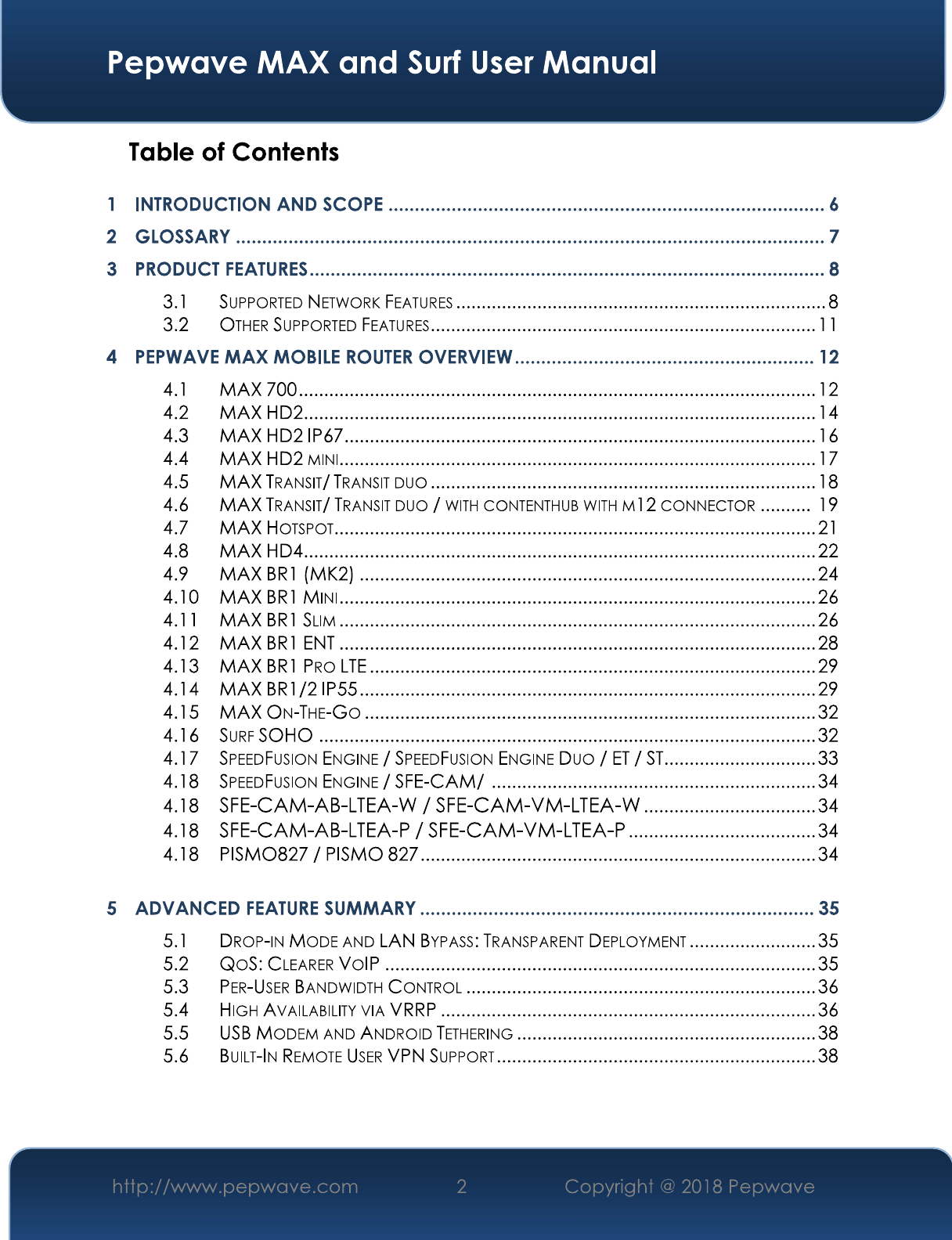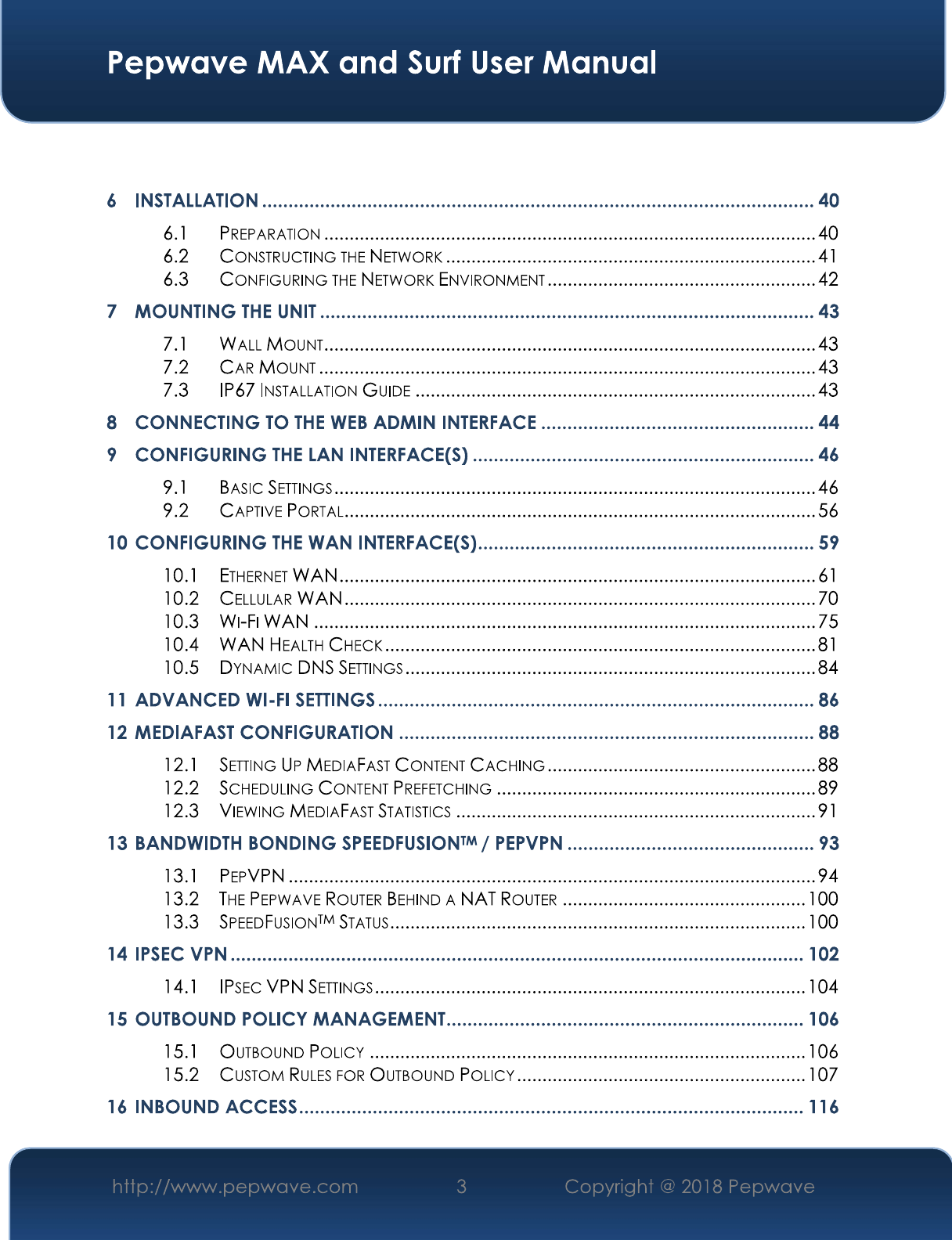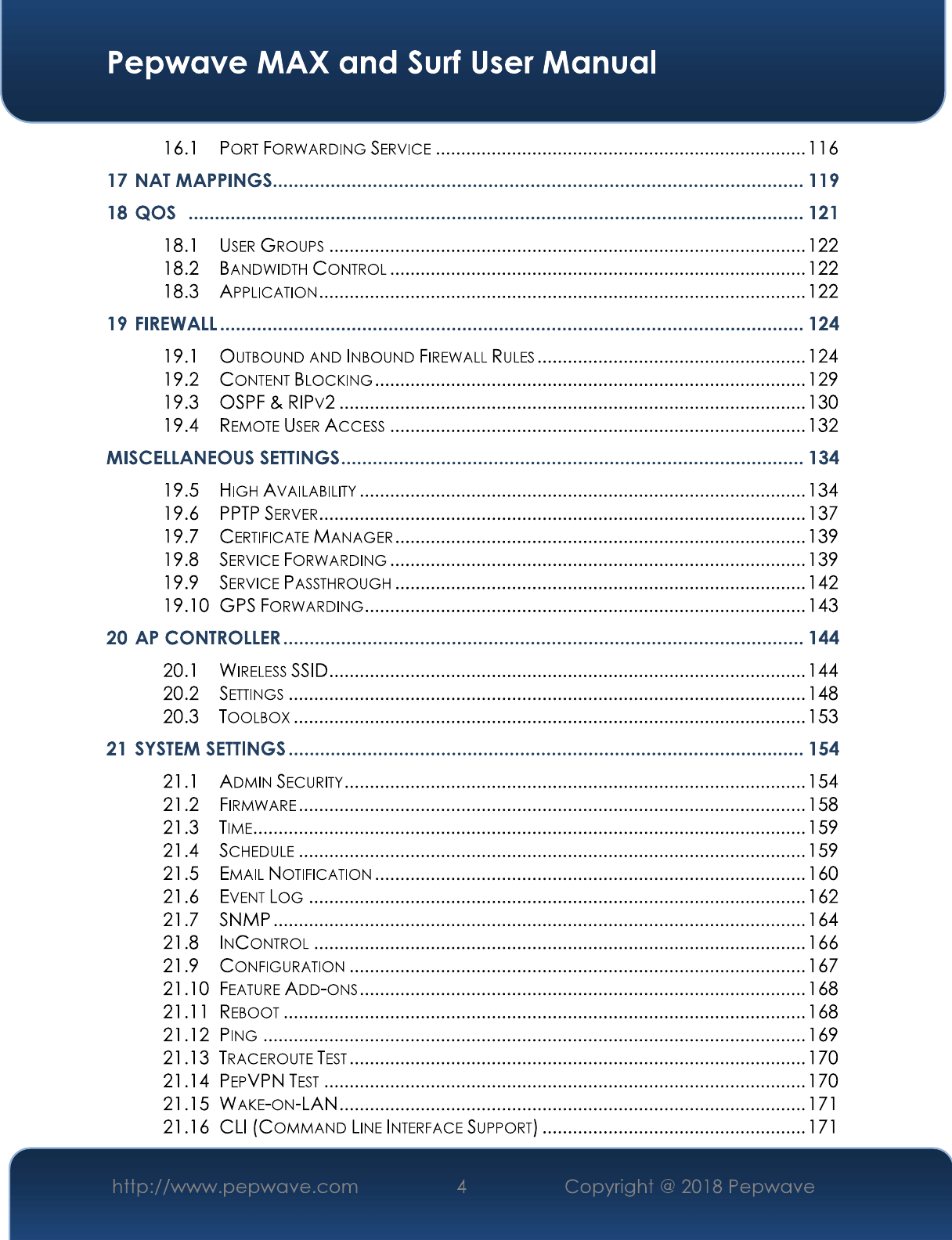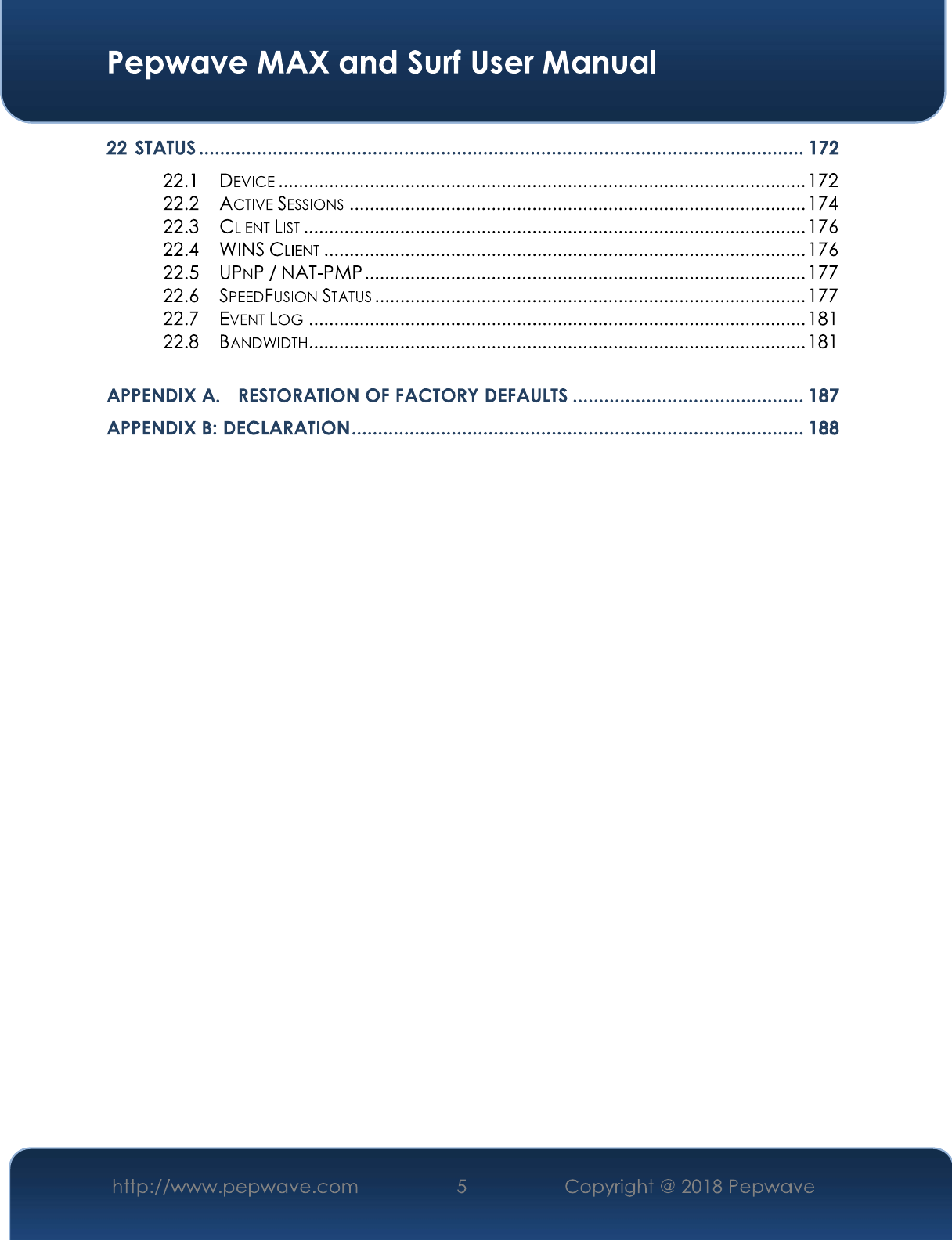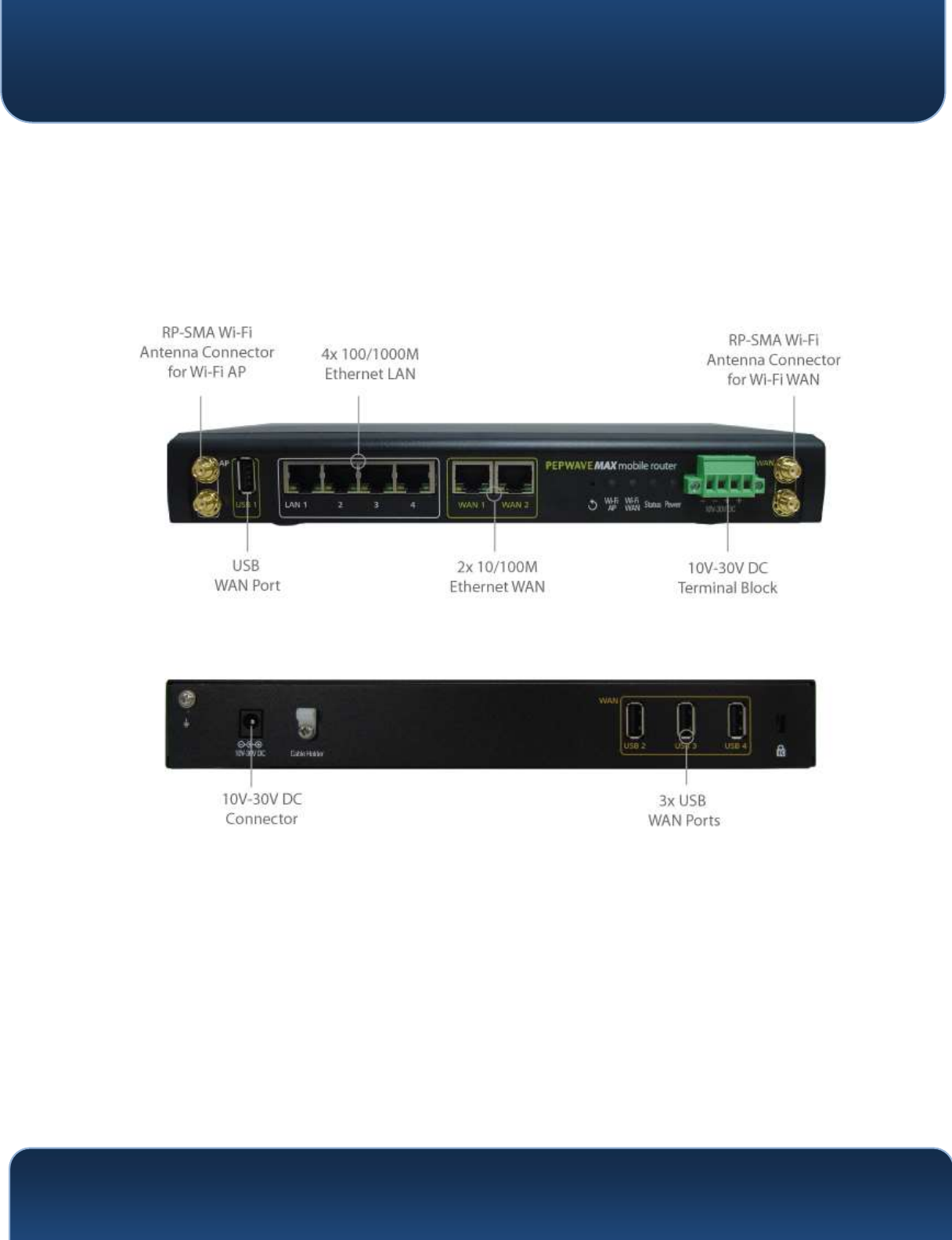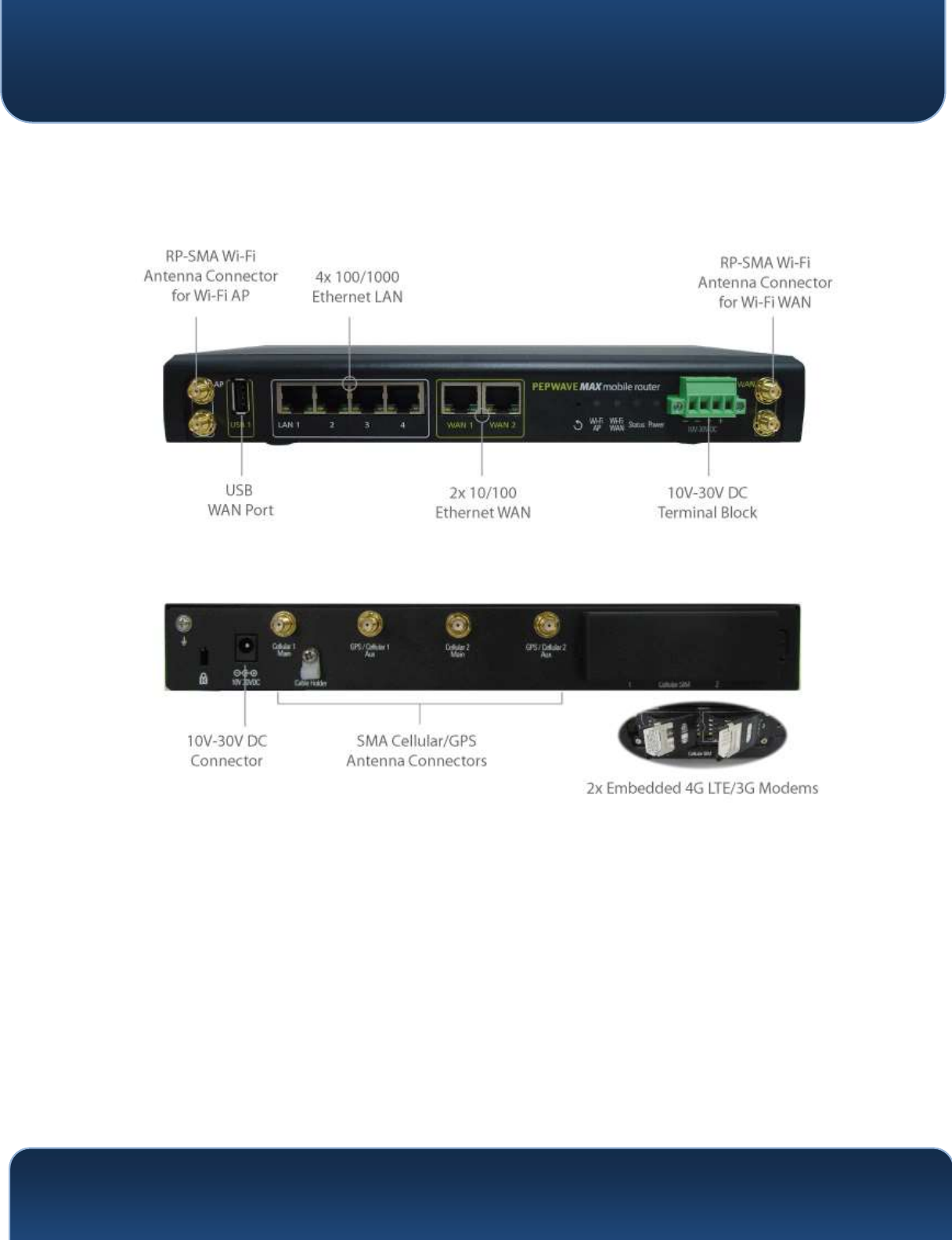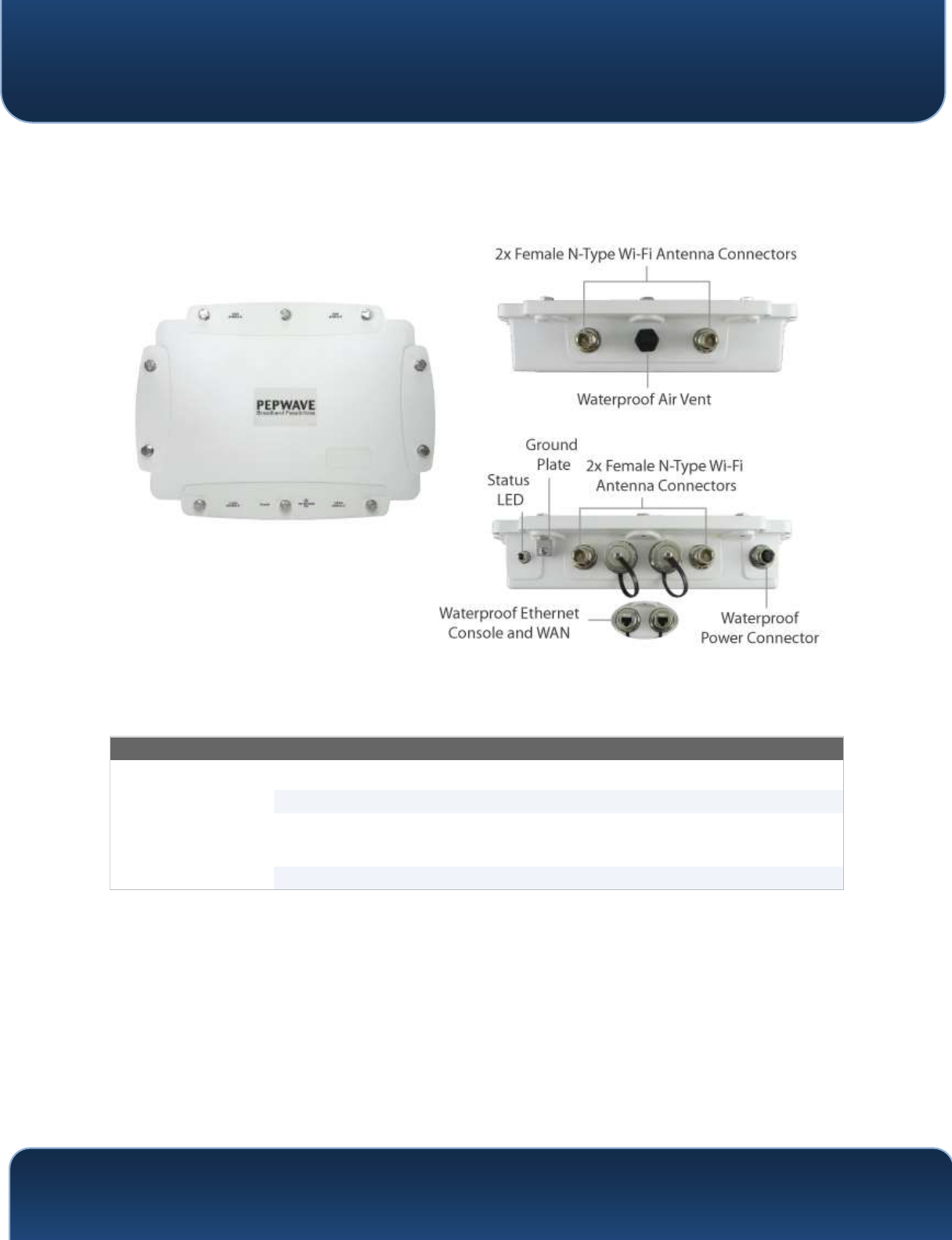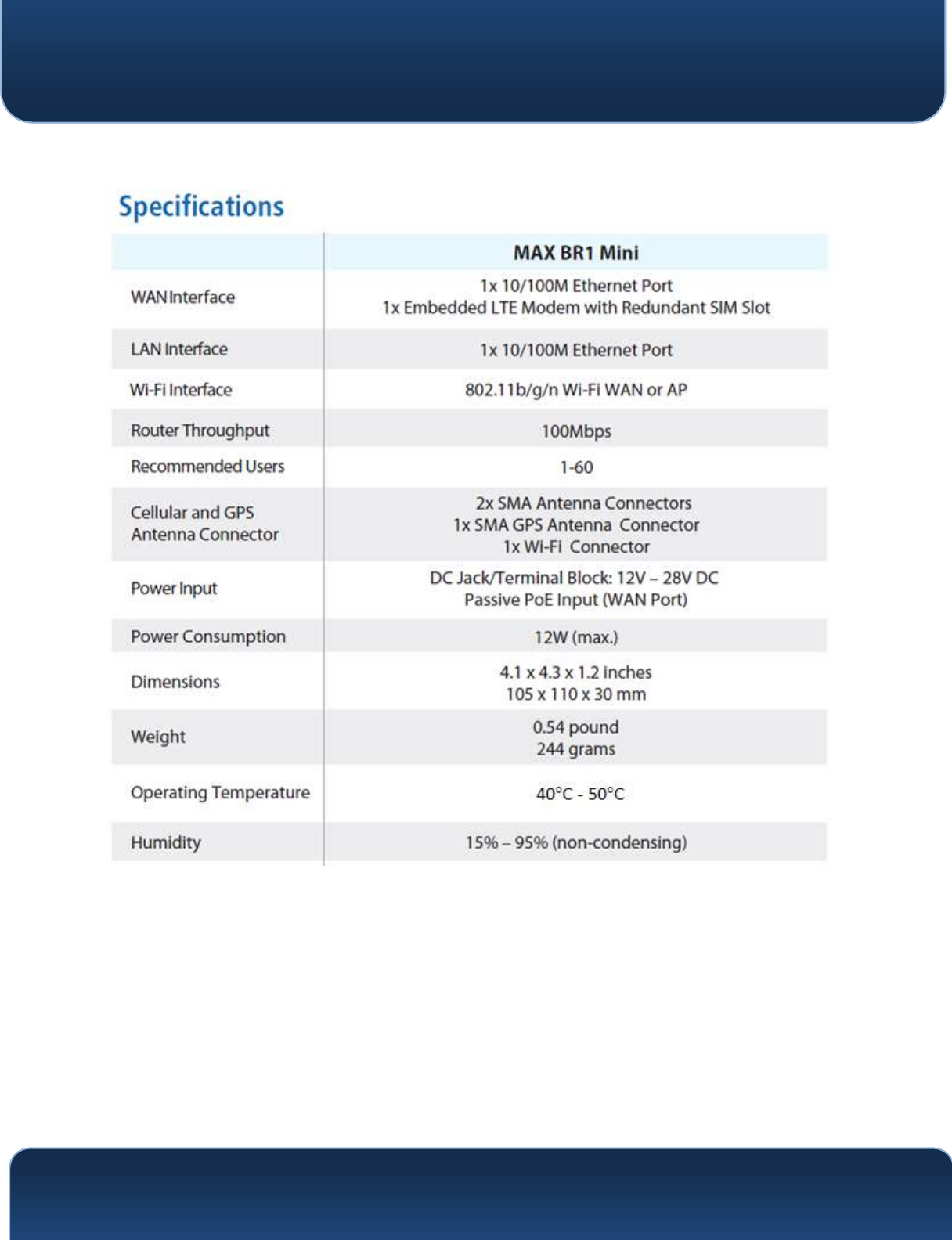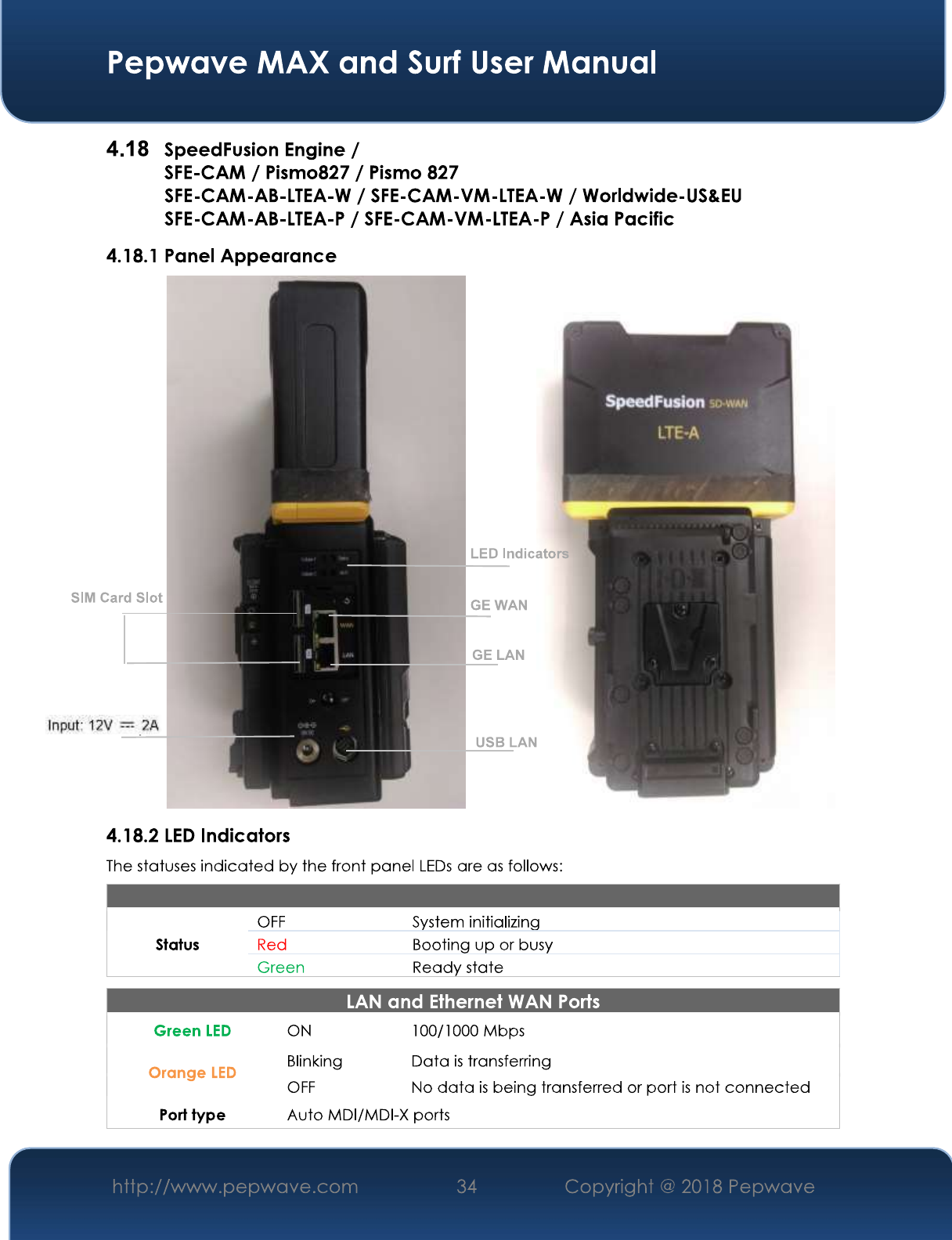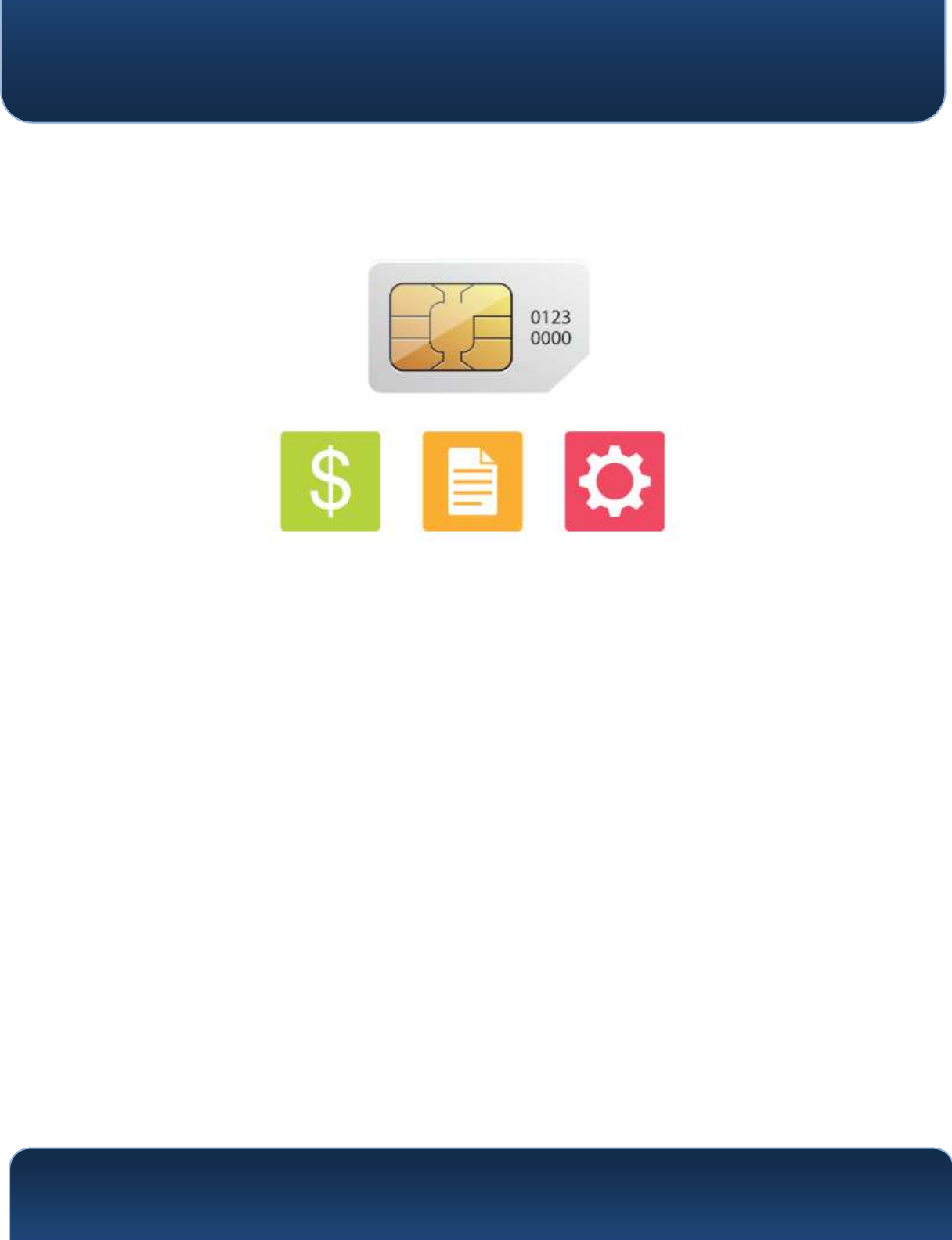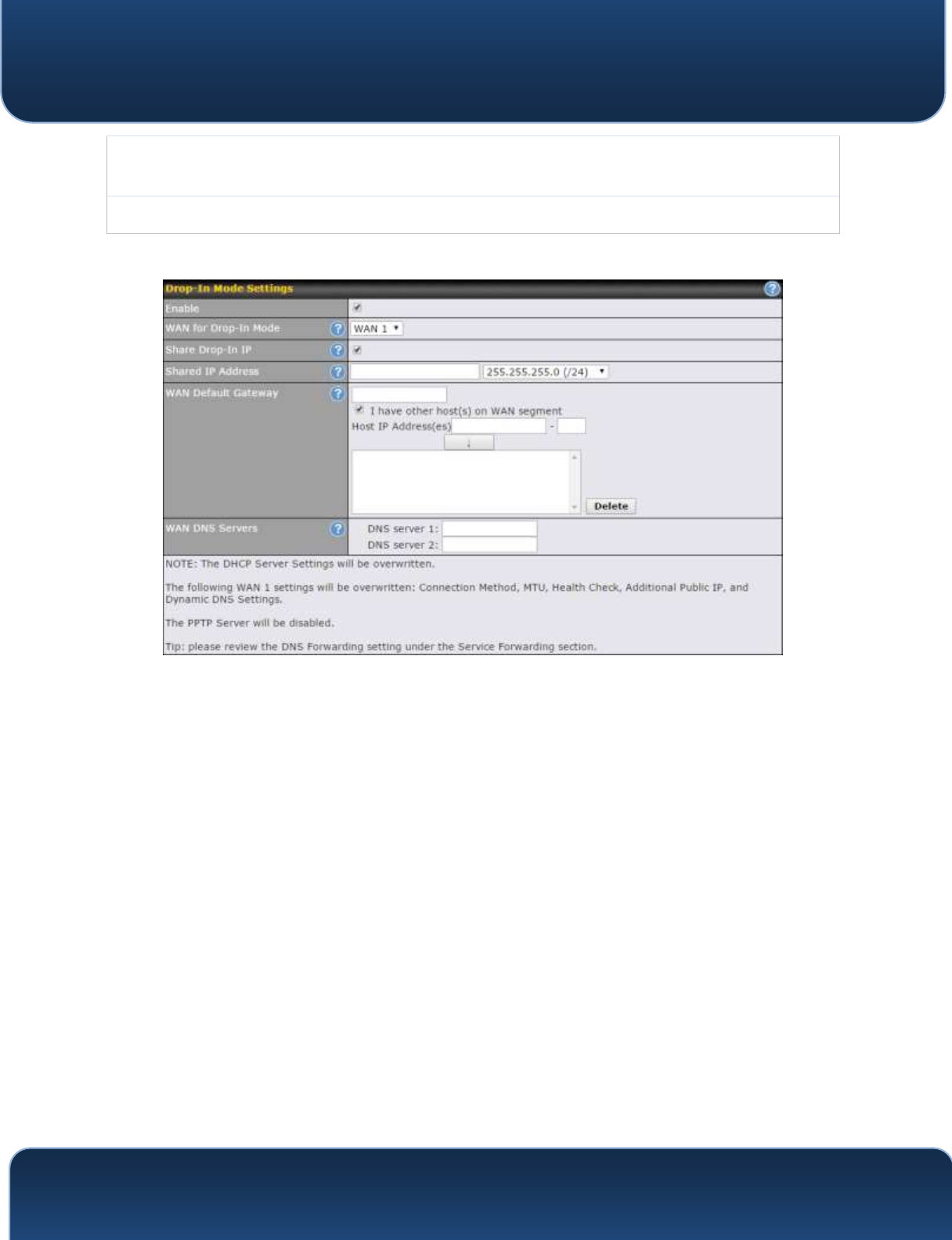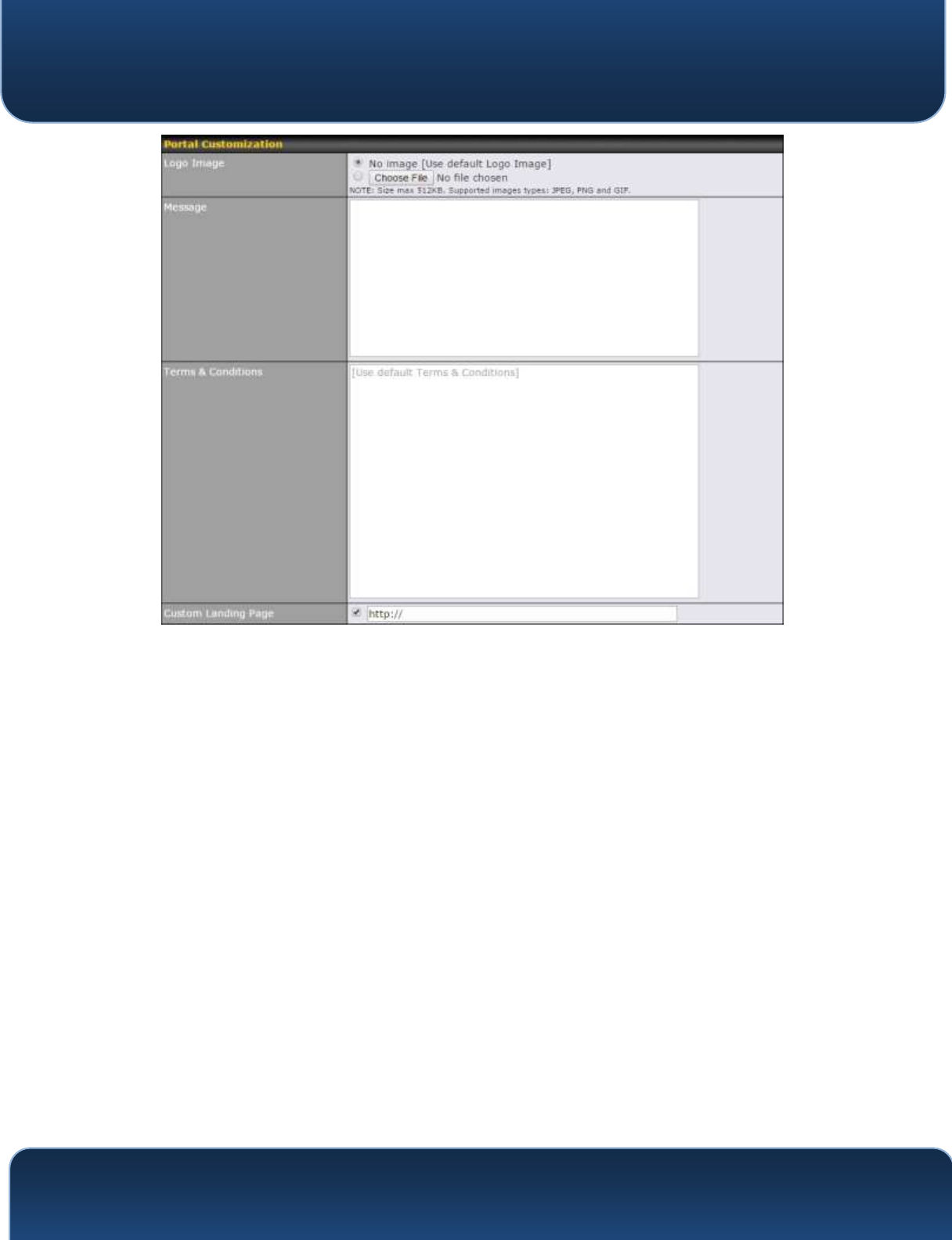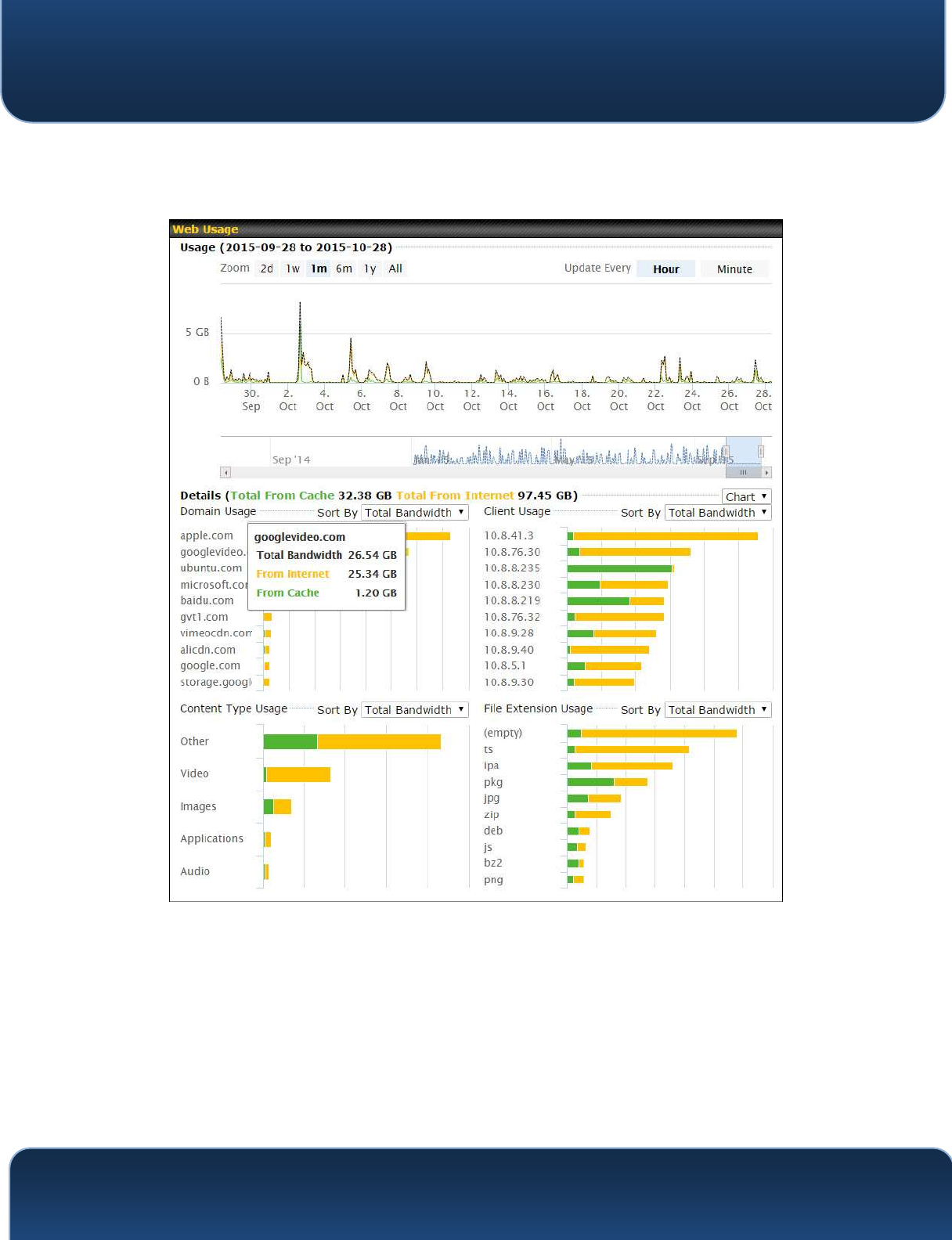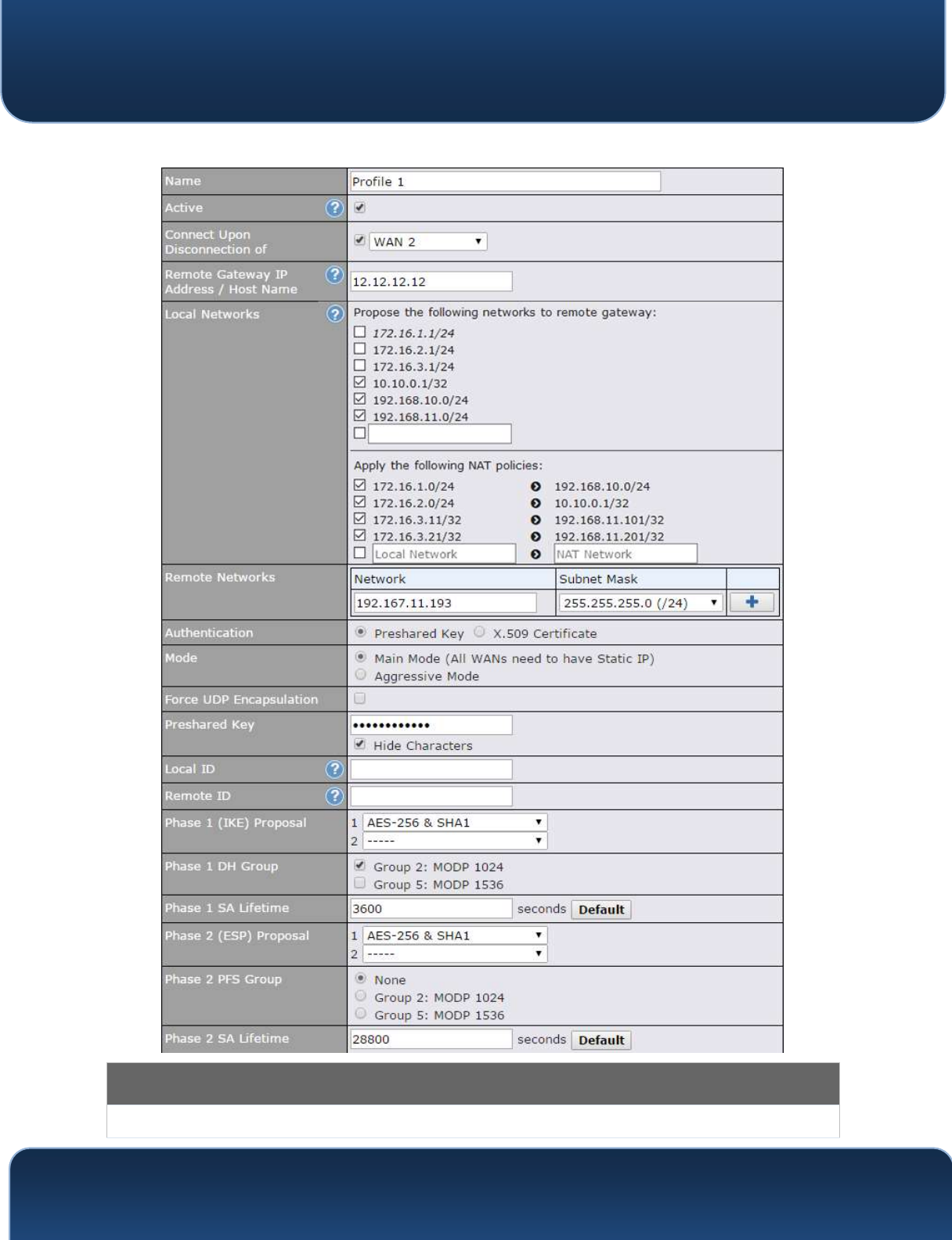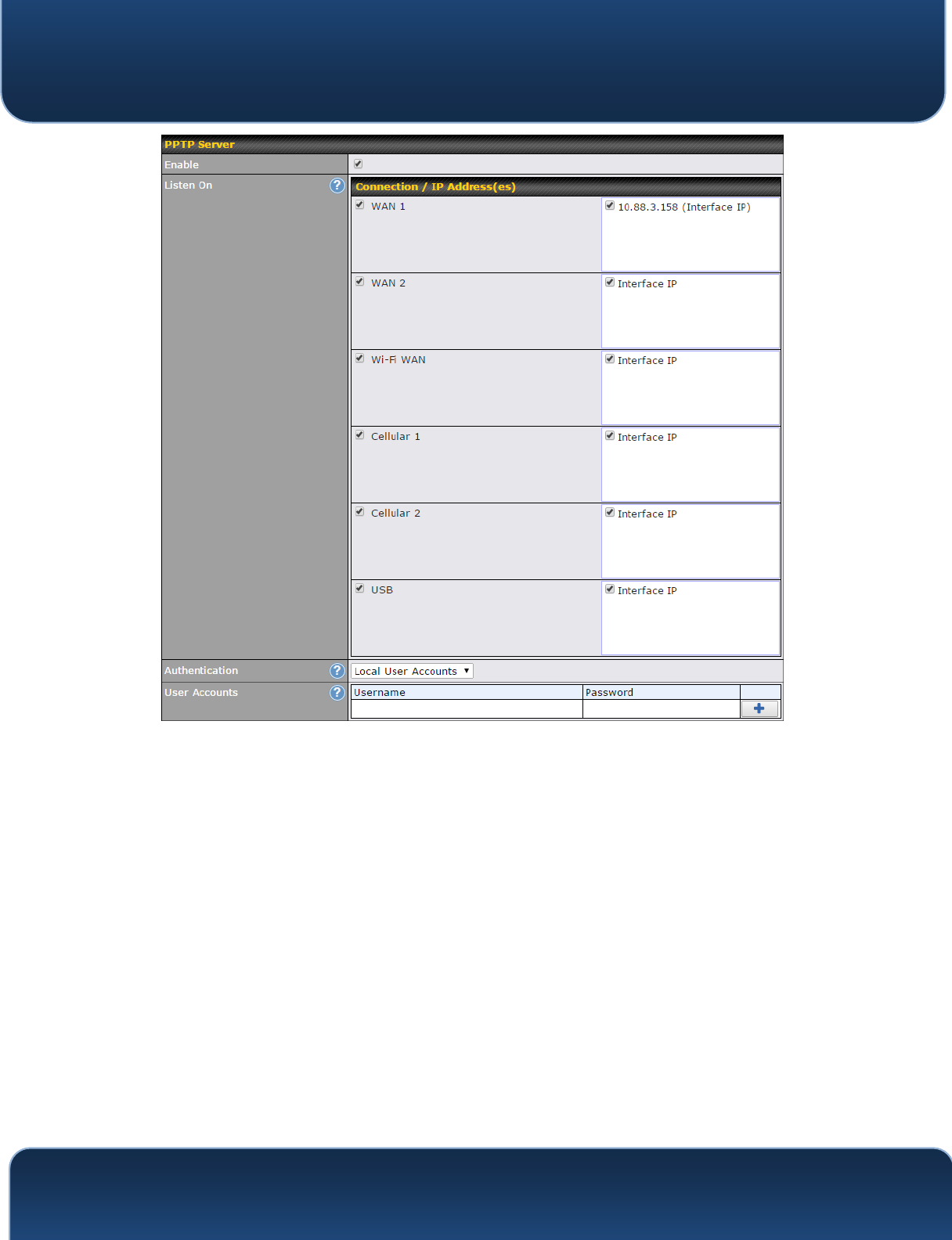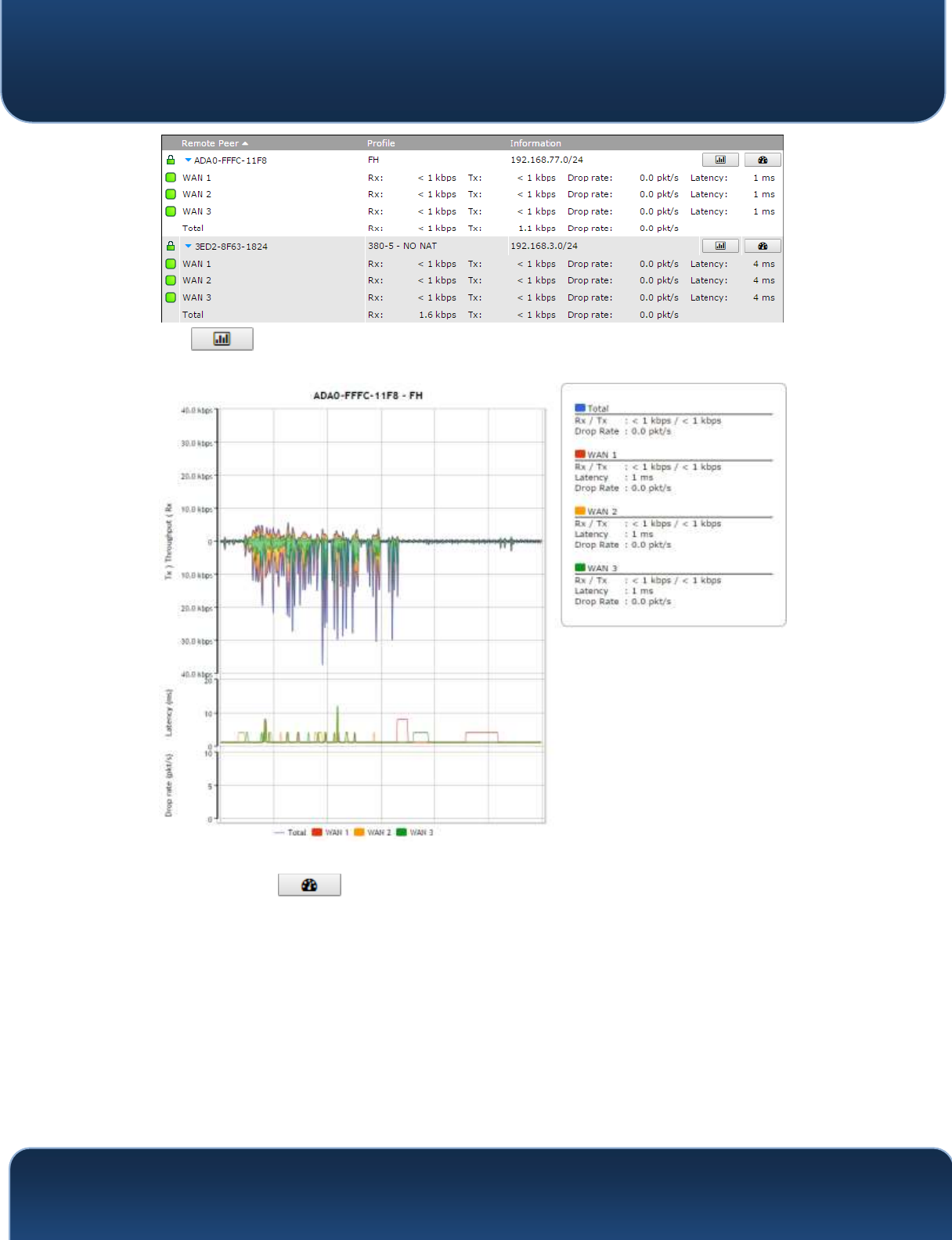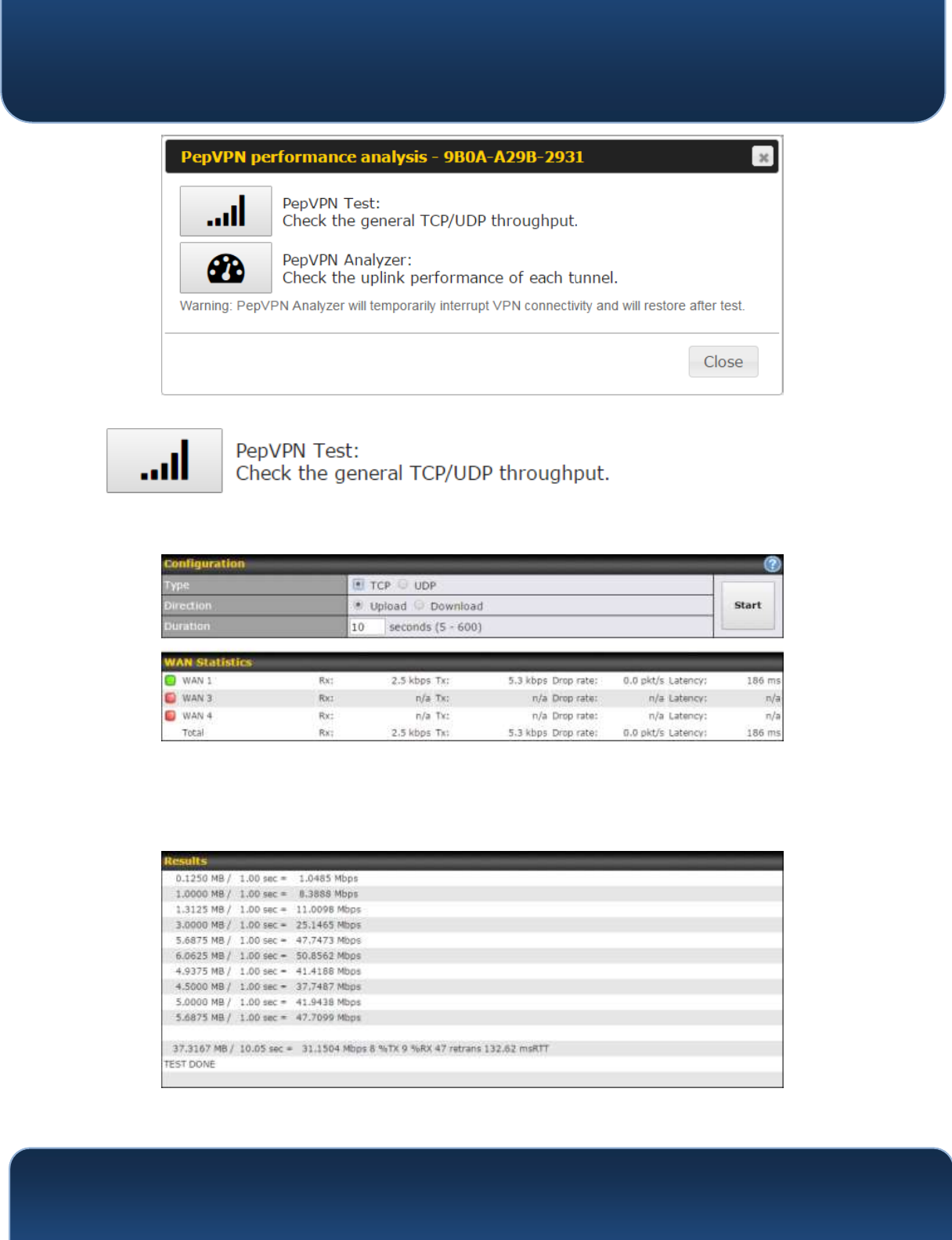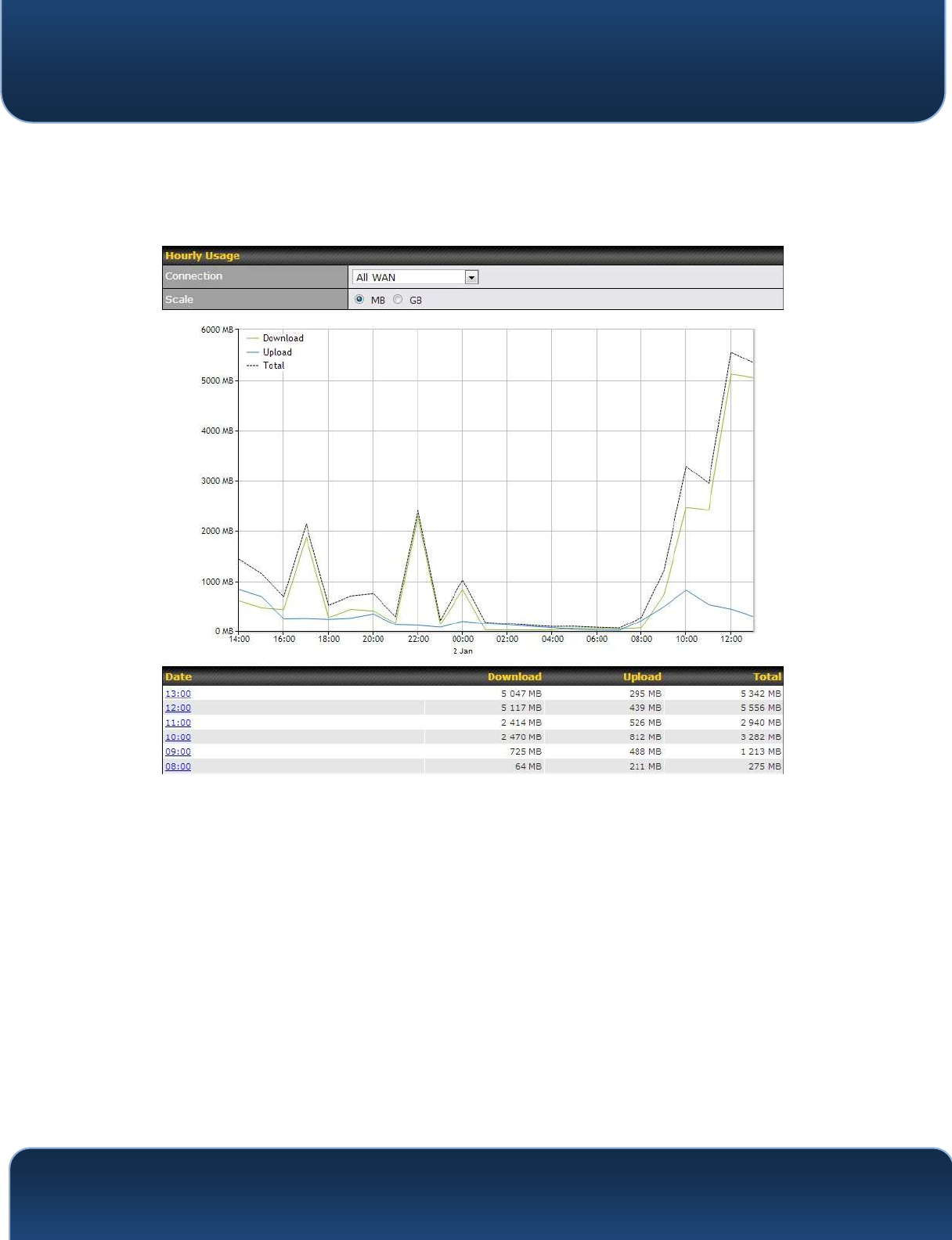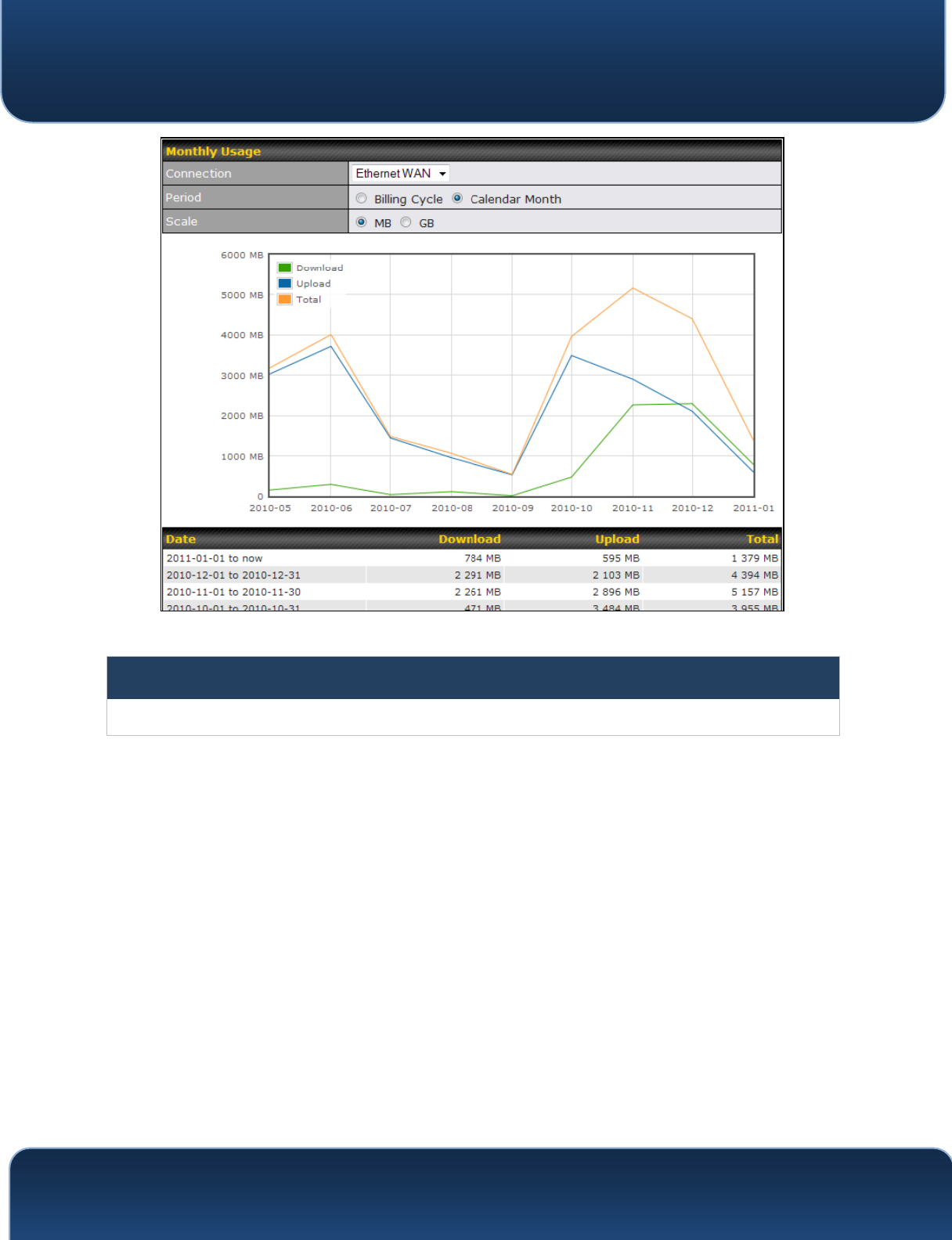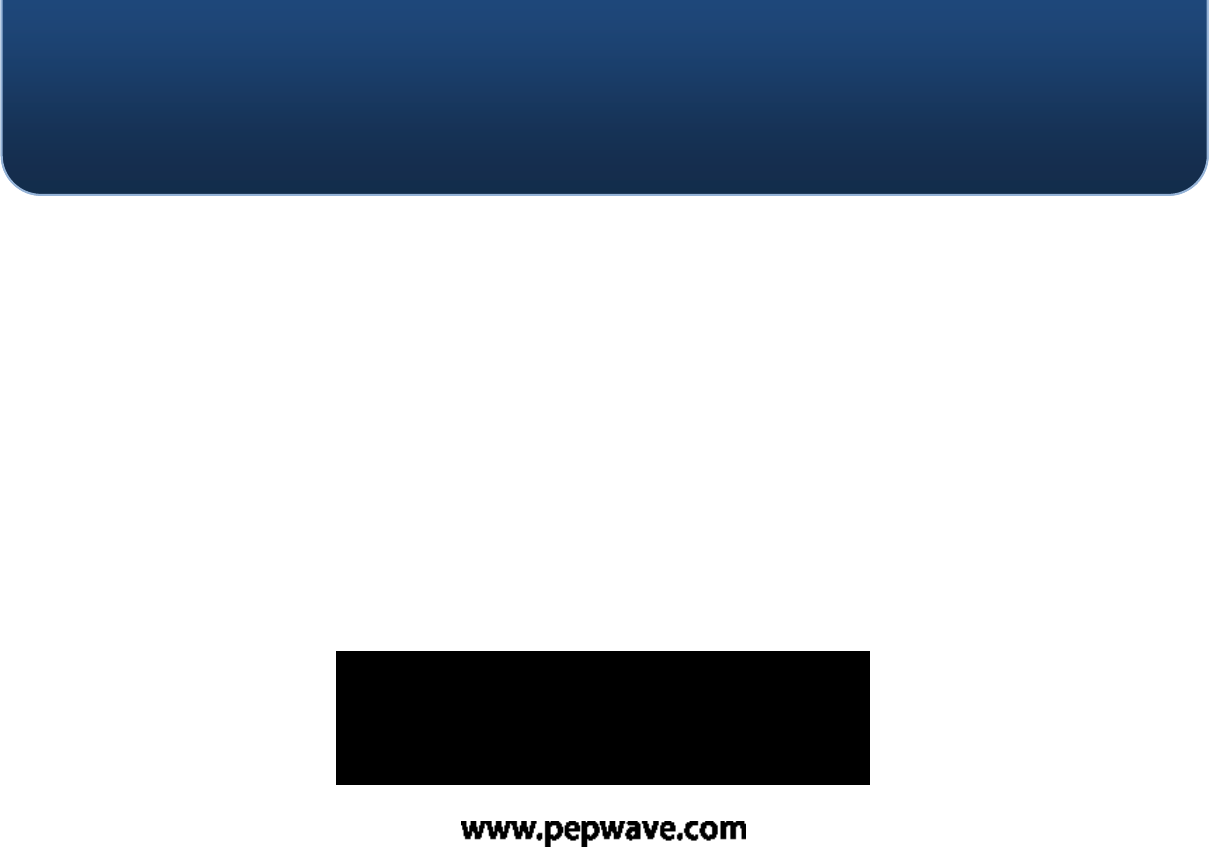Pismolabs Technology P1827 Pepwave / Peplink / Pismo Labs Wireless Product User Manual Pepwave MAX
Pismo Labs Technology Limited Pepwave / Peplink / Pismo Labs Wireless Product Pepwave MAX
User Manual
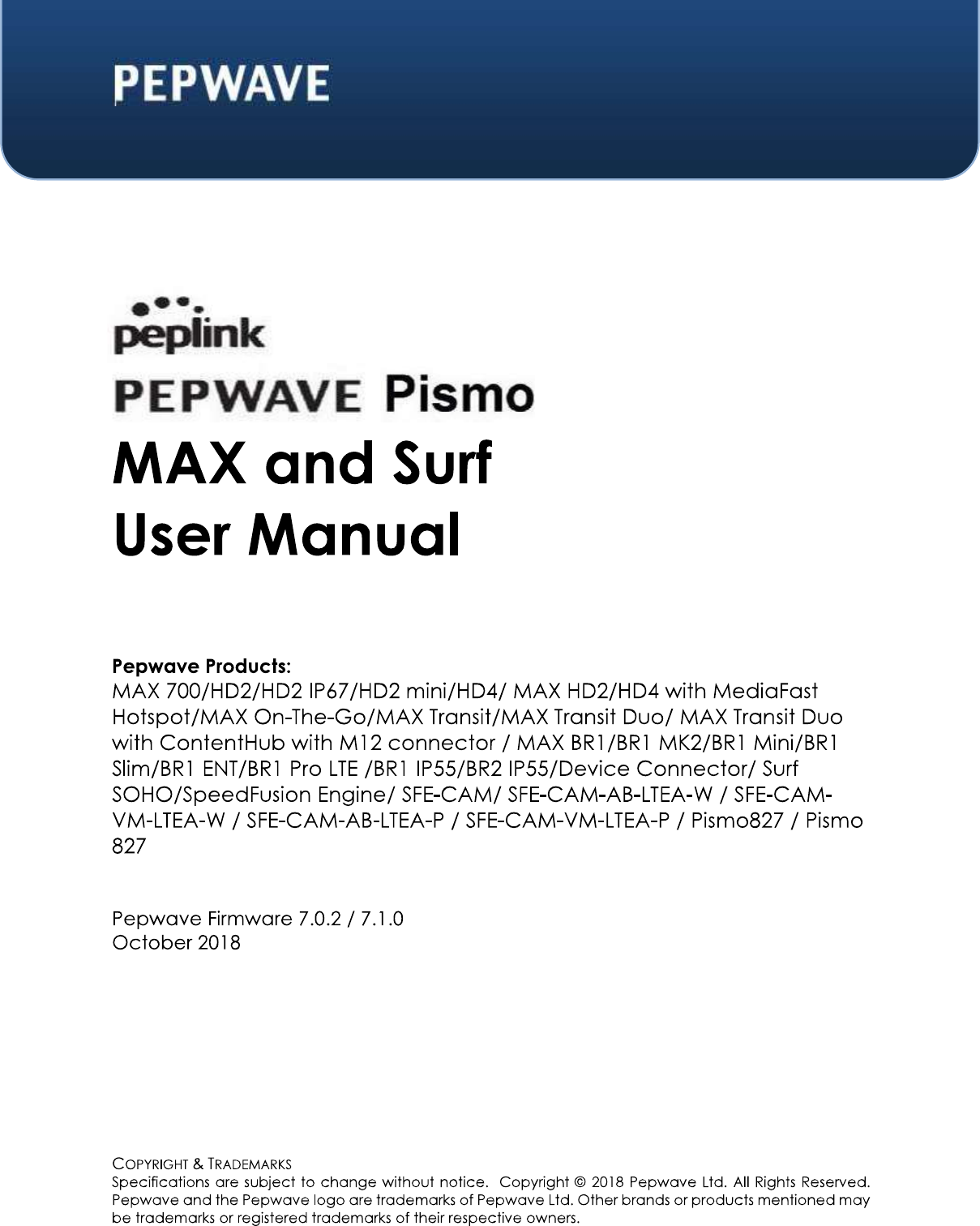

Pepwave MAX and Surf User Manual
http://www.pepwave.com
5
Copyright @ 2018 Pepwave
22 STATUS ................................................................................................................... 172
22.1 DEVICE ........................................................................................................ 172
22.2 ACTIVE SESSIONS .......................................................................................... 174
22.3 CLIENT LIST ................................................................................................... 176
22.4 WINS CLIENT ............................................................................................... 176
22.5 UPNP / NAT-PMP ....................................................................................... 177
22.6 SPEEDFUSION STATUS ..................................................................................... 177
22.7 EVENT LOG .................................................................................................. 181
22.8 BANDWIDTH.................................................................................................. 181
APPENDIX A. RESTORATION OF FACTORY DEFAULTS ............................................ 187
APPENDIX B: DECLARATION ...................................................................................... 188
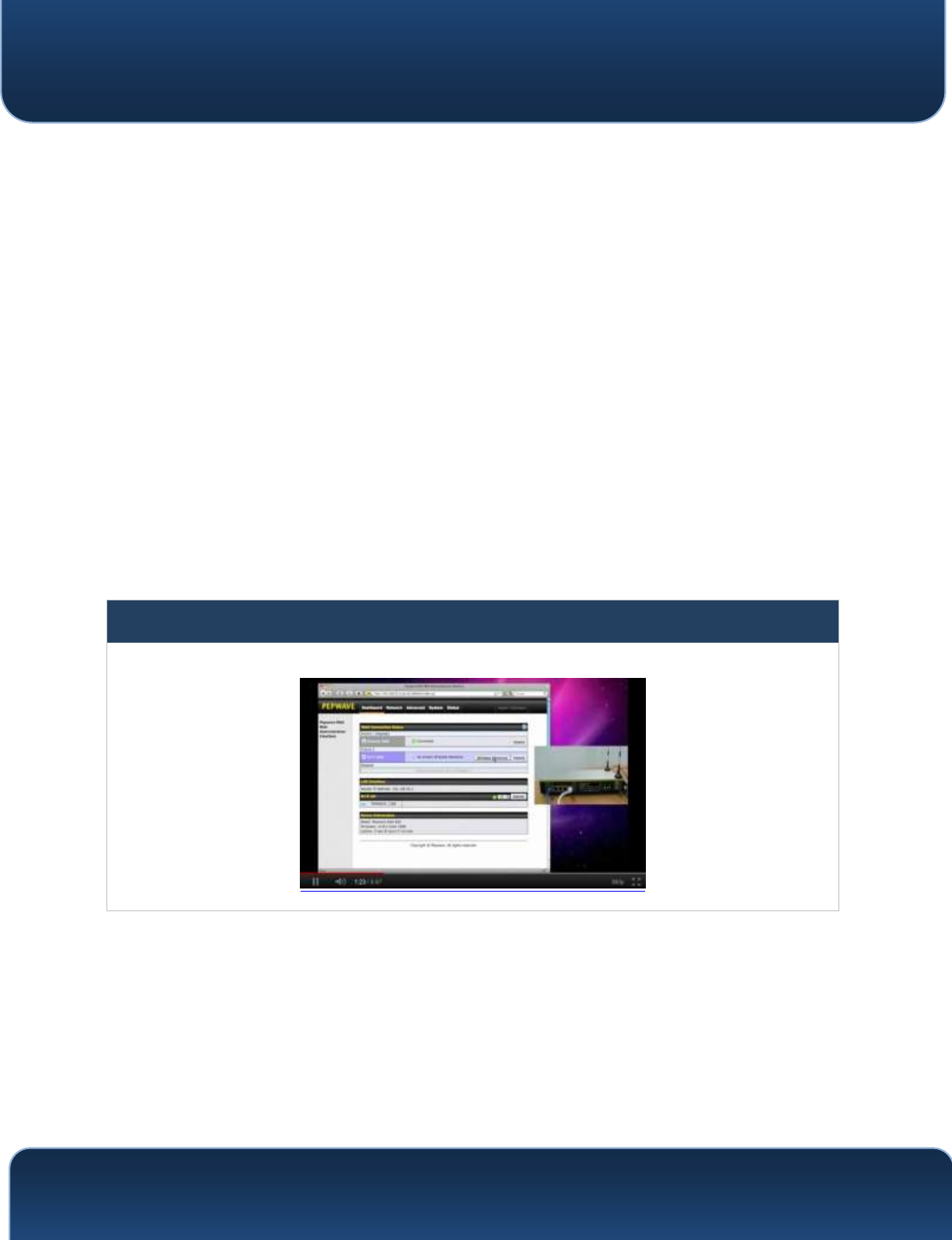
Pepwave MAX and Surf User Manual
http://www.pepwave.com
6
Copyright @ 2018 Pepwave
1 Introduction and Scope
Pepwave routers provide link aggregation and load balancing across multiple
WAN connections, allowing a combination of technologies like 3G HSDPA,
EVDO, 4G LTE, Wi-Fi, external WiMAX dongle, and satellite to be utilized to
connect to the Internet.
The MAX wireless SD-WAN router series has a wide range of products suitable for
many different deployments and markets. Entry level SD-WAN models such as
the MAX BR1 are suitable for SMEs or branch offices. High-capacity SD-WAN
routers such as the MAX HD2 are suitable for larger organizations and head
offices.
This manual covers setting up Pepwave routers and provides an introduction to
their features and usage.
Tips
Want to know more about Pepwave routers? Visit our YouTube Channel for a video introduction!
http://youtu.be/UCkVQThLKO4

Pepwave MAX and Surf User Manual
http://www.pepwave.com
7
Copyright @ 2018 Pepwave
2 Glossary
The following terms, acronyms, and abbreviations are frequently used in this
manual:
Term
Definition
3G
3rd Generation standards for wireless communications
4G
4th Generation standards for wireless communications
DHCP
Dynamic Host Configuration Protocol
DNS
Domain Name System
EVDO
Evolution-Data Optimized
HSDPA
High-Speed Downlink Packet Access
HTTP
Hyper-Text Transfer Protocol
ICMP
Internet Control Message Protocol
IP
Internet Protocol
LAN
Local Area Network
MAC Address
Media Access Control Address
MTU
Maximum Transmission Unit
MSS
Maximum Segment Size
NAT
Network Address Translation
PPPoE
Point to Point Protocol over Ethernet
QoS
Quality of Service
SNMP
Simple Network Management Protocol
TCP
Transmission Control Protocol
UDP
User Datagram Protocol
VPN
Virtual Private Network
VRRP
Virtual Router Redundancy Protocol
WAN
Wide Area Network
WINS
Windows Internet Name Service
WLAN
Wireless Local Area Network

Pepwave MAX and Surf User Manual
http://www.pepwave.com
8
Copyright @ 2018 Pepwave
3 Product Features
Pepwave routers enable all LAN users to share broadband Internet connections,
and they provide advanced features to enhance Internet access. Our Max BR
wireless routers support multiple SIM cards. They can be configured to switch
from using one SIM card to another SIM card according to different criteria,
including wireless network reliability and data usage.
Our MAX HD series wireless routers are embedded with multiple 4G LTE modems,
and allow simultaneous wireless Internet connections through multiple wireless
networks. The wireless Internet connections can be bonded together using our
SpeedFusion technology. This allows better reliability, larger bandwidth, and
increased wireless coverage are comparing to use only one 4G LTE modem.
Below is a list of supported features on Pepwave routers. Features vary by
model. For more information, please see peplink.com/products.
3.1 Supported Network Features
3.1.1 WAN
Ethernet WAN connection in full/half duplex
Static IP support for PPPoE
Built-in HSPA and EVDO cellular modems
USB mobile connection(s)
Wi-Fi WAN connection
Network address translation (NAT)/port address translation (PAT)
Inbound and outbound NAT mapping
IPsec NAT-T and PPTP packet passthrough
MAC address clone and passthrough
Customizable MTU and MSS values
WAN connection health check
Dynamic DNS (supported service providers: changeip.com, dyndns.org,
no-ip.org, tzo.com and DNS-O-Matic)
Ping, DNS lookup, and HTTP-based health check

Pepwave MAX and Surf User Manual
http://www.pepwave.com
9
Copyright @ 2018 Pepwave
3.1.2 LAN
Wi-Fi AP
Ethernet LAN ports
DHCP server on LAN
Extended DHCP option support
Static routing rules
VLAN on LAN support
3.1.3 VPN
PepVPN with SpeedFusionTM
PepVPN performance analyzer
X.509 certificate support
VPN load balancing and failover among selected WAN connections
Bandwidth bonding and failover among selected WAN connections
IPsec VPN for network-to-network connections (works with Cisco and
Juniper only)
Ability to route Internet traffic to a remote VPN peer
Optional pre-shared key setting
SpeedFusionTM throughput, ping, and traceroute tests
PPTP server
PPTP and IPsec passthrough
3.1.4 Firewall
Outbound (LAN to WAN) firewall rules
Inbound (WAN to LAN) firewall rules per WAN connection
Intrusion detection and prevention
Specification of NAT mappings
Outbound firewall rules can be defined by destination domain name

Pepwave MAX and Surf User Manual
http://www.pepwave.com
10
Copyright @ 2018 Pepwave
3.1.5 Captive Portal
Splash screen of open networks, login page for secure networks
Customizable built-in captive portal
Supports linking to outside page for captive portal
3.1.6 Outbound Policy
Link load distribution per TCP/UDP service
Persistent routing for specified source and/or destination IP addresses per
TCP/UDP service
Traffic prioritization and DSL optimization
Prioritize and route traffic to VPN tunnels with Priority and Enforced
algorithms
3.1.7 AP Controller
Configure and manage Pepwave AP devices
Review the status of connected APs
3.1.8 QoS
Quality of service for different applications and custom protocols
User group classification for different service levels
Bandwidth usage control and monitoring on group- and user-level
Application prioritization for custom protocols and DSL/cable optimization

Pepwave MAX and Surf User Manual
http://www.pepwave.com
11
Copyright @ 2018 Pepwave
3.2 Other Supported Features
User-friendly web-based administration interface
HTTP and HTTPS support for web admin interface
Configurable web administration port and administrator password
Firmware upgrades, configuration backups, ping, and traceroute via web
admin interface
Remote web-based configuration (via WAN and LAN interfaces)
Time server synchronization
SNMP
Email notification
Read-only user for web admin
Shared IP drop-in mode
Authentication and accounting by RADIUS server for web admin
Built-in WINS servers*
Syslog
SIP passthrough
PPTP packet passthrough
Event log
Active sessions
Client list
WINS client list *
UPnP / NAT-PMP
Real-time, hourly, daily, and monthly bandwidth usage reports and charts
IPv6 support
Support USB tethering on Android 2.2+ phones
* Not supported on MAX Surf-On-The-Go, Surf SOHO, and BR1 variants
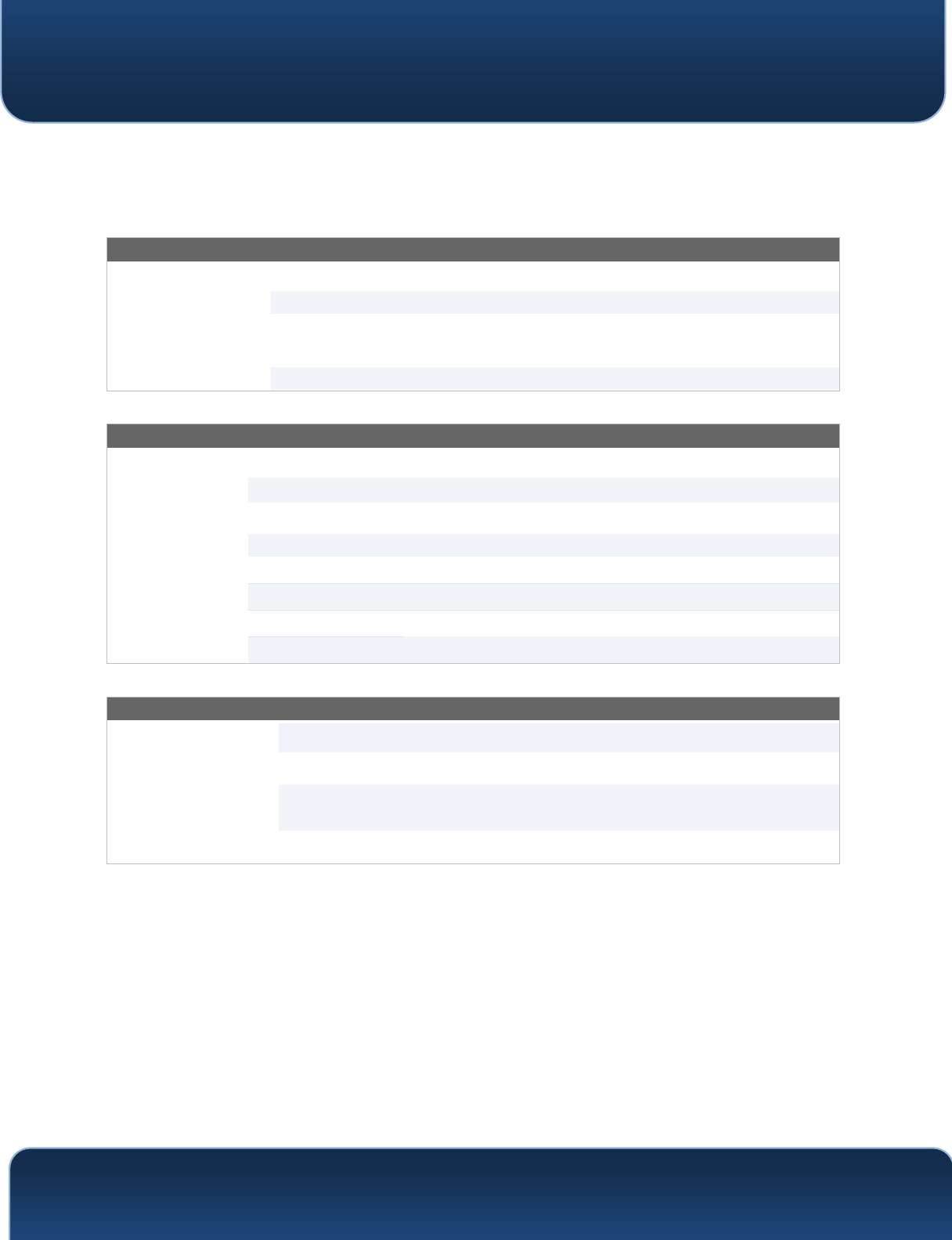
Pepwave MAX and Surf User Manual
http://www.pepwave.com
13
Copyright @ 2018 Pepwave
4.1.2 LED Indicators
The statuses indicated by the front panel LEDs are as follows:
Status Indicators
Status
OFF
System initializing
Red
Booting up or busy
Blinking
red
Boot up error
Green
Ready
Wi-Fi AP and Wi-Fi WAN Indicators
Wi-Fi WAN
OFF
Disconnected
Blinking slowly
Connecting to network
Blinking
Connected to network with traffic
ON
Connected to network without traffic
Wi-Fi AP
OFF
Disabled
Blinking slowly
Enabled but no client connected
Blinking
Connected to network with traffic
ON
Client(s) connected to wireless network
LAN and Ethernet WAN Ports
Green LED
ON
10 / 100/ 1000 Mbps
Orange LED
Blinking
Data is transferring
OFF
No data is being transferred or port is not
connected
Port Type
Auto MDI/MDI-X ports
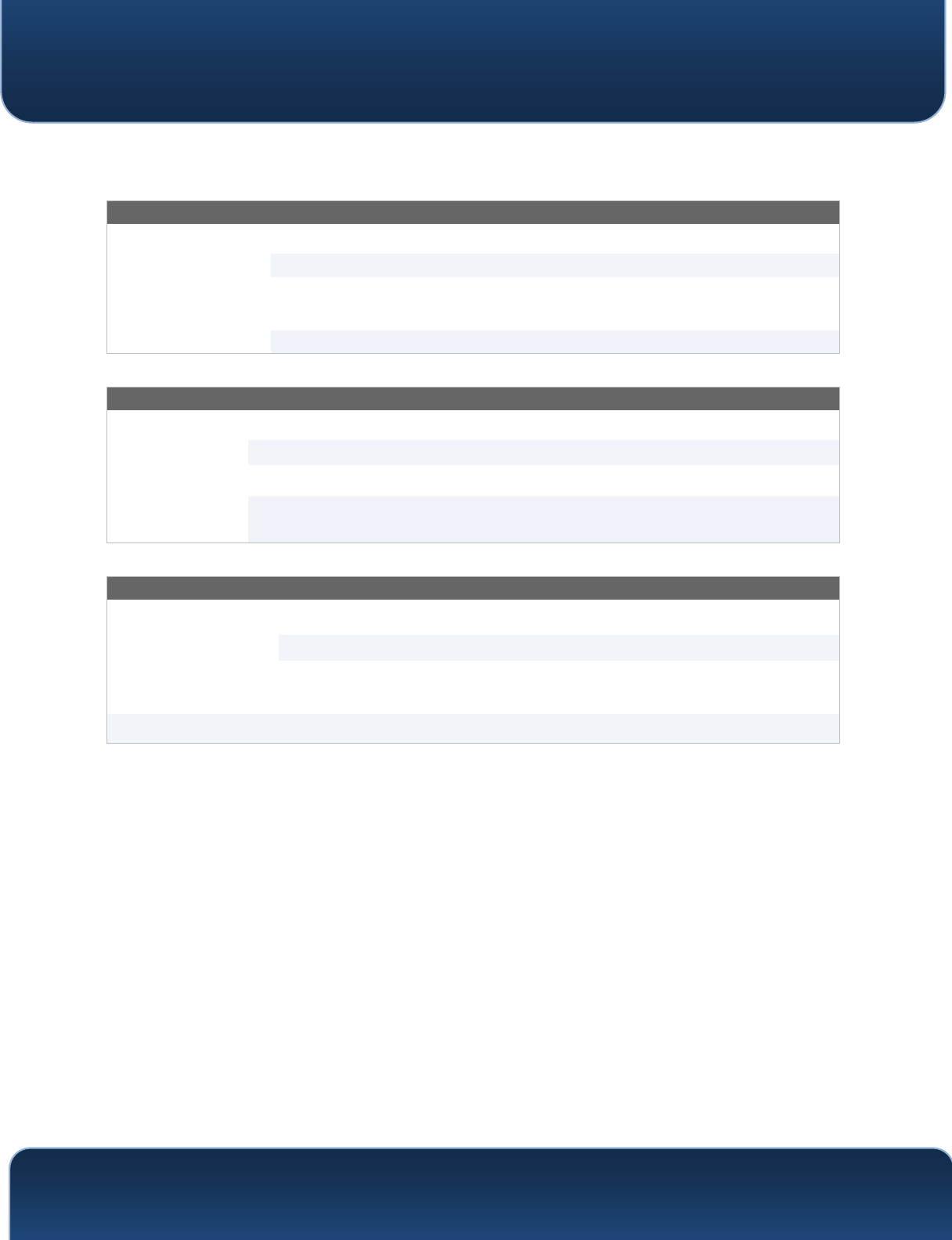
Pepwave MAX and Surf User Manual
http://www.pepwave.com
15
Copyright @ 2018 Pepwave
4.2.2 LED Indicators
The statuses indicated by the front panel LEDs are as follows:
Status Indicators
Status
OFF
System initializing
Red
Booting up or busy
Blinking
red
Boot up error
Green
Ready
Wi-Fi AP and Wi-Fi WAN Indicators
Wi-Fi WAN /
Cellular 1 /
Cellular 2
OFF
Disabled Intermittent
Blinking slowly
Connecting to wireless network(s)
Blinking
Connected to wireless network(s) with traffic
ON
Connected to wireless network(s) without
traffic
LAN and Ethernet WAN Ports
Green LED
ON
10 / 100 / 1000 Mbps
Orange LED
Blinking
Data is transferring
OFF
No data is being transferred or port is not
connected
Port Type
Auto MDI/MDI-X ports
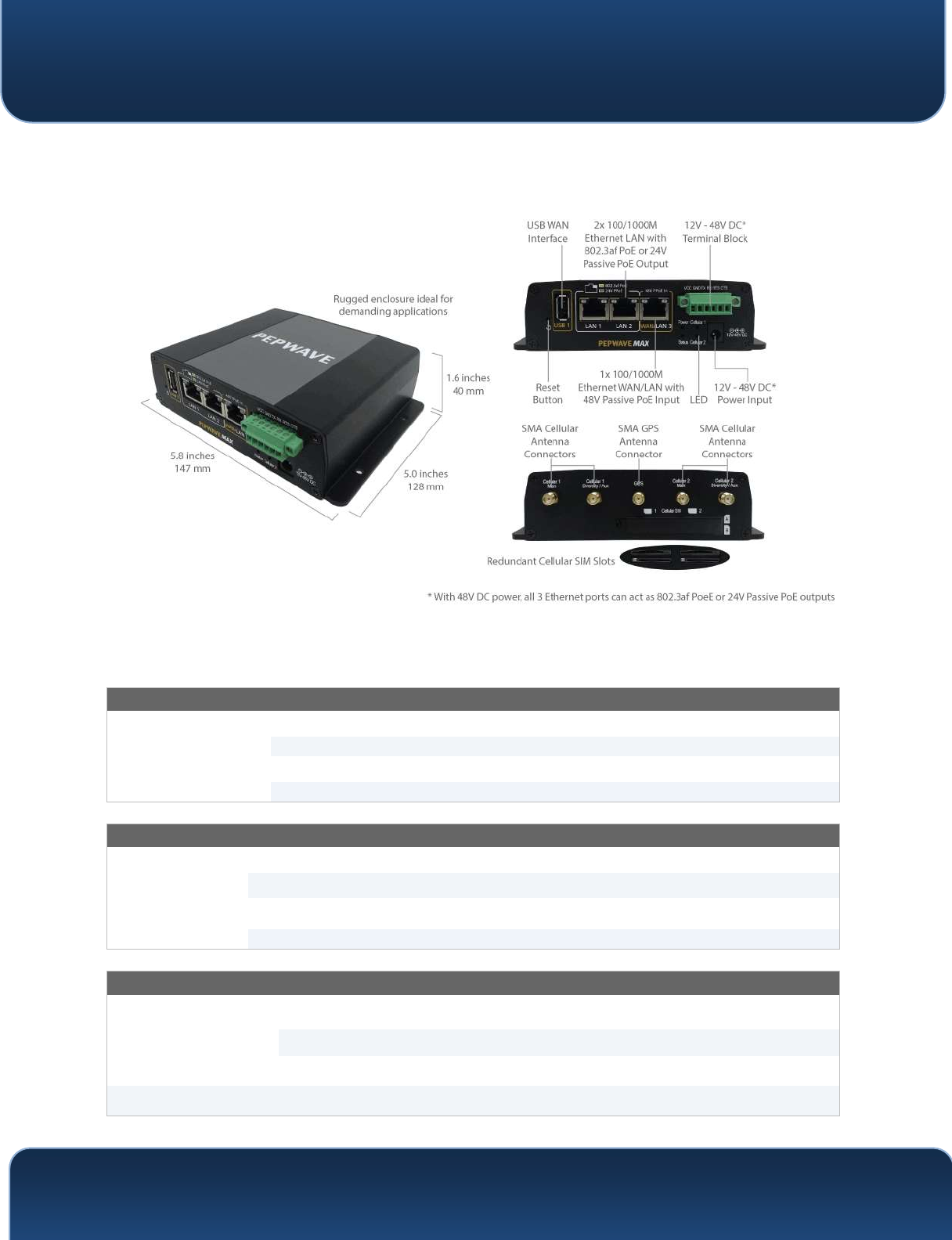
Pepwave MAX and Surf User Manual
http://www.pepwave.com
17
Copyright @ 2018 Pepwave
4.4 MAX HD2 mini
4.4.1 Panel Appearance
4.4.2 LED Indicators
The statuses indicated by the front panel LEDs are as follows:
Status Indicators
Status
OFF
System initializing
Red
Booting up or busy
Blinking red
Boot up error
Green
Ready
Cellular WAN Indicators
Cellular 1 /
Cellular 2
OFF
Disabled intermittent
Blinking slowly
Connecting to wireless network(s)
Blinking
Connected to wireless network(s) with traffic
ON
Connected to wireless network(s) without traffic
LAN and Ethernet WAN Ports
Green LED
ON
10 / 100 / 1000 Mbps
Orange LED
Blinking
Data is transferring
OFF
No data is being transferred or port is not connected
Port Type
Auto MDI/MDI-X ports
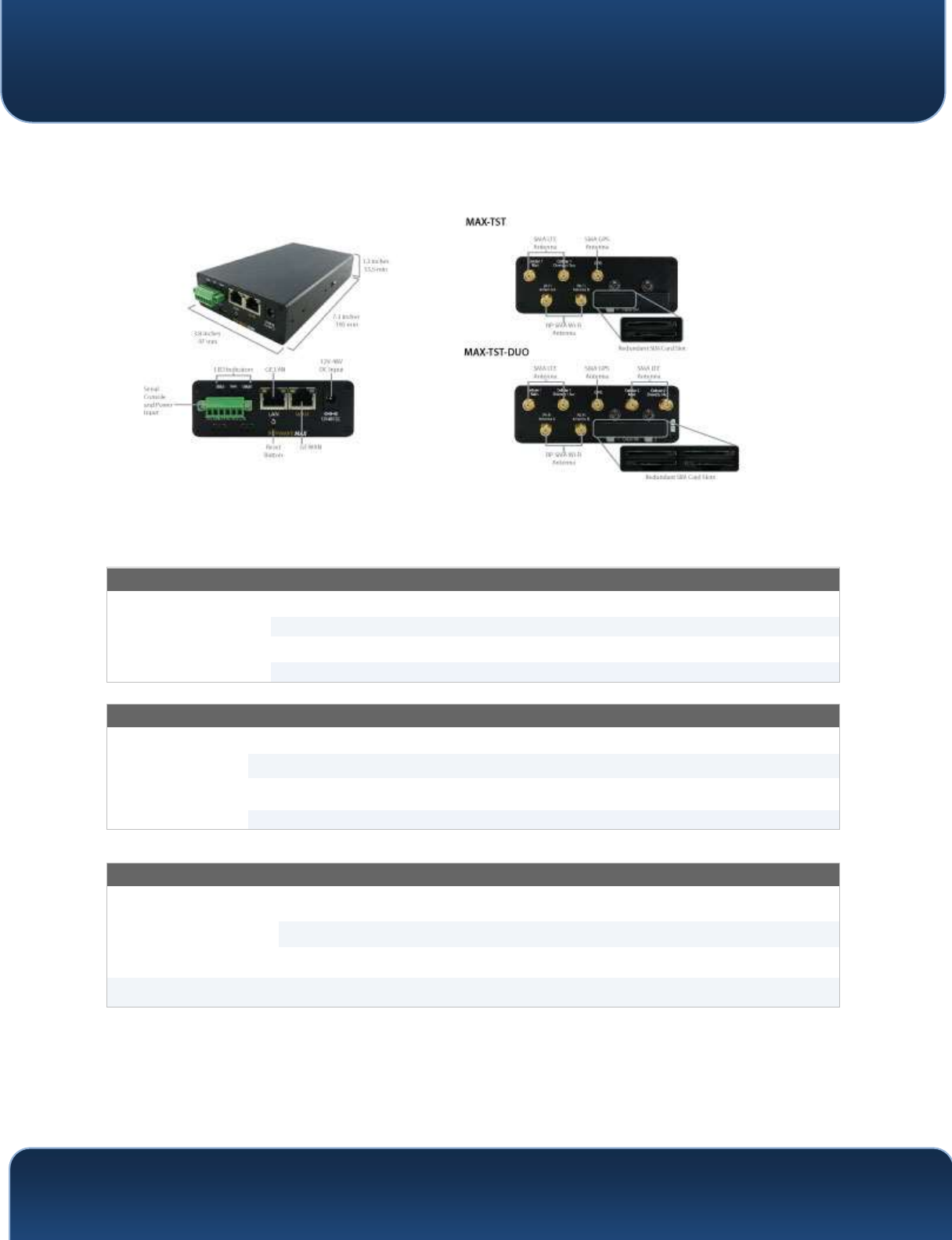
Pepwave MAX and Surf User Manual
http://www.pepwave.com
18
Copyright @ 2018 Pepwave
4.5 MAX Transit / MAX Transit Duo / MAX Transit with Content Hub
4.5.1 Panel Appearance
4.5.2 LED Indicators
The statuses indicated by the front panel LEDs are as follows:
Status Indicators
Status
OFF
System initializing
Red
Booting up or busy
Blinking red
Boot up error
Green
Ready
Cellular WAN Indicators
Cellular 1 /
Cellular 2*
OFF
Disabled intermittent
Blinking slowly
Connecting to wireless network(s)
Blinking
Connected to wireless network(s) with traffic
ON
Connected to wireless network(s) without traffic
* For MAX-TST_DUO
LAN and Ethernet WAN Ports
Green LED
ON
10 / 100 / 1000 Mbps
Orange LED
Blinking
Data is transferring
OFF
No data is being transferred or port is not connected
Port Type
Auto MDI/MDI-X ports
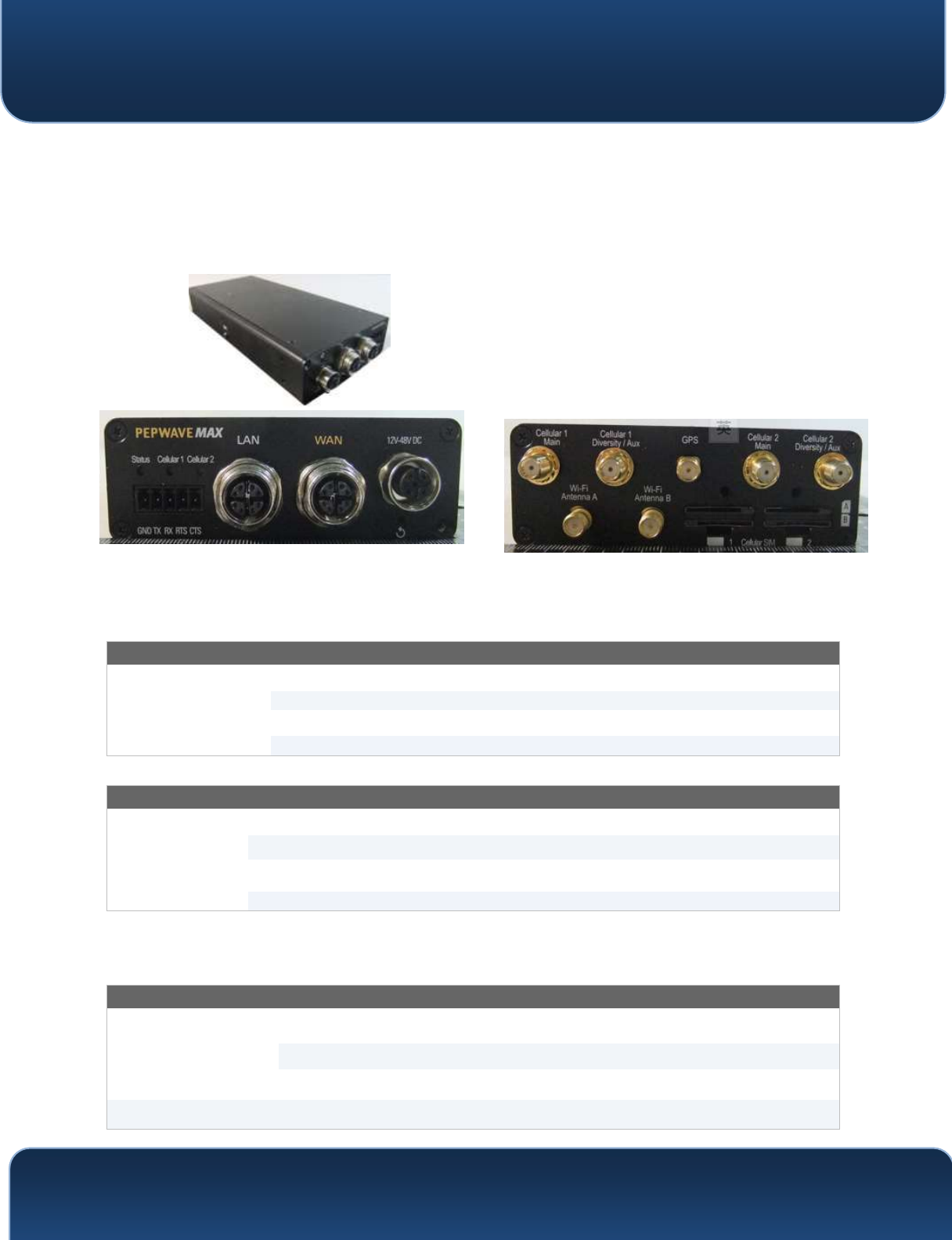
Pepwave MAX and Surf User Manual
http://www.pepwave.com
19
Copyright @ 2018 Pepwave
4.6 MAX Transit / MAX Transit Duo with M12 Connector
MAX Transit / MAX Transit Duo with Content Hub and M12
Connector
4.6.1 Panel Appearance
4.6.2 LED Indicators
The statuses indicated by the front panel LEDs are as follows:
Status Indicators
Status
OFF
System initializing
Red
Booting up or busy
Blinking red
Boot up error
Green
Ready
Cellular WAN Indicators
Cellular 1 /
Cellular 2*
OFF
Disabled intermittent
Blinking slowly
Connecting to wireless network(s)
Blinking
Connected to wireless network(s) with traffic
ON
Connected to wireless network(s) without traffic
* For MAX Transit / MAX Transit Duo with Content Hub and M12
Connector
LAN and Ethernet WAN Ports
Green LED
ON
10 / 100 / 1000 Mbps
Orange LED
Blinking
Data is transferring
OFF
No data is being transferred or port is not connected
Port Type
Auto MDI/MDI-X ports
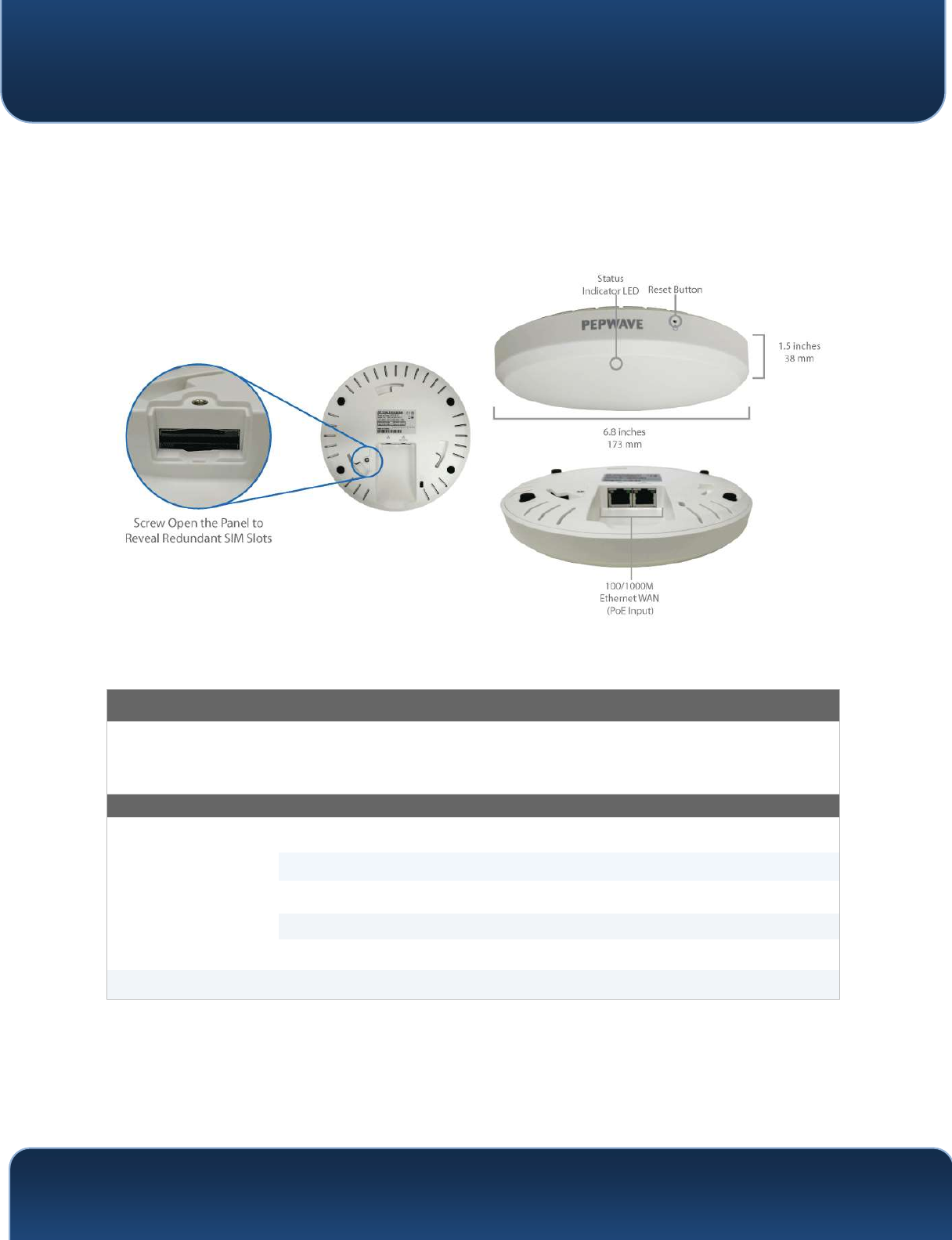
Pepwave MAX and Surf User Manual
http://www.pepwave.com
20
Copyright @ 2018 Pepwave
4.7 MAX Hotspot
4.7.1 Panel Appearance
4.7.2 LED Indications
LED Indicators
Status
RED – Access point initializing
GREEN – Access point ready
LAN and Ethernet WAN Ports
Green LED
ON
100 Mbps
OFF
10 Mbps
Orange LED
ON
Port is connected without traffic
Blinking
Data is transferring
OFF
Port is not connected
Port Type
Auto MDI/MDI-X ports
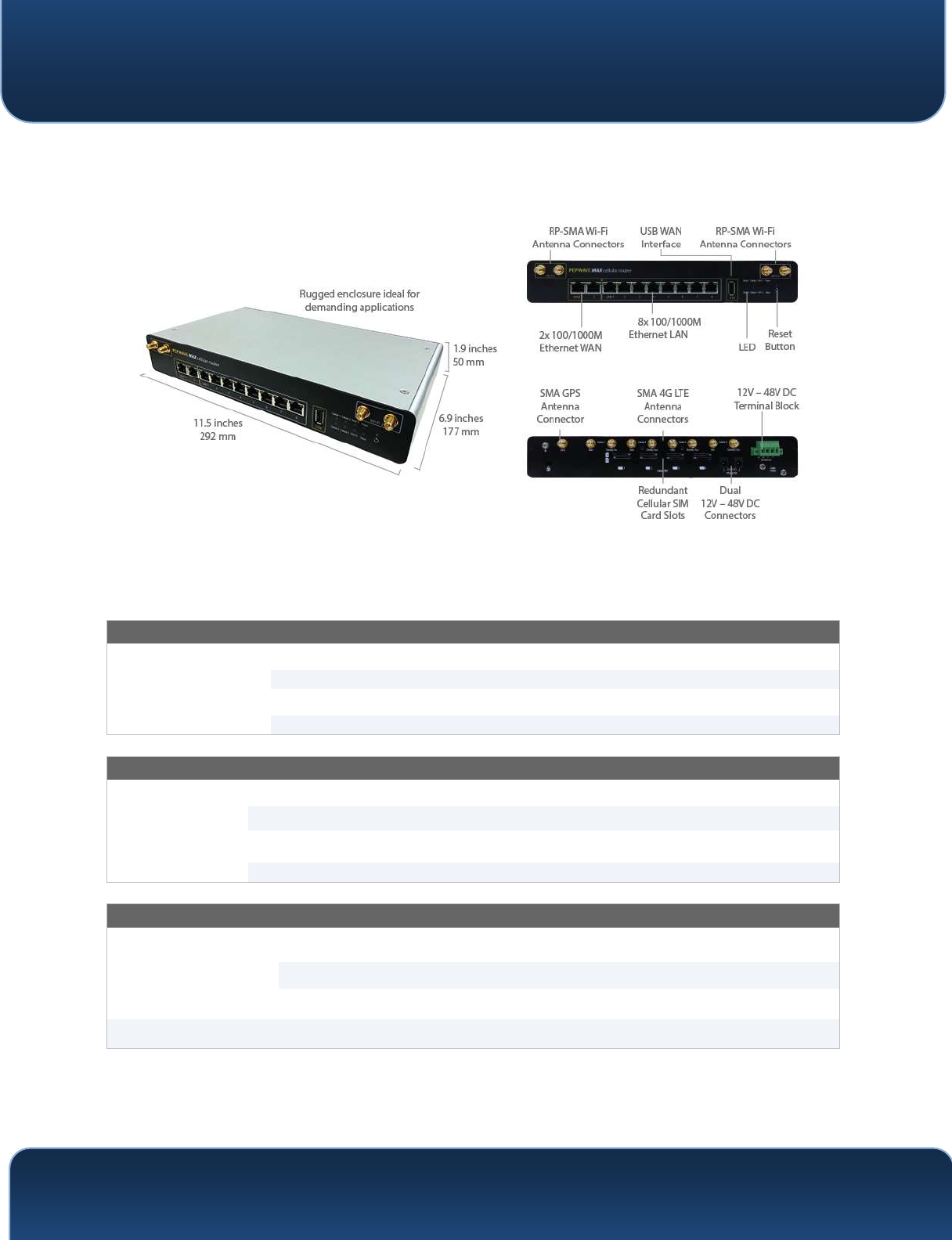
Pepwave MAX and Surf User Manual
http://www.pepwave.com
21
Copyright @ 2018 Pepwave
4.8 MAX HD4
4.8.1 Panel Appearance
4.8.2 LED Indicators
The statuses indicated by the front panel LEDs are as follows:
Status Indicators
Status
OFF
System initializing
Red
Booting up or busy
Blinking red
Boot up error
Green
Ready
Wi-Fi AP and Wi-Fi WAN Indicators
Wi-Fi WAN /
Cellular 1 /
Cellular 2
OFF
Disabled Intermittent
Blinking slowly
Connecting to wireless network(s)
Blinking
Connected to wireless network(s) with traffic
ON
Connected to wireless network(s) without traffic
LAN and Ethernet WAN Ports
Green LED
ON
10 / 100 / 1000 Mbps
Orange LED
Blinking
Data is transferring
OFF
No data is being transferred or port is not connected
Port Type
Auto MDI/MDI-X ports
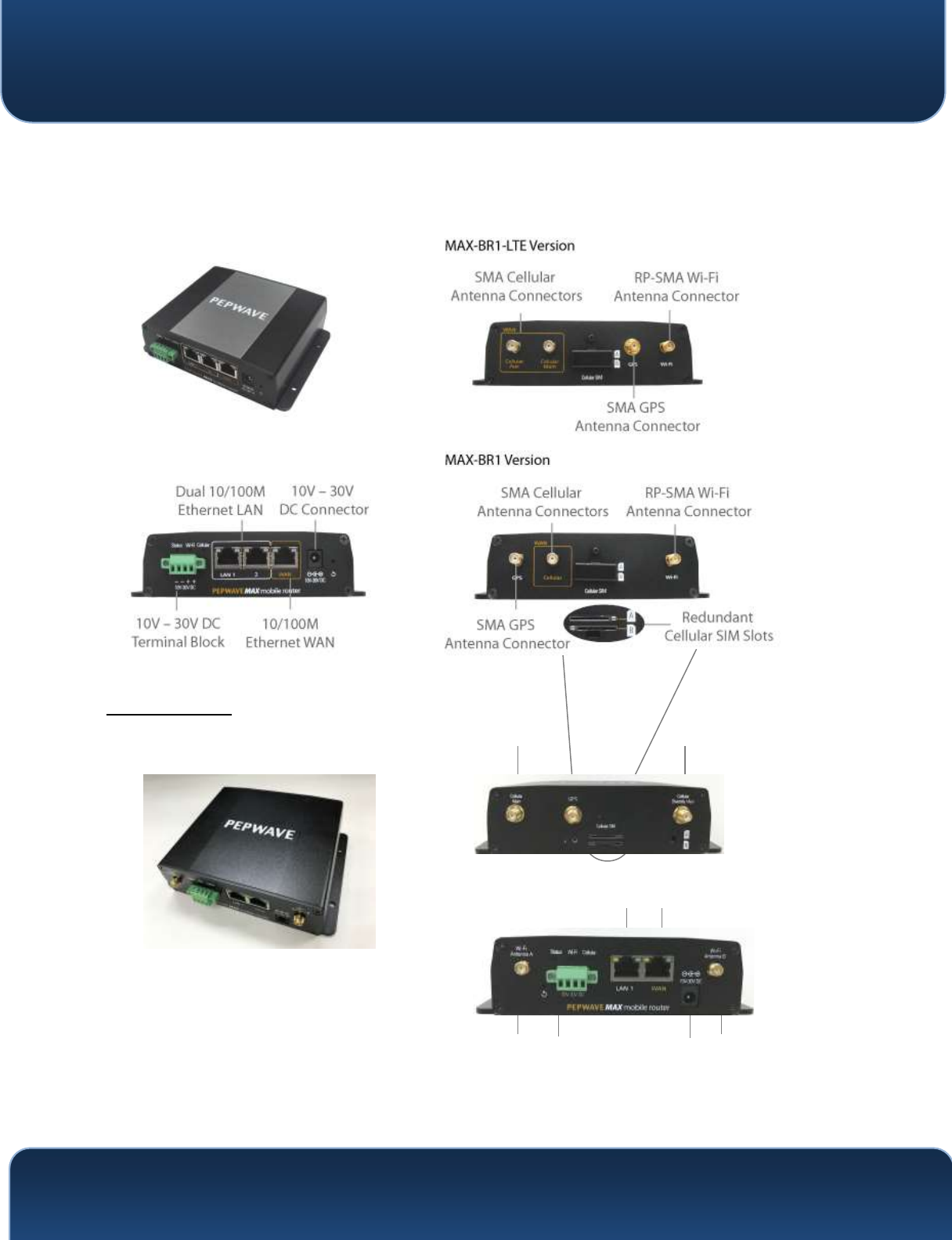
Pepwave MAX and Surf User Manual
http://www.pepwave.com
22
Copyright @ 2018 Pepwave
4.9 MAX BR1 / MAX BR1 MK2
4.9.1 Panel Appearance
MAX BR1 MK2
RP-SMA Wi-Fi
Antenna Connector
SMA Cellular
Antenna Connector
SMA Cellular
Antenna Connector
RP-SMA Wi-Fi
Antenna Connector
10-30V DC
Terminal Block
10-30V DC
Connector
100/1000M
Ethernet LAN
Terminal Block
100/1000M
Ethernet WAN
Terminal Block

Pepwave MAX and Surf User Manual
http://www.pepwave.com
23
Copyright @ 2018 Pepwave
4.9.2 LED Indicators
The statuses indicated by the front panel LEDs are as follows:
Status Indicators
Status
OFF
System initializing
Red
Booting up or busy
Blinking
red
Boot up error
Green
Ready
Wi-Fi Indicators
Wi-Fi
OFF
Disabled intermittent
Blinking slowly
Connecting to wireless network(s)
Blinking
Connected to wireless network(s) with traffic
ON
Connected to wireless network(s) without
traffic
Cellular Indicators
Cellular
OFF
Disabled or no SIM card inserted
ON
Connecting or connected to network(s)
LAN and Ethernet WAN Ports
Green LED
ON
100 Mbps / 1000Mbps (MK2)
OFF
10 Mbps / 100Mbps (MK2)
Orange LED
ON
Port is connected without traffic
Blinking
Data is transferring
OFF
Port is not connected
Port Type
Auto MDI/MDI-X ports
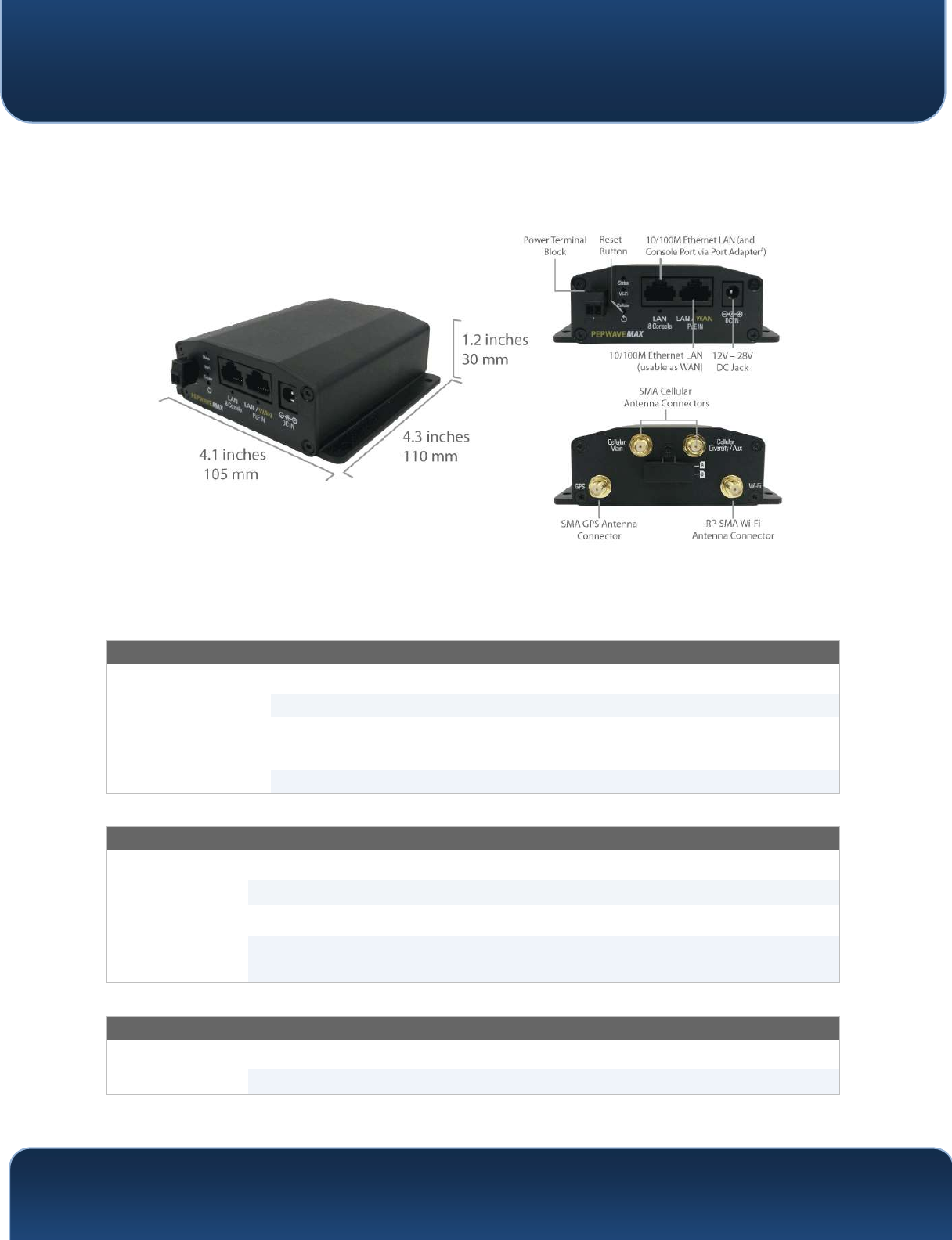
Pepwave MAX and Surf User Manual
http://www.pepwave.com
24
Copyright @ 2018 Pepwave
4.10 MAX BR1 Mini
4.10.1 Panel Appearance
4.10.2 LED Indicators
The statuses indicated by the front panel LEDs are as follows:
Status Indicators
Status
OFF
System initializing
Red
Booting up or busy
Blinking
red
Boot up error
Green
Ready
Wi-Fi Indicators
Wi-Fi
OFF
Disabled intermittent
Blinking slowly
Connecting to wireless network(s)
Blinking
Connected to wireless network(s) with traffic
ON
Connected to wireless network(s) without
traffic
Cellular Indicators
Cellular
OFF
Disabled or no SIM card inserted
ON
Connecting or connected to network(s)
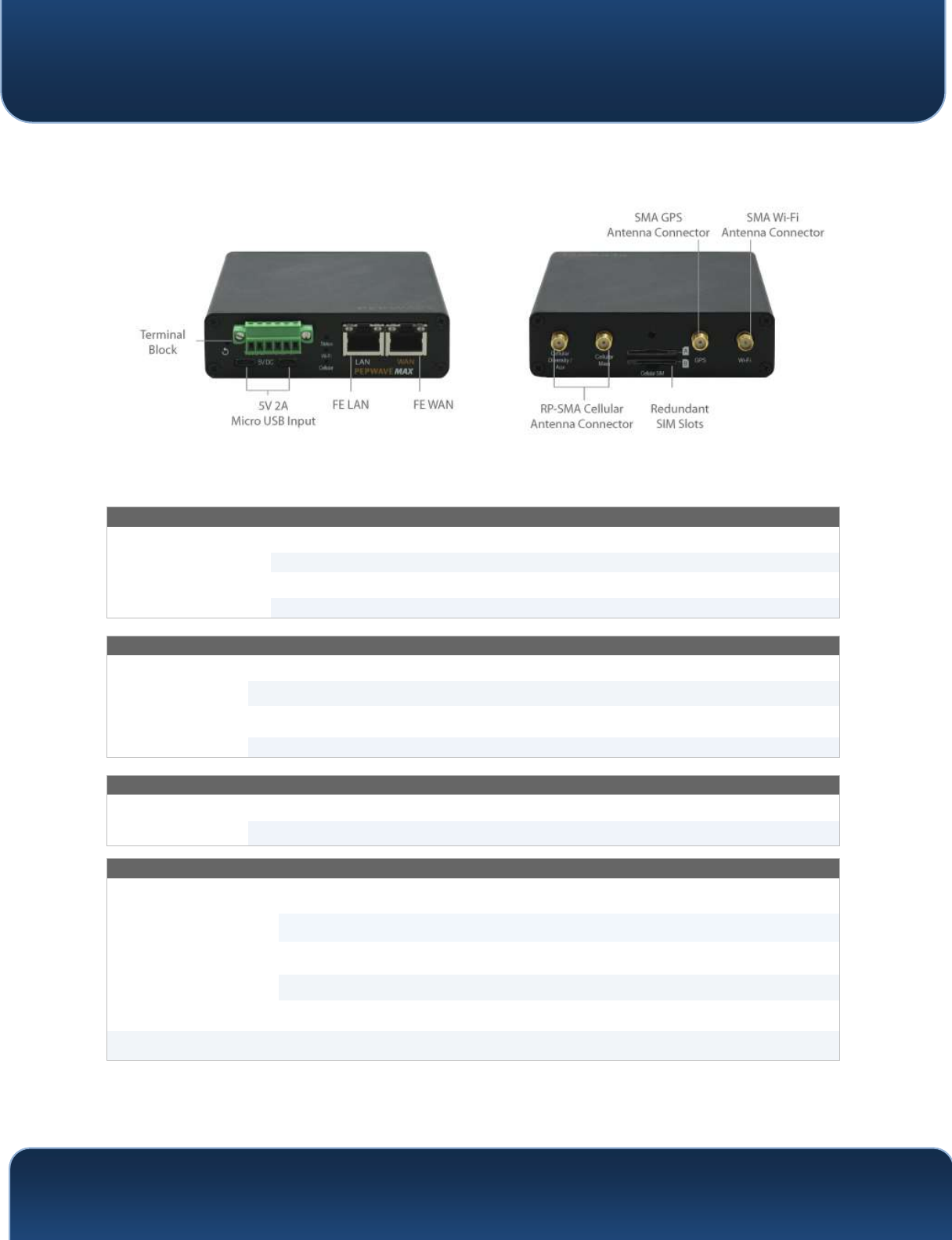
Pepwave MAX and Surf User Manual
http://www.pepwave.com
26
Copyright @ 2018 Pepwave
4.11 MAX BR1 Slim
4.11.1 Panel Appearance
4.11.2 LED Indicators The statuses indicated by the front panel LEDs are as follows:
Status Indicators
Status
OFF
System initializing
Red
Booting up or busy
Blinking red
Boot up error
Green
Ready
Wi-Fi Indicators
Wi-Fi
OFF
Disabled intermittent
Blinking slowly
Connecting to wireless network(s)
Blinking
Connected to wireless network(s) with traffic
ON
Connected to wireless network(s) without traffic
Cellular Indicators
Cellular
OFF
Disabled or no SIM card inserted
ON
Connecting or connected to network(s)
LAN and Ethernet WAN Ports
Green LED
ON
100 Mbps
OFF
10 Mbps
Orange LED
ON
Port is connected without traffic
Blinking
Data is transferring
OFF
Port is not connected
Port Type
Auto MDI/MDI-X ports
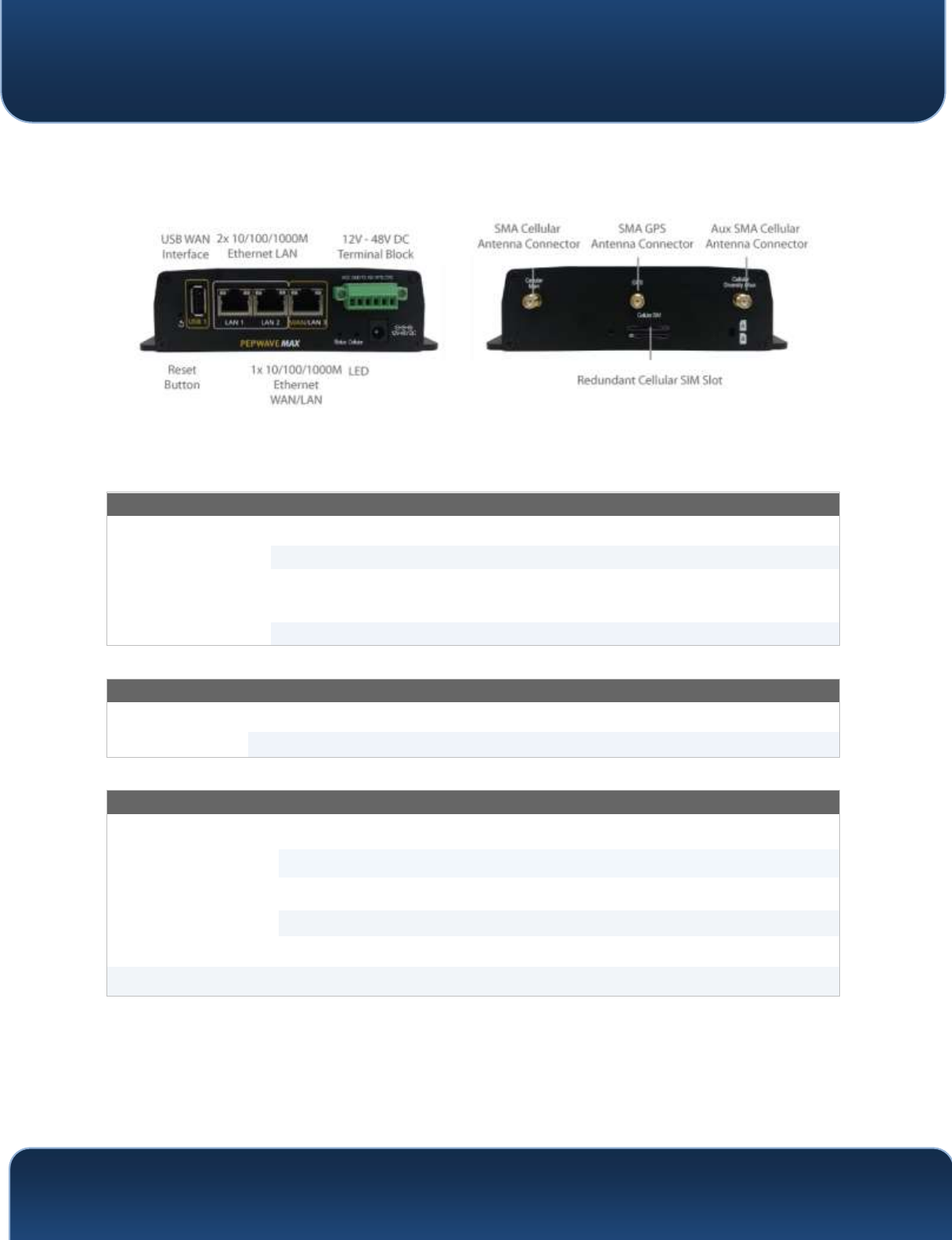
Pepwave MAX and Surf User Manual
http://www.pepwave.com
27
Copyright @ 2018 Pepwave
4.12 MAX BR1 ENT
4.12.1 Panel Appearance
4.12.2 LED Indicators
The statuses indicated by the front panel LEDs are as follows:
Status Indicators
Status
OFF
System initializing
Red
Booting up or busy
Blinking
red
Boot up error
Green
Ready
Cellular Indicators
Cellular
OFF
Disabled or no SIM card inserted
ON
Connecting or connected to network(s)
LAN and Ethernet WAN Ports
Green LED
ON
100 Mbps
OFF
10 Mbps
Orange LED
ON
Port is connected without traffic
Blinking
Data is transferring
OFF
Port is not connected
Port Type
Auto MDI/MDI-X ports
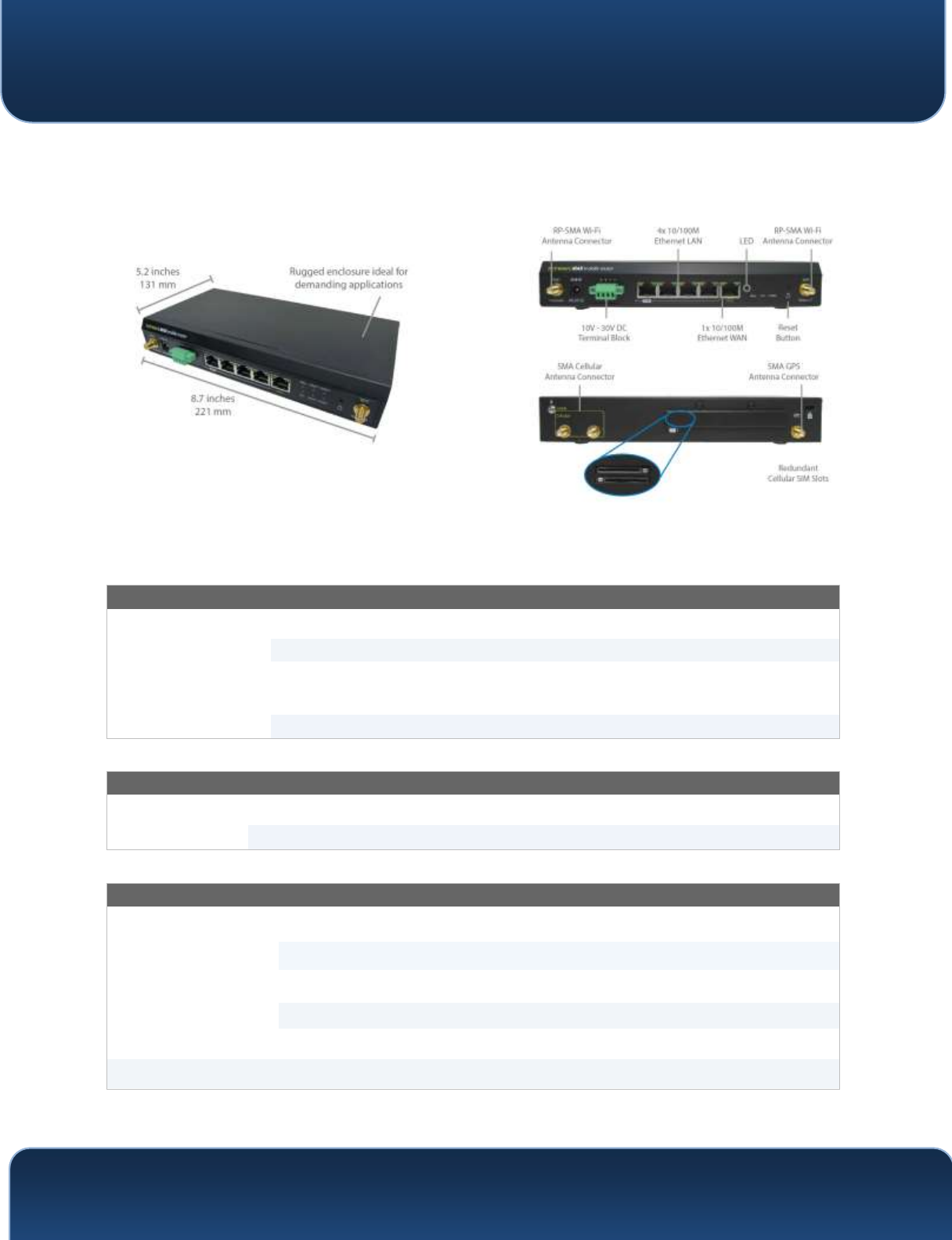
Pepwave MAX and Surf User Manual
http://www.pepwave.com
28
Copyright @ 2018 Pepwave
4.13 MAX BR1 Pro LTE
4.13.1 Panel Appearance
4.13.2 LED Indicators
The statuses indicated by the front panel LEDs are as follows:
Status Indicators
Status
OFF
System initializing
Red
Booting up or busy
Blinking
red
Boot up error
Green
Ready
Cellular Indicators
Cellular
OFF
Disabled or no SIM card inserted
ON
Connecting or connected to network(s)
LAN and Ethernet WAN Ports
Green LED
ON
100 Mbps
OFF
10 Mbps
Orange LED
ON
Port is connected without traffic
Blinking
Data is transferring
OFF
Port is not connected
Port Type
Auto MDI/MDI-X ports
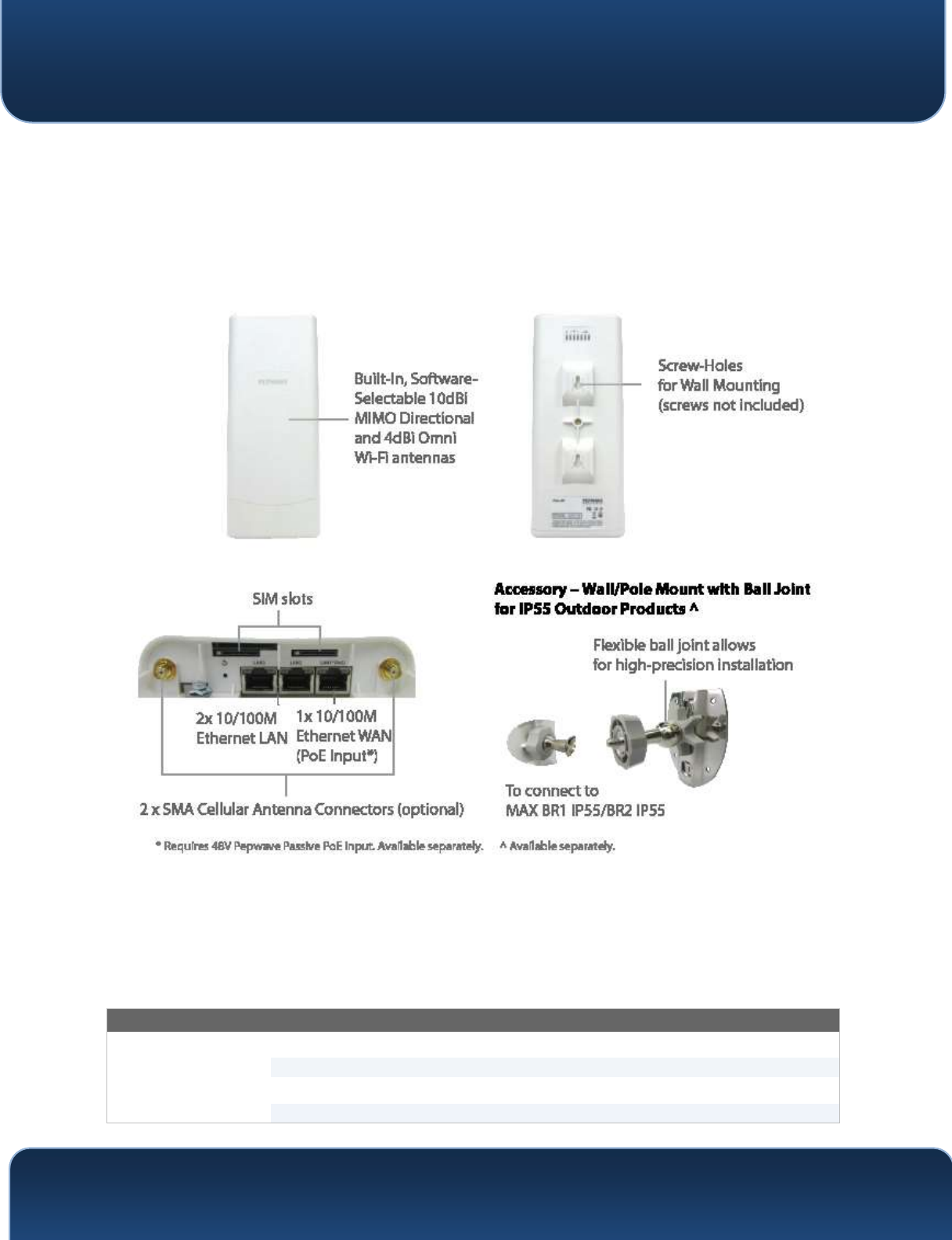
Pepwave MAX and Surf User Manual
http://www.pepwave.com
29
Copyright @ 2018 Pepwave
4.14 MAX BR1/2 IP55
4.14.1 Panel Appearance
4.14.2 LED Indicators
The statuses indicated by the front panel LEDs are as follows:
Status Indicators
Status
OFF
System initializing
Red
Booting up or busy
Blinking red
Boot up error
Green
Ready
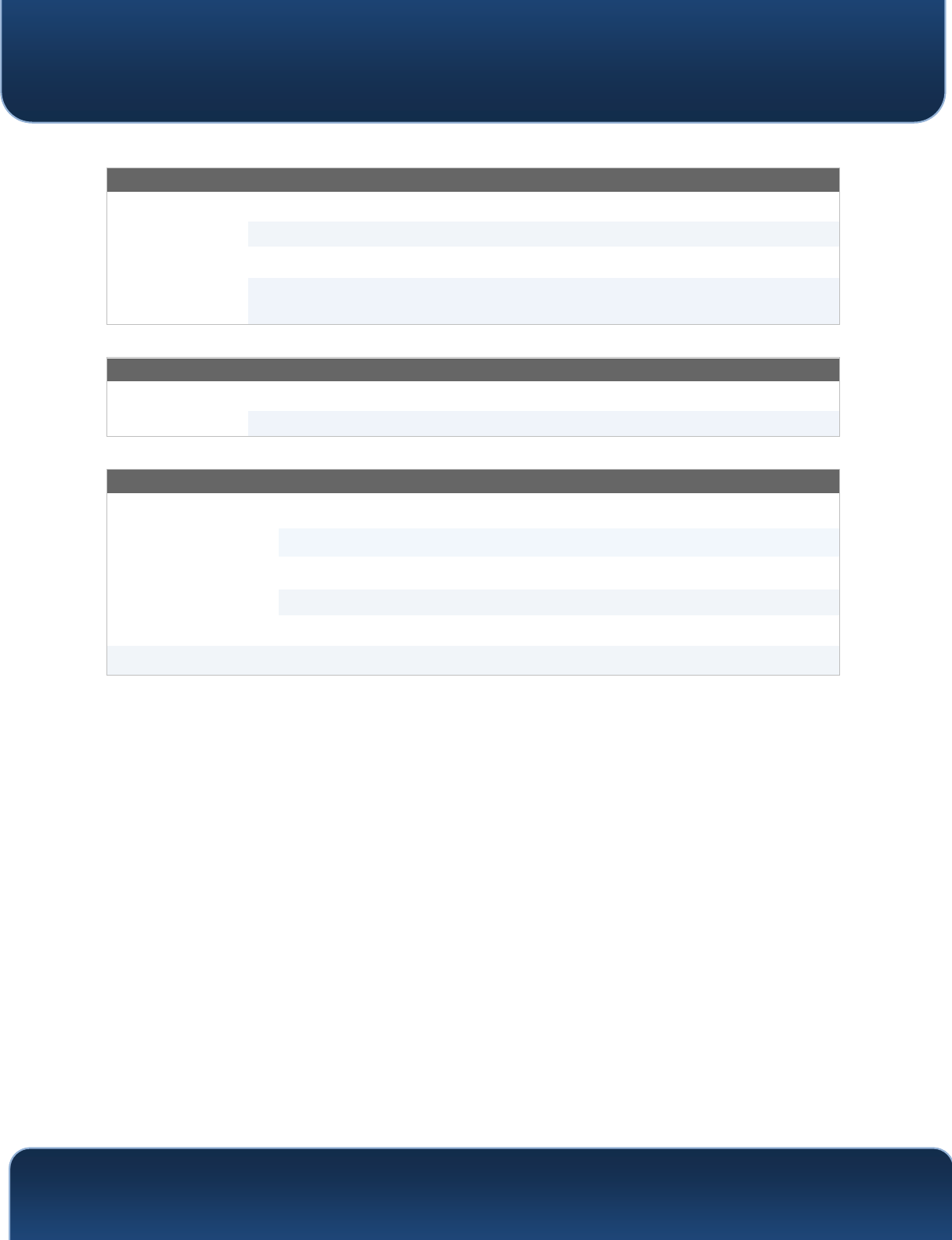
Pepwave MAX and Surf User Manual
http://www.pepwave.com
30
Copyright @ 2018 Pepwave
Wi-Fi Indicators
Wi-Fi
OFF
Disabled Intermittent
Blinking slowly
Connecting to wireless network(s)
Blinking
Connected to wireless network(s) with traffic
ON
Connected to wireless network(s) without
traffic
Cellular Indicators
Cellular
OFF
Disabled or no SIM card inserted
ON
Connecting or connected to network(s)
LAN and Ethernet WAN Ports
Green LED
ON
100 Mbps
OFF
10 Mbps
Orange LED
ON
Port is connected without traffic
Blinking
Data is transferring
OFF
Port is not connected
Port Type
Auto MDI/MDI-X ports
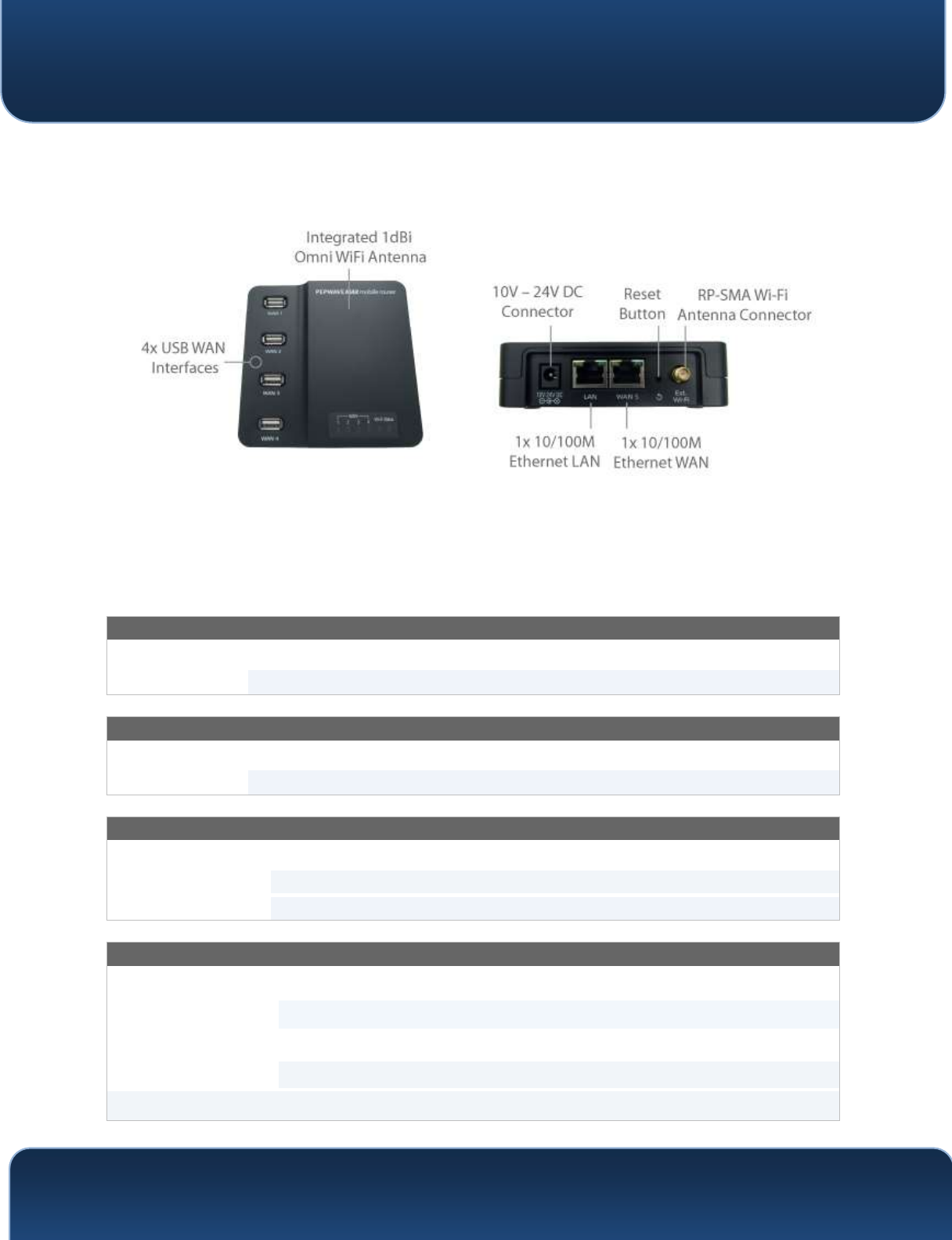
Pepwave MAX and Surf User Manual
http://www.pepwave.com
31
Copyright @ 2018 Pepwave
4.15 MAX On-The-Go
4.15.1 Panel Appearance
4.15.2 LED Indicators
The statuses indicated by the front panel LEDs are as follows:
Cellular Indicators
WAN
OFF
Modem is not attached to the port
Green
Modem is attached to the port
Wi-Fi Indicators
Wi-Fi
OFF
Disconnected from AP
Green
Connected to AP
Status Indicators
Status
OFF
System initializing
Red
Booting up or busy
Green
Ready
LAN and Ethernet WAN Ports
Green LED
ON
100 Mbps
OFF
10 Mbps
Orange LED
ON
Port is connected without traffic
Blinking
Data is transferring
Port Type
Auto MDI/MDI-X ports
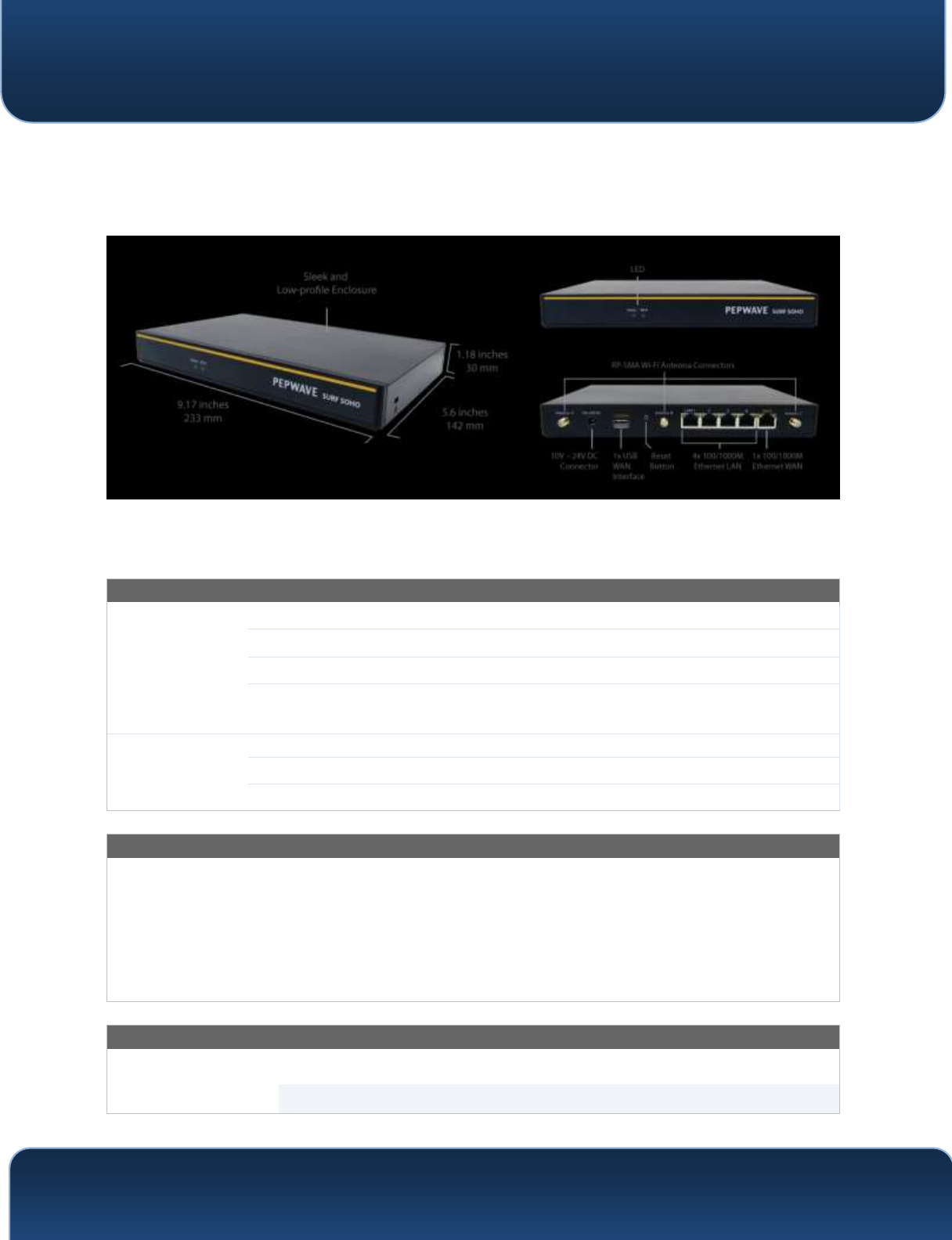
Pepwave MAX and Surf User Manual
http://www.pepwave.com
32
Copyright @ 2018 Pepwave
4.16 Surf SOHO
4.16.1 Panel Appearance
4.16.2 LED Indicators
The statuses indicated by the front panel LEDs are as follows:
Wi-Fi and Status Indicators
Wi-Fi
OFF
Disabled Intermittent
Blinking
Enabled but no client connected
ON
Client(s) connected to wireless network
Continuous
blinking
Transferring data to wireless network
Status
OFF
System initializing
Red
Booting up or busy
Green
Ready state
LAN and Ethernet WAN Ports
Green LED
ON
100/1000 Mbps
Orange LED
Blinking
Data is transferring
OFF
No data is being transferred or port is not
connected
Port type
Auto MDI/MDI-X ports
Wi-Fi Signal
Off
No connection
Signal strength
Wi-Fi signal strength (low, medium, and high)
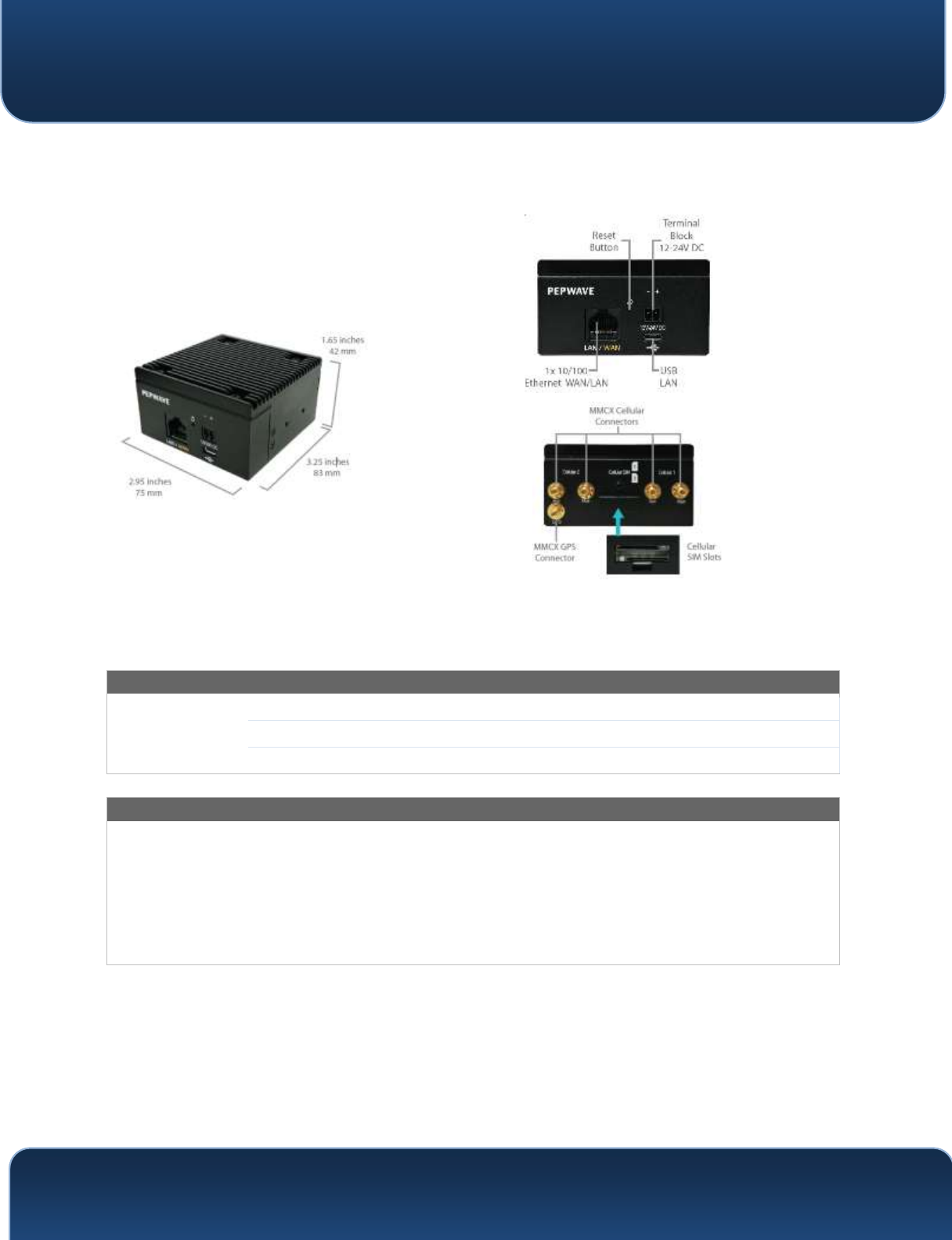
Pepwave MAX and Surf User Manual
http://www.pepwave.com
33
Copyright @ 2018 Pepwave
4.17 SpeedFusion Engine
4.17.1 Panel Appearance
4.17.2 LED Indicators
The statuses indicated by the front panel LEDs are as follows:
Status
OFF
System initializing
Red
Booting up or busy
Green
Ready state
LAN and Ethernet WAN Ports
Green LED
ON
100/1000 Mbps
Orange LED
Blinking
Data is transferring
OFF
No data is being transferred or port is not
connected
Port type
Auto MDI/MDI-X ports
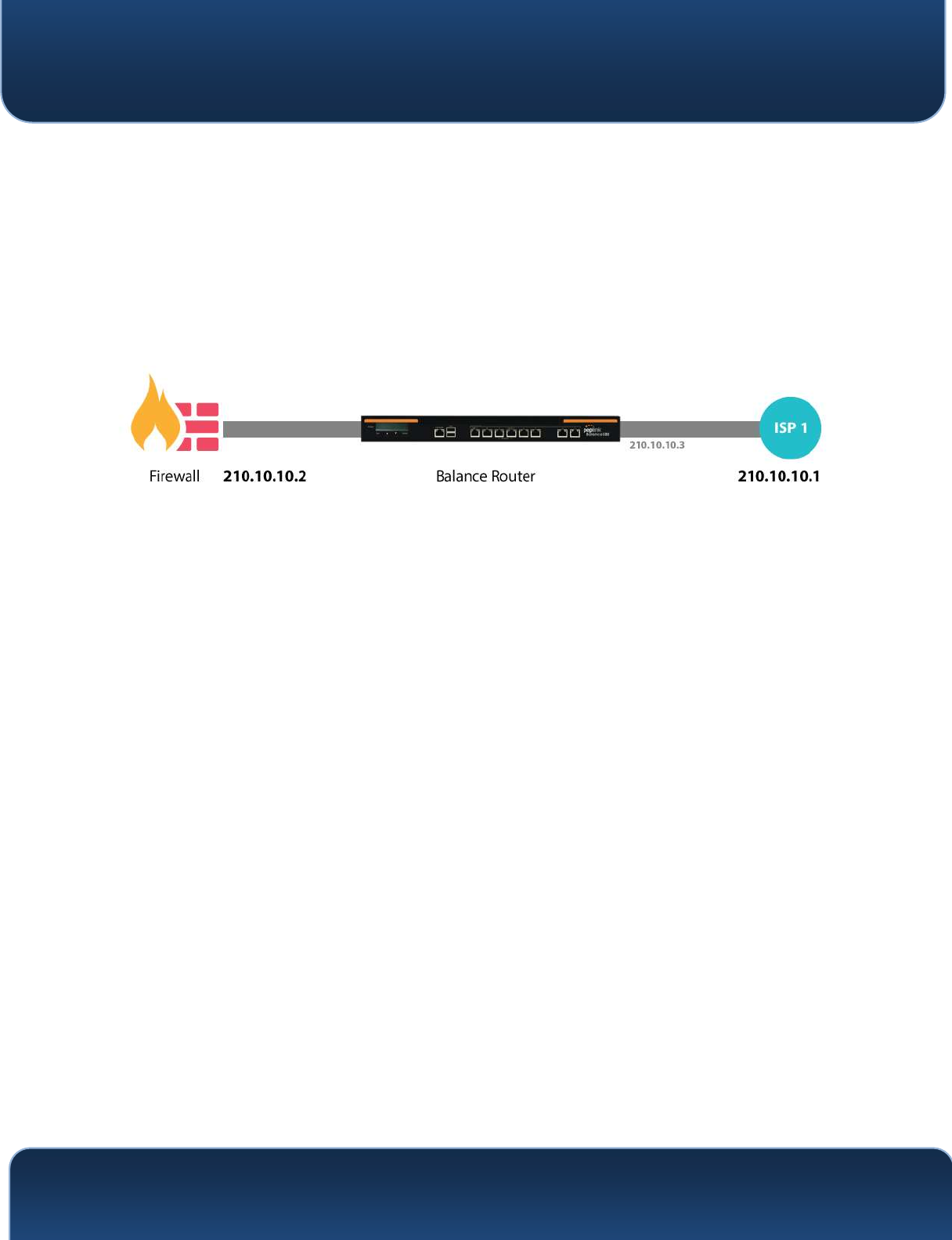
Pepwave MAX and Surf User Manual
http://www.pepwave.com
35
Copyright @ 2018 Pepwave
5 Advanced Feature Summary
5.1 Drop-in Mode and LAN Bypass:
Transparent Deployment
As your organization grows, it needs more bandwidth. But modifying your network would
require effort better spent elsewhere. In Drop-in Mode, you can conveniently install your
Peplink router without making any changes to your network. And if the Peplink router loses
power for any reason, LAN Bypass will safely and automatically bypass the Peplink router to
resume your original network connection.
Compatible with: MAX 700, MAX HD2 (All variants), HD4 (All Variants)
5.2 QoS: Clearer VoIP
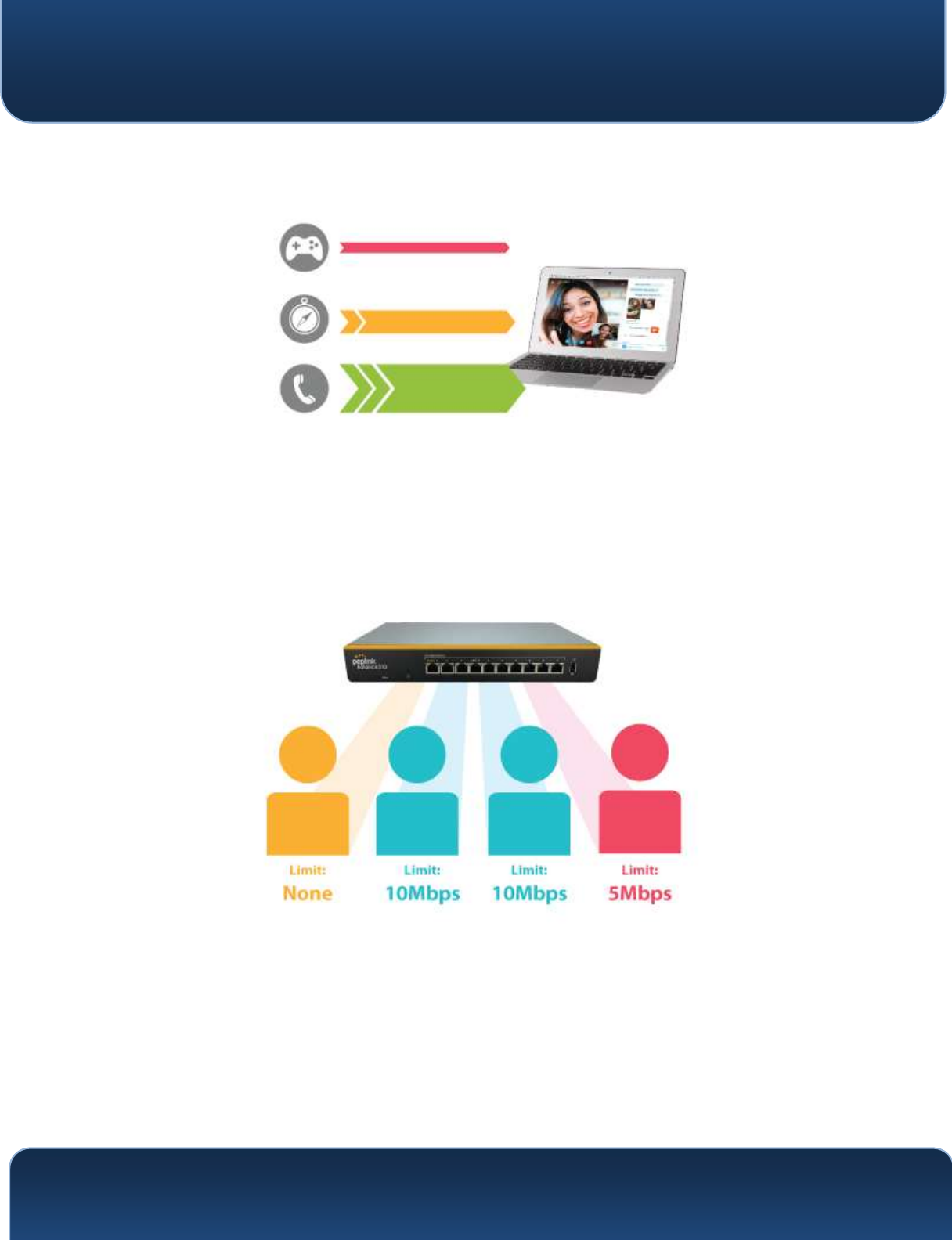
Pepwave MAX and Surf User Manual
http://www.pepwave.com
36
Copyright @ 2018 Pepwave
VoIP and videoconferencing are highly sensitive to latency. With QoS, Peplink routers can
detect VoIP traffic and assign it the highest priority, giving you crystal-clear calls.
5.3 Per-User Bandwidth Control
With per-user bandwidth control, you can define bandwidth control policies for up to 3
groups of users to prevent network congestion. Define groups by IP address and subnet,
and set bandwidth limits for every user in the group.
5.4 High Availability via VRRP
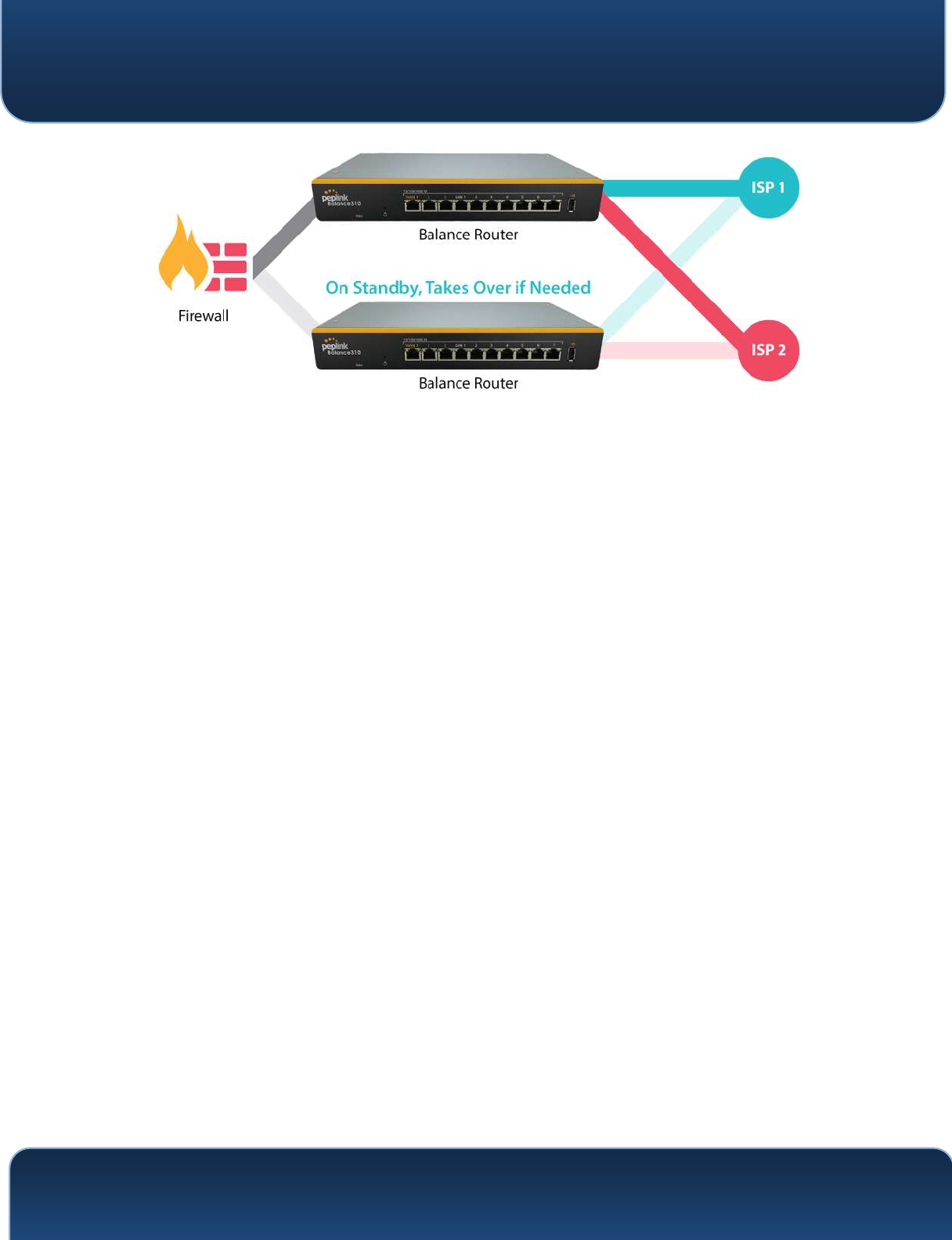
Pepwave MAX and Surf User Manual
http://www.pepwave.com
37
Copyright @ 2018 Pepwave
When your organization has a corporate requirement demanding the highest availability
with no single point of failure, you can deploy two Peplink routers in High Availability mode.
With High Availability mode, the second device will take over when needed.
Compatible with: MAX 700, MAX HD2 (All variants), HD4 (All Variants)
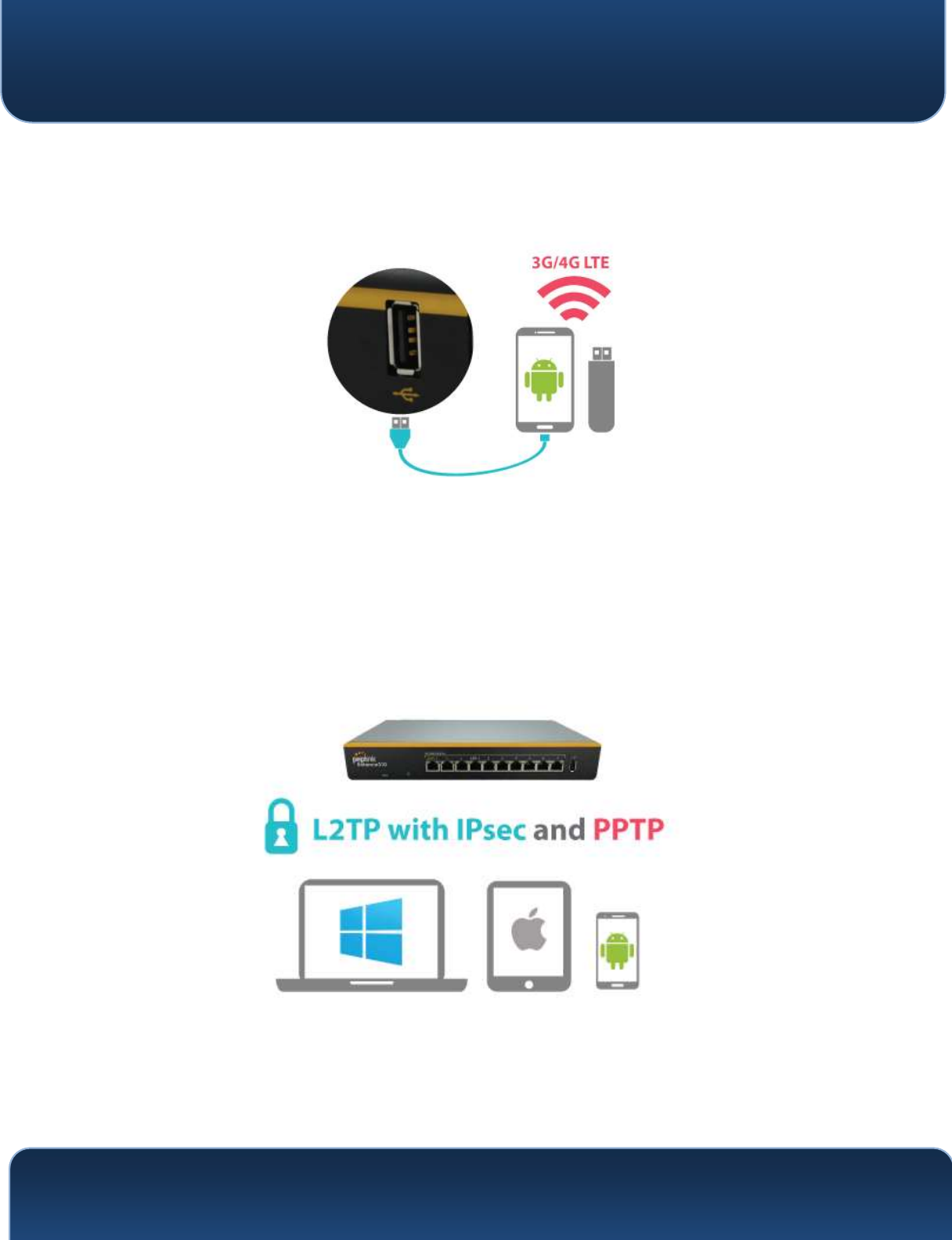
Pepwave MAX and Surf User Manual
http://www.pepwave.com
38
Copyright @ 2018 Pepwave
5.5 USB Modem and Android Tethering
For increased WAN diversity, plug in a USB LTE modem as backup. Peplink routers are
compatible with over 200 modem types. You can also tether to smartphones running
Android 4.1.X and above.
Compatible with: MAX 700, HD2 (all variants except IP67), HD4 (All variants)
5.6 Built-In Remote User VPN Support
Use L2TP with IPsec to safely and conveniently connect remote clients to your private
network. L2TP with IPsec is supported by most devices, but legacy devices can also connect
using PPTP.
Click here for full instructions on setting up L2TP with IPsec.

Pepwave MAX and Surf User Manual
http://www.pepwave.com
40
Copyright @ 2018 Pepwave
6 Installation
The following section details connecting Pepwave routers to your network.
6.1 Preparation
Before installing your Pepwave router, please prepare the following as
appropriate for your installation:
At least one Internet/WAN access account and/or Wi-Fi access
information
Depending on network connection type(s), one or more of the following:
Ethernet WAN: A 10/100/1000BaseT UTP cable with RJ45 connector
USB: A USB modem
Embedded modem: A SIM card for GSM/HSPA service
Wi-Fi WAN: Wi-Fi antennas
PC Card/Express Card WAN: A PC Card/ExpressCard for the
corresponding card slot
A computer installed with the TCP/IP network protocol and a supported
web browser. Supported browsers include Microsoft Internet Explorer 8.0 or
above, Mozilla Firefox 10.0 or above, Apple Safari 5.1 or above, and
Google Chrome 18 or above.
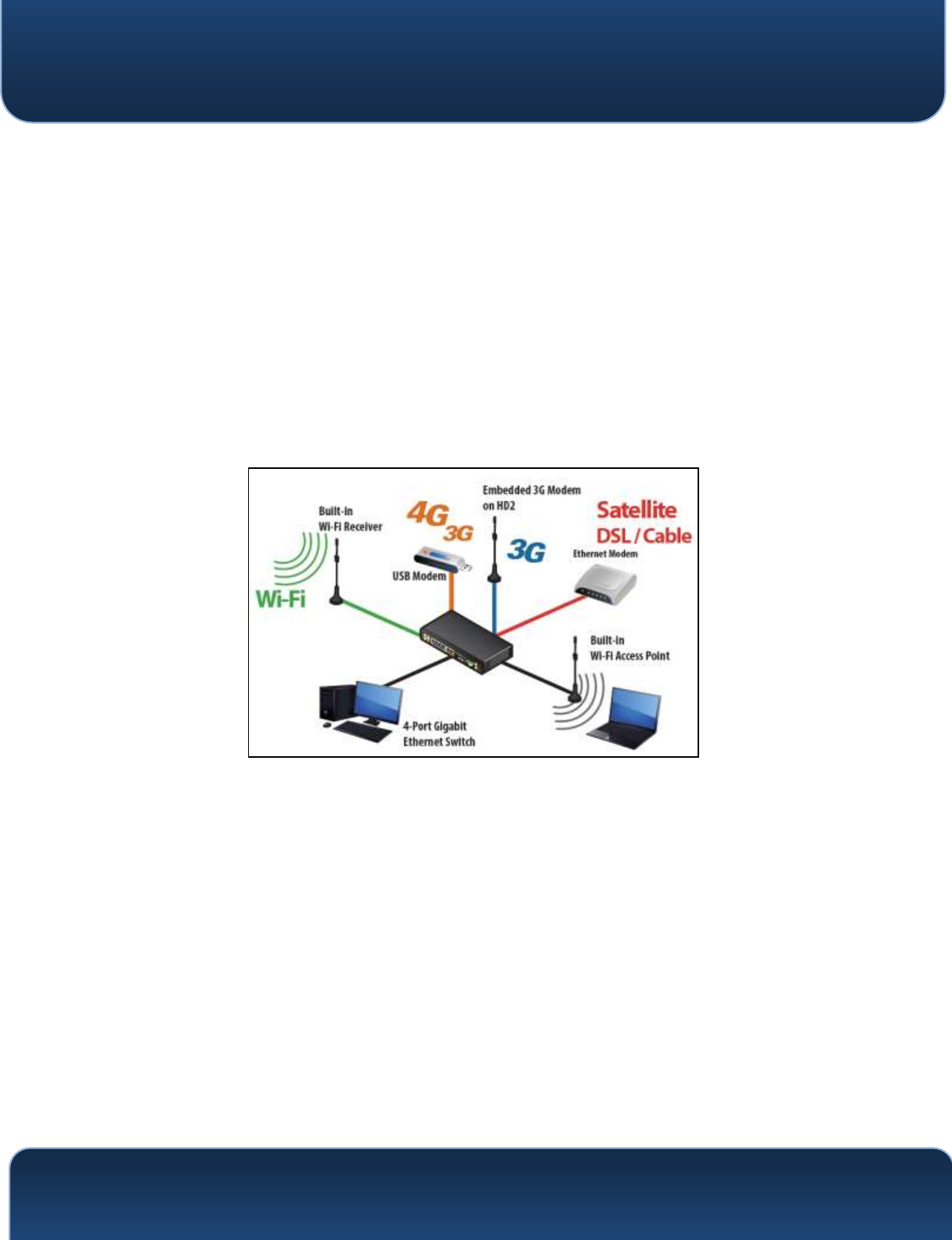
Pepwave MAX and Surf User Manual
http://www.pepwave.com
41
Copyright @ 2018 Pepwave
6.2 Constructing the Network
At a high level, construct the network according to the following steps:
1. With an Ethernet cable, connect a computer to one of the LAN ports
on the Pepwave router. Repeat with different cables for up to 4
computers to be connected.
2. With another Ethernet cable or a USB modem/Wi-Fi antenna/PC
Card/Express Card, connect to one of the WAN ports on the
Pepwave router. Repeat the same procedure for other WAN ports.
3. Connect the power adapter to the power connector on the rear
panel of the Pepwave router, and then plug it into a power outlet.
The following figure schematically illustrates the resulting configuration:

Pepwave MAX and Surf User Manual
http://www.pepwave.com
42
Copyright @ 2018 Pepwave
6.3 Configuring the Network Environment
To ensure that the Pepwave router works properly in the LAN environment and
can access the Internet via WAN connections, please refer to the following
setup procedures:
LAN configuration
For basic configuration, refer to Section 8, Connecting to the Web Admin
Interface.
For advanced configuration, go to Section 9, Configuring the LAN
Interface(s).
WAN configuration
For basic configuration, refer to Section 8, Connecting to the Web Admin
Interface.
For advanced configuration, go to Section 9.2, Captive Portal.
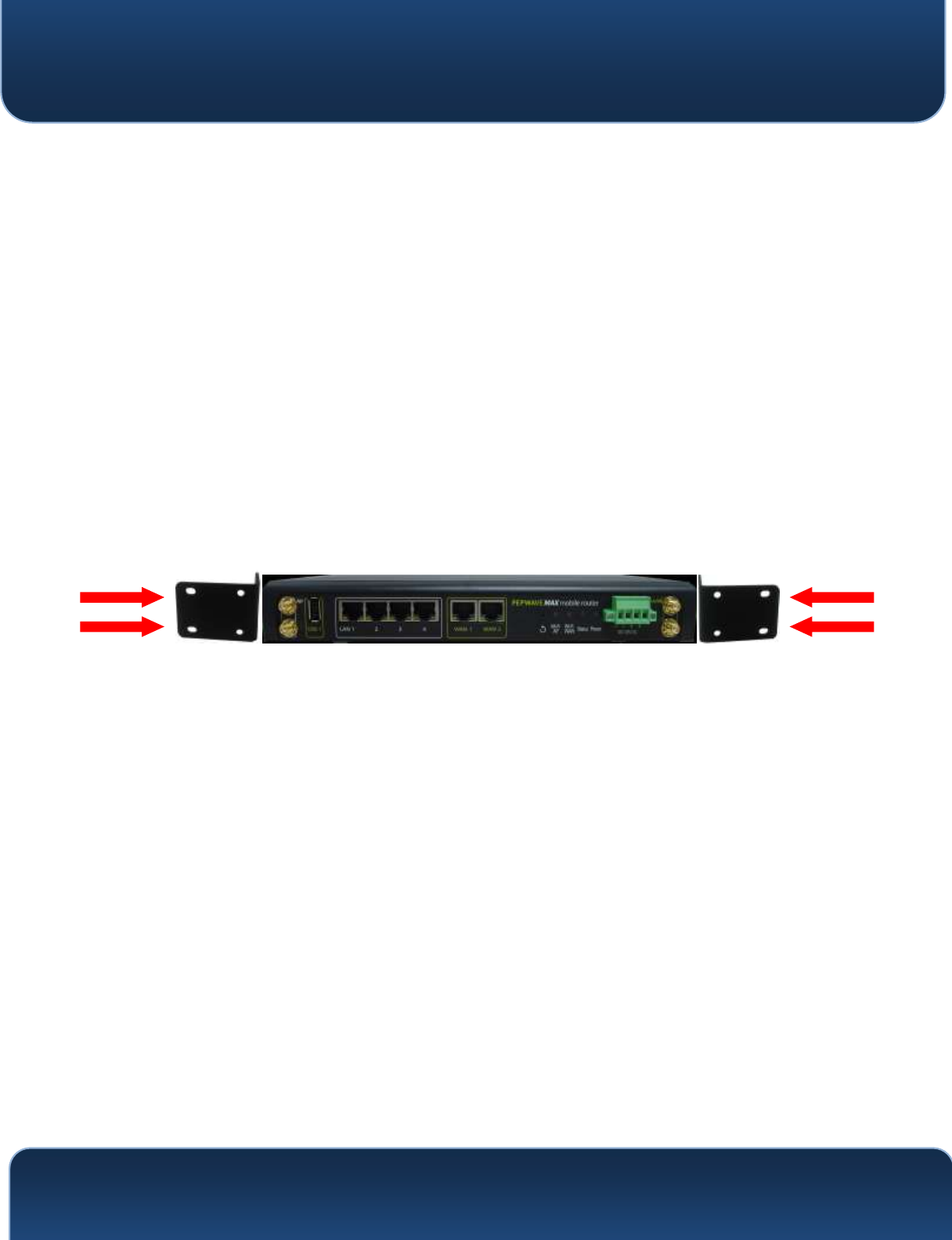
Pepwave MAX and Surf User Manual
http://www.pepwave.com
43
Copyright @ 2018 Pepwave
7 Mounting the Unit
7.1 Wall Mount
The Pepwave MAX 700/HD2/On-The-Go can be wall mounted using screws.
After adding the screw on the wall, slide the MAX in the screw hole socket as
indicated below. Recommeneded screw specification: M3.5 x 20mm, head
diameter 6mm, head thickness 2.4mm.
The Pepwave MAX BR1 requires four screws for wall mounting.
7.2 Car Mount
The Pepwave MAX700/HD2 can be mounted in a vehicle using the included
mounting brackets. Place the mounting brackets by the two sides and screw
them onto the device.
7.3 IP67 Installation Guide
Installation instructions for IP67 devices can be found here:
http://download.peplink.com/manual/IP67_Installation_Guide.pdf
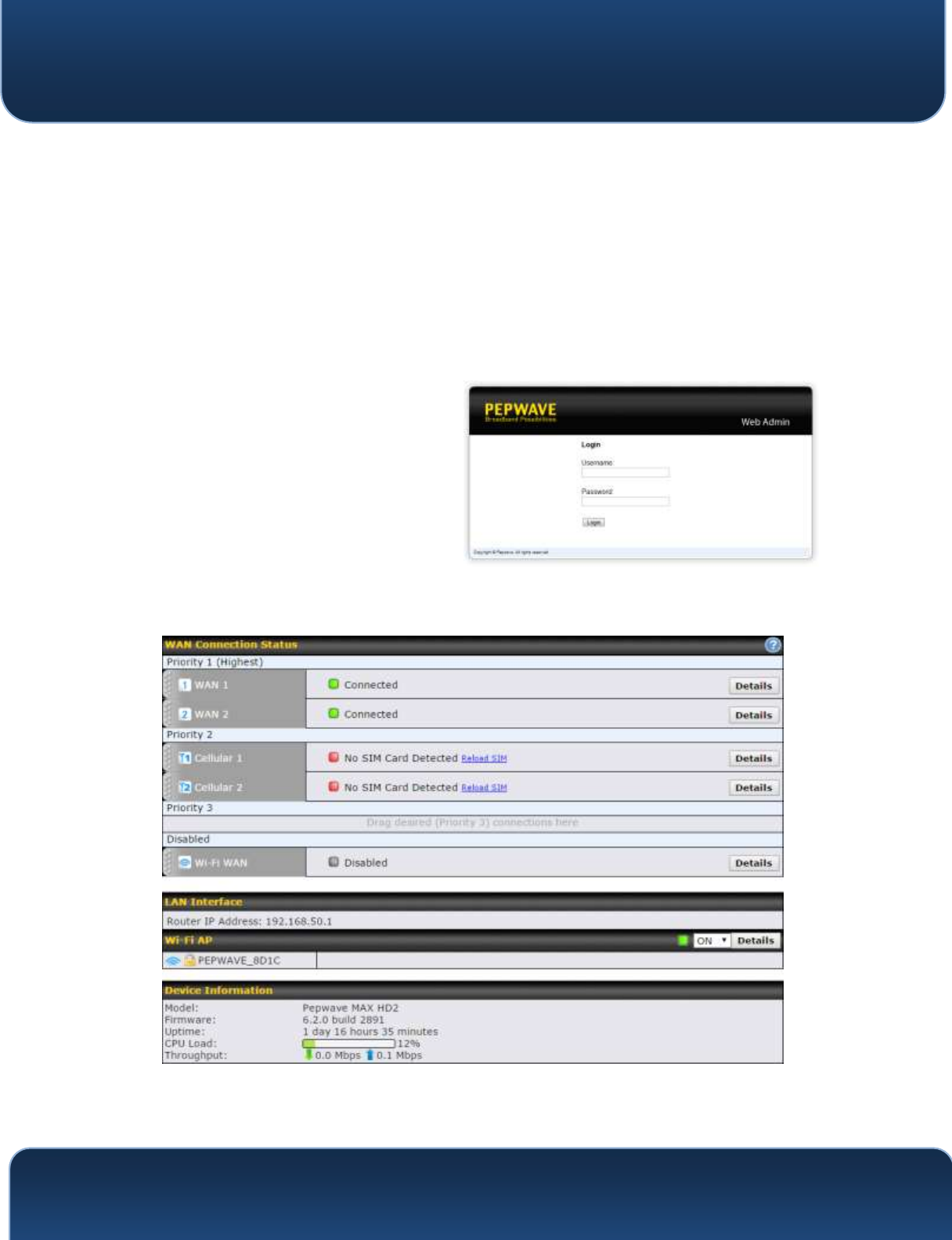
Pepwave MAX and Surf User Manual
http://www.pepwave.com
44
Copyright @ 2018 Pepwave
8 Connecting to the Web Admin Interface
1. Start a web browser on a computer that is connected with the Pepwave
router through the LAN.
2. To connect to the router’s web admin interface, enter the following LAN IP
address in the address field of the web browser:
http://192.168.50.1
(This is the default LAN IP address for Pepwave routers.)
3. Enter the following to access the
web admin interface.
Username: admin
Password: admin
(This is the default username and
password for Pepwave routers. The
admin and read-only user passwords
can be changed at System>Admin
Security.)
4. After successful login, the Dashboard will be displayed.
The Dashboard shows current WAN, LAN, and Wi-Fi AP statuses. Here, you can
change WAN connection priority and switch on/off the Wi-Fi AP. For further
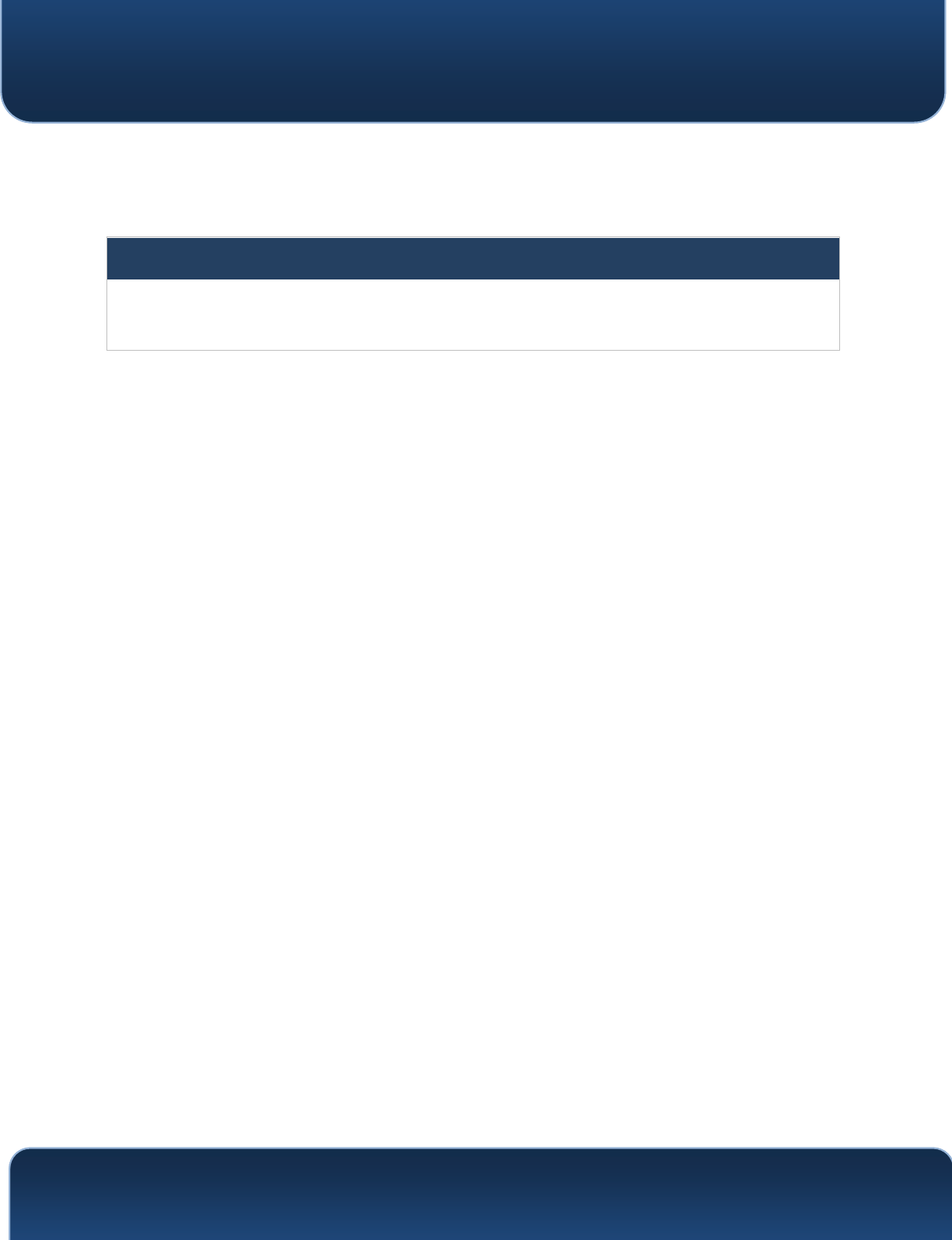
Pepwave MAX and Surf User Manual
http://www.pepwave.com
45
Copyright @ 2018 Pepwave
information on setting up these connections, please refer to Sections 8 and 9.
Device Information displays details about the device, including model name,
firmware version, and uptime. For further information, please refer to Section 22.
Important Note
Configuration changes (e.g. WAN, LAN, admin settings, etc.) will take effect only after clicking the Save
button at the bottom of each page. The Apply Changes button causes the changes to be saved and
applied.
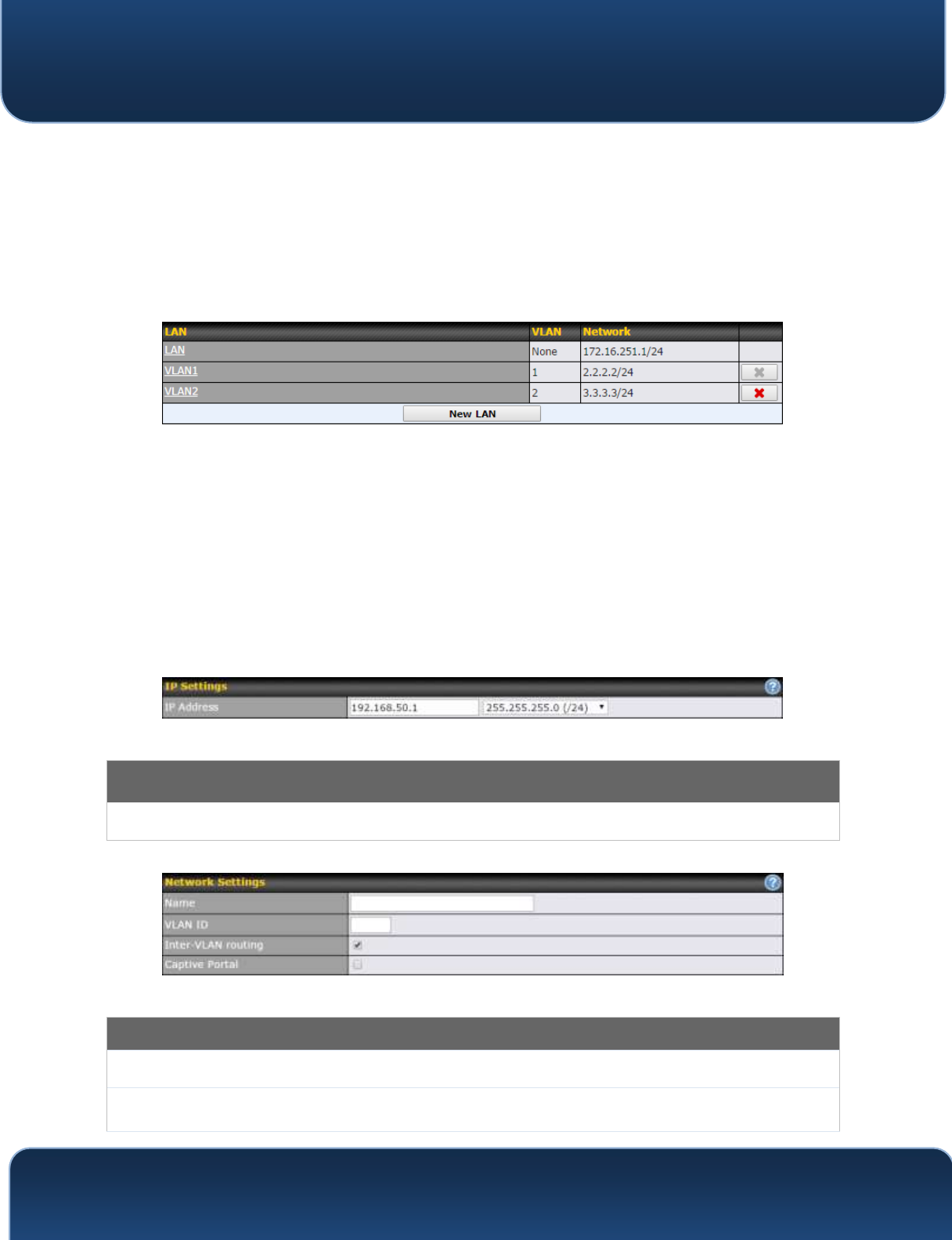
Pepwave MAX and Surf User Manual
http://www.pepwave.com
46
Copyright @ 2018 Pepwave
9 Configuring the LAN Interface(s)
9.1 Basic Settings
LAN interface settings are located at Network>LAN>Basic Settings. Navigating to
that page will result in the following dashboard:
This represents the LAN interfaces that are active on your router (including
VLAN). A grey “X” means that the VLAN is used in other settings and cannot be
deleted. You can find which settings are using the VLAN by hovering over the
grey “X”.
Alternatively, a red “X” means that there are no settings using the VLAN. You
can delete that VLAN by clicking the red “X”
Clicking any of the existing LAN interfaces (or creating a new one) will result in
the following
IP Settings
IP Address
The IP address and subnet mask of the Pepwave router on the LAN.
Network Settings
Name
Enter a name for the LAN.
VLAN ID
Enter a number for your VLAN.
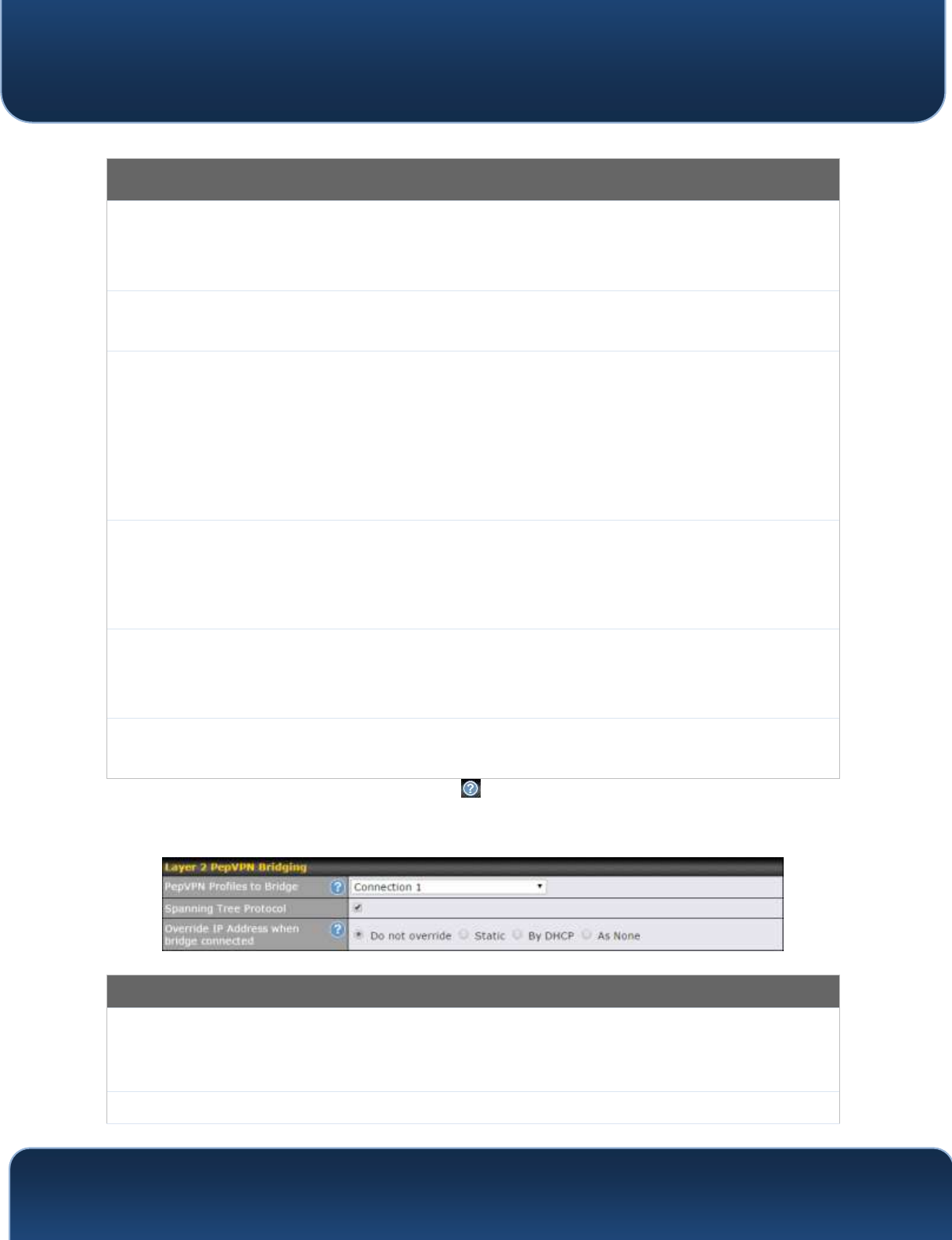
Pepwave MAX and Surf User Manual
http://www.pepwave.com
48
Copyright @ 2018 Pepwave
Drop-in Mode Settings
Enable
Drop-in mode eases the installation of Peplink routers on a live network between the
existing firewall and router, such that no configuration changes are required on
existing equipment. Check the box to enable the drop-in mode feature, if available
on your model.
WAN for Drop-
In Mode
Select the WAN port to be used for drop-in mode. If WAN 1 with LAN Bypass is
selected, the high availability feature will be disabled automatically.
Share Drop-In
IPA
When this option is enabled, the passthrough IP address will be used to connect to
WAN hosts (email notification, remote syslog, etc.). The Pepwave router will listen for
this IP address when WAN hosts access services provided by the Pepwave router
(web admin access from the WAN, DNS server requests, etc.).
To connect to hosts on the LAN (email notification, remote syslog, etc.), the default
gateway address will be used. The Pepwave router will listen for this IP address when
LAN hosts access services provided by the Pepwave router (web admin access
from the WAN, DNS proxy, etc.).
Shared IP
AddressA
Access to this IP address will be passed through to the LAN port if this device is not
serving the service being accessed. The shared IP address will be used in
connecting to hosts on the WAN (email notification, remote syslog, etc.) The device
will also listen on the IP address when hosts on the WAN access services served on
this device (web admin access from the WAN, DNS server, etc.)
WAN Default
Gateway
Enter the WAN router's IP address in this field. If there are more hosts in addition to
the router on the WAN segment, check the I have other host(s) on WAN
segment box and enter the IP address of the hosts that need to access LAN devices
or be accessed by others.
WAN DNS
Servers
Enter the selected WAN's corresponding DNS server IP addresses.
A - Advanced feature, please click the button on the top right-hand corner to
activate.
Layer 2 PepVPN Bridging
PepVPN
Profiles to
Bridge
The remote network of the selected PepVPN profiles will be bridged with this local
LAN, creating a Layer 2 PepVPN, they will be connected and operate like a single
LAN, and any broadcast or multicast packets will be sent over the VPN.
Spanning Tree
Click the box will enable STP for this layer 2 profile bridge.
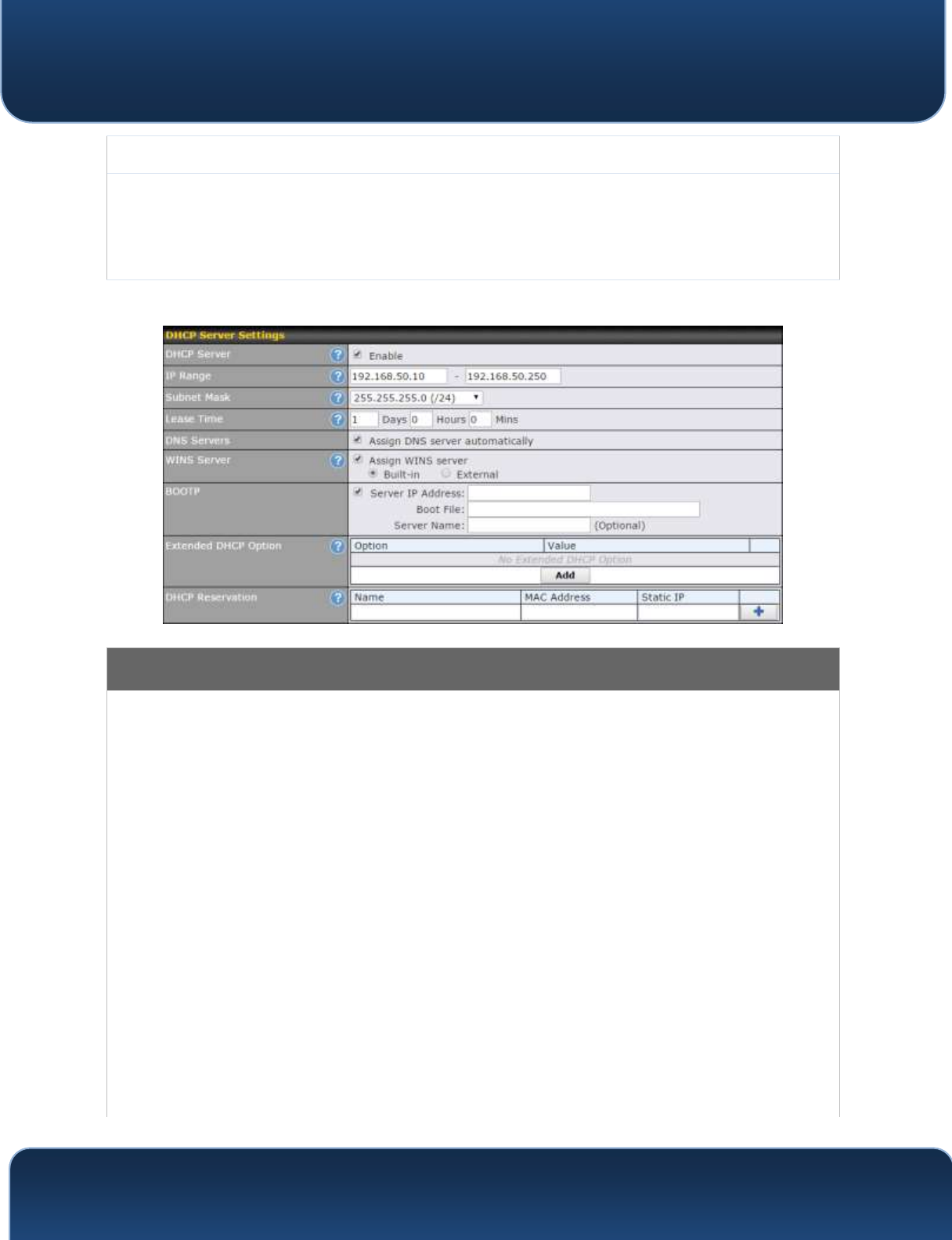
Pepwave MAX and Surf User Manual
http://www.pepwave.com
49
Copyright @ 2018 Pepwave
Protocol
Override IP
Address when
bridge
connected
Select "Do not override" if the LAN IP address and local DHCP server should remain
unchanged after the Layer 2 PepVPN is up.
If you choose to override IP address when the VPN is connected, the device will not
act as a router, and most Layer 3 routing functions will cease to work.
DHCP Server Settings
DHCP Server
When this setting is enabled, the DHCP server automatically assigns an IP address
to each computer that is connected via LAN and configured to obtain an IP
address via DHCP. The Pepwave router’s DHCP server can prevent IP address
collision on the LAN.
IP Range &
Subnet Mask
These settings allocate a range of IP addresses that will be assigned to LAN
computers by the Pepwave router’s DHCP server.
Lease Time
This setting specifies the length of time throughout which an IP address of a DHCP
client remains valid. Upon expiration of the lease time, the assigned IP address will
no longer be valid and renewal of the IP address assignment will be required.
DNS Servers
This option allows you to input the DNS server addresses to be offered to DHCP
clients. If Assign DNS server automatically is selected, the Pepwave router’s built-in
DNS server address (i.e., LAN IP address) will be offered.
WINS Server
This option allows you to optionally specify a Windows Internet Name Service
(WINS) server. You may choose to use the built-in WINS server or external WINS
servers.
When this unit is connected using SpeedFusionTM, other VPN peers can share this
unit's built-in WINS server by entering this unit's LAN IP address in their DHCP WINS
Server setting. Afterward, all PC clients in the VPN can resolve the NetBIOS names
of other clients in remote peers. If you have enabled this option, a list of WINS
clients will be displayed at Status>WINS Clients.
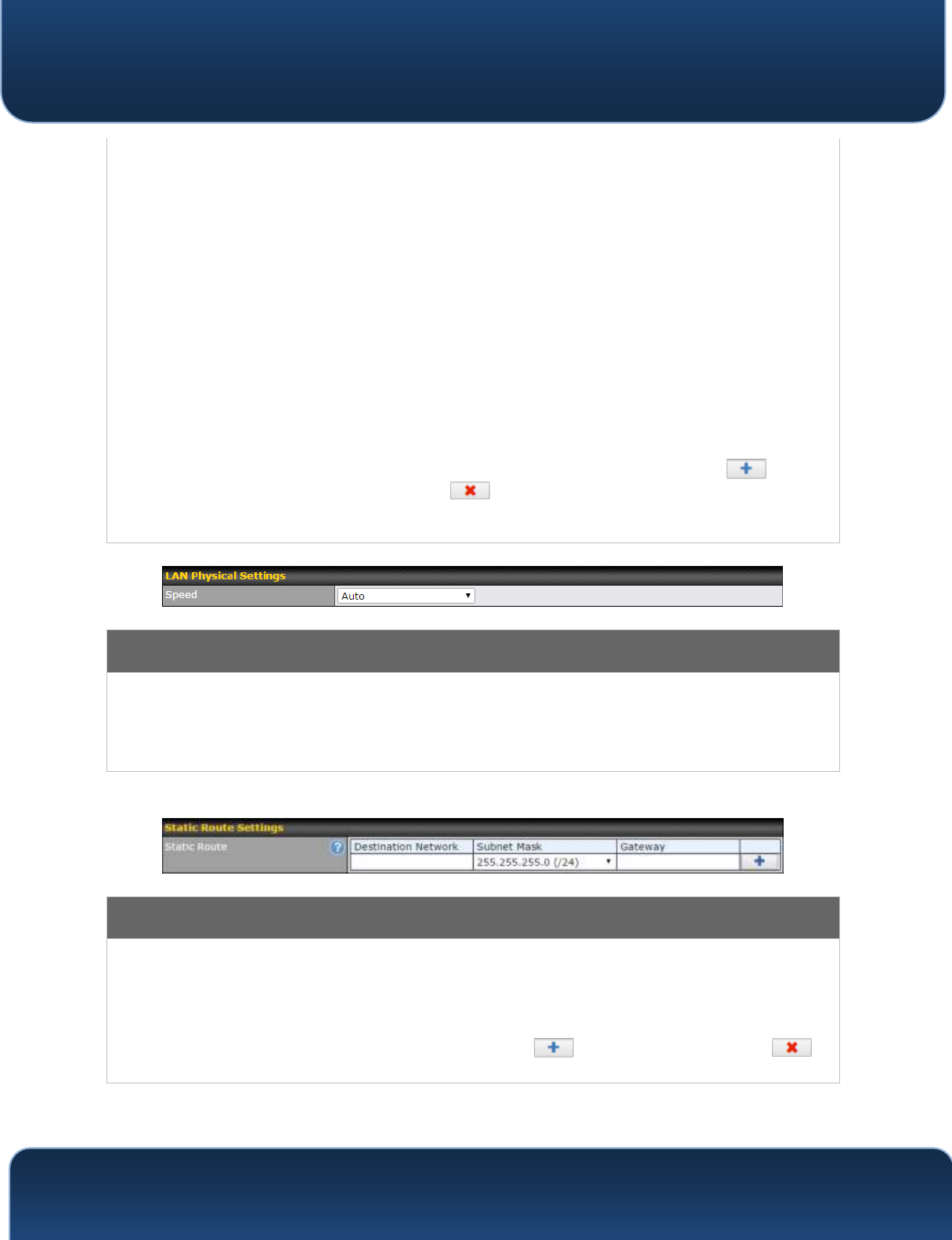
Pepwave MAX and Surf User Manual
http://www.pepwave.com
50
Copyright @ 2018 Pepwave
BOOTP
Check this box to enable BOOTP on older networks that still require it.
Extended
DHCP Option
In addition to standard DHCP options (e.g., DNS server address, gateway address,
subnet mask), you can specify the value of additional extended DHCP options, as
defined in RFC 2132. With these extended options enabled, you can pass
additional configuration information to LAN hosts.
To define an extended DHCP option, click the Add button, choose the option to
define and enter its value. For values that are in IP address list format, you can
enter one IP address per line in the provided text area input control. Each option
can be defined once only.
DHCP
Reservation
This setting reserves the assignment of fixed IP addresses for a list of computers on
the LAN. The computers to be assigned fixed IP addresses on the LAN are identified
by their MAC addresses. The fixed IP address assignment is displayed as a cross-
reference list between the computers’ names, MAC addresses, and fixed IP
addresses.
Name (an optional field) allows you to specify a name to represent the device.
MAC addresses should be in the format of 00:AA:BB:CC:DD:EE. Press to
create a new record. Press to remove a record. Reserved client information
can be imported from the Client List, located at Status>Client List. For more details,
please refer to Section 22.3.
LAN Physical Settings
Speed
This is the port speed of the LAN interface. It should be set to the same speed as
the connected device to avoid port negotiation problems. When a static speed is
set, you may choose whether to advertise its speed to the peer device. Auto is
selected by default. You can choose not to advertise the port speed if the port has
difficulty negotiating with the peer device.
Static Route Settings
Static Route
This table is for defining static routing rules for the LAN segment. A static route
consists of the network address, subnet mask, and gateway address. The address
and subnet mask values are in w.x.y.z format.
The local LAN subnet and subnets behind the LAN will be advertised to the VPN.
Remote routes sent over the VPN will also be accepted. Any VPN member will be
able to route to the local subnets. Press to create a new route. Press to
remove a route.
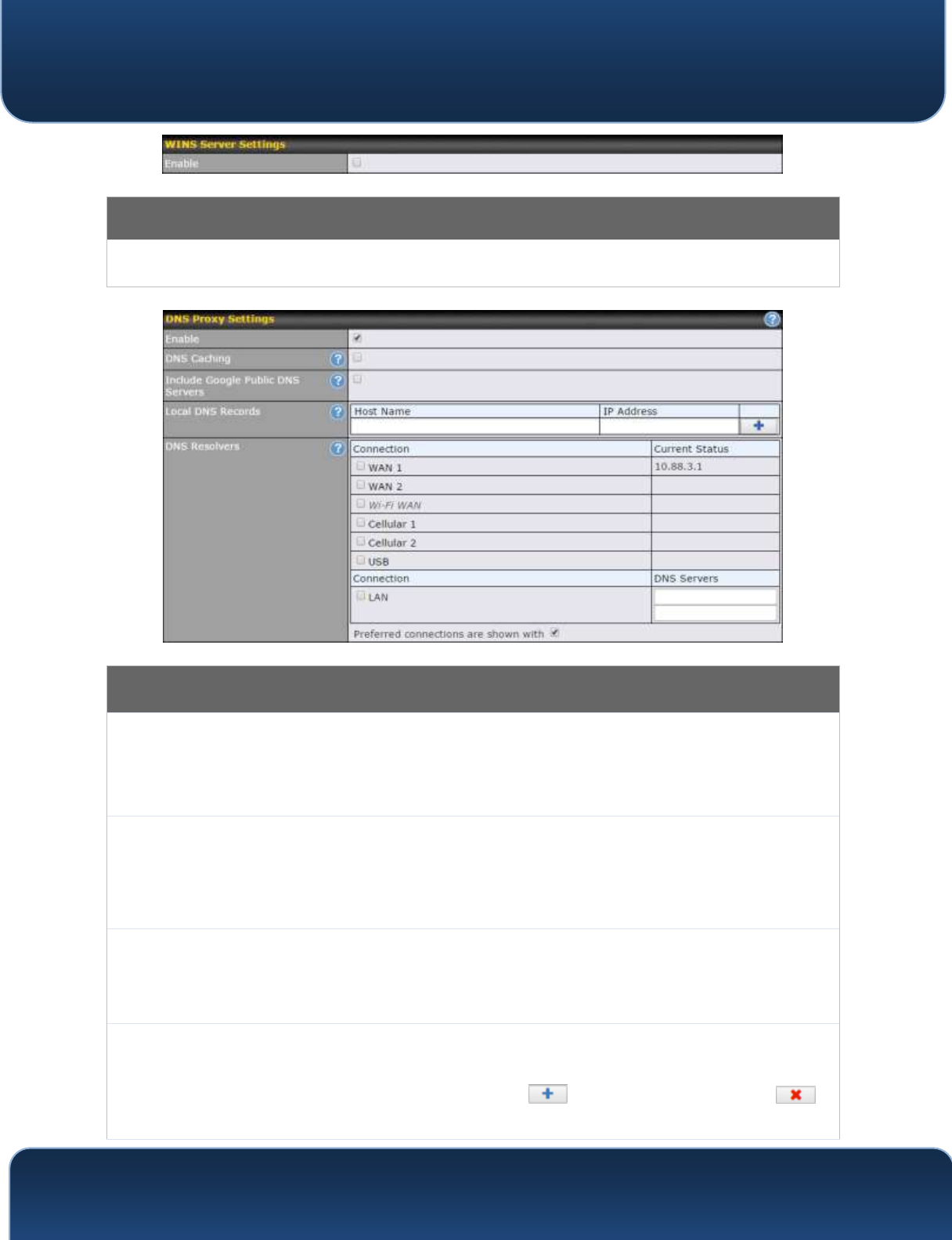
Pepwave MAX and Surf User Manual
http://www.pepwave.com
51
Copyright @ 2018 Pepwave
WINS Server Settings
Enable
Check the box to enable the WINS server. A list of WINS clients will be displayed at
Status>WINS Clients.
DNS Proxy Settings
Enable
To enable the DNS proxy feature, check this box, and then set up the
feature at Network>LAN>DNS Proxy Settings. A DNS proxy server can be
enabled to serve DNS requests originating from LAN/PPTP/SpeedFusionTM
peers. Requests are forwarded to the DNS servers/resolvers defined for
each WAN connection.
DNS Caching
This field is to enable DNS caching on the built-in DNS proxy server. When
the option is enabled, queried DNS replies will be cached until the records’
TTL has been reached. This feature can help improve DNS lookup time.
However, it cannot return the most up-to-date result for those frequently
updated DNS records. By default, DNS Caching is disabled.
Include Google
Public DNS Servers
When this option is enabled, the DNS proxy server will also forward DNS
requests to Google's Public DNS Servers, in addition to the DNS servers
defined in each WAN. This could increase the DNS service's availability. This
setting is disabled by default.
Local DNS Records
This table is for defining custom local DNS records. A static local DNS record
consists of a host name and IP address. When looking up the host name
from the LAN to LAN IP of the Pepwave router, the corresponding IP
address will be returned. Press to create a new record. Press to
remove a record.
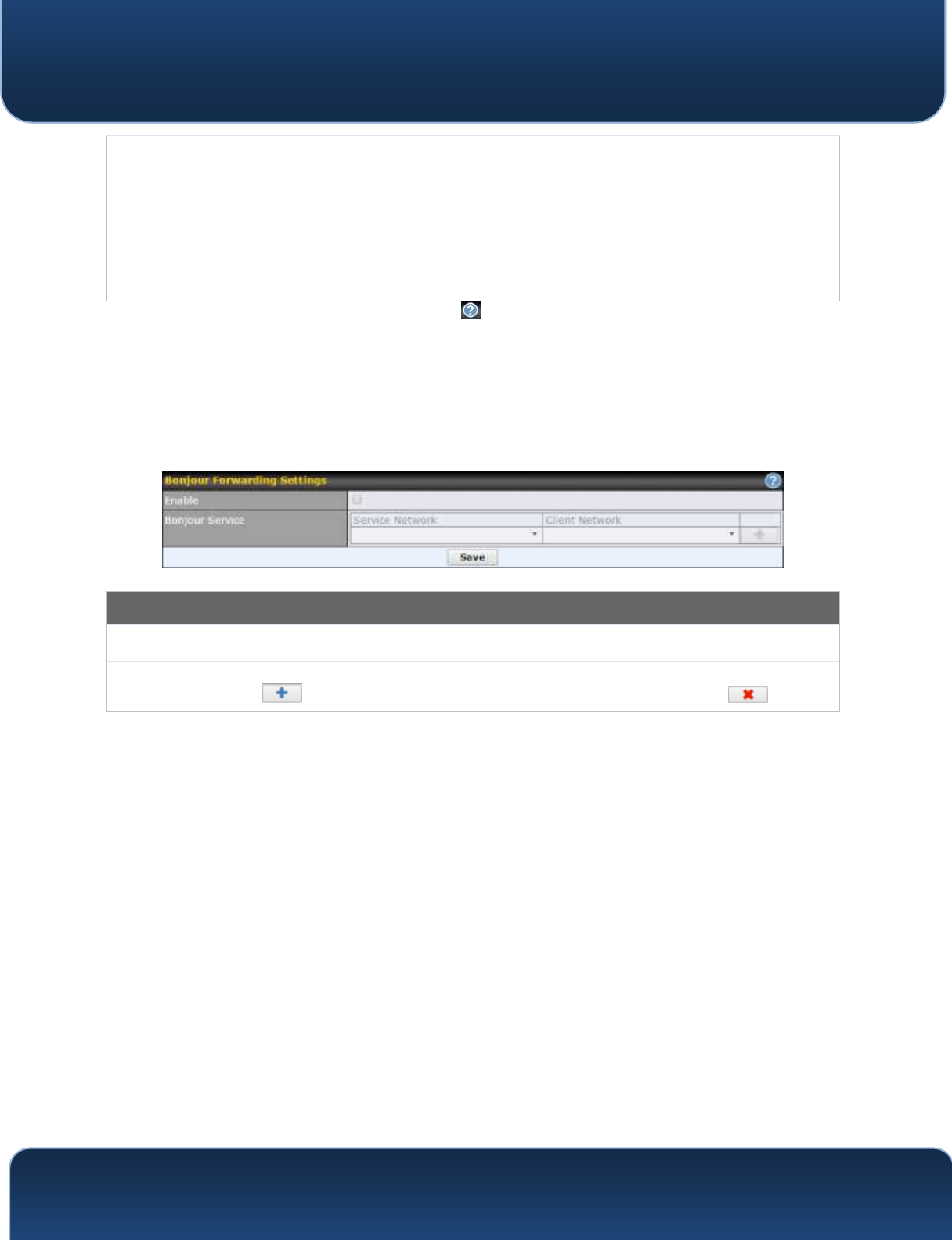
Pepwave MAX and Surf User Manual
http://www.pepwave.com
52
Copyright @ 2018 Pepwave
DNS Resolvers A
Check the box to enable the WINS server. A list of WINS clients will be
displayed at Network>LAN>DNS Proxy Settings>DNS Resolvers. This field
specifies which DNS resolvers will receive forwarded DNS requests. If no
WAN/VPN/LAN DNS resolver is selected, all of the WAN’s DNS resolvers will
be selected.
If a SpeedFusionTM peer is selected, you may enter the VPN peer’s DNS
resolver IP address(es). Queries will be forwarded to the selected
connections’ resolvers. If all of the selected connections are down, queries
will be forwarded to all resolvers on healthy WAN connections.
A - Advanced feature, please click the button on the top right hand corner to
activate.
Finally, if needed, configure Bonjour forwarding, Apple’s zero configuration
networking protocol. Once VLAN configuration is complete, click Save to store
your changes.
Bonjour Forwarding Settings
Enable
Check this box to turn on Bonjour forwarding.
Bonjour Service
Choose Service and Client networks from the drop-down menus, and then click
to add the networks. To delete an existing Bonjour listing, click .
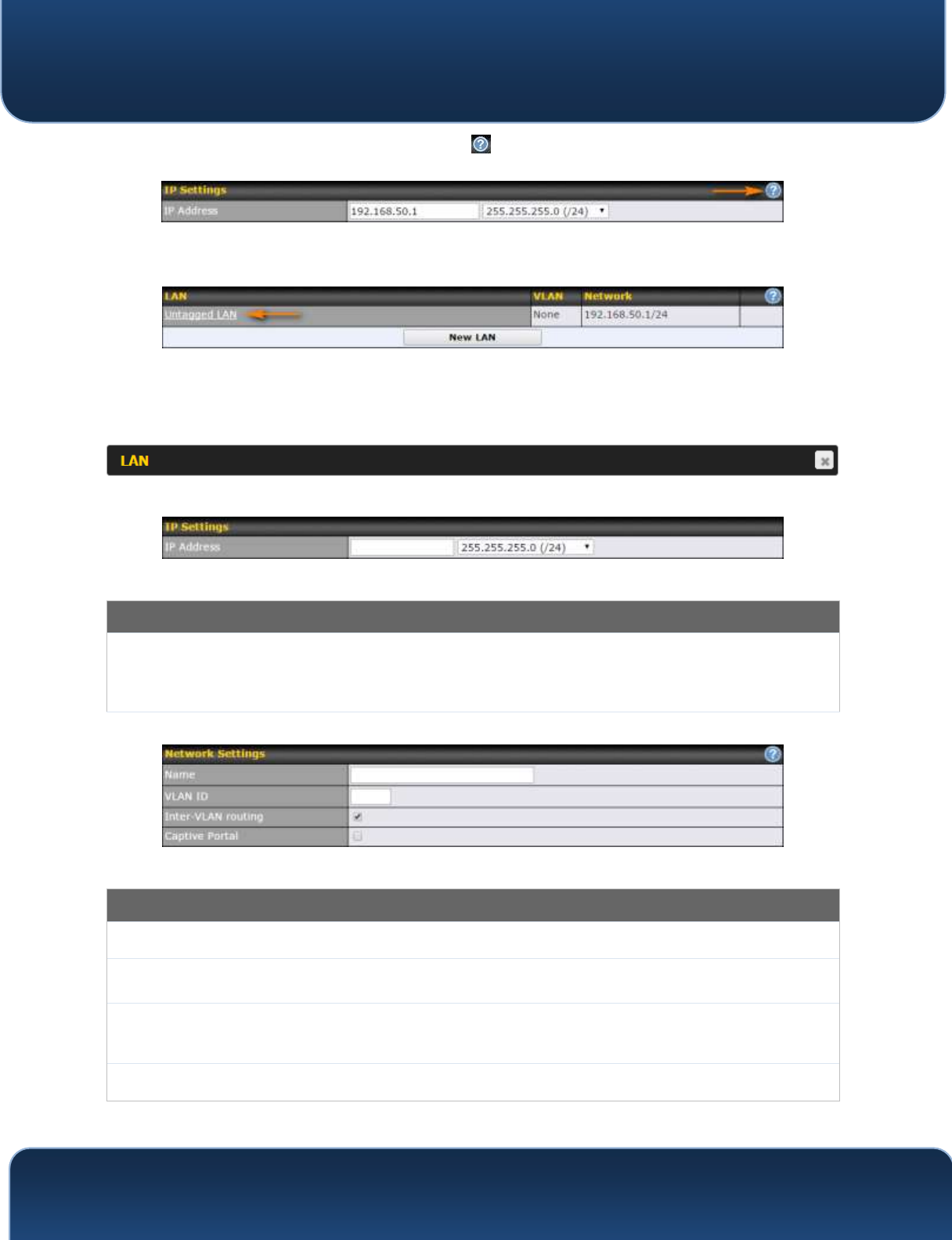
Pepwave MAX and Surf User Manual
http://www.pepwave.com
53
Copyright @ 2018 Pepwave
To enable VLAN configuration, click the button in the IP Settings section.
To add a new LAN, click the New LAN button. To change LAN settings, click the
name of the LAN to change under the LAN heading.
The following settings are displayed when creating a new LAN or editing an
existing LAN.
IP Settings
IP Address &
Subnet Mask
Enter the Pepwave router’s IP address and subnet mask values to be used on the
LAN.
Network Settings
Name
Enter a name for the LAN.
VLAN ID
Enter a number for your VLAN.
Inter-VLAN
routing
Check this box to enable routing between virtual LANs.
Captive Portal
Check this box to turn on captive portals.
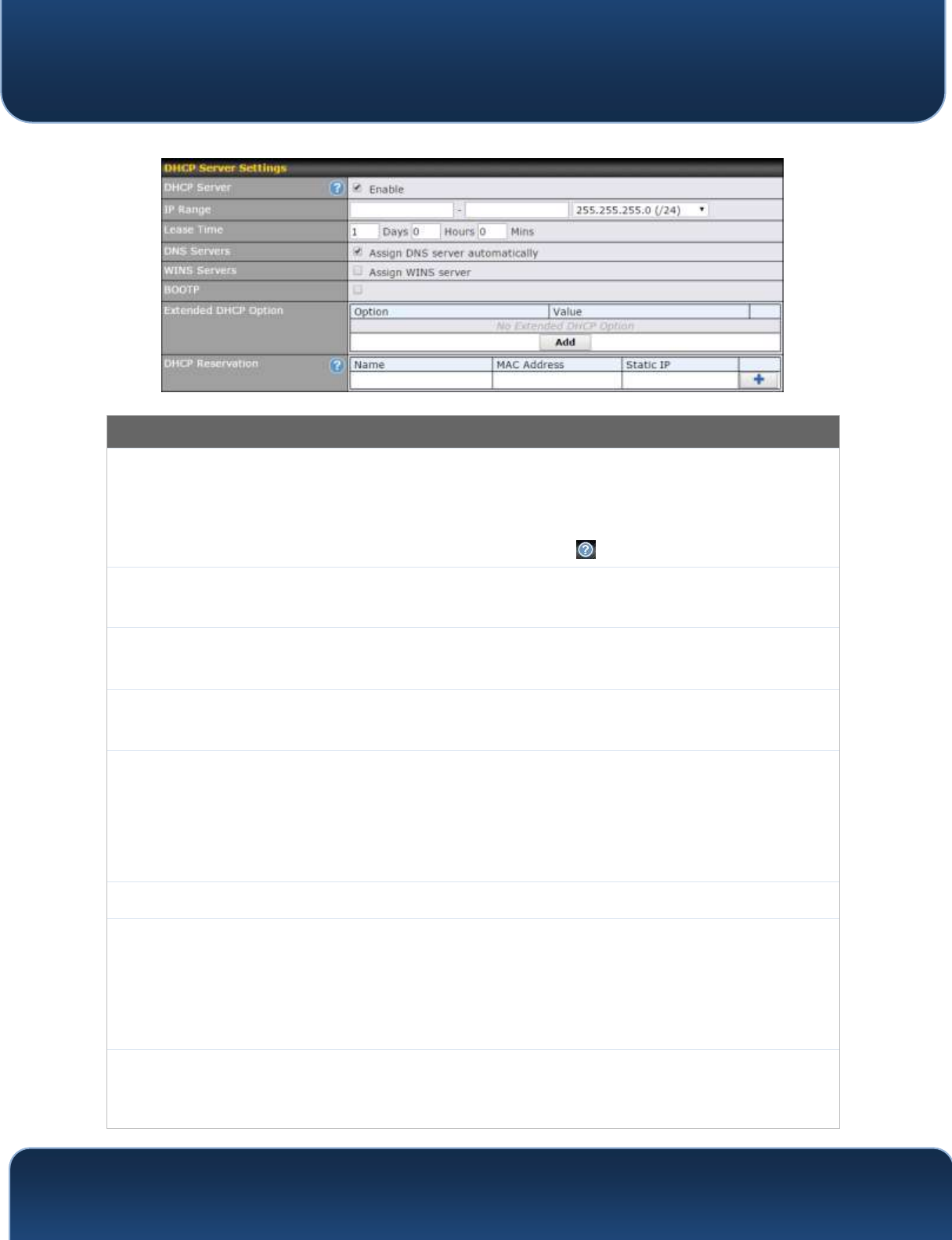
Pepwave MAX and Surf User Manual
http://www.pepwave.com
54
Copyright @ 2018 Pepwave
DHCP Server Settings
DHCP Server
When this setting is enabled, the Pepwave router’s DHCP server automatically
assigns an IP address to each computer that is connected via LAN and configured
to obtain an IP address via DHCP. The Pepwave router’s DHCP server can prevent IP
address collisions on the LAN.
To enable DHCP bridge relay, please click the icon on this menu item.
IP Range &
Subnet Mask
These settings allocate a range of IP address that will be assigned to LAN computers
by the Pepwave router’s DHCP server.
Lease Time
This setting specifies the length of time throughout which an IP address of a DHCP
client remains valid. Upon expiration of Lease Time, the assigned IP address will no
longer be valid and the IP address assignment must be renewed.
DNS Servers
This option allows you to input the DNS server addresses to be offered to DHCP
clients. If Assign DNS server automatically is selected, the Pepwave router’s built-in
DNS server address (i.e., LAN IP address) will be offered.
WINS Servers
This option allows you to specify the Windows Internet Name Service (WINS) server.
You may choose to use the built-in WINS server or external WINS servers. When this
unit is connected using SpeedFusionTM, other VPN peers can share this unit's built-in
WINS server by entering this unit's LAN IP address in their DHCP WINS Servers setting.
Therefore, all PC clients in the VPN can resolve the NetBIOS names of other clients in
remote peers. If you have enabled this option, a list of WINS clients will be displayed
at Status>WINS Clients.
BOOTP
Check this box to enable BOOTP on older networks that still require it.
Extended
DHCP Option
In addition to standard DHCP options (e.g. DNS server address, gateway address,
subnet mask), you can specify the value of additional extended DHCP options, as
defined in RFC 2132. With these extended options enabled, you can pass additional
configuration information to LAN hosts. To define an extended DHCP option, click
the Add button, choose the option to define, and then enter its value. For values
that are in IP address list format, you can enter one IP address per line in the
provided text area input control. Each option can be defined once only.
DHCP
Reservation
This setting reserves the assignment of fixed IP addresses for a list of computers on
the LAN. The computers to be assigned fixed IP addresses on the LAN are identified
by their MAC addresses. The fixed IP address assignment is displayed as a cross-
reference list between the computers’ names, MAC addresses, and fixed IP
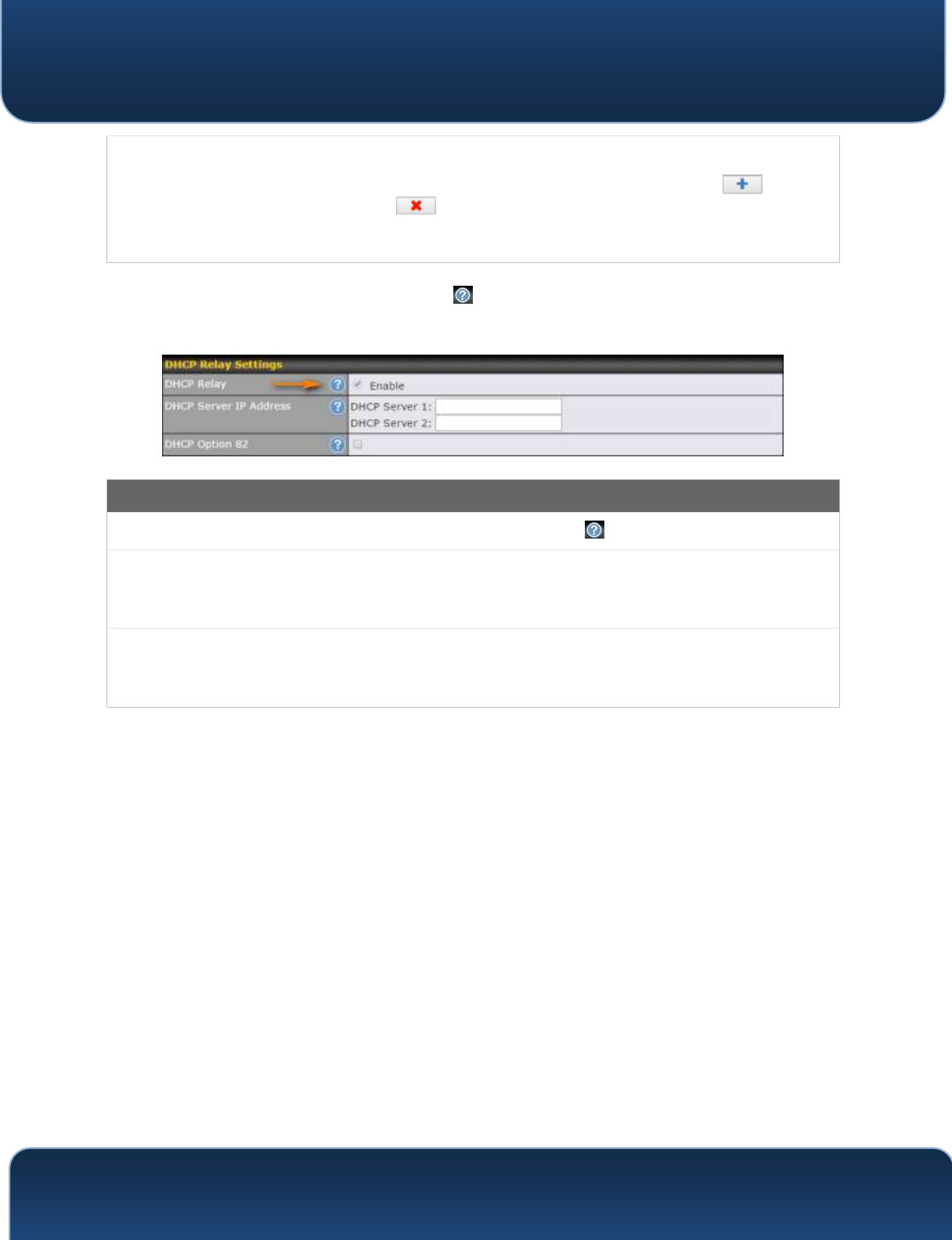
Pepwave MAX and Surf User Manual
http://www.pepwave.com
55
Copyright @ 2018 Pepwave
addresses.
Name (an optional field) allows you to specify a name to represent the device.
MAC addresses should be in the format of 00:AA:BB:CC:DD:EE. Press to create
a new record. Press to remove a record. Reserved clients information can be
imported from the Client List, located at Status>Client List. For more details, please
refer to Section 22.3.
To configure DHCP relay, first click the button found next to the DHCP Server
option to display the settings.
DHCP Relay Settings
Enable
Check this box to turn on DHCP relay. Click the icon to disable DHCP relay.
DHCP Server IP
Address
Enter the IP addresses of one or two DHCP servers in the provided fields. The DHCP
servers entered here will receive relayed DHCP requests from the LAN. For active-
passive DHCP server configurations, enter active and passive DHCP server relay IP
addresses in DHCP Server 1 and DHCP Server 2.
DHCP Option
82
DCHP Option 82 includes device information as relay agent for the attached client
when forwarding DHCP requests from client to server. This option also embeds the
device’s MAC address and network name in circuit and remote IDs. Check this box
to enable DHCP Option 82.
Once DHCP is set up, configure LAN Physical Settings, Static Route Settings, WINS
Server Settings, and DNS Proxy Settings as noted above.
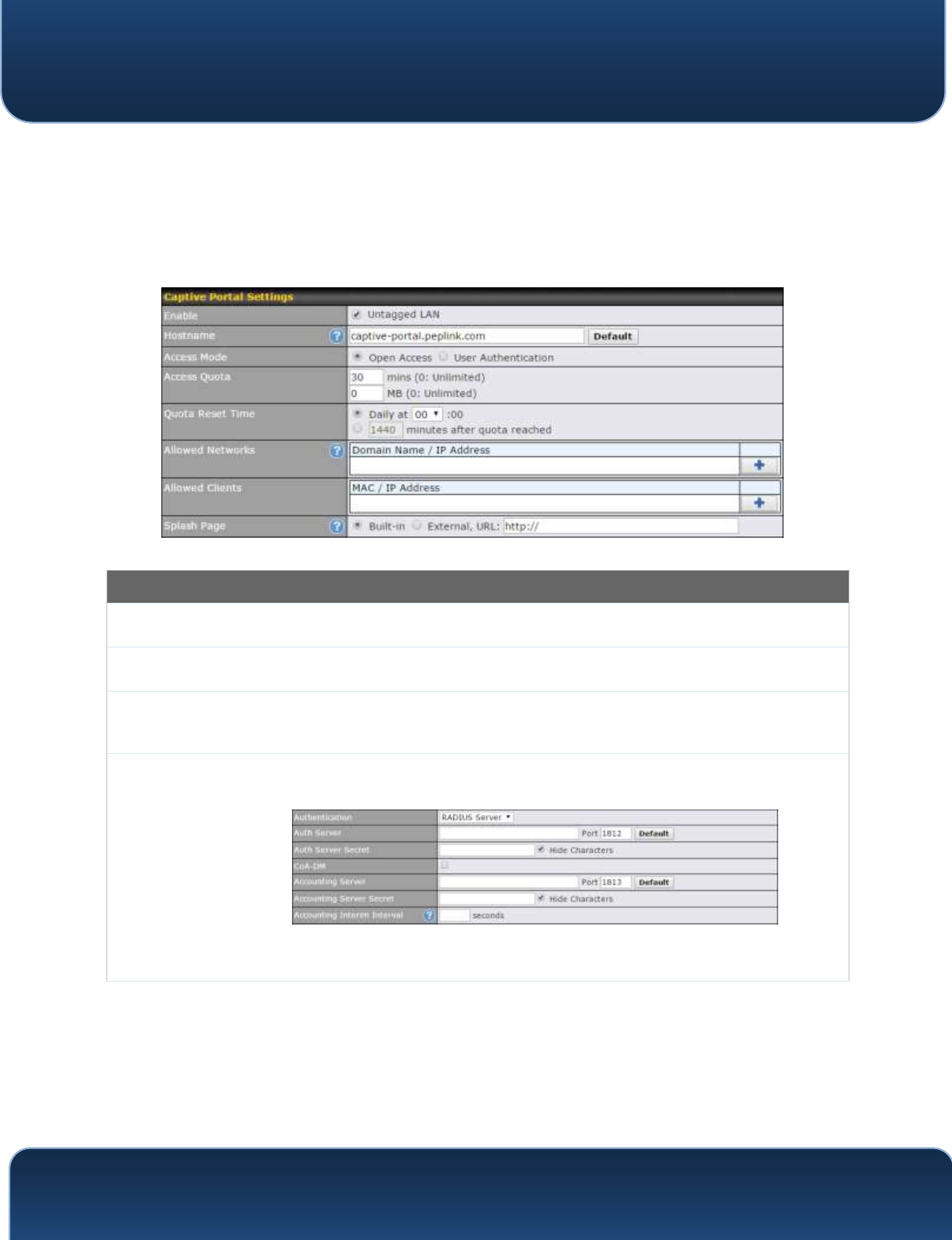
Pepwave MAX and Surf User Manual
http://www.pepwave.com
56
Copyright @ 2018 Pepwave
9.2 Captive Portal
The captive portal serves as gateway that clients have to pass if they wish to
access the internet using your router. To configure, navigate to
Network>LAN>Captive Portal.
Captive Portal Settings
Enable
Check Enable and then, optionally, select the LANs/VLANs that will use the
captive portal.
Hostname
To customize the portal’s form submission and redirection URL, enter a new URL in
this field. To reset the URL to factory settings, click Default.
Access Mode
Click Open Access to allow clients to freely access your router. Click User
Authentication to force your clients to authenticate before accessing your
router.
RADIUS Server
This authenticates your clients through a RADIUS server. After selecting this
option, you will see the following fields:
Fill in the necessary information to complete your connection to the server and
enable authentication.
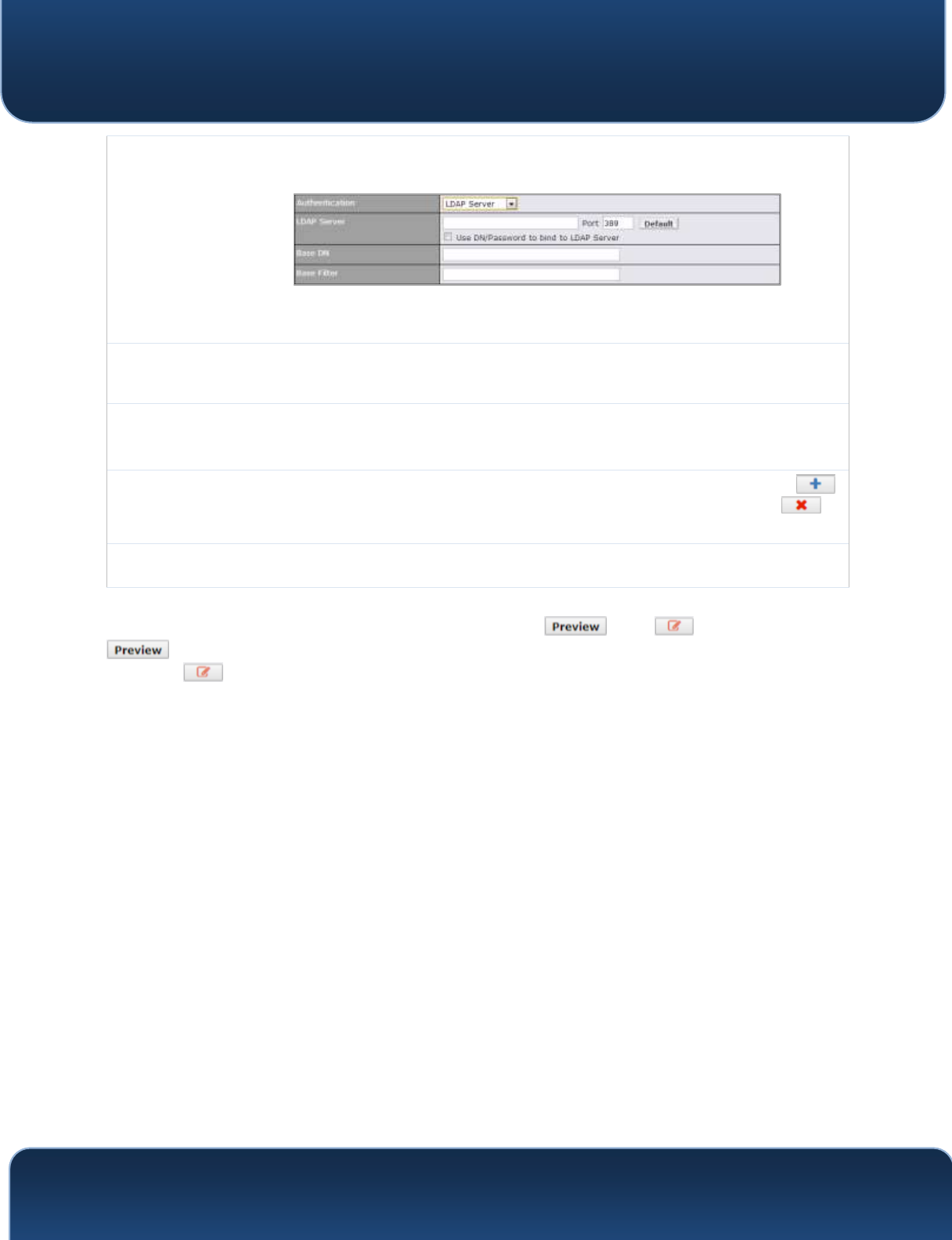
Pepwave MAX and Surf User Manual
http://www.pepwave.com
57
Copyright @ 2018 Pepwave
LDAP Server
This authenticates your clients through a LDAP server. Upon selecting this option,
you will see the following fields:
Fill in the necessary information to complete your connection to the server and
enable authentication.
Access
Quota
Set a time and data cap to each user’s Internet usage.
Quota Reset
Time
This menu determines how your usage quota resets. Setting it to Daily will reset it
at a specified time every day. Setting a number of minutes after quota reached
establish a timer for each user that begins after the quota has been reached.
Allowed
Networks
To whitelist a network, enter the domain name / IP address here and click .
To delete an existing network from the list of allowed networks, click the
button next to the listing.
Splash Page
Here, you can choose between using the Pepwave router’s built-in captive
portal and redirecting clients to a URL you define.
The Portal Customization menu has two options: and . Clicking
displays a pop-up previewing the captive portal that your clients will see.
Clicking displays the following menu:
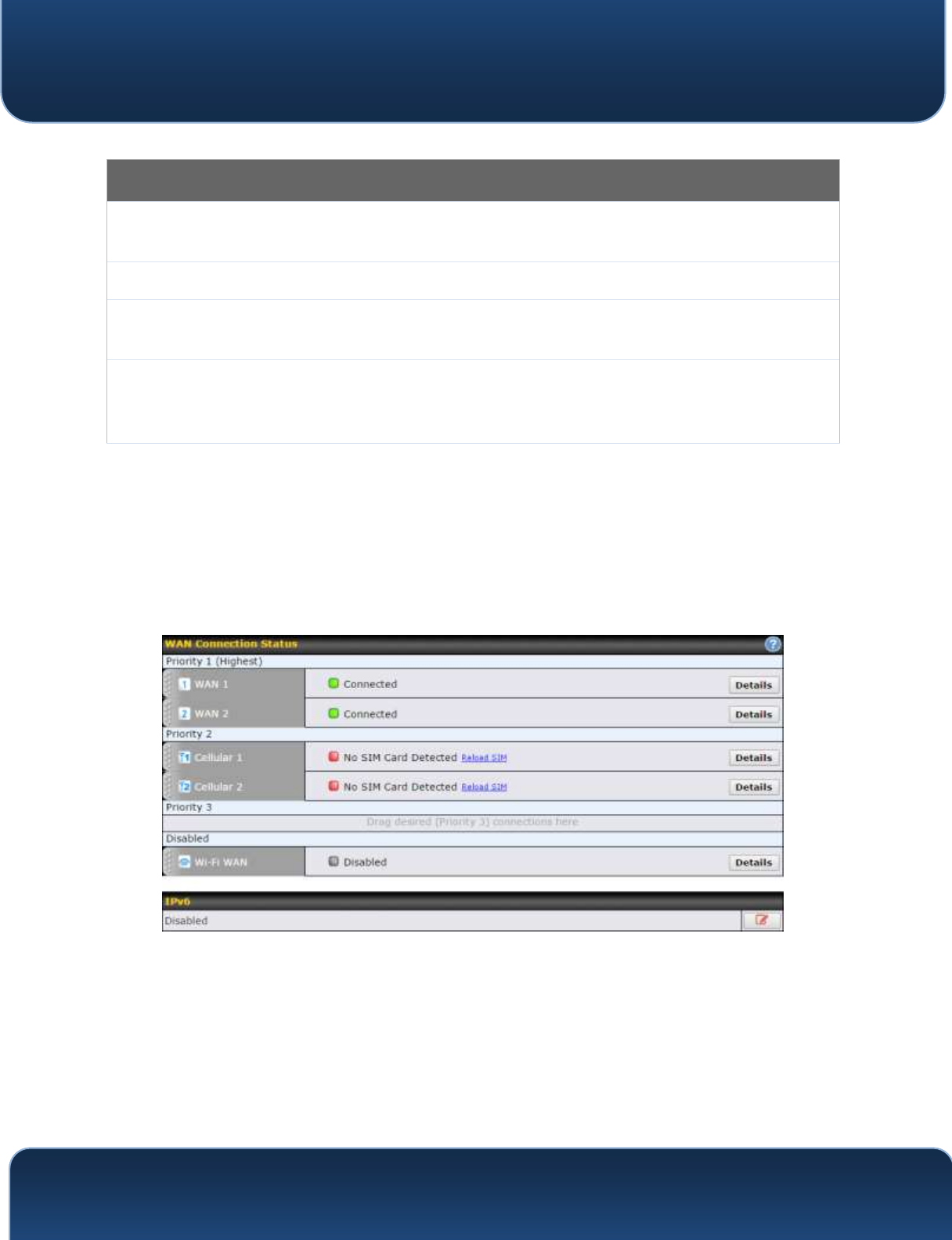
Pepwave MAX and Surf User Manual
http://www.pepwave.com
59
Copyright @ 2018 Pepwave
Portal Customization
Logo
Image
Click the Choose File button to select a logo to use for the built-in portal.
Message
If you have any additional messages for your users, enter them in this field.
Terms &
Conditions
If you would like to use your own set of terms and conditions, please enter them
here. If left empty, the built-in portal will display the default terms and conditions.
Custom
Landing
Page
Fill in this field to redirect clients to an external URL.
10 Configuring the WAN Interface(s)
WAN Interface settings are located at Network>WAN. To reorder WAN priority,
drag on the appropriate WAN by holding the left mouse button, move it to the
desired priority (the first one would be the highest priority, the second one would
be lower priority, and so on), and drop it by releasing the mouse button.

Pepwave MAX and Surf User Manual
http://www.pepwave.com
60
Copyright @ 2018 Pepwave
To disable a particular WAN connection, drag on the appropriate WAN by
holding the left mouse button, move it the Disabled row, and drop it by
releasing the mouse button.
You can also set priorities on the Dashboard. Click the Details button in the
corresponding row to modify the connection setting.
Important Note
Connection details will be changed and become effective immediately after clicking the Save and
Apply button.
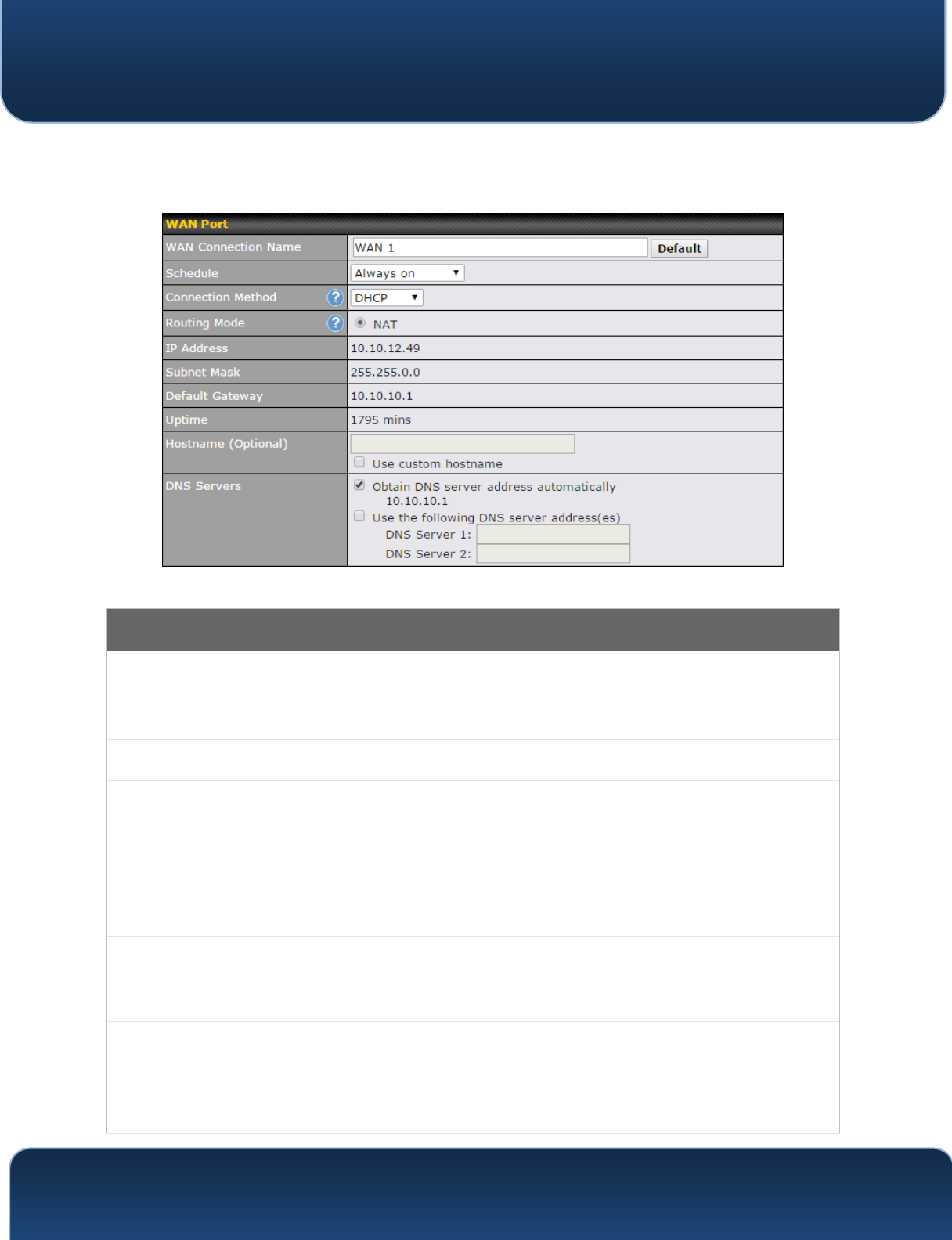
Pepwave MAX and Surf User Manual
http://www.pepwave.com
61
Copyright @ 2018 Pepwave
10.1 Ethernet WAN
From Network>WAN, choose a WAN connection and then click Details.
WAN Port (Section 1)
WAN
Connection
Name
Enter a name to represent this WAN connection.
Schedule
Click the drop-down menu to apply a time schedule to this interface
Connection
Method
There are three possible connection methods for Ethernet WAN:
DHCP
Static IP
PPPoE
The connection method and details are determined by, and can be obtained
from, the ISP. See the following sections for details on each connection method.
Routing Mode
This field shows that NAT (network address translation) will be applied to the traffic
routed over this WAN connection. IP Forwarding is available when you click the link
in the help text.
IP
Address/Subnet
Mask/Default
Gateway
Enter the WAN IP address and subnet mask, as well as the IP address of the default
gateway, in these fields.
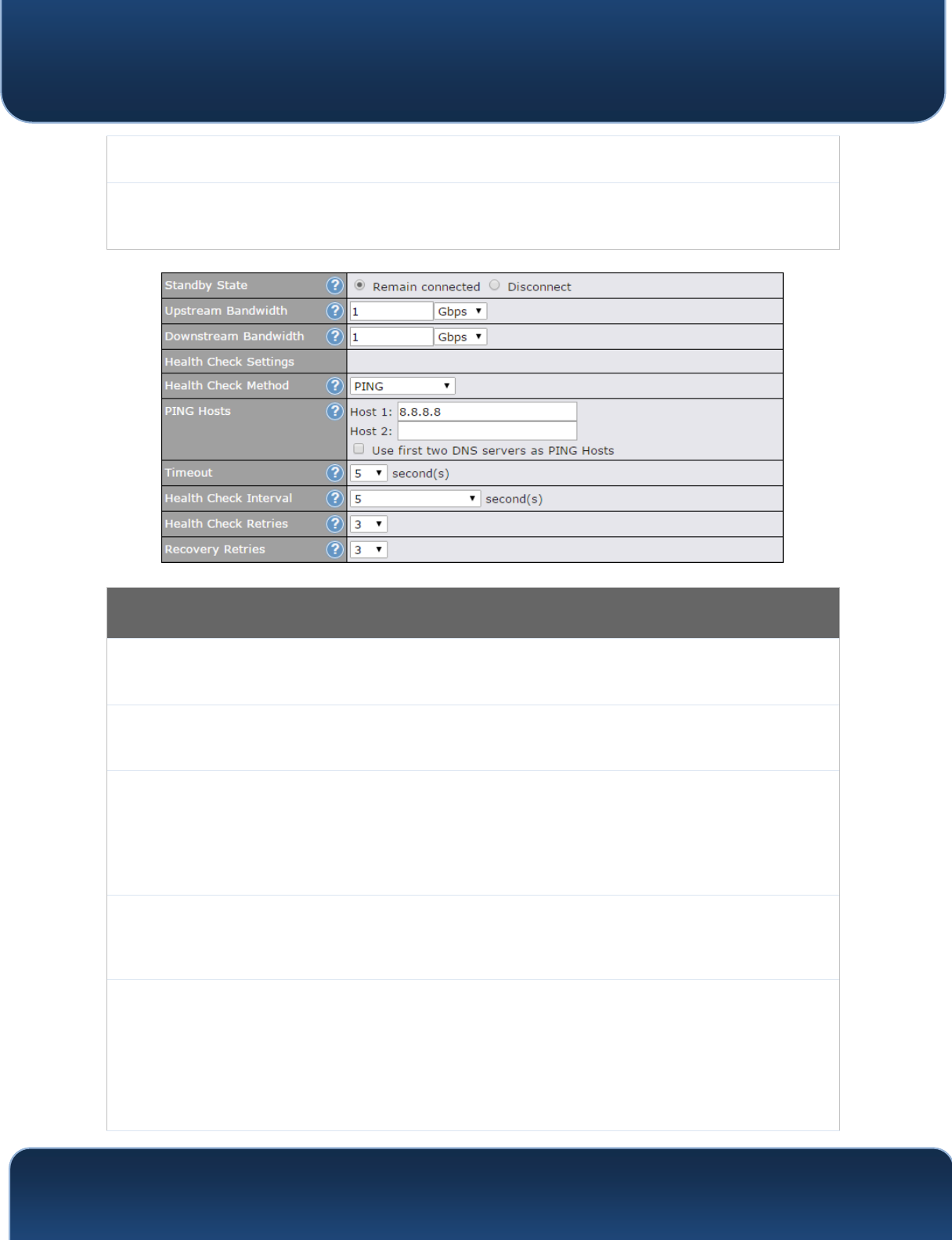
Pepwave MAX and Surf User Manual
http://www.pepwave.com
62
Copyright @ 2018 Pepwave
Hostname
Enter a hostname for this WAN port if needed.
DNS Servers
Select a DNS server for this port to use. This port can either be automatically
selected or manually designated.
WAN Port (Section 2)
Standby State
This setting specifies the standby state of the WAN connection. The available options
are Remain connected and Disconnect. The default state is Remain Connected.
Upstream
Bandwidth
This setting specifies the data bandwidth in the outbound direction from the LAN
through the WAN interface.
Downstream
Bandwidth
This setting specifies the data bandwidth in the inbound direction from the WAN
interface to the LAN. This value is referenced as the default weight value when using
the algorithm Least Used or the algorithm Persistence (Auto) in outbound policy with
Managed by Custom Rules chosen (see Section 15.2).
Health Check
Method
This setting specifies the health check method for the WAN connection. The value of
method can be configured as Disabled, Ping, DNS Lookup, or HTTP. The default
method is Disabled. See Section 10.4 for configuration details.
PING Hosts
These fields are for specifying the target DNS servers where DNS lookups will be sent
to for health check.
If the box Use first two DNS servers as Health Check DNS Servers is checked, the first
two DNS servers will be the DNS lookup targets for checking the connection
healthiness. If the box is not checked, the field Host 1 must be filled and the field Host
2 is optional.
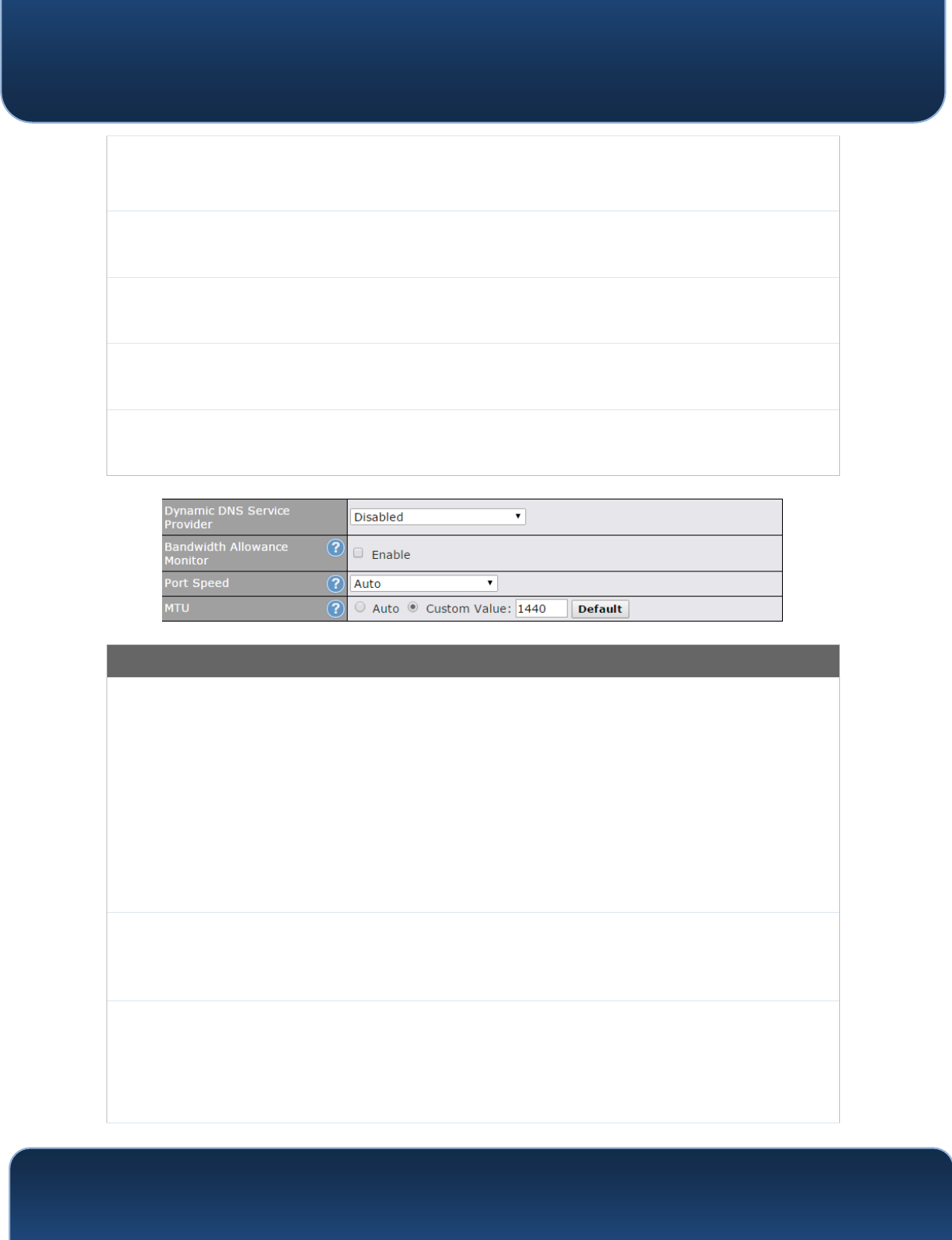
Pepwave MAX and Surf User Manual
http://www.pepwave.com
63
Copyright @ 2018 Pepwave
The connection is considered to be up if DNS responses are received from any one
of the health check DNS servers, regardless of whether the result is positive or
negative.
Timeout
If a health check test cannot be completed within the specified amount of time, the
test will be treated as failed.
Health Check
Interval
This is the number of consecutive check failures before treating a connection as
down.
Health Check
Retries
This is the number of consecutive check failures before treating a connection as
down.
Recovery
Retries
This is the number of responses required after a health check failure before treating a
connection as up again.
WAN Port (Section 3)
Dynamic DNS
Service
Provider
This setting specifies the dynamic DNS service provider to be used for the WAN
based on supported dynamic DNS service providers:
changeip.com
dyndns.org
no-ip.org
tzo.com
DNS-O-Matic
Select Disabled to disable this feature. See Section 9.5 for configuration details.
Bandwidth
Allowance
Monitor
This option enables bandwidth usage monitoring on this WAN connection for each
billing cycle. When this setting is not enabled, each month’s bandwidth usage is
tracked, but no action will be taken.
Port Speed
This setting specifies port speed and duplex configurations of the WAN port. By
default, Auto is selected and the appropriate data speed is automatically detected
by the Pepwave router. In the event of negotiation issues, the port speed can be
manually specified. You can also choose whether or not to advertise the speed to
the peer by selecting the Advertise Speed checkbox.
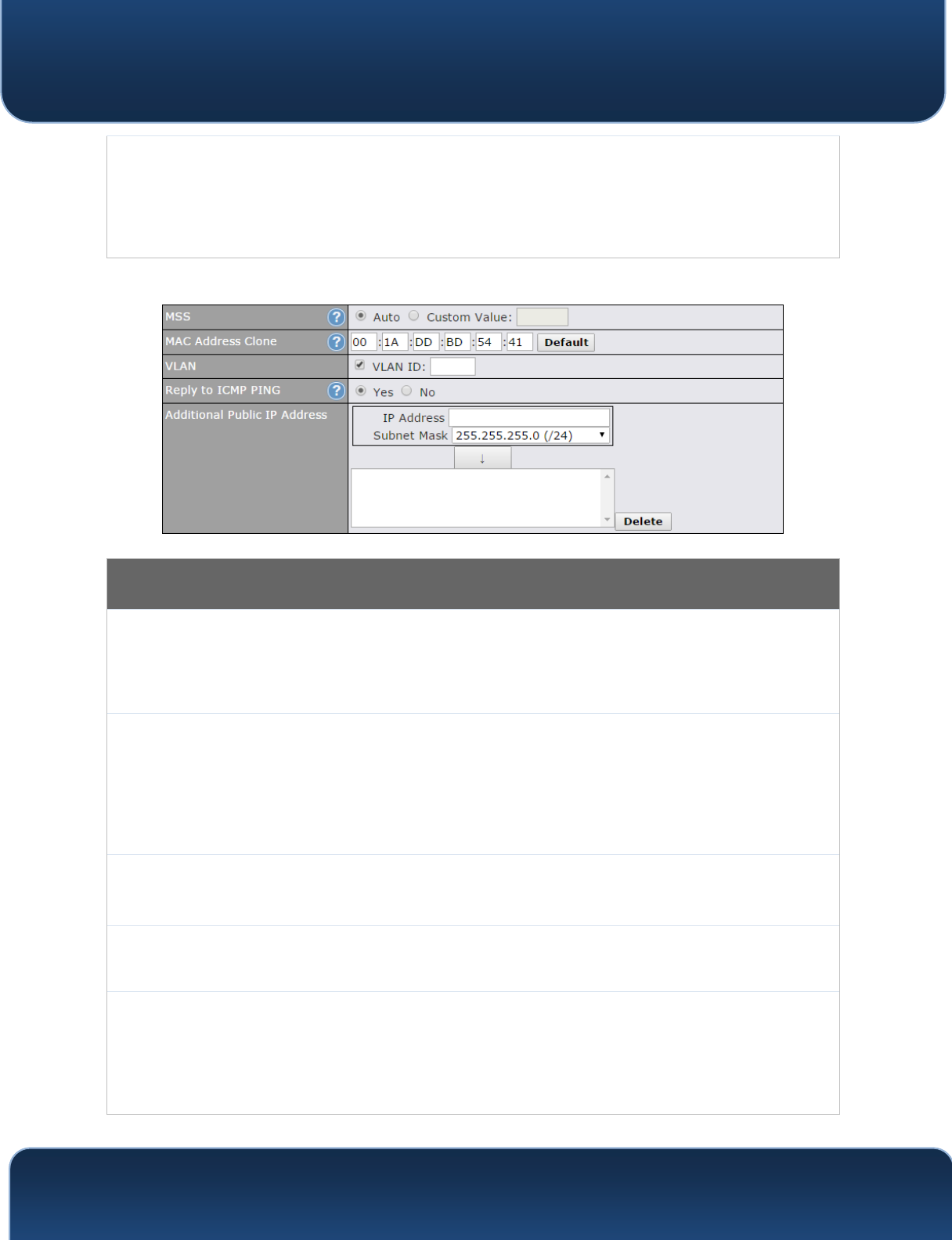
Pepwave MAX and Surf User Manual
http://www.pepwave.com
64
Copyright @ 2018 Pepwave
MTU
This setting specifies the maximum transmission unit. By default, MTU is set to Custom
1440. You may adjust the MTU value by editing the text field. Click Default to restore
the default MTU value. Select Auto and the appropriate MTU value will be
automatically detected. Auto-detection will run each time the WAN connection
establishes.
WAN Port (Section 4)
MSS
This setting should be configured based on the maximum payload size that the local
system can handle. The MSS (maximum segment size) is computed from the MTU
minus 40 bytes for TCP over IPv4. If MTU is set to Auto, the MSS will also be set
automatically. By default, MSS is set to Auto.
MAC Address
Clone
Some service providers (e.g., cable providers) identify the client’s MAC address and
require the client to always use the same MAC address to connect to the network. In
such cases, change the WAN interface’s MAC address to the original client PC’s
MAC address via this field. The default MAC address is a unique value assigned at
the factory. In most cases, the default value is sufficient. Clicking Default restores the
MAC address to the default value.
VLAN
Click the square if you wish to enable VLAN functionality and enable multiple
broadcast domains. Once you enable VLAN, you will be able to enter a name for
your network.
Reply to ICMP
PING
If this field is disabled, the WAN connection will not respond to ICMP ping requests.
By default, this is enabled.
Additional
Public IP
Address
The IP Address list represents the list of fixed Internet IP addresses assigned by the ISP,
in the event that more than one Internet IP address is assigned to this WAN
connection. Enter the fixed Internet IP addresses and the corresponding subnet
mask, and then click the Down Arrow button to populate IP address entries to the IP
Address List.
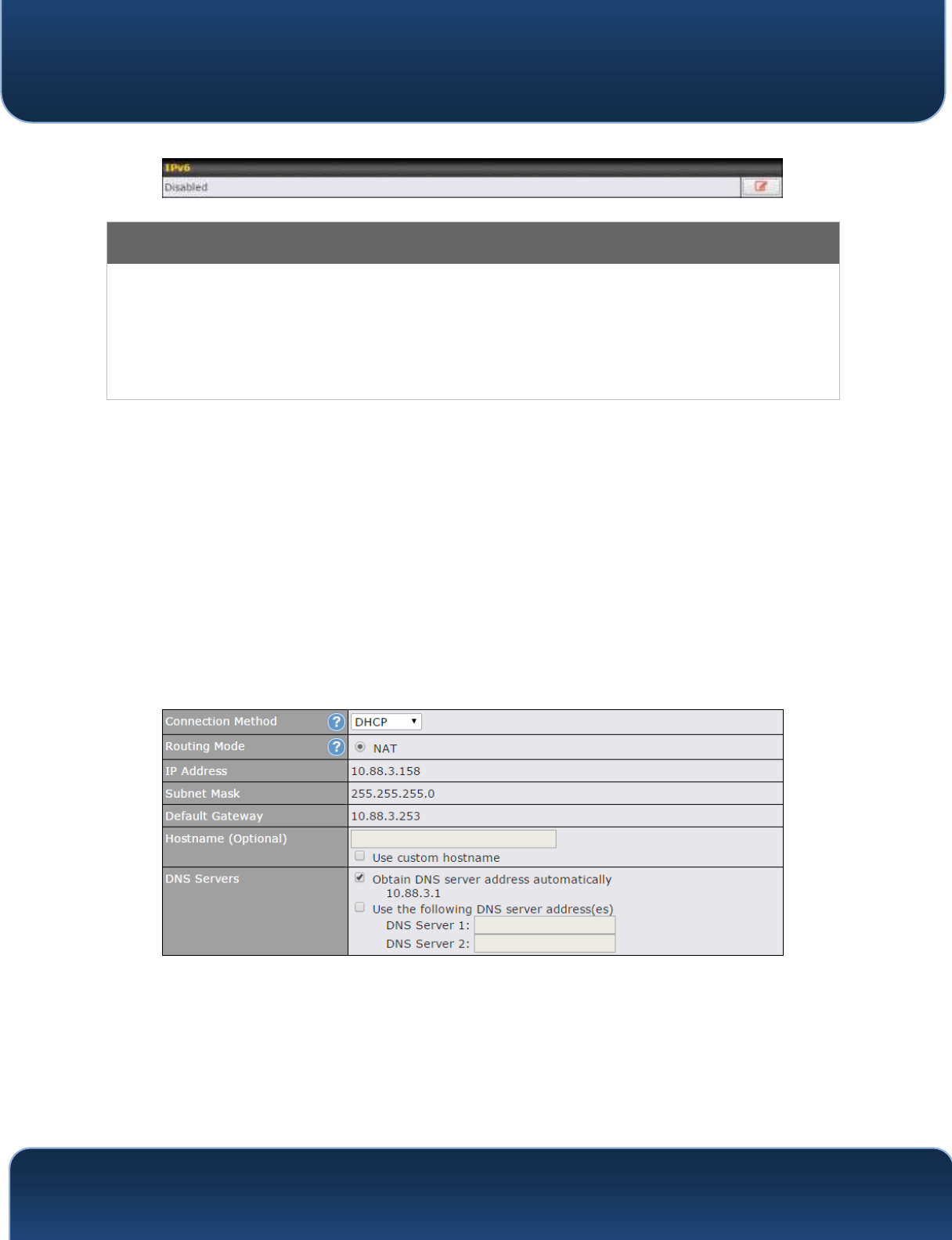
Pepwave MAX and Surf User Manual
http://www.pepwave.com
65
Copyright @ 2018 Pepwave
IPv6
IPv6
IPv6 support can be enabled on one of the available Ethernet WAN ports. On this
screen, you can choose which WAN will support IPv6. To enable IPv6 support on a
WAN, the WAN router must respond to stateless address auto configuration
advertisements and DHCPv6 requests. IPv6 clients on the LAN will acquire their IPv6,
gateway, and DNS server addresses from it. The device will also acquire an IPv6
address for performing ping/traceroute checks and accepting web admin accesses.
Note: This feature is only available on the Pepwave MAX 700, HD2, and HD2 IP67.
10.1.1 DHCP Connection
There are four possible connection methods:
1. DHCP
2. Static IP
3. PPPoE
4. L2TP
The DHCP connection method is suitable if the ISP provides an IP address
automatically using DHCP (e.g., satellite modem, WiMAX modem, cable, Metro
Ethernet, etc.).
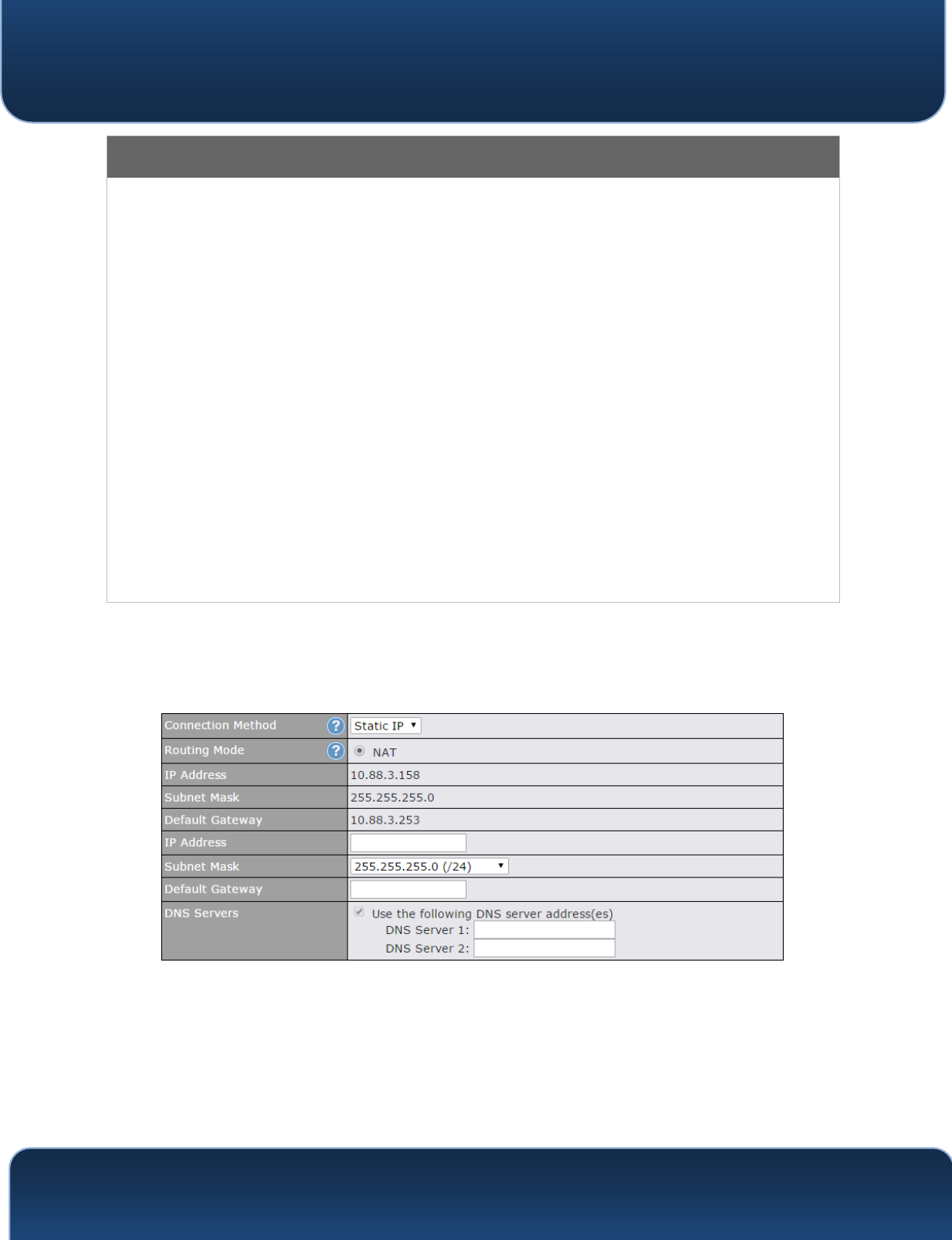
Pepwave MAX and Surf User Manual
http://www.pepwave.com
66
Copyright @ 2018 Pepwave
DHCP Connection Settings
Routing Mode
NAT allows substituting the real address in a packet with a mapped address
that is routable on the destination network. By clicking the help icon in this
field, you can display the IP Forwarding option, if your network requires it.
IP Address/
Subnet Mask/
Default Gateway
This information is obtained from the ISP automatically.
Hostname
(Optional)
If your service provider's DHCP server requires you to supply a hostname
value upon acquiring an IP address, you may enter the value here. If your
service provider does not provide you with the value, you can safely bypass
this option.
DNS Servers
Each ISP may provide a set of DNS servers for DNS lookups. This setting
specifies the DNS (Domain Name System) servers to be used when a DNS
lookup is routed through this connection.
Selecting Obtain DNS server address automatically results in the DNS servers
being assigned by the WAN DHCP server to be used for outbound DNS
lookups over the connection. (The DNS servers are obtained along with the
WAN IP address assigned from the DHCP server.)
When Use the following DNS server address(es) is selected, you may enter
custom DNS server addresses for this WAN connection into the DNS Server 1
and DNS Server 2 fields.
10.1.2 Static IP Connection
The static IP connection method is suitable if your ISP provides a static IP address
to connect directly.
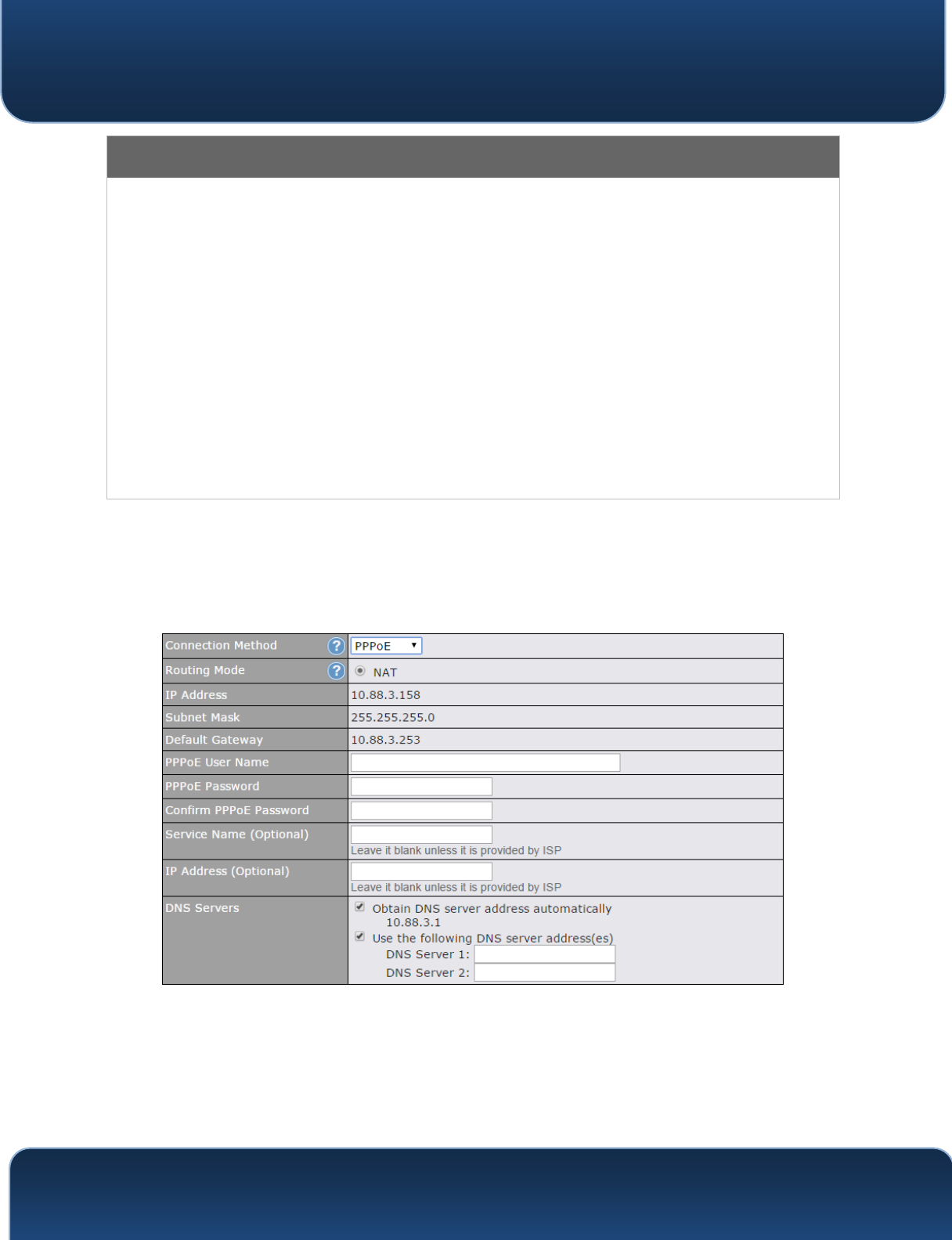
Pepwave MAX and Surf User Manual
http://www.pepwave.com
67
Copyright @ 2018 Pepwave
Static IP Settings
Routing Mode
NAT allows substituting the real address in a packet with a mapped address that is
routable on the destination network. By clicking the help icon in this field, you can
display the IP Forwarding option, if your network requires it.
IP Address /
Subnet Mask /
Default
Gateway
These settings allow you to specify the information required in order to
communicate on the Internet via a fixed Internet IP address. The information is
typically determined by and can be obtained from the ISP.
DNS Servers
Each ISP may provide a set of DNS servers for DNS lookups. This setting specifies the
DNS (Domain Name System) servers to be used when a DNS lookup is routed
through this connection. Selecting Obtain DNS server address automatically results
in the DNS servers being assigned by the WAN DHCP server to be used for
outbound DNS lookups over the connection. (The DNS servers are obtained along
with the WAN IP address assigned from the DHCP server.) When Use the following
DNS server address(es) is selected, you may enter custom DNS server addresses for
this WAN connection into the DNS Server 1 and DNS Server 2 fields.
10.1.3 PPPoE Connection
This connection method is suitable if your ISP provides a login ID/password to
connect via PPPoE.

Pepwave MAX and Surf User Manual
http://www.pepwave.com
68
Copyright @ 2018 Pepwave
PPPoE Settings
Routing Mode
NAT allows substituting the real address in a packet with a mapped address
that is routable on the destination network. By clicking the help icon in this field,
you can display the IP Forwarding option, if your network requires it.
IP Address /
Subnet Mask /
Default Gateway
This information is obtained from the ISP automatically.
PPPoE User Name
/ Password
Enter the required information in these fields in order to connect via PPPoE to
the ISP. The parameter values are determined by and can be obtained from
the ISP.
Confirm PPPoE
Password
Verify your password by entering it again in this field.
Service Name
(Optional)
Service name is provided by the ISP.
Note: Leave this field blank unless it is provided by your ISP.
IP Address
(Optional)
If your ISP provides a PPPoE IP address, enter it here.
Note: Leave this field blank unless it is provided by your ISP.
DNS Servers
Each ISP may provide a set of DNS servers for DNS lookups. This setting specifies
the DNS (Domain Name System) servers to be used when a DNS lookup is
routed through this connection. Selecting Obtain DNS server address
automatically results in the DNS servers being assigned by the WAN DHCP
server to be used for outbound DNS lookups over the connection. (The DNS
servers are obtained along with the WAN IP address assigned from the DHCP
server.) When Use the following DNS server address(es) is selected, you may
enter custom DNS server addresses for this WAN connection into the DNS
Server 1 and DNS Server 2 fields.
10.1.4 L2TP Connection
L2TP has all the compatibility and convenience of PPTP with greater security.
Combine this with IPsec for a good balance between ease of use and security.
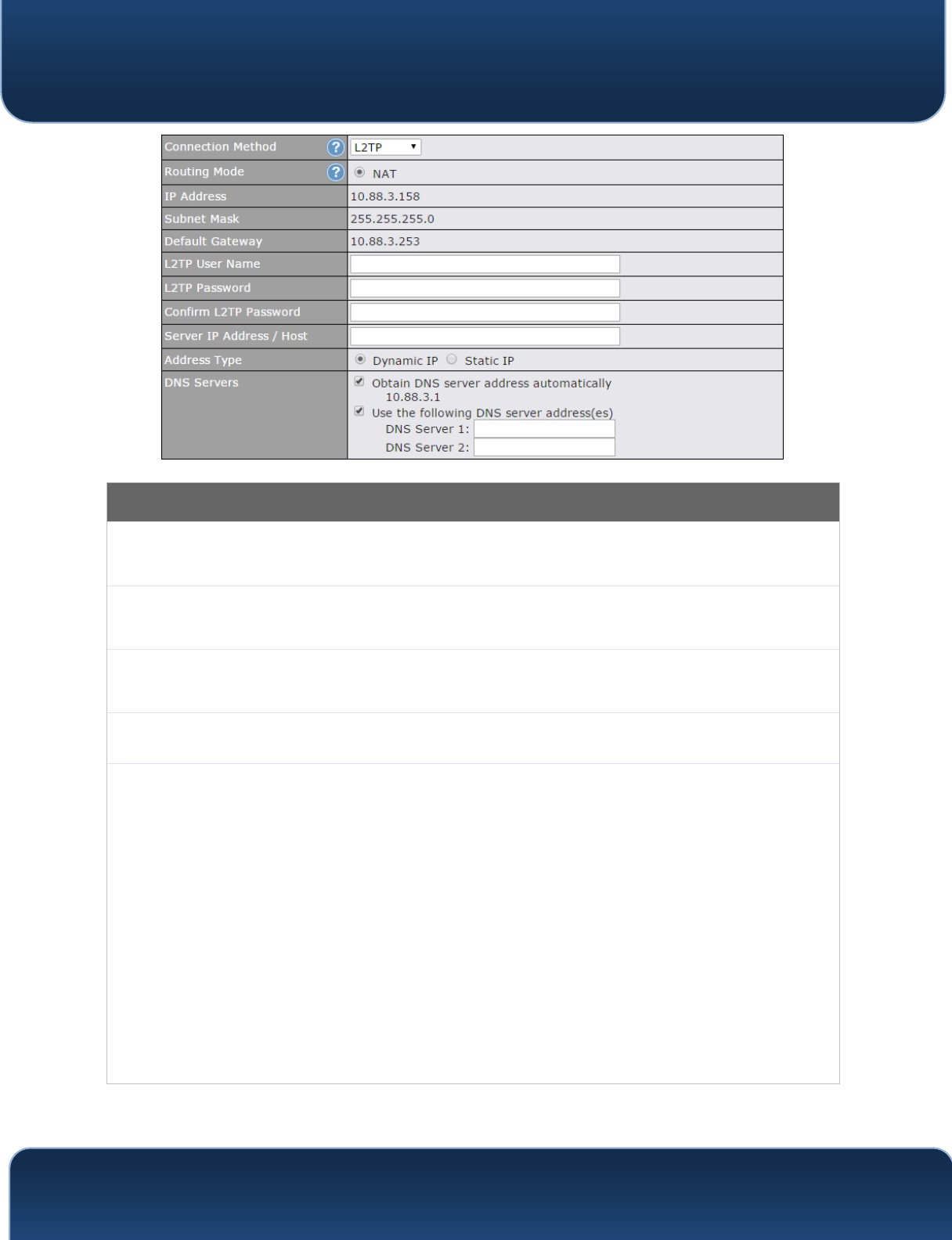
Pepwave MAX and Surf User Manual
http://www.pepwave.com
69
Copyright @ 2018 Pepwave
L2TP Settings
L2TP User Name
/ Password
Enter the required information in these fields in order to connect via L2TP to your ISP.
The parameter values are determined by and can be obtained from your ISP.
Confirm L2TP
Password
Verify your password by entering it again in this field.
Server IP
Address / Host
L2TP server address is a parameter which is provided by your ISP.
Note: Leave this field blank unless it is provided by your ISP.
Address Type
Your ISP will also indicate whether the server IP address is Dynamic or Static. Please
click the appropriate value.
DNS Servers
Each ISP may provide a set of DNS servers for DNS lookups. This setting specifies the
DNS (Domain Name System) servers to be used when a DNS lookup is routed
through this
connection.
Selecting Obtain DNS server address automatically results in the DNS servers
assigned
by the PPPoE server to be used for outbound DNS lookups over the WAN
connection.
(The DNS servers are obtained along with the WAN IP address assigned from the
PPPoE
server.)
When Use the following DNS server address(es) is selected, you can enter custom
DNS server addresses for this WAN connection into the DNS server 1 and DNS server
2 fields.
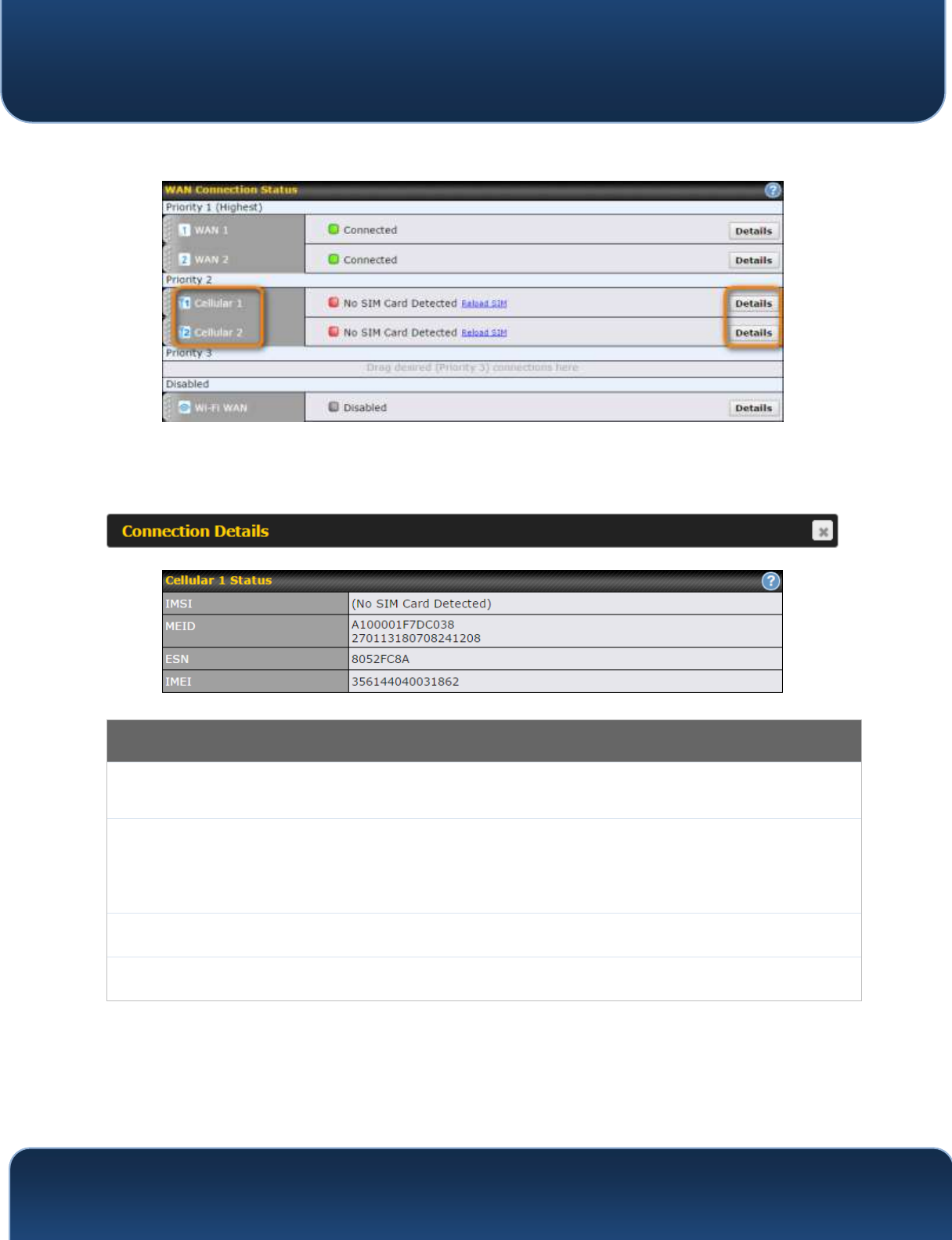
Pepwave MAX and Surf User Manual
http://www.pepwave.com
70
Copyright @ 2018 Pepwave
10.2 Cellular WAN
To access cellular WAN settings, click Network>WAN>Details.
(Available on the Pepwave MAX BR1, HD2, and HD2 IP67 only)
Cellular Status
IMSI
This is the International Mobile Subscriber Identity which uniquely identifies the SIM
card. This is applicable to 3G modems only.
MEID
Some Pepwave routers support both HSPA and EV-DO. For Sprint or Verizon Wireless EV-
DO users, a unique MEID identifier code (in hexadecimal format) is used by the carrier
to associate the EV-DO device with the user. This information is presented in hex and
decimal format.
ESN
This serves the same purpose as MEID HEX but uses an older format.
IMEI
This is the unique ID for identifying the modem in GSM/HSPA mode.
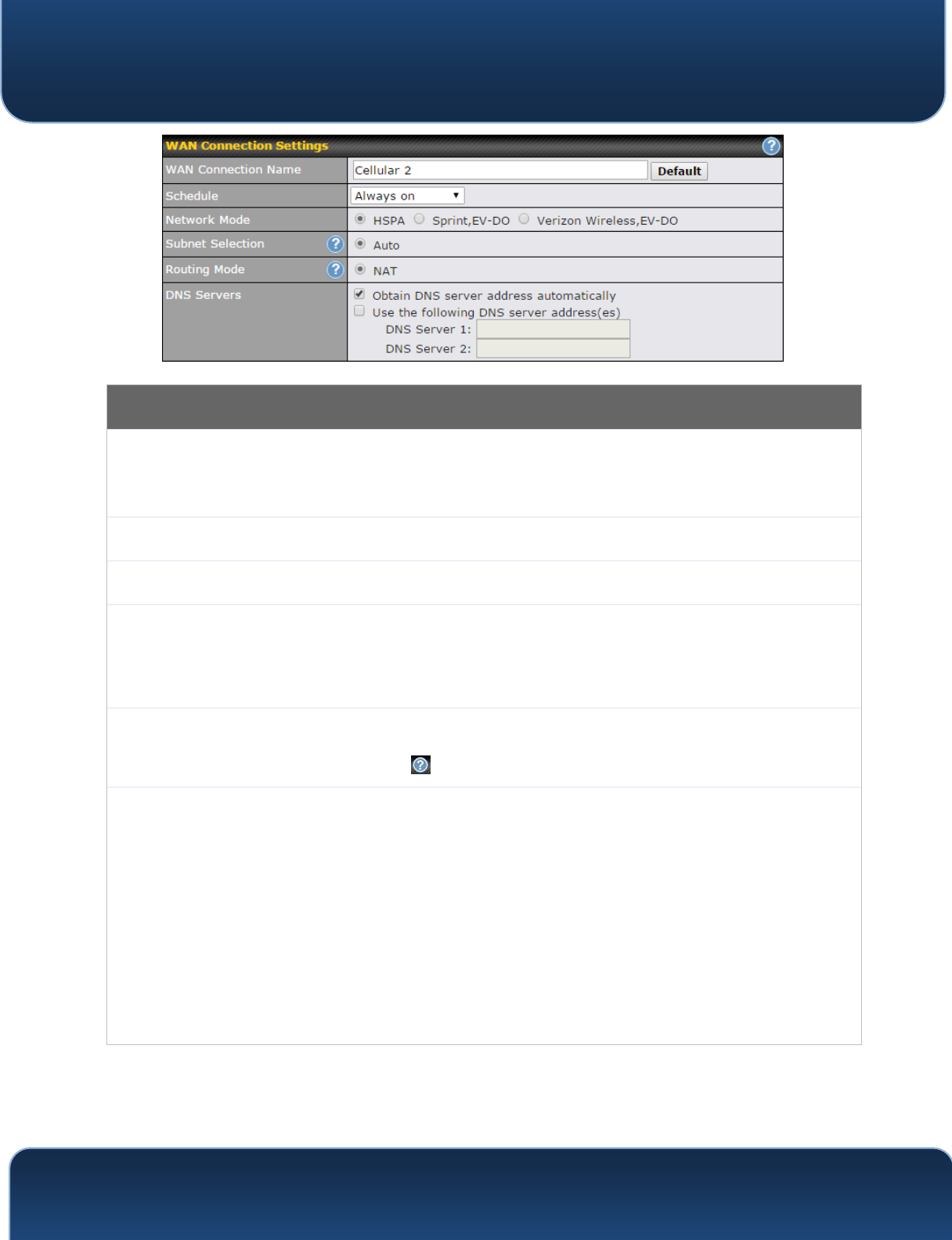
Pepwave MAX and Surf User Manual
http://www.pepwave.com
71
Copyright @ 2018 Pepwave
WAN Connection Settings
WAN
Connection
Name
Enter a name to represent this WAN connection.
Schedule
Click the drop-down menu to apply a time schedule to this interface if needed.
Network Mode
Users have to specify the network they are on accordingly.
Subnet
Selection
Auto: The subnet mask will be set automatically.
Force /31 Subnet: The subnet mask will be set as 255.255.255.254(/31), and the
gateway IP address will be recalculated.
Routing Mode
This option allows you to select the routing method to be used in routing IP frames via
the WAN connection. The mode can be either NAT (network address translation) or IP
Forwarding. Click the button to enable IP forwarding.
DNS Servers
Each ISP may provide a set of DNS servers for DNS lookups. This setting specifies the
DNS (Domain Name System) servers to be used when a DNS lookup is routed through
this
connection.
Selecting Obtain DNS server address automatically results in the DNS servers assigned
by the PPPoE server to be used for outbound DNS lookups over the WAN connection.
(The DNS servers are obtained along with the WAN IP address assigned from the PPPoE
server.)
When Use the following DNS server address(es) is selected, you can enter custom DNS
server addresses for this WAN connection into the DNS server 1 and DNS server 2 fields.
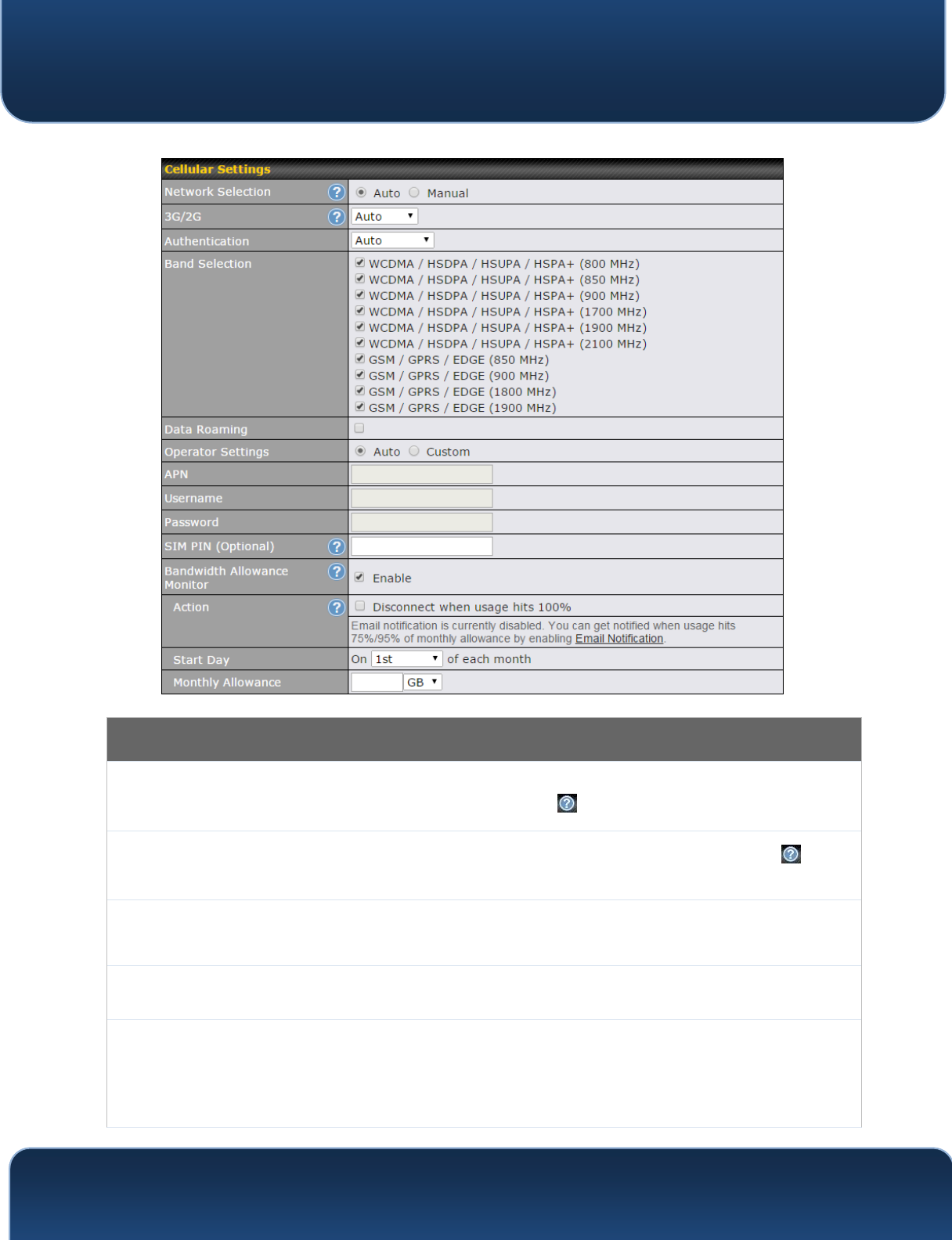
Pepwave MAX and Surf User Manual
http://www.pepwave.com
72
Copyright @ 2018 Pepwave
Cellular Settings
Network
Selection
By default, the MAX router will automatically choose a network to connect to. If you
wish to use only certain networks, click the button beside the menu item.
3G/2G
This drop-down menu allows restricting cellular to particular band. Click the button
to enable the selection of specific bands.
Authentication
Choose from PAP Only or CHAP Only to use those authentication methods exclusively.
Select Auto to automatically choose an authentication method.
Data Roaming
This checkbox enables data roaming on this particular SIM card. Please check your
service provider’s data roaming policy before proceeding.
Operator
Settings
This setting applies to 3G/EDGE/GPRS modems only. It does not apply to EVDO/EVDO
Rev. A modems. This allows you to configure the APN settings of your connection. If
Auto is selected, the mobile operator should be detected automatically. The
connected device will be configured and connection will be made automatically. If
there is any difficulty in making connection, you may select Custom to enter your
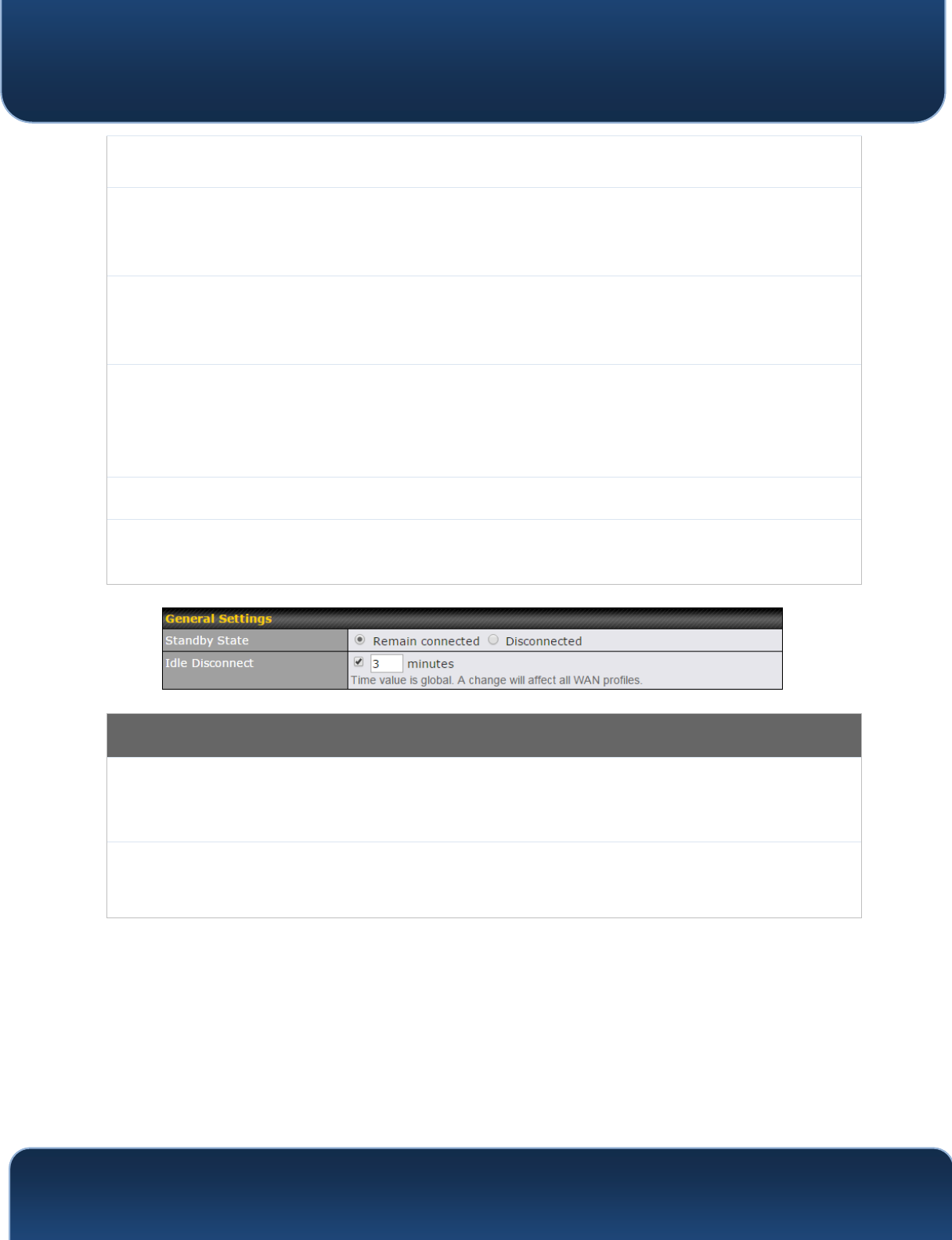
Pepwave MAX and Surf User Manual
http://www.pepwave.com
73
Copyright @ 2018 Pepwave
carrier’s APN, Login, Password, and Dial Number settings manually. The correct values
can be obtained from your carrier. The default and recommended setting is Auto.
APN / Login
/ Password /
SIM PIN
When Auto is selected, the information in these fields will be filled automatically. Select
Custom to customize these parameters. The parameter values are determined by and
can be obtained from the ISP.
Bandwidth
Allowance
Monitor
Check the box Enable to enable bandwidth usage monitoring on this WAN
connection for each billing cycle. When this option is not enabled, bandwidth usage
of each month is still being tracked but no action will be taken.
Action
If email notification is enabled, you will be notified by email when usage hits 75% and
95% of the monthly allowance. If Disconnect when usage hits 100% of monthly
allowance is checked, this WAN connection will be disconnected automatically when
the usage hits the monthly allowance. It will not resume connection unless this option
has been turned off or the usage has been reset when a new billing cycle starts.
Start Day
This option allows you to define which day of the month each billing cycle begins.
Monthly
Allowance
This field is for defining the maximum bandwidth usage allowed for the WAN
connection each month.
General Settings
Standby State
This option allows you to choose whether to remain connected or disconnected when
this WAN connection is no longer in the highest priority and has entered the standby
state. When Remain connected is chosen, bringing up this WAN connection to active
makes it immediately available for use.
Idle
Disconnect
When Internet traffic is not detected within the user-specified timeframe, the modem
will automatically disconnect. Once the traffic is resumed by the LAN host, the
connection will be re-activated.
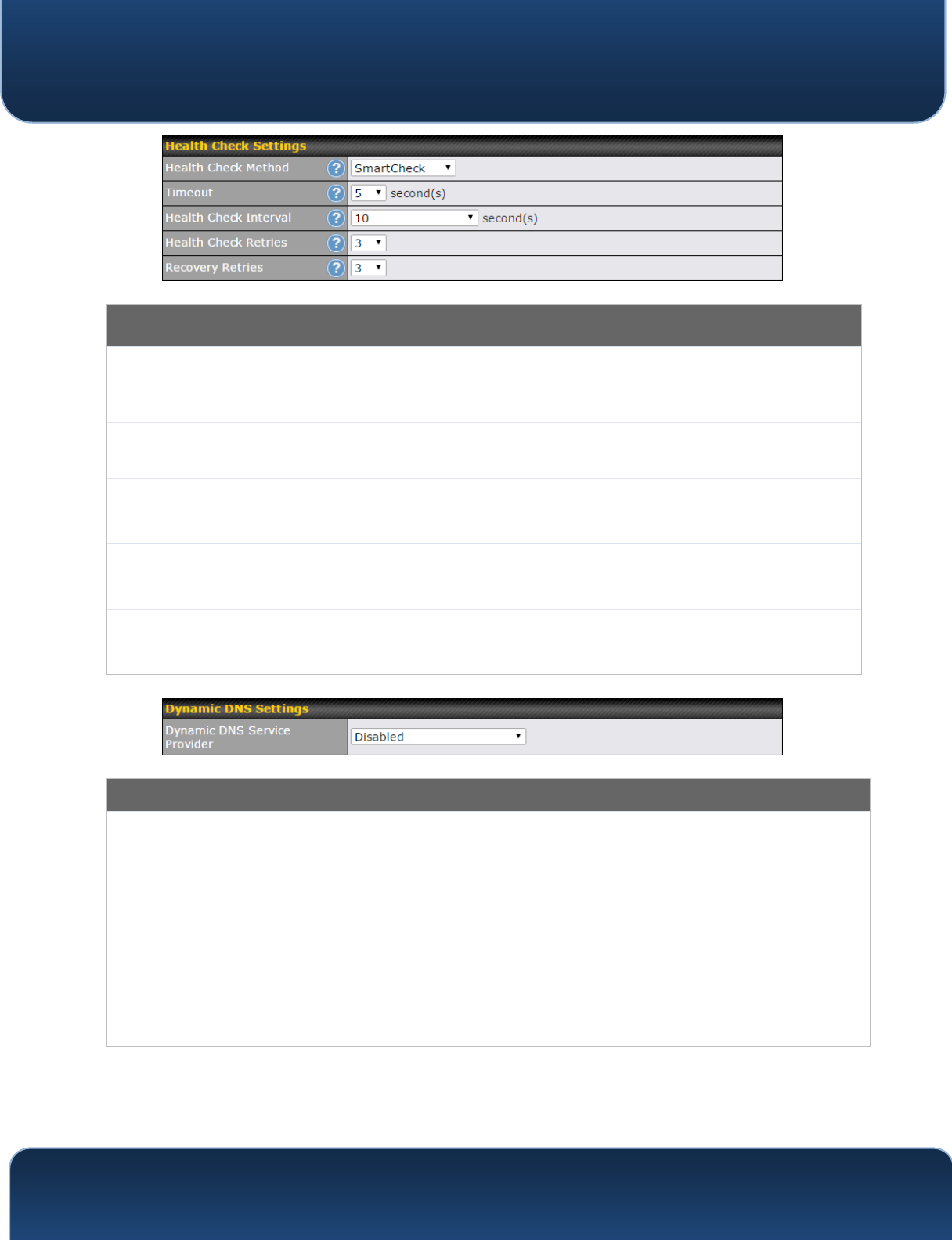
Pepwave MAX and Surf User Manual
http://www.pepwave.com
74
Copyright @ 2018 Pepwave
Health Check Settings
Heath Check
Method
This setting allows you to specify the health check method for the cellular connection.
Available options are Disabled, Ping, DNS Lookup, HTTP, and SmartCheck. The default
method is DNS Lookup. See Section 10.4 for configuration details.
Timeout
If a health check test cannot be completed within the specified amount of time, the
test will be treated as failed.
Health Check
Interval
This is the time interval between each health check test.
Health Check
Retries
This is the number of consecutive check failures before treating a connection as down.
Recovery
Retries
This is the number of responses required after a health check failure before treating a
connection as up again.
Dynamic DNS Settings
Dynamic DNS
Service
Provider
This setting specifies the dynamic DNS service provider to be used for the WAN based on
supported dynamic DNS service providers:
changeip.com
dyndns.org
no-ip.org
tzo.com
DNS-O-Matic
Select Disabled to disable this feature. See Section 9.5 for configuration details.
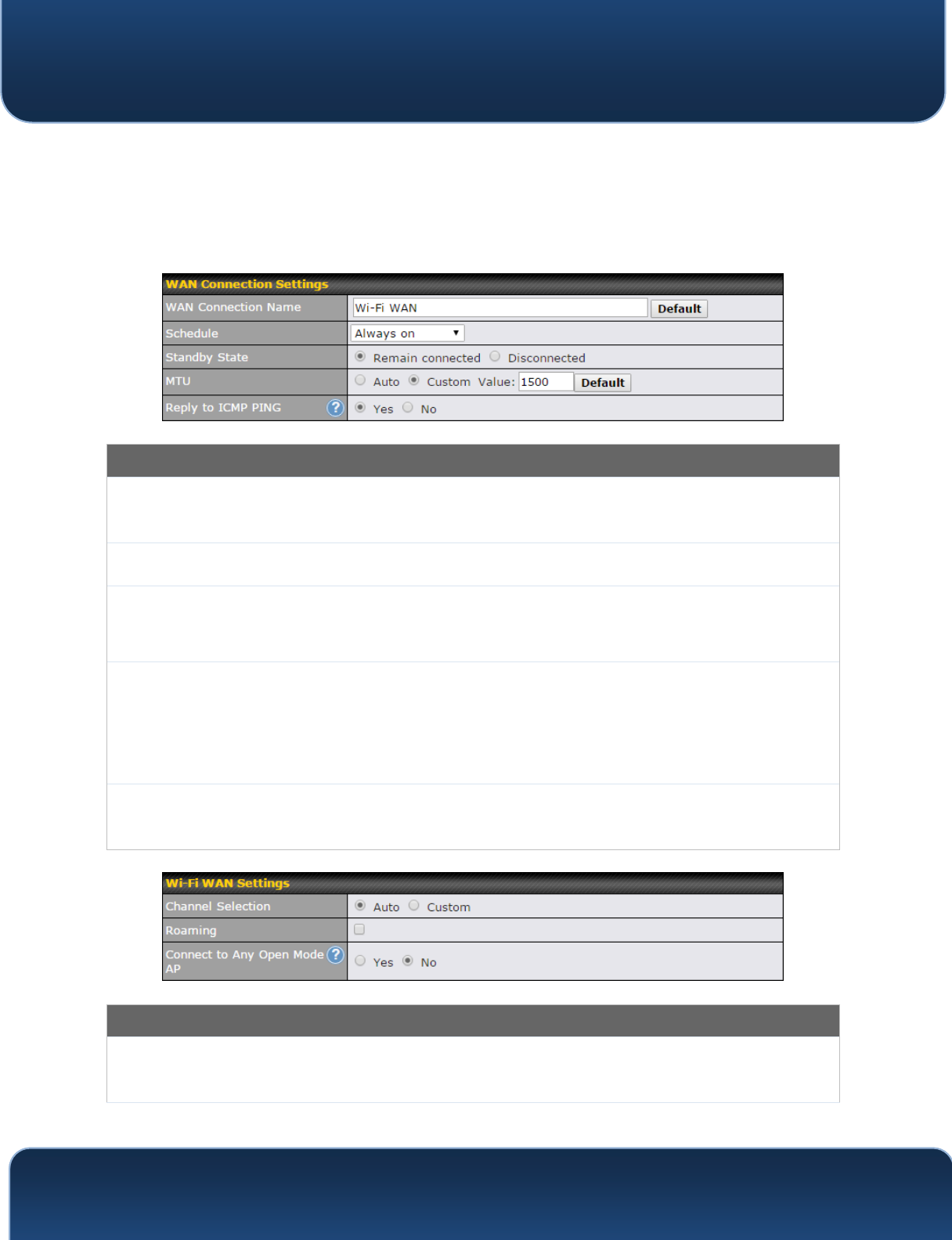
Pepwave MAX and Surf User Manual
http://www.pepwave.com
75
Copyright @ 2018 Pepwave
10.3 Wi-Fi WAN
To access Wi-Fi WAN settings, click Network>WAN>Details.
Wi-Fi Connection Settings
WAN Connection
Name
Enter a name to represent this WAN connection.
Schedule
Click the drop-down menu to apply a time schedule to this interface.
Standby State
This setting specifies the state of the WAN connection while in standby. The
available options are Remain Connected (hot standby) and Disconnect (cold
standby).
MTU
This setting specifies the maximum transmission unit. By default, MTU is set to
Custom 1440. You may adjust the MTU value by editing the text field. Click Default
to restore the default MTU value. Select Auto and the appropriate MTU value will
be automatically detected. The auto-detection will run each time the WAN
connection establishes
Reply to ICMP
PING
If this setting is disabled, the WAN connection will not respond to ICMP ping
requests. By default, this setting is enabled.
Wi-Fi WAN Settings
Channel
Selection
Determine whether the channel will be automatically selected. If you select custom,
the following table will appear:
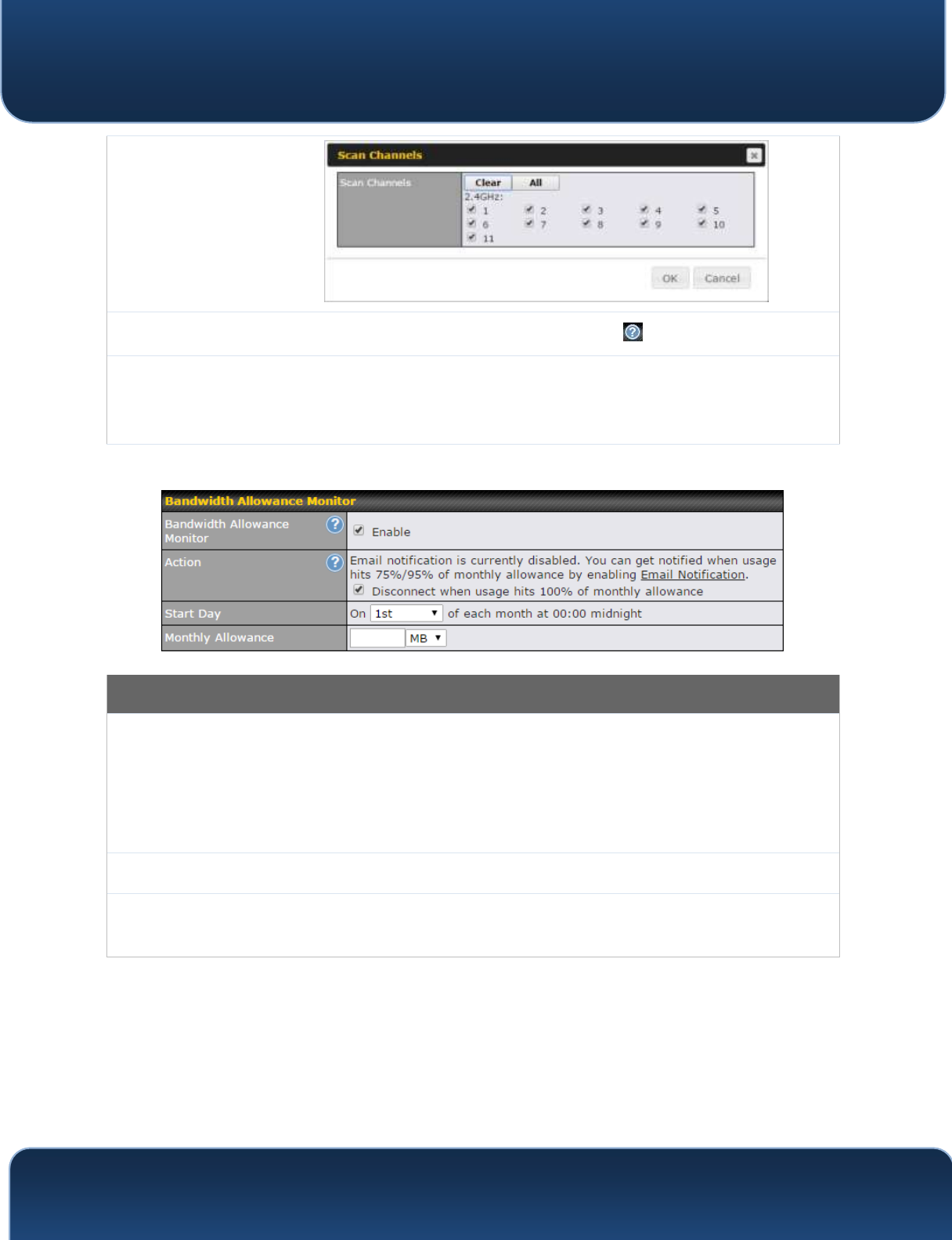
Pepwave MAX and Surf User Manual
http://www.pepwave.com
76
Copyright @ 2018 Pepwave
Roaming
Checking this box will enable Wi-Fi roaming. Click the icon for additional options.
Connect to
Any Open
Mode AP
This option is to specify whether the Wi-Fi WAN will connect to any open mode
access points it finds.
Bandwidth Allowance Monitor
Action
If Error! Reference source not found. is enabled, you will be notified by
mail when usage hits 75% and 95% of the monthly allowance.
If Disconnect when usage hits 100% of monthly allowance is checked, this WAN
connection will be disconnected automatically when the usage hits the monthly
allowance. It will not resume connection unless this option has been turned off or
the usage has been reset when a new billing cycle starts.
Start Day
This option allows you to define which day of the month each billing cycle begins.
Monthly
Allowance
This field is for defining the maximum bandwidth usage allowed for the WAN
connection each month.
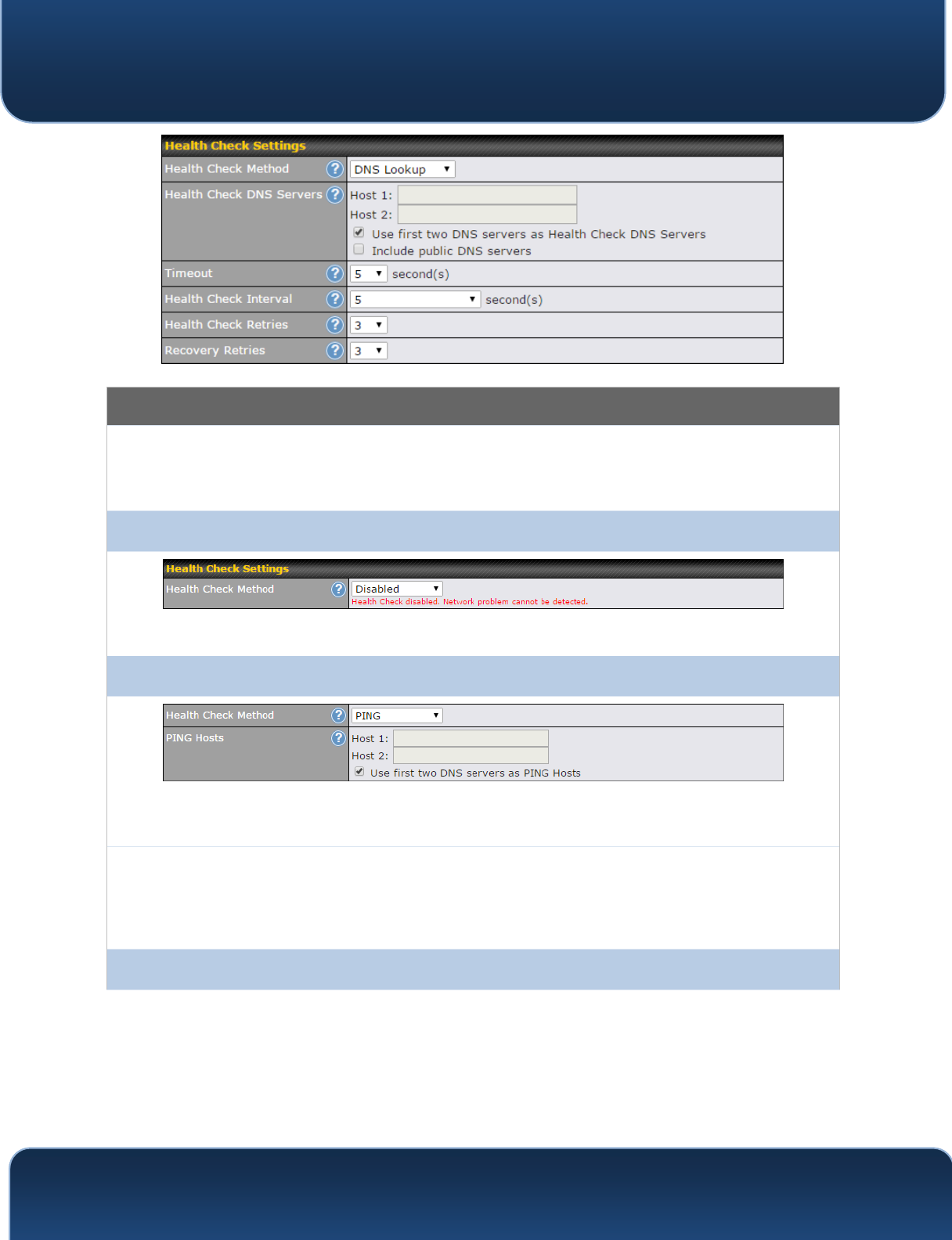
Pepwave MAX and Surf User Manual
http://www.pepwave.com
77
Copyright @ 2018 Pepwave
Health Check Settings
Method
This setting specifies the health check method for the WAN connection. This value
can be configured as Disabled, PING, DNS Lookup, or HTTP. The default method is
DNS Lookup. For mobile Internet connections, the value of Method can be
configured as Disabled or SmartCheck.
Health Check Disabled
When Disabled is chosen in the Method field, the WAN connection will always be considered as up. The
connection will NOT be treated as down in the event of IP routing errors.
Health Check Method: PING
ICMP ping packets will be issued to test the connectivity with a configurable target IP address or
hostname. A WAN connection is considered as up if ping responses are received from either one or both
of the ping hosts.
PING Hosts
This setting specifies IP addresses or hostnames with which connectivity is to be
tested via ICMP ping. If Use first two DNS servers as Ping Hosts is checked, the target
ping host will be the first DNS server for the corresponding WAN connection. Reliable
ping hosts with a high uptime should be considered. By default, the first two DNS
servers of the WAN connection are used as the ping hosts.
Health Check Method: DNS Lookup
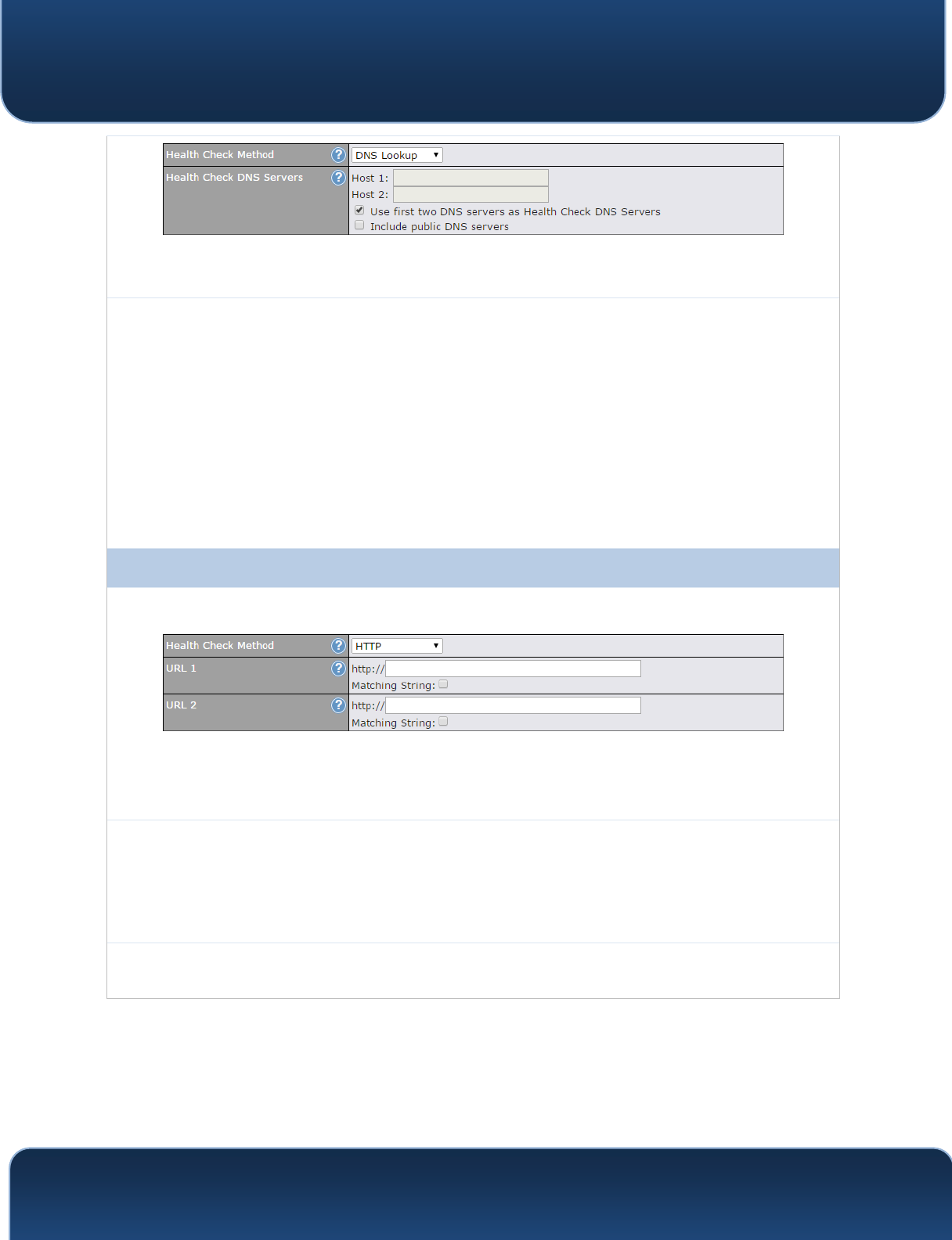
Pepwave MAX and Surf User Manual
http://www.pepwave.com
78
Copyright @ 2018 Pepwave
DNS lookups will be issued to test connectivity with target DNS servers. The connection will be treated as
up if DNS responses are received from one or both of the servers, regardless of whether the result was
positive or negative.
Health Check
DNS Servers
This field allows you to specify two DNS hosts’ IP addresses with which connectivity is
to be tested via DNS Lookup.
If Use first two DNS servers as Health Check DNS Servers is checked, the first two DNS
servers will be the DNS lookup targets for checking a connection's health. If the box
is not checked, Host 1 must be filled, while a value for Host 2 is optional.
If Include public DNS servers is selected and no response is received from all
specified DNS servers, DNS lookups will also be issued to some public DNS servers. A
WAN connection will be treated as down only if there is also no response received
from the public DNS servers.
Connections will be considered as up if DNS responses are received from any one
of the health check DNS servers, regardless of a positive or negative result. By
default, the first two DNS servers of the WAN connection are used as the health
check DNS servers.
Health Check Method: HTTP
HTTP connections will be issued to test connectivity with configurable URLs and strings to match.
URL1
WAN Settings>WAN Edit>Health Check Settings>URL1
The URL will be retrieved when performing an HTTP health check. When String to
Match is left blank, a health check will pass if the HTTP return code is between 200
and 299 (Note: HTTP redirection codes 301 or 302 are treated as failures). When
String to Match is filled, a health check will pass if the HTTP return code is between
200 and 299 and if the HTTP response content contains the string.
URL 2
WAN Settings>WAN Edit>Health Check Settings>URL2
If URL2 is also provided, a health check will pass if either one of the tests passed.
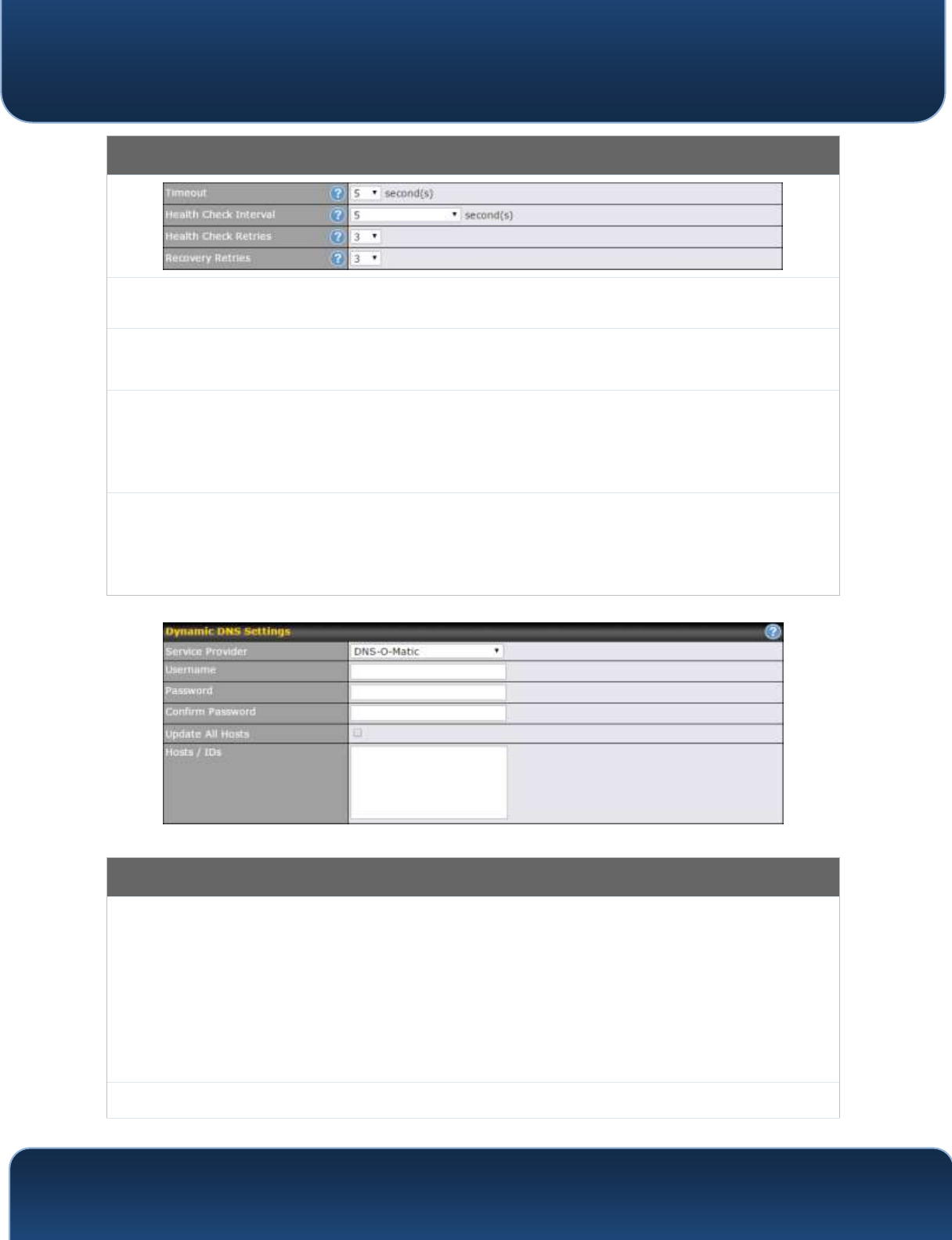
Pepwave MAX and Surf User Manual
http://www.pepwave.com
79
Copyright @ 2018 Pepwave
Other Health Check Settings
Timeout
This setting specifies the timeout in seconds for ping/DNS lookup requests. The
default timeout is 5 seconds.
Health Check
Interval
This setting specifies the time interval in seconds between ping or DNS lookup
requests. The default health check interval is 5 seconds.
Health Check
Retries
This setting specifies the number of consecutive ping/DNS lookup timeouts after
which the Peplink Balance will treat the corresponding WAN connection as down.
Default health retries is set to 3. Using the default Health Retries setting of 3, the
corresponding WAN connection will be treated as down after three consecutive
timeouts.
Recovery
Retries
This setting specifies the number of consecutive successful ping/DNS lookup
responses that must be received before the Peplink Balance treats a previously
down WAN connection as up again. By default, Recover Retries is set to 3. Using the
default setting, a WAN connection that is treated as down will be considered as up
again upon receiving three consecutive successful ping/DNS lookup responses.
Dynamic DNS Settings
Service Provider
This setting specifies the dynamic DNS service provider to be used for the WAN.
Supported providers are:
changeip.com
dyndns.org
no-ip.org
tzo.com
DNS-O-Matic
Select Disabled to disable this feature.
User ID / User /
This setting specifies the registered user name for the dynamic DNS service.
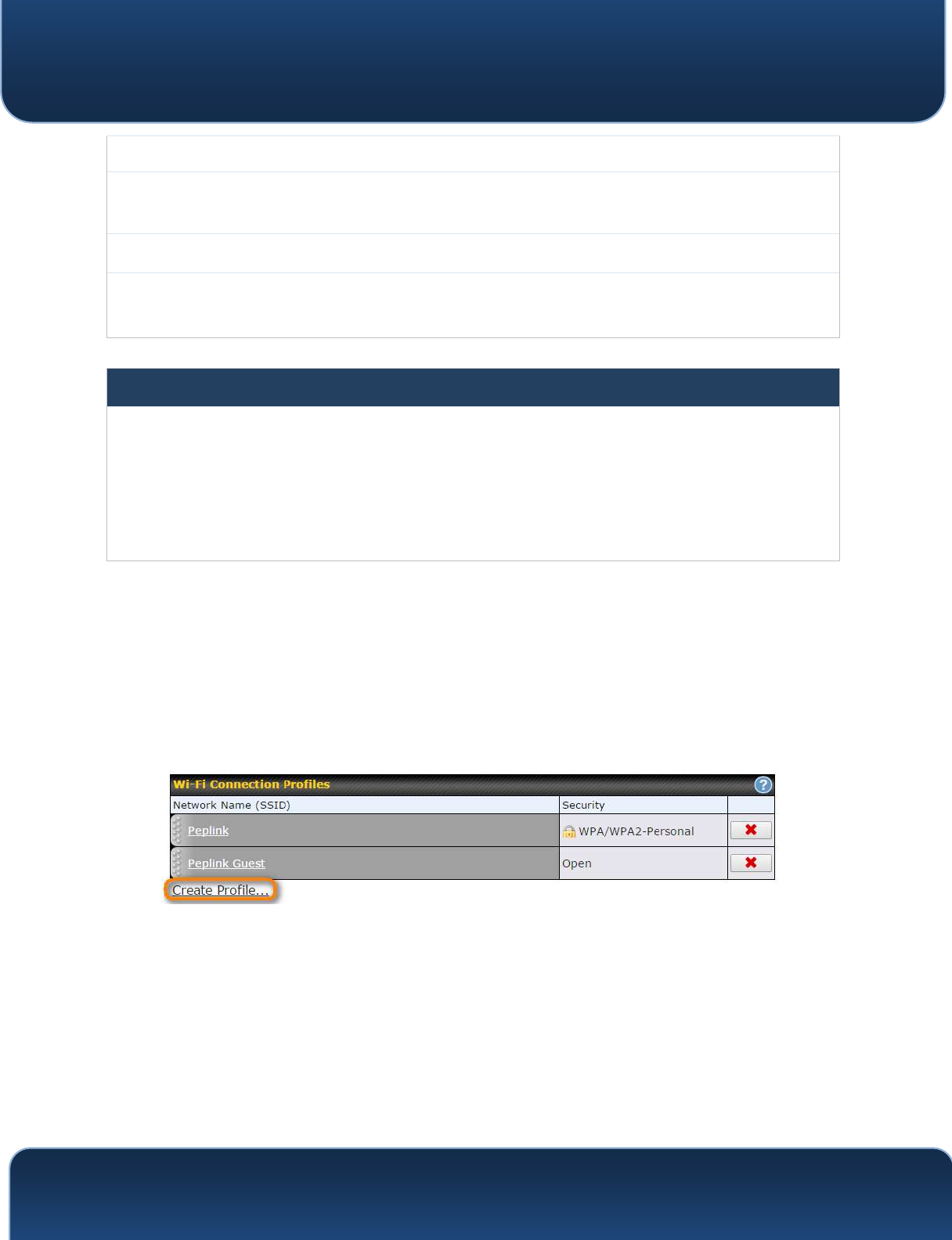
Pepwave MAX and Surf User Manual
http://www.pepwave.com
80
Copyright @ 2018 Pepwave
Email
Password / Pass /
TZO Key
This setting specifies the password for the dynamic DNS service.
Update All Hosts
Check this box to automatically update all hosts.
Hosts / Domain
This setting specifies a list of hostnames or domains to be associated with the
public Internet IP address of the WAN connection.
Important Note
In order to use dynamic DNS services, appropriate hostname registration(s), as well as a valid account
with a supported dynamic DNS service provider, are required.
A dynamic DNS update is performed whenever a WAN’s IP address is changed, such as when an IP is
changed after a DHCP IP refresh or reconnection.
Due to dynamic DNS service providers’ policies, a dynamic DNS host expires automatically when the host
record has not been not updated for a long time. Therefore, the Peplink Balance performs an update
every 23 days, even if a WAN’s IP address did not change.
10.3.1 Creating Wi-Fi Connection Profiles
You can manually create a profile to connect to a Wi-Fi connection. This is useful
for creating a profile for connecting to hidden-SSID access points. Click
Network>WAN>Details>Create Profile… to get started.
This will open a window similar to the one shown below:
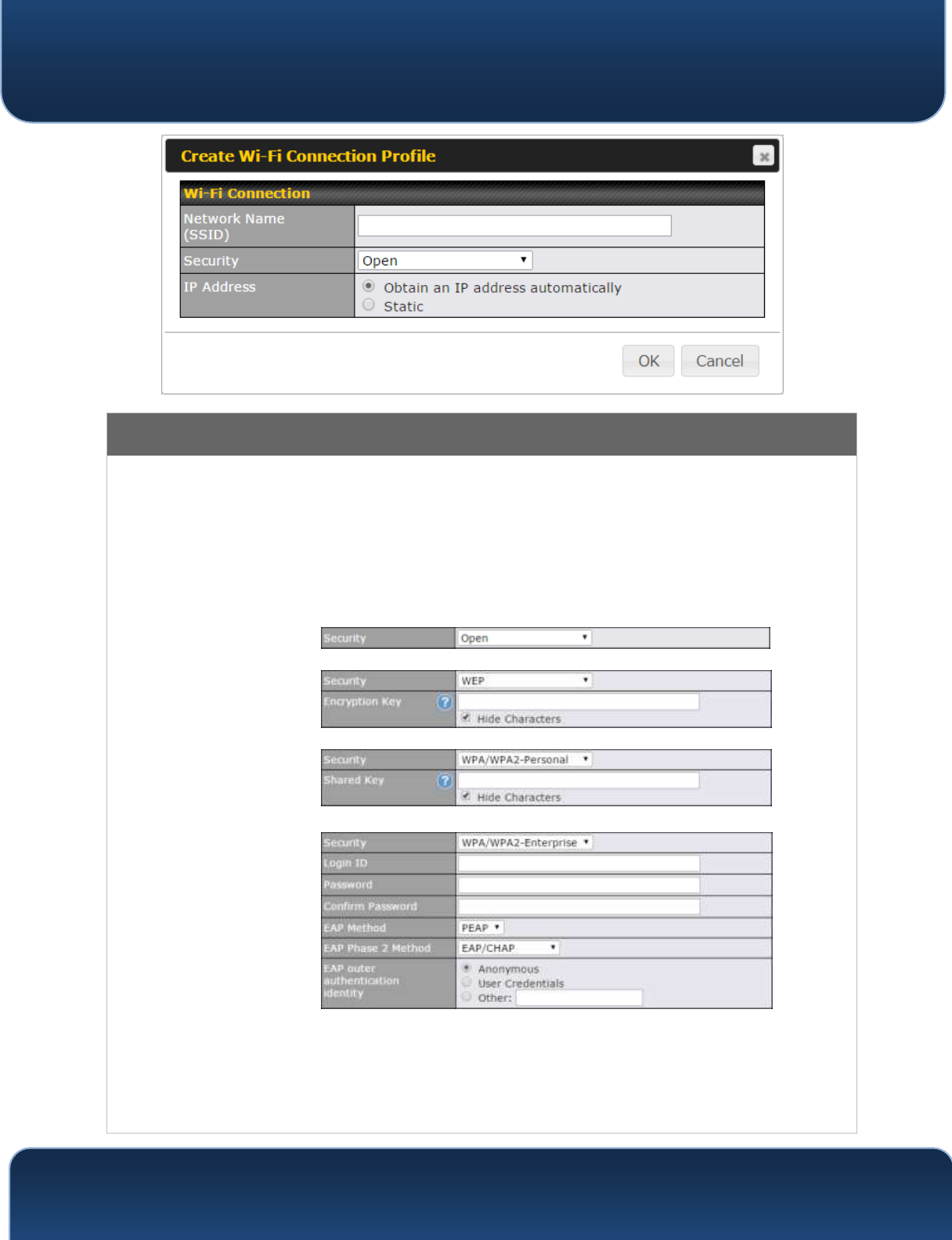
Pepwave MAX and Surf User Manual
http://www.pepwave.com
81
Copyright @ 2018 Pepwave
Wi-Fi Connection Profile Settings
Type
Select whether the network will connect automatically or manually.
Network
Name (SSID)
Enter a name to represent this Wi-Fi connection.
Security
This option allows you to select which security policy is used for this wireless network.
Available options:
Open
WEP
WPA/WPA2 – Personal
WPA/WPA2 – Enterprise
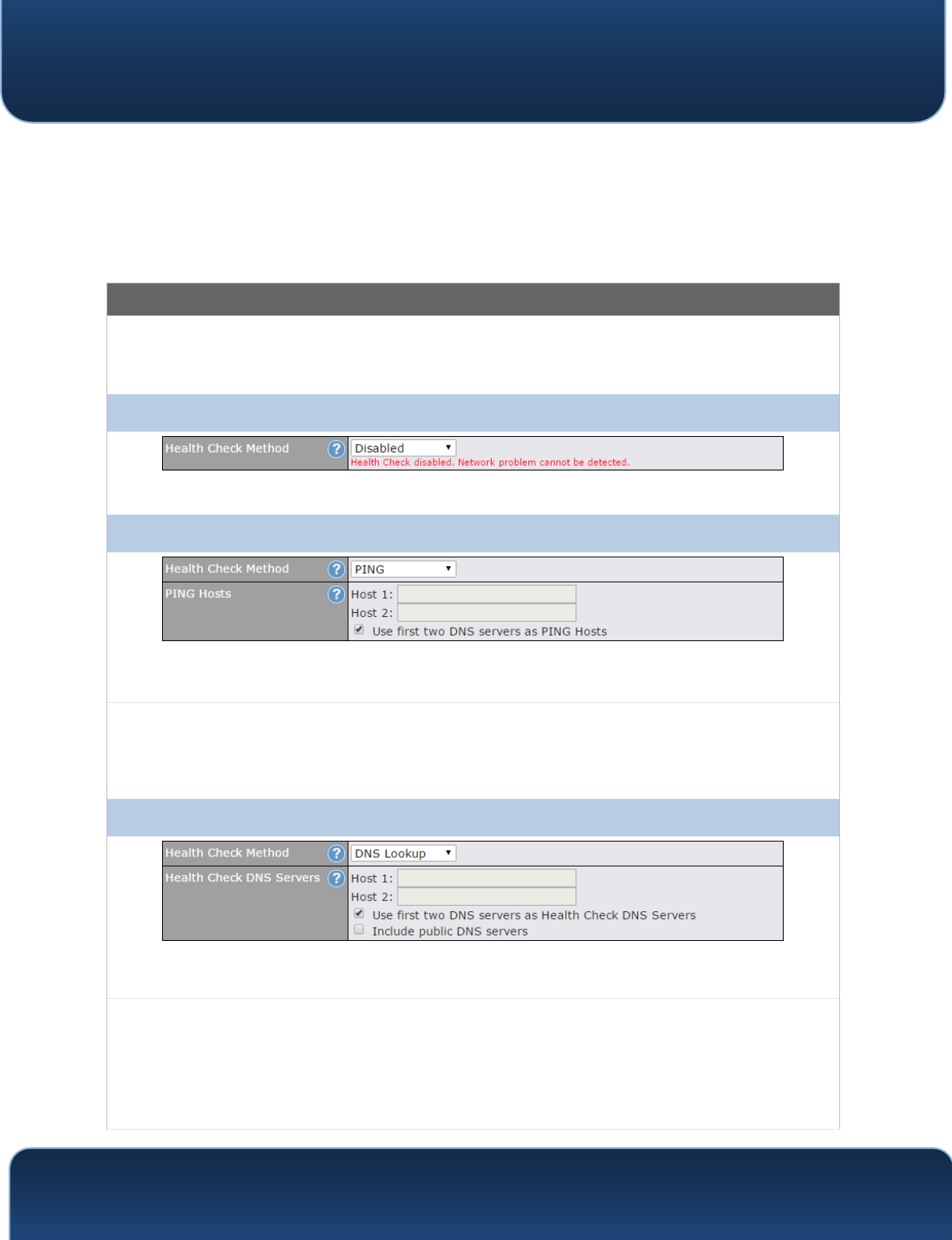
Pepwave MAX and Surf User Manual
http://www.pepwave.com
82
Copyright @ 2018 Pepwave
10.4 WAN Health Check
To ensure traffic is routed to healthy WAN connections only, the Pepwave router
can periodically check the health of each WAN connection. The health check
settings for each WAN connection can be independently configured via
Network>WAN>Details.
Health Check Settings
Method
This setting specifies the health check method for the WAN connection. This value
can be configured as Disabled, PING, DNS Lookup, or HTTP. The default method is
DNS Lookup. For mobile Internet connections, the value of Method can be
configured as Disabled or SmartCheck.
Health Check Disabled
When Disabled is chosen in the Method field, the WAN connection will always be considered as up. The
connection will NOT be treated as down in the event of IP routing errors.
Health Check Method: PING
ICMP ping packets will be issued to test the connectivity with a configurable target IP address or
hostname. A WAN connection is considered as up if ping responses are received from either one or both
of the ping hosts.
PING Hosts
This setting specifies IP addresses or hostnames with which connectivity is to be
tested via ICMP ping. If Use first two DNS servers as Ping Hosts is checked, the target
ping host will be the first DNS server for the corresponding WAN connection. Reliable
ping hosts with a high uptime should be considered. By default, the first two DNS
servers of the WAN connection are used as the ping hosts.
Health Check Method: DNS Lookup
DNS lookups will be issued to test connectivity with target DNS servers. The connection will be treated as
up if DNS responses are received from one or both of the servers, regardless of whether the result was
positive or negative.
Health Check
DNS Servers
This field allows you to specify two DNS hosts’ IP addresses with which connectivity is
to be tested via DNS lookup.
If Use first two DNS servers as Health Check DNS Servers is checked, the first two DNS
servers will be the DNS lookup targets for checking a connection's health. If the box
is not checked, Host 1 must be filled, while a value for Host 2 is optional.
If Include public DNS servers is selected and no response is received from all
specified DNS servers, DNS lookups will also be issued to some public DNS servers. A
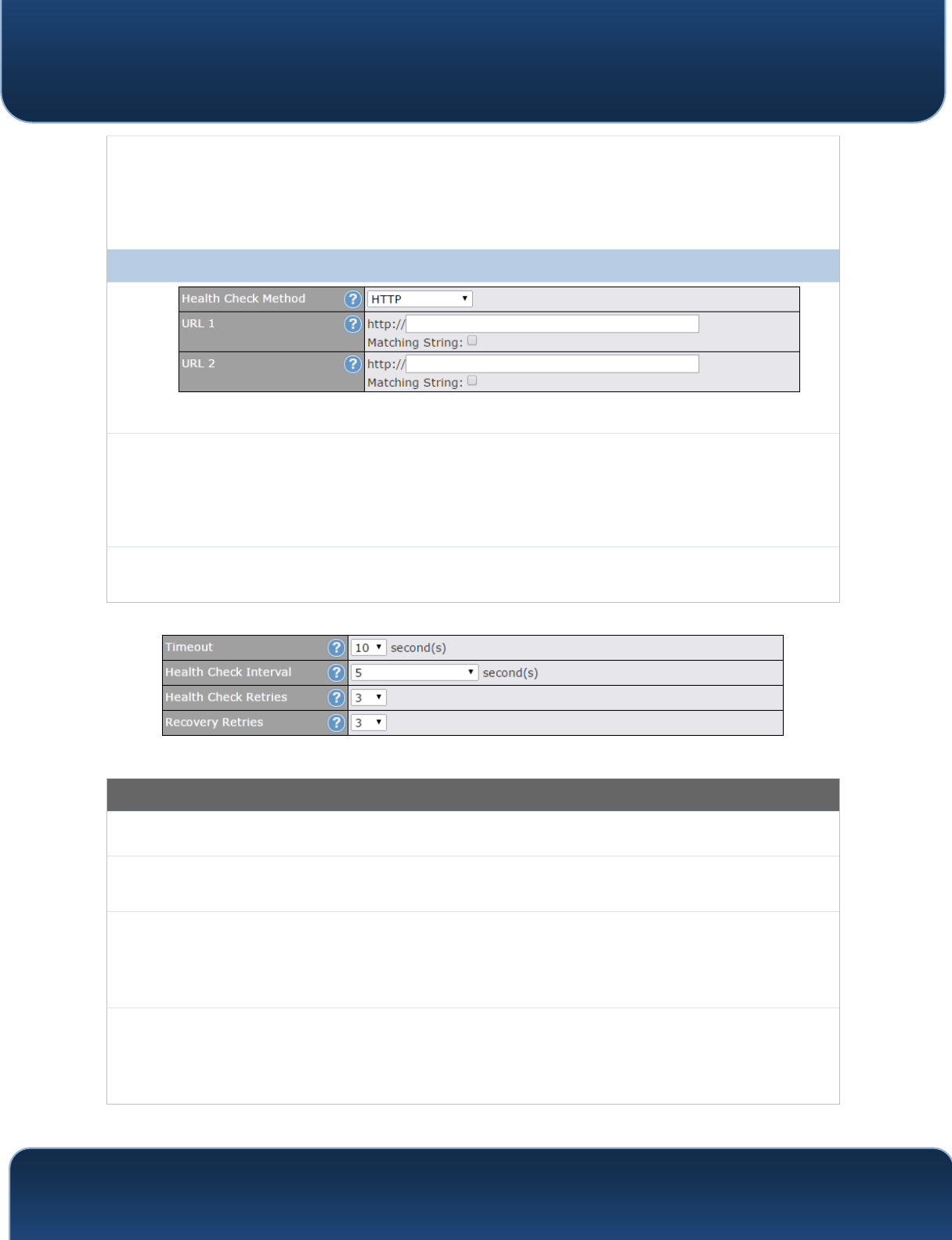
Pepwave MAX and Surf User Manual
http://www.pepwave.com
83
Copyright @ 2018 Pepwave
WAN connection will be treated as down only if there is also no response received
from the public DNS servers.
Connections will be considered as up if DNS responses are received from any one
of the health check DNS servers, regardless of a positive or negative result. By
default, the first two DNS servers of the WAN connection are used as the health
check DNS servers.
Health Check Method: HTTP
HTTP connections will be issued to test connectivity with configurable URLs and strings to match.
URL1
WAN Settings>WAN Edit>Health Check Settings>URL1
The URL will be retrieved when performing an HTTP health check. When String to
Match is left blank, a health check will pass if the HTTP return code is between 200
and 299 (Note: HTTP redirection codes 301 or 302 are treated as failures). When
String to Match is filled, a health check will pass if the HTTP return code is between
200 and 299 and if the HTTP response content contains the string.
URL 2
WAN Settings>WAN Edit>Health Check Settings>URL2
If URL2 is also provided, a health check will pass if either one of the tests passed.
Other Health Check Settings
Timeout
This setting specifies the timeout in seconds for ping/DNS lookup requests. The
default timeout is 5 seconds.
Health Check
Interval
This setting specifies the time interval in seconds between ping or DNS lookup
requests. The default health check interval is 5 seconds.
Health Check
Retries
This setting specifies the number of consecutive ping/DNS lookup timeouts after
which the Pepwave router will treat the corresponding WAN connection as down.
Default health retries is set to 3. Using the default Health Retries setting of 3, the
corresponding WAN connection will be treated as down after three consecutive
timeouts.
Recovery
Retries
This setting specifies the number of consecutive successful ping/DNS lookup
responses that must be received before the Pepwave router treats a previously
down WAN connection as up again. By default, Recover Retries is set to 3. Using the
default setting, a WAN connection that is treated as down will be considered as up
again upon receiving three consecutive successful ping/DNS lookup responses.
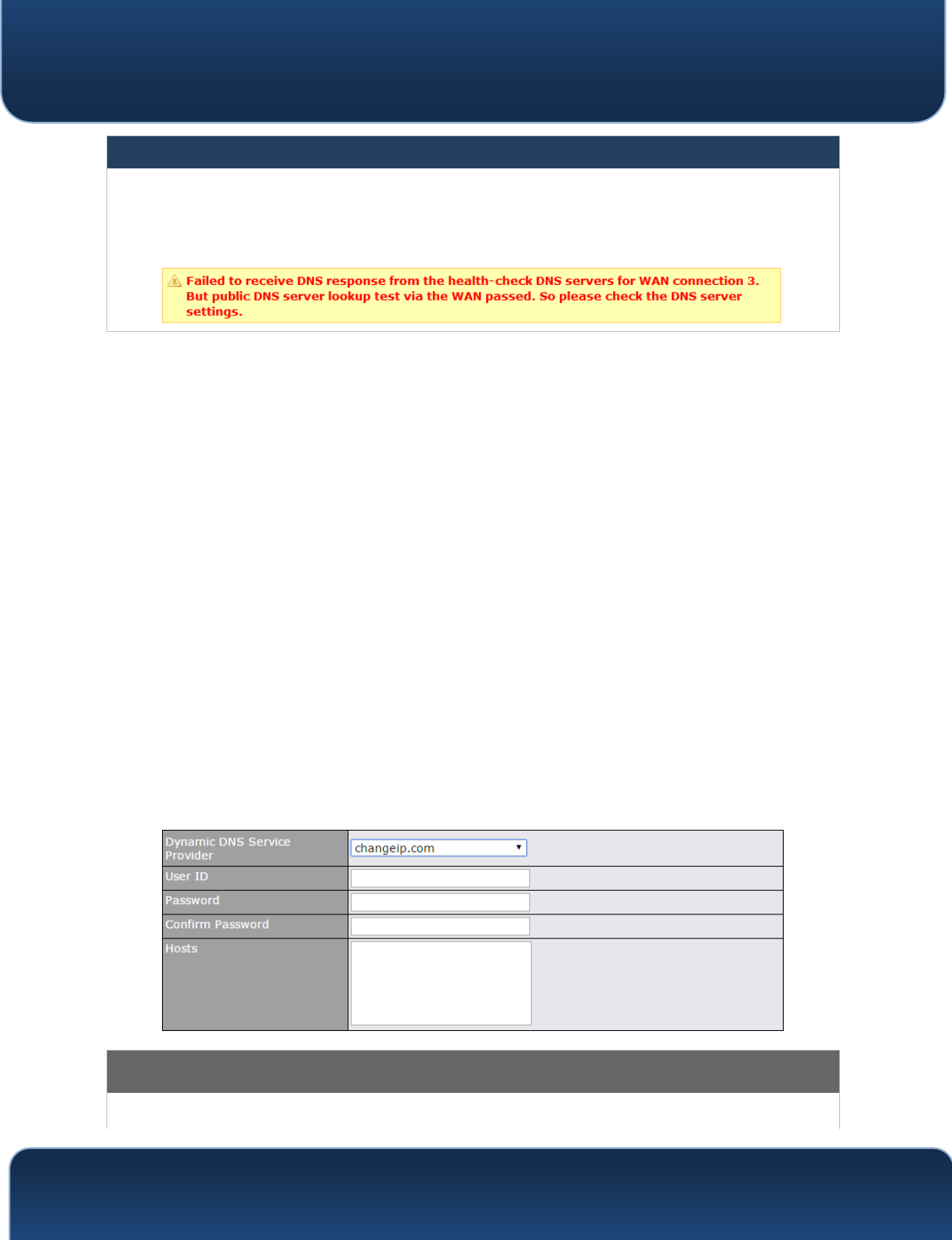
Pepwave MAX and Surf User Manual
http://www.pepwave.com
84
Copyright @ 2018 Pepwave
Automatic Public DNS Server Check on DNS Test Failure
When the health check method is set to DNS Lookup and health checks fail, the Pepwave router will
automatically perform DNS lookups on public DNS servers. If the tests are successful, the WAN may not be
down, but rather the target DNS server malfunctioned. You will see the following warning message on the
main page:
10.5 Dynamic DNS Settings
Pepwave routers are capable of registering the domain name relationships to
dynamic DNS service providers. Through registration with dynamic DNS service
provider(s), the default public Internet IP address of each WAN connection can
be associated with a host name. With dynamic DNS service enabled for a WAN
connection, you can connect to your WAN's IP address from the external, even
if its IP address is dynamic. You must register for an account from the listed
dynamic DNS service providers before enabling this option.
If the WAN connection's IP address is a reserved private IP address (i.e., behind a
NAT router), the public IP of each WAN will be automatically reported to the
DNS service provider.
Either upon a change in IP addresses or every 23 days without link reconnection,
the Pepwave router will connect to the dynamic DNS service provider to
perform an IP address update within the provider’s records.
The settings for dynamic DNS service provider(s) and the association of
hostname(s) are configured via Network>WAN>Details>Dynamic DNS Service
Provider/Dynamic DNS Settings.
Dynamic DNS Settings
Dynamic DNS
This setting specifies the dynamic DNS service provider to be used for the WAN

Pepwave MAX and Surf User Manual
http://www.pepwave.com
85
Copyright @ 2018 Pepwave
based on supported dynamic DNS service providers:
changeip.com
dyndns.org
no-ip.org
tzo.com
DNS-O-Matic
Others…
Support custom Dynamic DNS servers by entering its URL. Works
with any service compatible with DynDNS API.
Select Disabled to disable this feature.
Account Name /
Email Address
This setting specifies the registered user name for the dynamic DNS service.
Password / TZO
Key
This setting specifies the password for the dynamic DNS service.
Hosts / Domain
This field allows you to specify a list of host names or domains to be associated
with the public Internet IP address of the WAN connection. If you need to enter
more than one host, use a carriage return to separate them.
Important Note
In order to use dynamic DNS services, appropriate host name registration(s) and a valid account with a
supported dynamic DNS service provider are required. A dynamic DNS update is performed whenever a
WAN’s IP address changes (e.g., the IP is changed after a DHCP IP refresh, reconnection, etc.). Due to
dynamic DNS service providers’ policy, a dynamic DNS host will automatically expire if the host record
has not been updated for a long time. Therefore the Pepwave router performs an update every 23 days,
even if a WAN’s IP address has not changed.
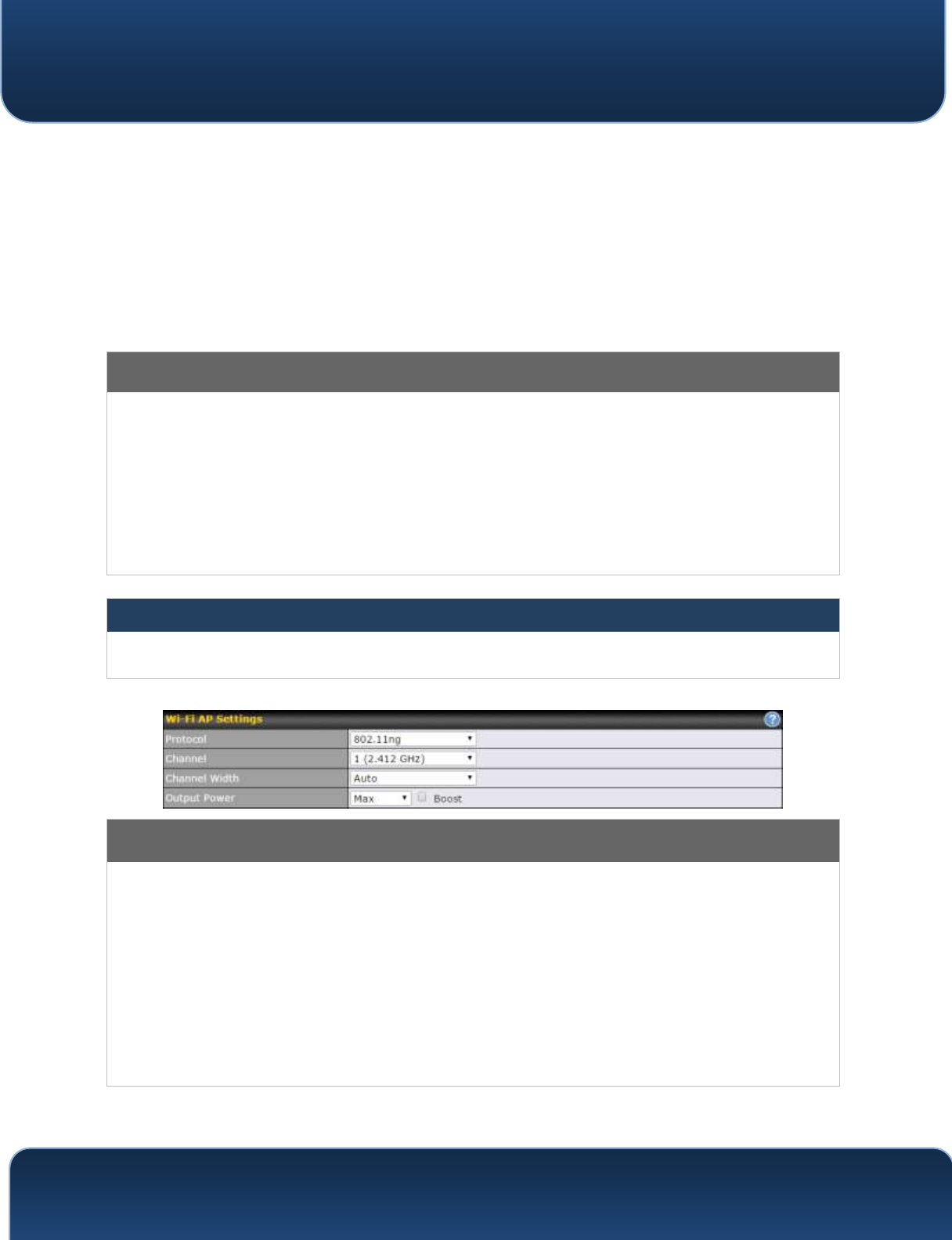
Pepwave MAX and Surf User Manual
http://www.pepwave.com
86
Copyright @ 2018 Pepwave
11 Advanced Wi-Fi Settings
Wi-Fi settings can be configured at Advanced>Wi-Fi Settings (or AP>Settings on
some models). Note that menus displayed can vary by model.
Wi-Fi Radio Settings
Operating
Country
This drop-down menu specifies the national/regional regulations which the Wi-Fi
radio should follow.
If a North American region is selected, RF channels 1 to 11 will be
available and the maximum transmission power will be 26 dBm (400
mW).
If European region is selected, RF channels 1 to 13 will be available. The
maximum transmission power will be 20 dBm (100 mW).
NOTE: Users are required to choose an option suitable to local laws and
regulations.
Important Note
Per FCC regulation, the country selection is not available on all models
marketed in the US. All US models are fixed to US channels only.
Wi-Fi AP Settings
Protocol
This option allows you to specify whether 802.11b and/or 802.11g client
association requests will be accepted. Available options are 802.11ng and
802.11na. By default, 802.11ng is selected.
Channel
This option allows you to select which 802.11 RF channel will be utilized. Channel
1 (2.412 GHz) is selected by default.
Channel Width
Available options are 20 MHz, 40 MHz, and Auto (20/40 MHz) . Default is Auto
(20/40 MHz), which allows both widths to be used simultaneously.
Output Power
This option is for specifying the transmission output power for the Wi-Fi AP. There
are 4 relative power levels available – Max, High, Mid, and Low. The actual
output power will be bound by the regulatory limits of the selected country.
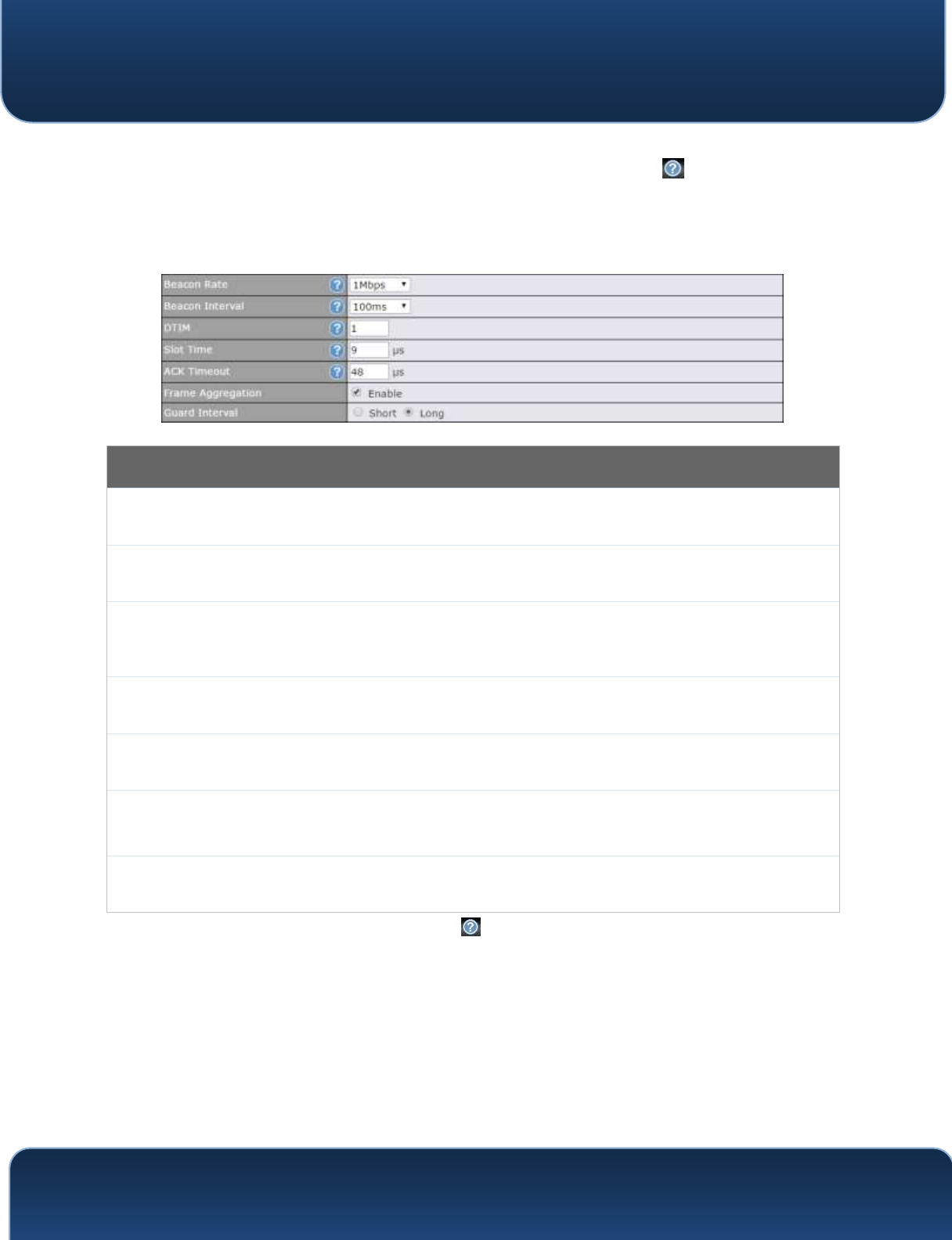
Pepwave MAX and Surf User Manual
http://www.pepwave.com
87
Copyright @ 2018 Pepwave
Advanced Wi-Fi AP settings can be displayed by clicking the on the top right-
hand corner of the Wi-Fi AP Settings section, which can be found at AP>Settings.
Other models will display a separate section called Wi-Fi AP Advanced Settings,
which can be found at Advanced>Wi-Fi Settings.
Wi-Fi AP Advanced Settings
Beacon Rate A
This option is for setting the transmit bit rate for sending a beacon. By default,
1Mbps is selected.
Beacon Interval A
This option is for setting the time interval between each beacon. By default,
100ms is selected.
DTIM A
This field allows you to set the frequency for the beacon to include delivery traffic
indication messages. The interval is measured in milliseconds. The default value is
set to 1 ms.
Slot Time A
This field is for specifying the unit wait time before transmitting a packet. By
default, this field is set to 9 µs.
ACK Timeout A
This field is for setting the wait time to receive an acknowledgement packet
before performing a retransmission. By default, this field is set to 48 µs.
Frame
Aggregation A
This option allows you to enable frame aggregation to increase transmission
throughput.
Guard Interval A
This is where you opt for a short or long guard period interval for your
transmissions.
A - Advanced feature, please click the button on the top right-hand corner to
activate.
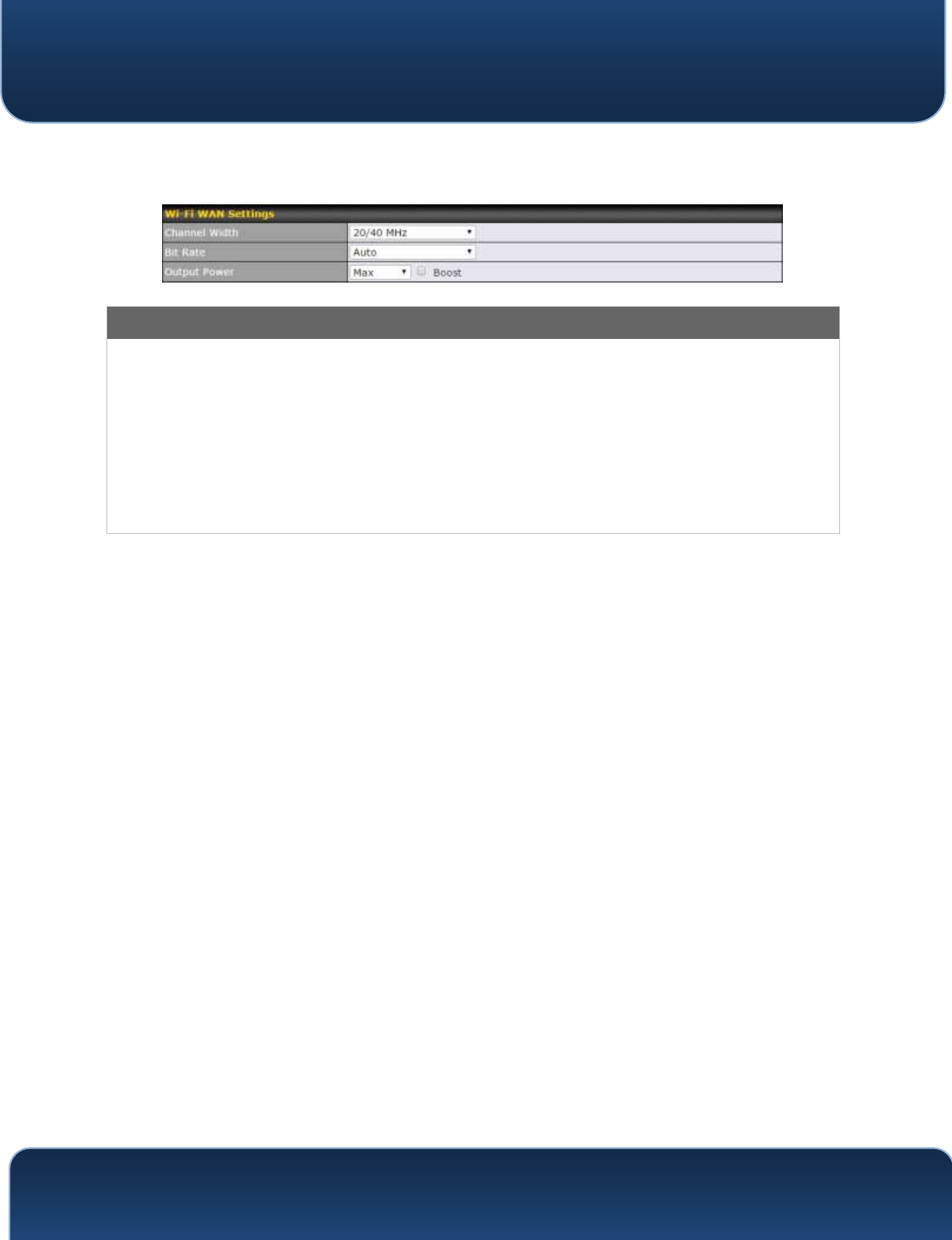
Pepwave MAX and Surf User Manual
http://www.pepwave.com
88
Copyright @ 2018 Pepwave
Wi-Fi WAN settings can be configured at Advanced>Wi-Fi Settings (or
Advanced>Wi-Fi WAN or some models).
Wi-Fi WAN Settings
Channel Width
Available options are 20/40 MHz and 20 MHz. Default is 20/40 MHz, which allows
both widths to be used simultaneously.
Bit Rate
This option allows you to select a specific bit rate for data transfer over the
device’s Wi-Fi network. By default, Auto is selected.
Output Power
This option is for specifying the transmission output power for the Wi-Fi AP. There
are 4 relative power levels available – Max, High, Mid, and Low. The actual
output power will be bound by the regulatory limits of the selected country.
Note that selecting the Boost option may cause the MAX’s radio output to
exceed local regulatory limits.
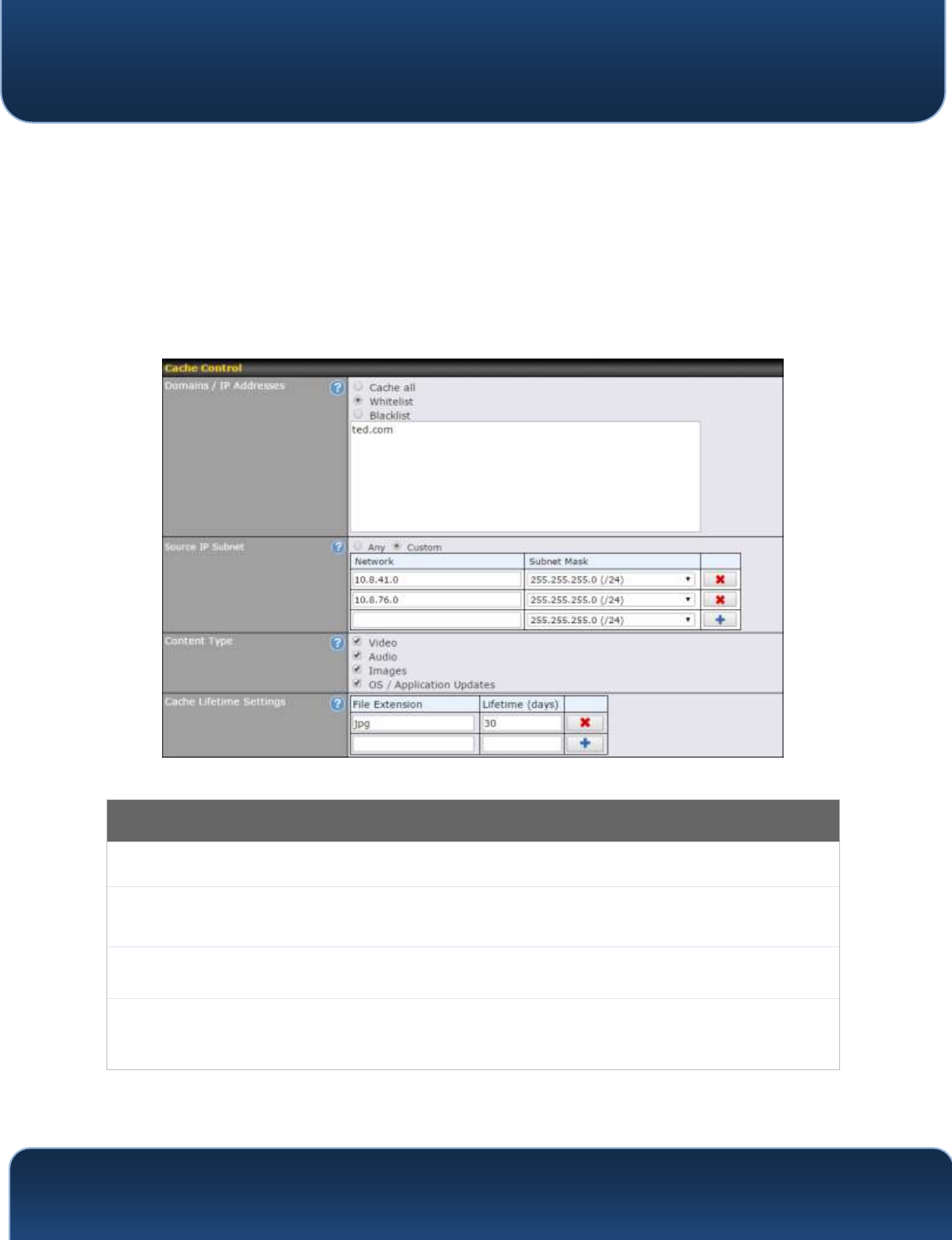
Pepwave MAX and Surf User Manual
http://www.pepwave.com
89
Copyright @ 2018 Pepwave
12 MediaFast Configuration
MediaFast settings can be configured from the Network menu.
12.1 Setting Up MediaFast Content Caching
To access MediaFast content caching settings, select Advanced>Cache
Control.
Cache Control Settings
Domain
Choose to Cache on all domains, or enter domain names and then choose either
Cache the specified domains only or Do not cache the specified domains.
Source IP
Subnet
This setting allows caching to be applied to the user-specified IP subnets. If "Any" is
selected, then caching will apply to all subnets.
Content Type
Check these boxes to cache the listed content types or leave boxes unchecked to
disable caching for the listed types.
Cache Lifetime
Settings
Enter a file extension, such as JPG or DOC. Then enter a lifetime in days to specify
how long files with that extension will be cached. Add or delete entries using the
controls on the right.
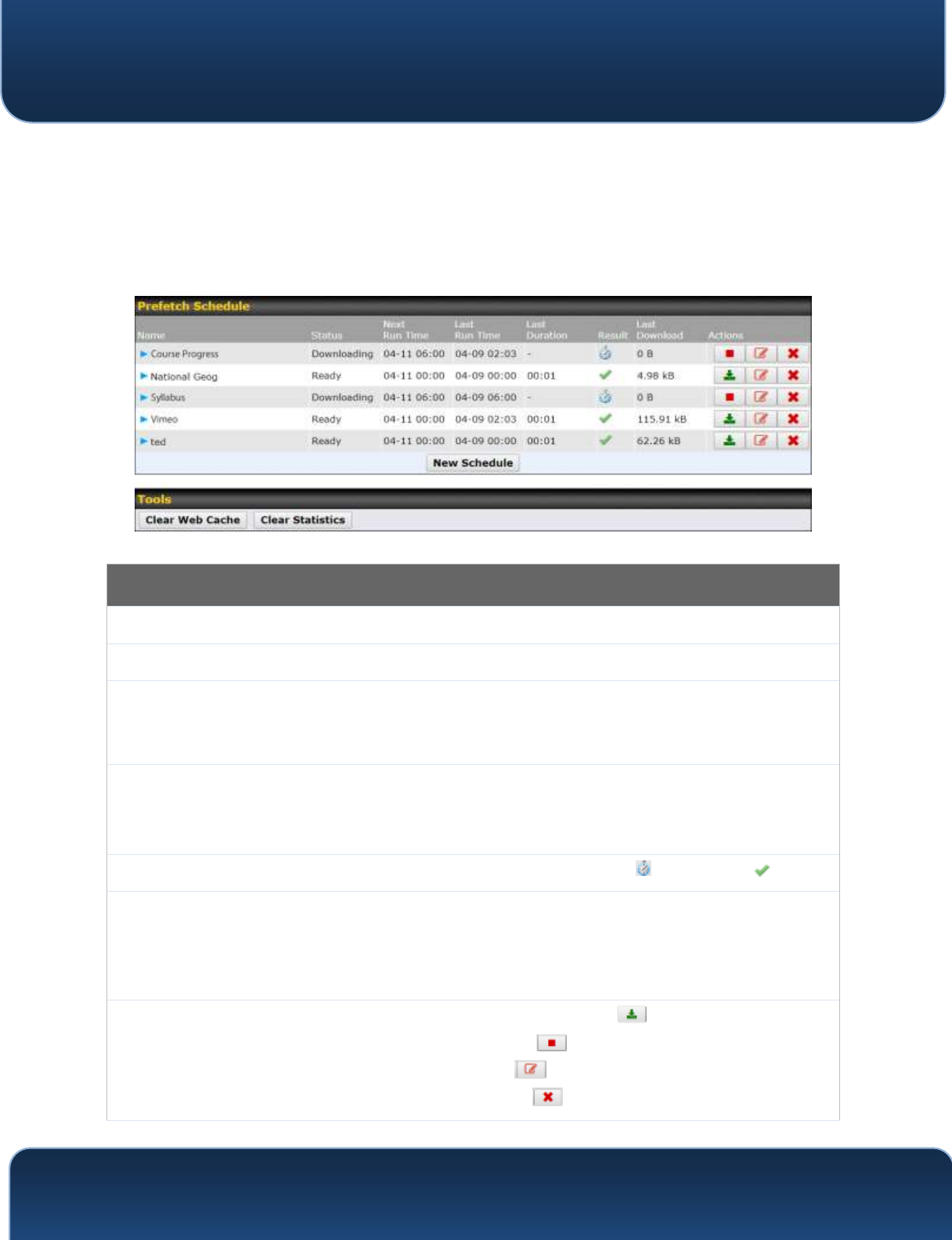
Pepwave MAX and Surf User Manual
http://www.pepwave.com
90
Copyright @ 2018 Pepwave
12.2 Scheduling Content Prefetching
Content prefetching allows you to download content on a schedule that you
define, which can help to preserve network bandwidth during busy times and
keep costs down. To access MediaFast content prefetching settings, select
Advanced >Prefetch Schedule.
Prefetch Schedule Settings
Name
This field displays the name given to the scheduled download.
Status
Check the status of your scheduled download here.
Next Run
Time/Last Run
Time
These fields display the date and time of the next and most recent occurrences of
the scheduled download.
Last Duration
Check this field to ensure that the most recent download took as long as expected
to complete. A value that is too low might indicate an incomplete download or
incorrectly specified download target, while a value that is too long could mean a
download with an incorrectly specified target or stop time.
Result
This field indicates whether downloads are in progress ( ) or complete ( ).
Last Download
Check this field to ensure that the most recent download file size is within the
expected range. A value that is too low might indicate an incomplete download or
incorrectly specified download target, while a value that is too long could mean a
download with an incorrectly specified target or stop time. This field is also useful for
quickly seeing which downloads are consuming the most storage space.
Actions
To begin a scheduled download immediately, click .
To cancel a scheduled download, click .
To edit a scheduled download, click .
To delete a scheduled download, click .
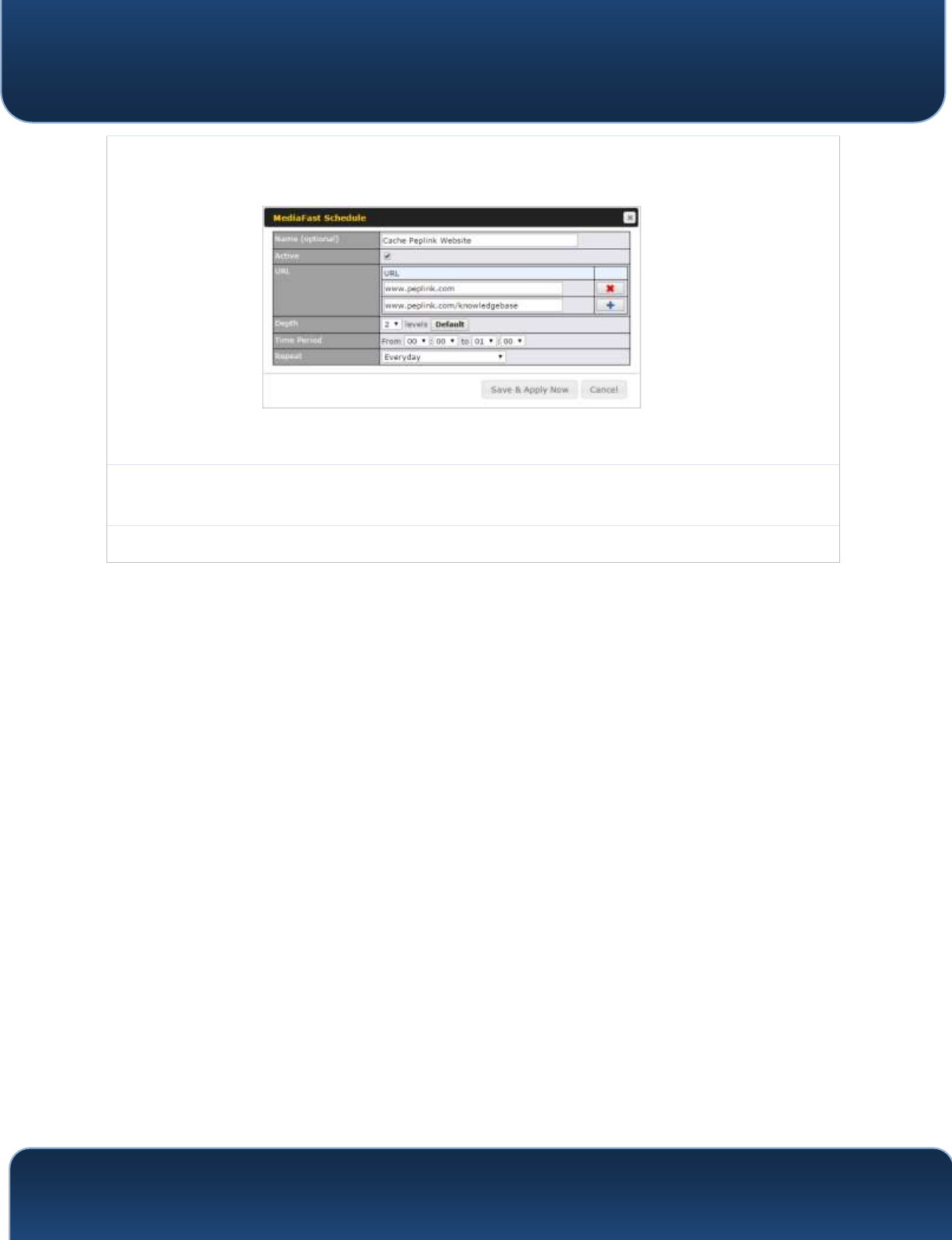
Pepwave MAX and Surf User Manual
http://www.pepwave.com
91
Copyright @ 2018 Pepwave
New Schedule
Click to begin creating a new scheduled download. Clicking the button will cause
the following screen to appear:
Simply provide the requested information to create your schedule.
Clear Web
Cache
To clear all cached content, click this button. Note that this action cannot be
undone.
Clear Statistics
To clear all prefetch and status page statistics, click this button.

Pepwave MAX and Surf User Manual
http://www.pepwave.com
93
Copyright @ 2018 Pepwave
13 Bandwidth Bonding SpeedFusionTM / PepVPN
Pepwave bandwidth bonding SpeedFusionTM is our patented technology that
enables our SD-WAN routers to bond multiple Internet connections to increase
site-to-site bandwidth and reliability. SpeedFusion functionality securely connects
your Pepwave router to another Pepwave or Peplink device (Peplink Balance
210/310/380/580/710/1350 only). Data, voice, or video communications between
these locations are kept confidential across the public Internet.
Bandwidth bonding SpeedFusionTM is specifically designed for multi-WAN
environments. In case of failures and network congestion at one or more WANs,
other WANs can be used to continue carrying the network traffic.
Different models of our SD-WAN routers have different numbers of site-to-site
connections allowed. End-users who need to have more site-to-site connections
can purchase a SpeedFusion license to increase the number of site-to-site
connections allowed.
Pepwave routers can aggregate all WAN connections’ bandwidth for routing
SpeedFusionTM traffic. Unless all the WAN connections of one site are down,
Pepwave routers can keep the VPN up and running.
VPN bandwidth bonding is supported in Firmware 5.1 or above. All available
bandwidth will be utilized to establish the VPN tunnel, and all traffic will be load
balanced at packet level across all links. VPN bandwidth bonding is enabled by
default.
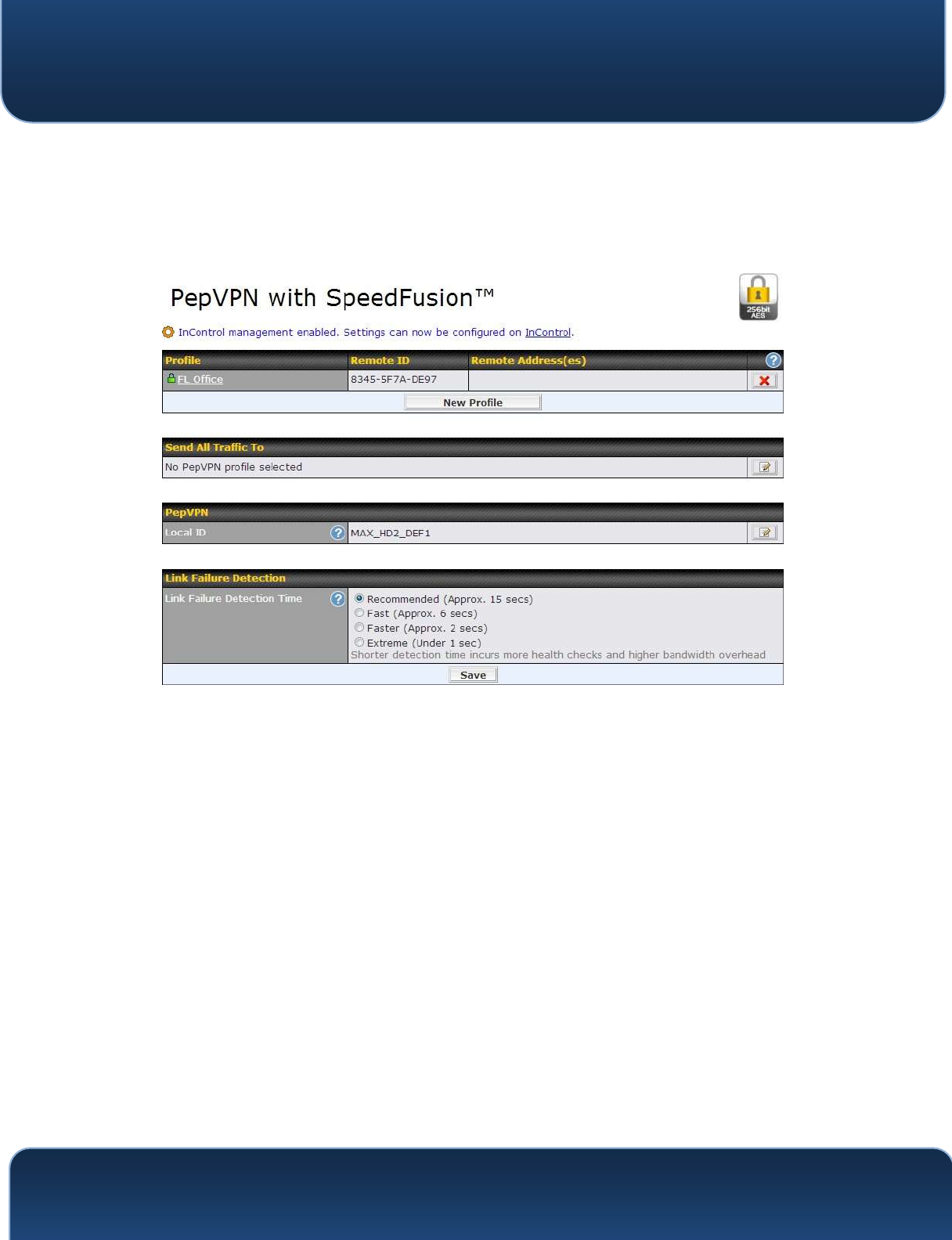
Pepwave MAX and Surf User Manual
http://www.pepwave.com
94
Copyright @ 2018 Pepwave
13.1 PepVPN
To configure PepVPN and SpeedFusion, navigate to Advanced>SpeedFusion™
or Advanced>PepVPN.
The local LAN subnet and subnets behind the LAN (defined under Static
Route on the LAN settings page) will be advertised to the VPN. All VPN members
(branch offices and headquarters) will be able to route to local subnets.
Note that all LAN subnets and the subnets behind them must be unique.
Otherwise, VPN members will not be able to access each other.
All data can be routed over the VPN using the 256-bit AES encryption standard.
To configure, navigate to Advanced>SpeedFusion™ or Advanced>PepVPN and
click the New Profile button to create a new VPN profile (you may have to first
save the displayed default profile in order to acesss the New Profile button).
Each profile specifies the settings for making VPN connection with one remote
Pepwave or Peplink device. Note that available settings vary by model.
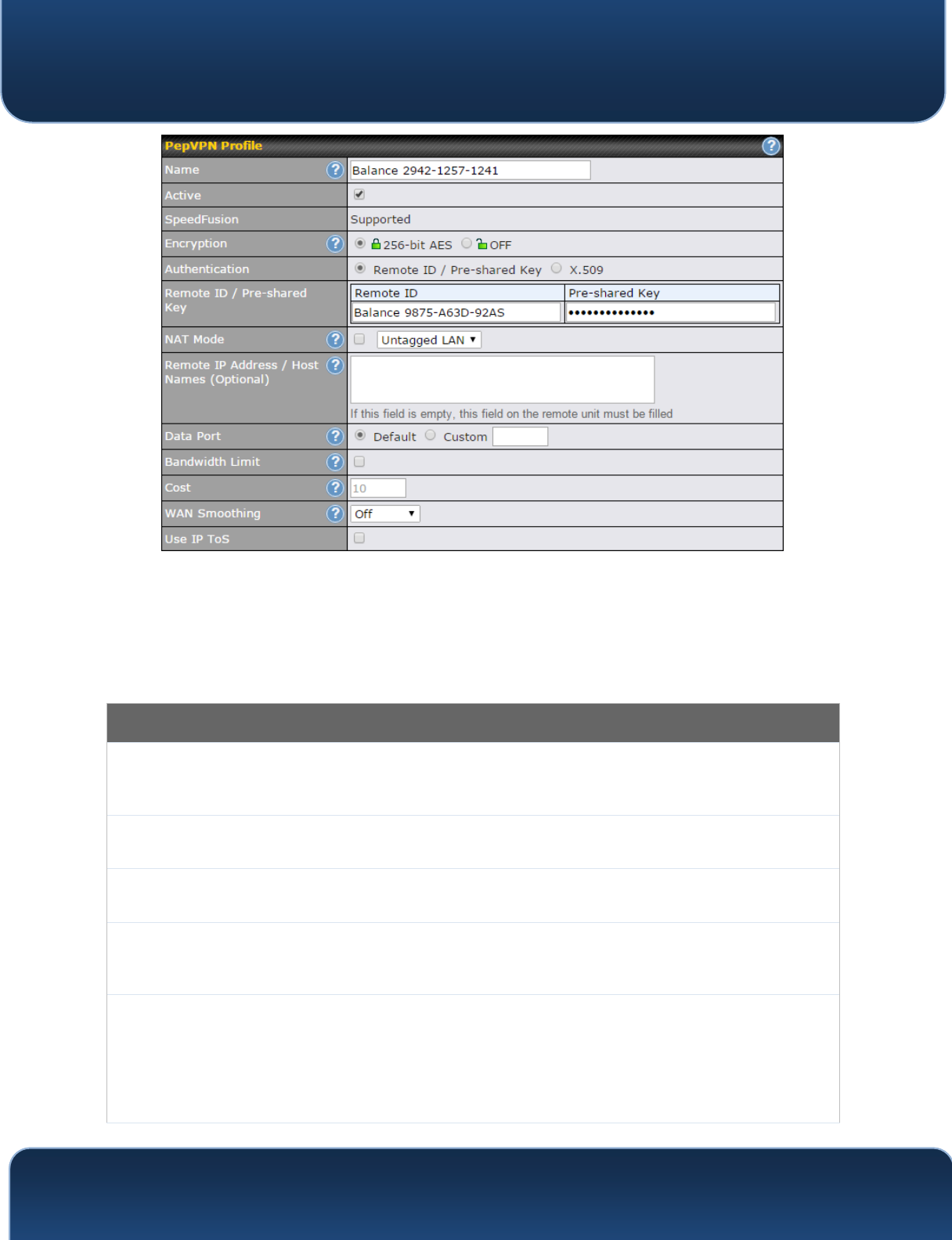
Pepwave MAX and Surf User Manual
http://www.pepwave.com
95
Copyright @ 2018 Pepwave
A list of defined SpeedFusion connection profiles and a Link Failure Detection
Time option will be shown. Click the New Profile button to create a new VPN
connection profile for making a VPN connection to a remote Peplink Balance
via the available WAN connections. Each profile is for making a VPN connection
with one remote Peplink Balance.
PepVPN Profile Settings
Name
This field is for specifying a name to represent this profile. The name can be any
combination of alphanumeric characters (0-9, A-Z, a-z), underscores (_), dashes (-),
and/or non-leading/trailing spaces ( ).
Active
When this box is checked, this VPN connection profile will be enabled. Otherwise, it
will be disabled.
Encryption
By default, VPN traffic is encrypted with 256-bit AES. If Off is selected on both sides
of a VPN connection, no encryption will be applied.
Authentication
Select from By Remote ID Only, Preshared Key, or X.509 to specify the method the
Peplink Balance will use to authenticate peers. When selecting By Remote ID Only,
be sure to enter a unique peer ID number in the Remote ID field.
Remote ID /
Pre-shared Key
This optional field becomes available when Remote ID / Pre-shared Key is selected
as the Peplink Balance’s VPN Authentication method, as explained above. Pre-
shared Key defines the pre-shared key used for this particular VPN connection. The
VPN connection's session key will be further protected by the pre-shared key. The
connection will be up only if the pre-shared keys on each side match. When the
peer is running firmware 5.0+, this setting will be ignored.
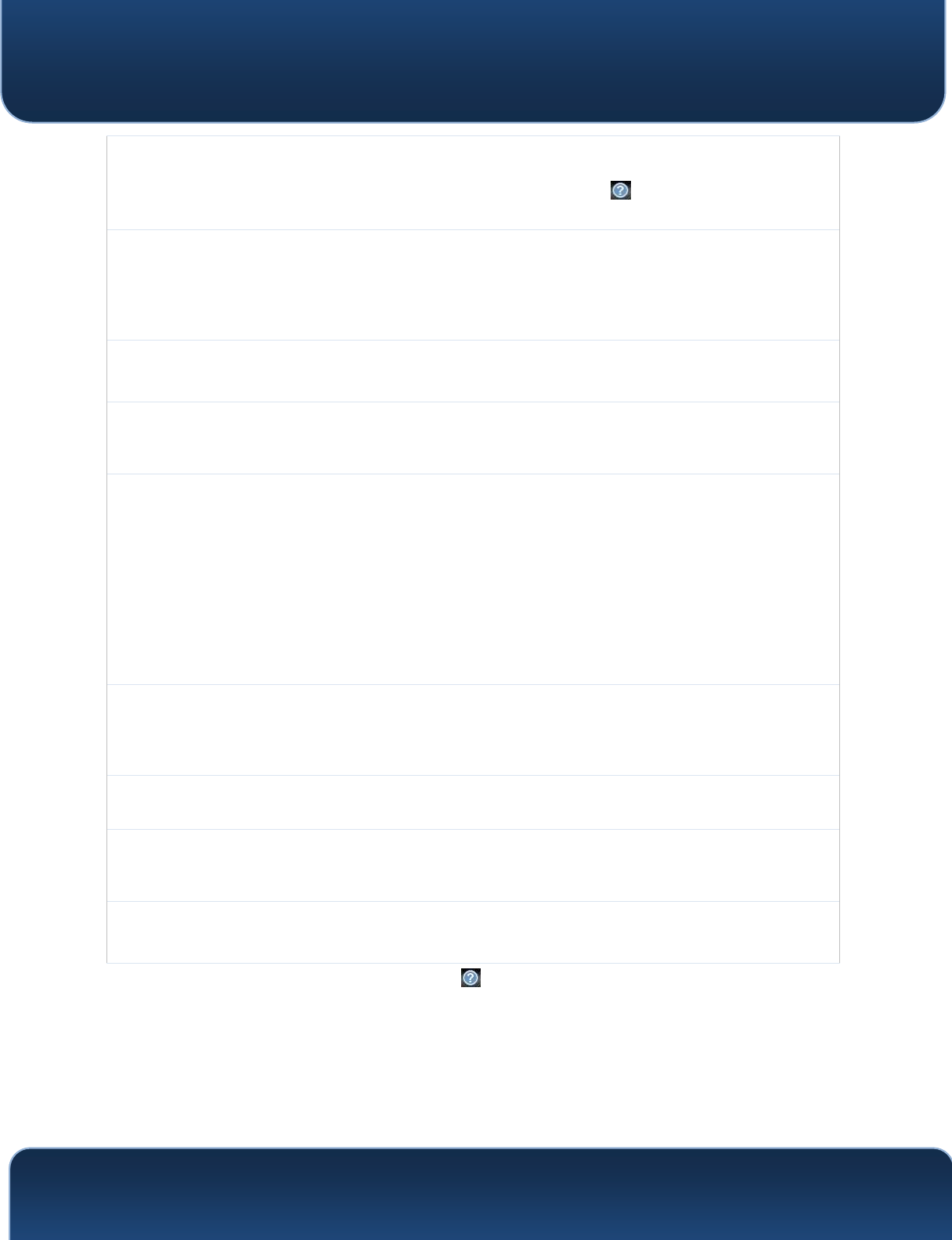
Pepwave MAX and Surf User Manual
http://www.pepwave.com
96
Copyright @ 2018 Pepwave
Enter Remote IDs either by typing out each Remote ID and Pre-shared Key, or by
pasting a CSV. If you wish to paste a CSV, click the icon next to the “Remote ID /
Preshared Key” setting.
Remote
ID/Remote
Certificate
These optional fields become available when X.509 is selected as the Peplink
Balance’s VPN authentication method, as explained above. To authenticate VPN
connections using X.509 certificates, copy and paste certificate details into these
fields. To get more information on a listed X.509 certificate, click the Show Details
link below the field.
Allow Shared
Remote ID
When this option is enabled, the router will allow multiple peers to run using the
same remote ID.
NAT Mode
Check this box to allow the local DHCP server to assign an IP address to the remote
peer. When NAT Mode is enabled, all remote traffic over the VPN will be tagged
with the assigned IP address using network address translation.
Remote IP
Address / Host
Names
(Optional)
If NAT Mode is not enabled, you can enter a remote peer’s WAN IP address or
hostname(s) here. If the remote uses more than one address, enter only one of
them here. Multiple hostnames are allowed and can be separated by a space
character or carriage return. Dynamic-DNS host names are also accepted.
This field is optional. With this field filled, the Peplink Balance will initiate connection
to each of the remote IP addresses until it succeeds in making a connection. If the
field is empty, the Peplink Balance will wait for connection from the remote peer.
Therefore, at least one of the two VPN peers must specify this value. Otherwise, VPN
connections cannot be established.
Data Port
This field is used to specify a UDP port number for transporting outgoing VPN data. If
Default is selected, UDP port 4500 will be used. Port 32015 will be used if the remote
unit uses Firmware prior to version 5.4 or if port 4500 is unavailable. If Custom is
selected, enter an outgoing port number from 1 to 65535.
Bandwidth Limit
Define maximum download and upload speed to each individual peer. This
functionality requires the peer to use PepVPN version 4.0.0 or above.
Cost
Define path cost for this profile.
OSPF will determine the best route through the network using the assigned cost.
Default: 10
WAN
SmoothingA
Select the degree to which WAN Smoothing will be implemented across your WAN
links.
A - Advanced feature, please click the button on the top right-hand corner to
activate.
To enable Layer 2 Bridging between PepVPN profiles, navigate to
Network>LAN>Basic Settings>*LAN Profile Name* and refer to instructions in
section 9.1
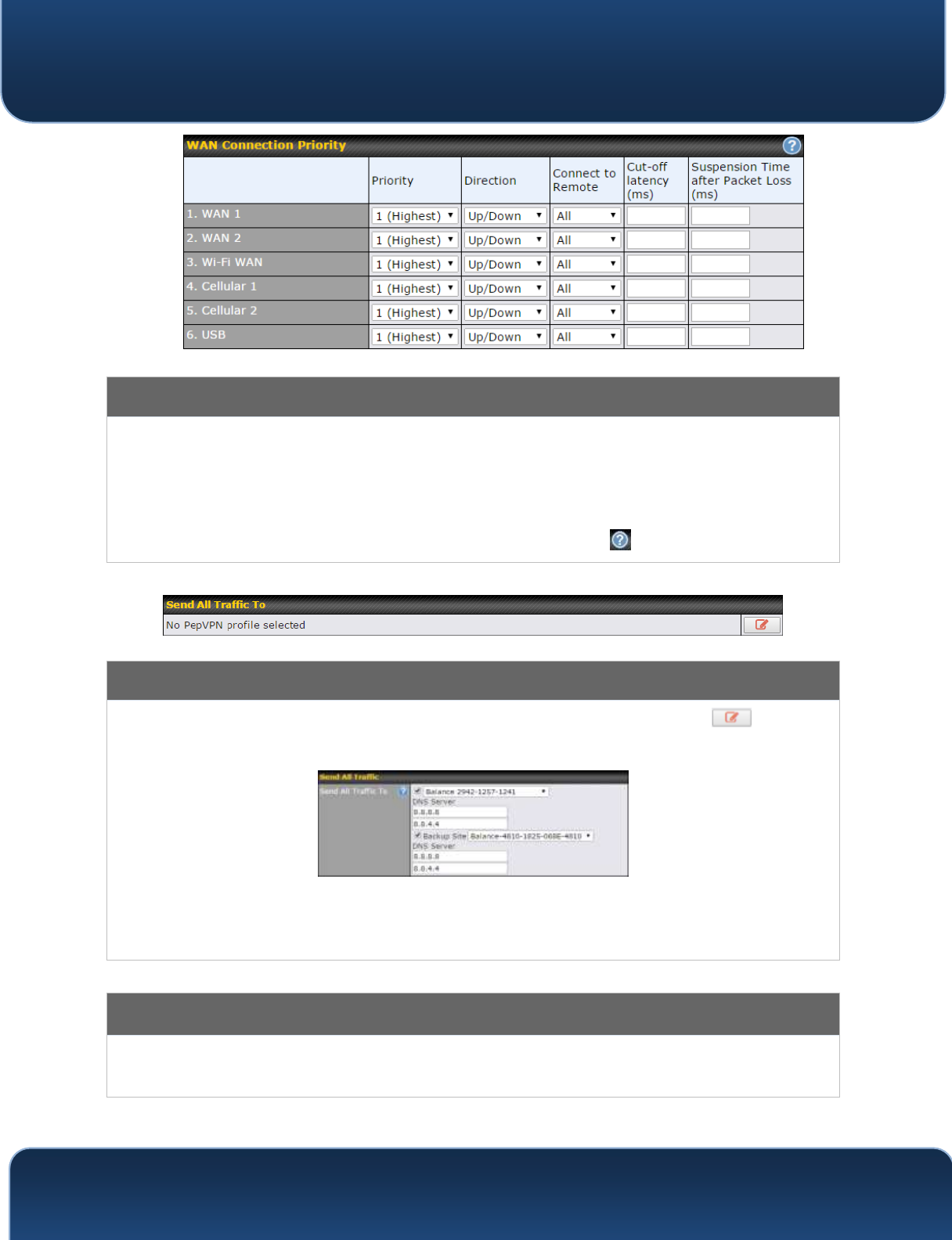
Pepwave MAX and Surf User Manual
http://www.pepwave.com
97
Copyright @ 2018 Pepwave
8.41
WAN Connection Priority
WAN
Connection
Priority
If your device supports it, you can specify the priority of WAN connections to be
used for making VPN connections. WAN connections set to OFF will never be used.
Only available WAN connections with the highest priority will be used.
To enable asymmetric connections, connection mapping to remote WANs, cut-off
latency, and packet loss suspension time, click the button.
Send All Traffic To
This feature allows you to redirect all traffic to a specified PepVPN connection. Click the button to
select your connection and the following menu will appear:
You could also specify a DNS server to resolve incoming DNS requests. Click the checkbox next to Backup
Site to designate a backup SpeedFusion profile that will take over, should the main PepVPN connection
fail.
Outbound Policy/PepVPN Outbound Custom Rules
Some models allow you to set outbound policy and custom outbound rules from Advanced>PepVPN. See
Section 14 for more information on outbound policy settings.
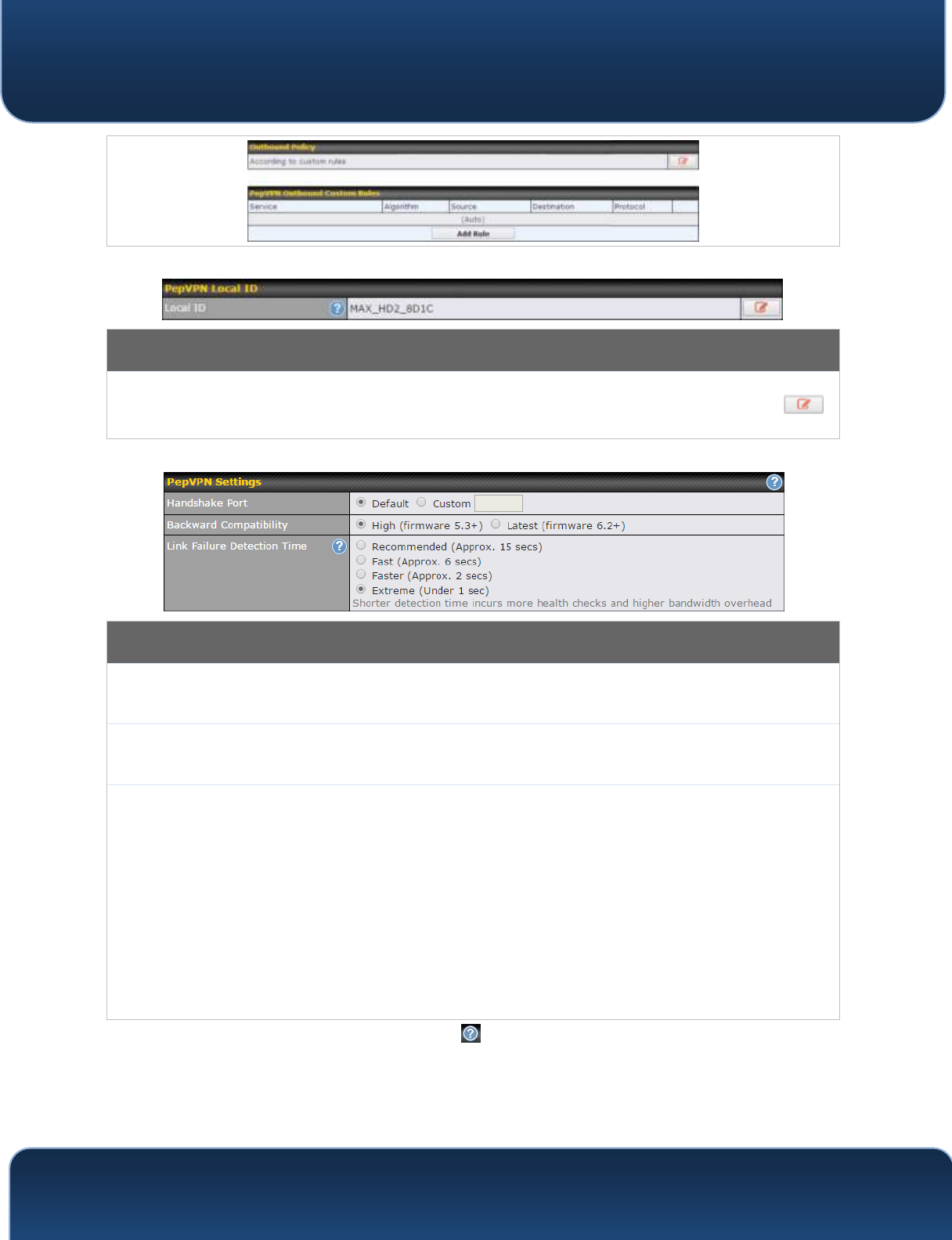
Pepwave MAX and Surf User Manual
http://www.pepwave.com
98
Copyright @ 2018 Pepwave
PepVPN Local ID
The local ID is a text string to identify this local unit when establishing a VPN connection. When creating a
profile on a remote unit, this local ID must be entered in the remote unit's Remote ID field. Click the
icon to edit Local ID.
PepVPN Settings
Handshake
PortA
To designate a custom handshake port (TCP), click the custom radio button and
enter the port number you wish to designate.
Backward
Compatibility
Determine the level of backward compatibility needed for PepVPN tunnels. The use
of the Latest setting is recommended as it will improve the performance and
resilience of SpeedFusion connections.
Link Failure
Detection Time
The bonded VPN can detect routing failures on the path between two sites over
each WAN connection. Failed WAN connections will not be used to route VPN
traffic. Health check packets are sent to the remote unit to detect any failure. The
more frequently checks are sent, the shorter the detection time, although more
bandwidth will be consumed.
When Recommended (default) is selected, a health check packet is sent every five
seconds, and the expected detection time is 15 seconds.
When Fast is selected, a health check packet is sent every three seconds, and the
expected detection time is six seconds.
When Faster is selected, a health check packet is sent every second, and the
expected detection time is two seconds.
When Extreme is selected, a health check packet is sent every 0.1 second, and the
expected detection time is less than one second.
A - Advanced feature, please click the button on the top right-hand corner to
activate.
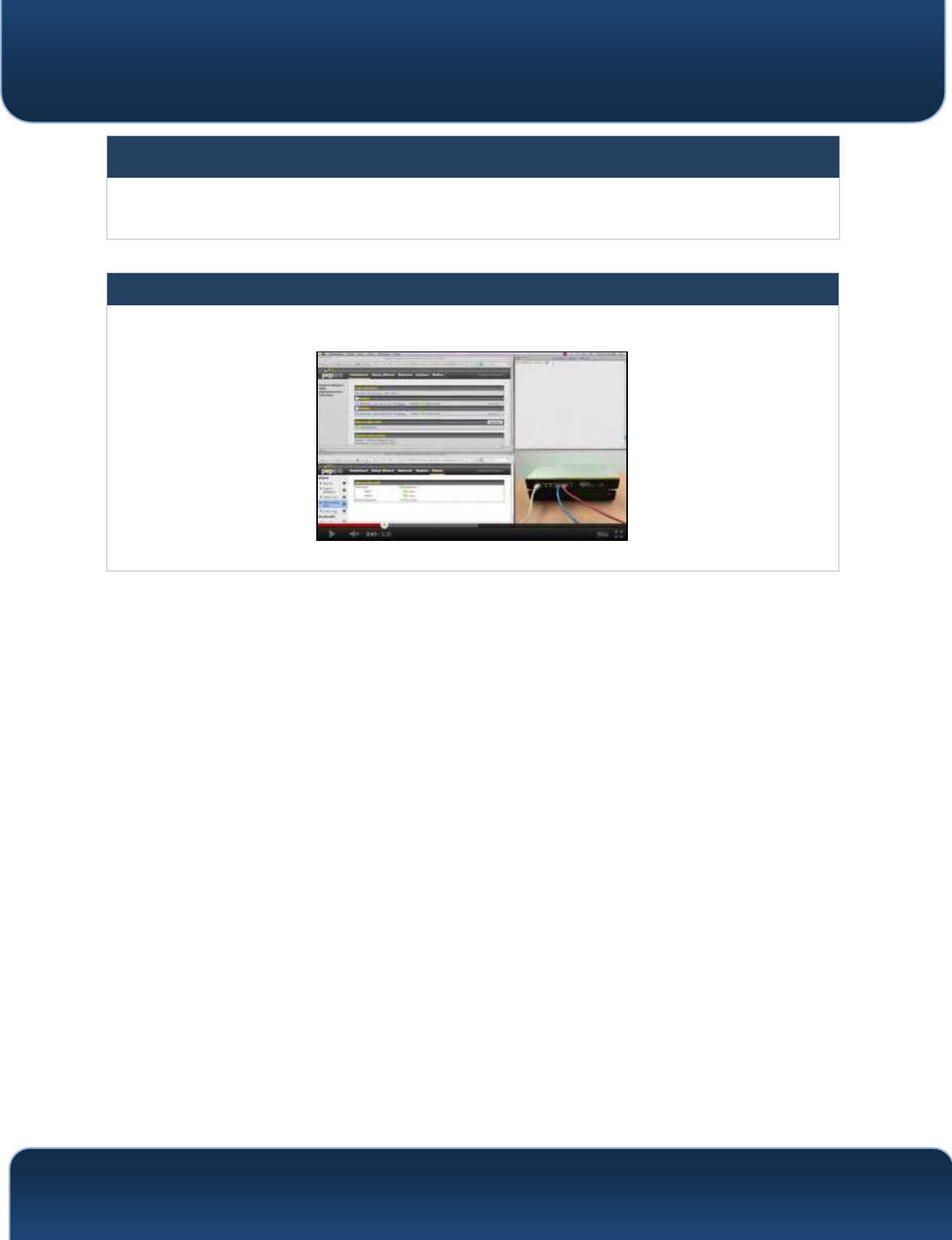
Pepwave MAX and Surf User Manual
http://www.pepwave.com
99
Copyright @ 2018 Pepwave
Important Note
Peplink proprietary SpeedFusionTM uses TCP port 32015 and UDP port 4500 for establishing VPN
connections. If you have a firewall in front of your Pepwave devices, you will need to add firewall rules for
these ports and protocols to allow inbound and outbound traffic to pass through the firewall.
Tip
Want to know more about VPN sub-second session failover? Visit our YouTube Channel for a video
tutorial!
http://youtu.be/TLQgdpPSY88
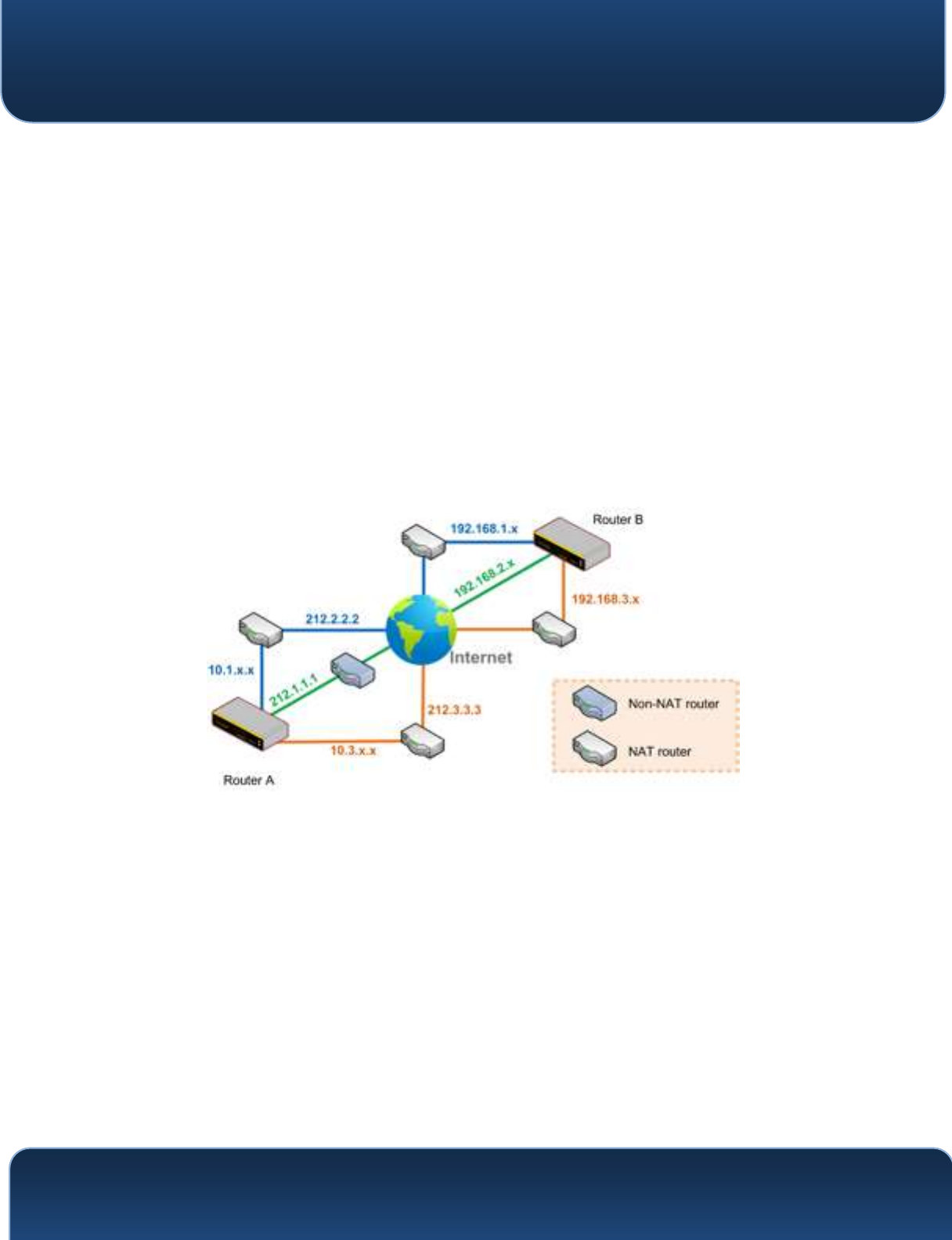
Pepwave MAX and Surf User Manual
http://www.pepwave.com
100
Copyright @ 2018 Pepwave
13.2 The Pepwave Router Behind a NAT Router
Pepwave routers support establishing SpeedFusionTM over WAN connections
which are behind a NAT (network address translation) router.
To enable a WAN connection behind a NAT router to accept VPN connections,
you can configure the NAT router in front of the WAN connection to inbound
port-forward TCP port 32015 to the Pepwave router.
If one or more WAN connections on Unit A can accept VPN connections (by
means of port forwarding or not), while none of the WAN connections on the
peer Unit B can do so, you should enter all of Unit A’s public IP addresses or
hostnames into Unit B’s Remote IP Addresses / Host Names field. Leave the field
in Unit A blank. With this setting, a SpeedFusionTM connection can be set up and
all WAN connections on both sides will be utilized.
See the following diagram for an example of this setup in use:
One of the WANs connected to Router A is non-NAT’d (212.1.1.1). The rest of the
WANs connected to Router A and all WANs connected to Router B are NAT’d. In
this case, the Peer IP Addresses / Host Names field for Router B should be filled
with all of Router A’s hostnames or public IP addresses (i.e., 212.1.1.1, 212.2.2.2,
and 212.3.3.3), and the field in Router A can be left blank. The two NAT routers
on WAN1 and WAN3 connected to Router A should inbound port-forward TCP
port 32015 to Router A so that all WANs will be utilized in establishing the VPN.
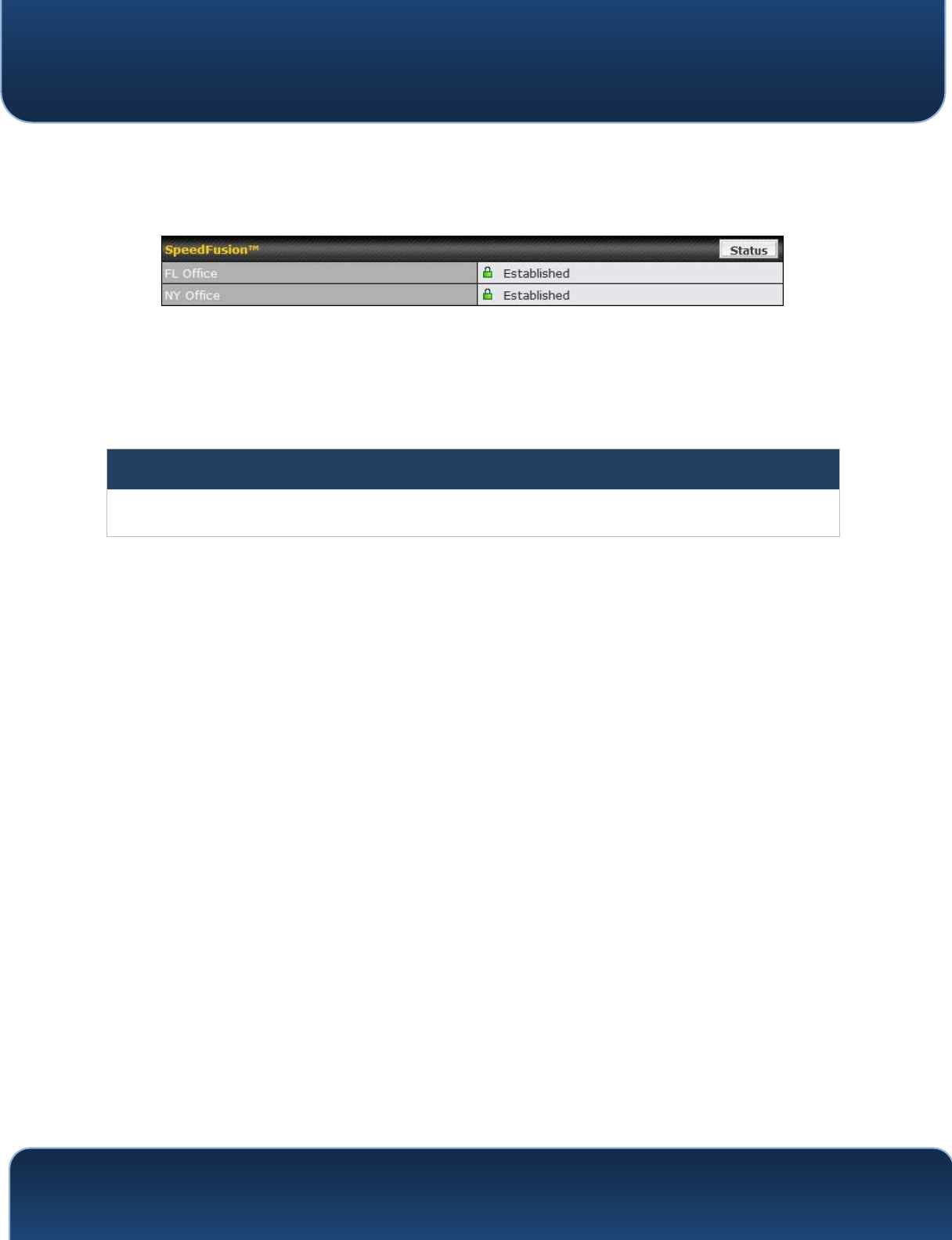
Pepwave MAX and Surf User Manual
http://www.pepwave.com
101
Copyright @ 2018 Pepwave
13.3 SpeedFusionTM Status
SpeedFusionTM status is shown in the Dashboard. The connection status of each
connection profile is shown as below.
After clicking the Status button at the top right corner of the SpeedFusionTM
table, you will be forwarded to Status>SpeedFusionTM, where you can view
subnet and WAN connection information for each VPN peer. Please refer to
Section 22.6 for details.
IP Subnets Must Be Unique Among VPN Peers
The entire interconnected SpeedFusionTM network is a single non-NAT IP network. Avoid duplicating
subnets in your sites to prevent connectivity problems when accessing those subnets.
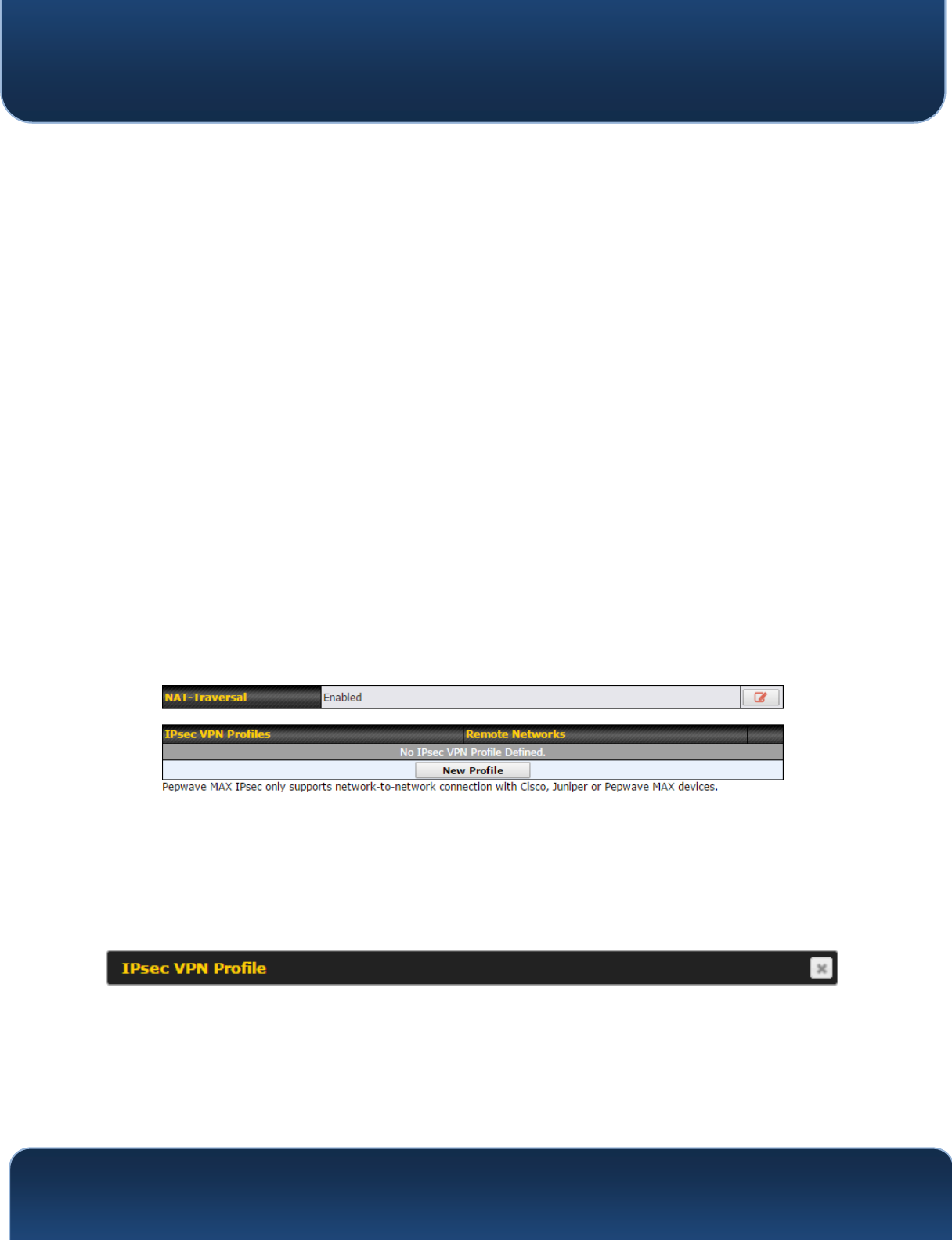
Pepwave MAX and Surf User Manual
http://www.pepwave.com
102
Copyright @ 2018 Pepwave
14 IPsec VPN
IPsec VPN functionality securely connects one or more branch offices to your
company's main headquarters or to other branches. Data, voice, and video
communications between these locations are kept safe and confidential across
the public Internet.
IPsec VPN on Pepwave routers is specially designed for multi-WAN environments.
For instance, if a user sets up multiple IPsec profiles for a multi-WAN environment
and WAN1 is connected and healthy, IPsec traffic will go through this link.
However, should unforeseen problems (e.g., unplugged cables or ISP problems)
cause WAN1 to go down, our IPsec implementation will make use of WAN2 and
WAN3 for failover.
14.1 IPsec VPN Settings
Many Pepwave products can make multiple IPsec VPN connections with
Peplink, Pepwave, Cisco, and Juniper routers. Note that all LAN subnets and the
subnets behind them must be unique. Otherwise, VPN members will not be able
to access each other. All data can be routed over the VPN with a selection of
encryption standards, such as 3DES, AES-128, and AES-256. To configure IPsec
VPN on Pepwave devices that support it, navigate to Advanced>IPsec VPN.
A NAT-Traversal option and list of defined IPsec VPN profiles will be shown. NAT-
Traversal should be enabled if your system is behind a NAT router. Click the New
Profile button to create new IPsec VPN profiles that make VPN connections to
remote Pepwave, Cisco, or Juniper routers via available WAN connections. To
edit any of the profiles, click on its associated connection name in the leftmost
column.

Pepwave MAX and Surf User Manual
http://www.pepwave.com
104
Copyright @ 2018 Pepwave
Active
When this box is checked, this IPsec VPN connection profile will be enabled.
Otherwise, it will be disabled.
Connect Upon
Disconnection
of
Check this box and select a WAN to connect to this VPN automatically when the
specified WAN is disconnected.
Remote
Gateway IP
Address / Host
Name
Enter the remote peer’s public IP address. For Aggressive Mode, this is optional.
Local
Networks
Enter the local LAN subnets here. If you have defined static routes, they will be
shown here.
Using NAT, you can map a specific local network / IP address to another, and the
packets received by remote gateway will appear to be coming from the
mapped network / IP address. This allow you to establish IPsec connection to a
remote site that has one or more subnets overlapped with local site.
Two types of NAT policies can be defined:
One-to-One NAT policy: if the defined subnet in Local Network and NAT Network
has the same size, for example, policy "192.168.50.0/24 > 172.16.1.0/24" will
translate the local IP address 192.168.50.10 to 172.16.1.10 and 192.168.50.20 to
172.16.1.20. This is a bidirectional mapping which means clients in remote site can
initiate connection to the local clients using the mapped address too.
Many-to-One NAT policy: if the defined NAT Network on the right hand side is an
IP address (or having a network prefix /32), for example, policy "192.168.1.0/24 >
172.168.50.1/32" will translate all clients in 192.168.1.0/24 network to 172.168.50.1.
This is a unidirectional mapping which means clients in remote site will not be able
to initiate connection to the local clients.
Remote
Networks
Enter the LAN and subnets that are located at the remote site here.
Authentication
To access your VPN, clients will need to authenticate by your choice of methods.
Choose between the Preshared Key and X.509 Certificate methods of
authentication.
Mode
Choose Main Mode if both IPsec peers use static IP addresses. Choose Aggressive
Mode if one of the IPsec peers uses dynamic IP addresses.
Force UDP
Encapsulation
For forced UDP encapsulation regardless of NAT-traversal, tick this checkbox.
Pre-shared
Key
This defines the peer authentication pre-shared key used to authenticate this VPN
connection. The connection will be up only if the pre-shared keys on each side
match.
Remote
Certificate
(pem
Available only when X.509 Certificate is chosen as the Authentication method, this
field allows you to paste a valid X.509 certificate.
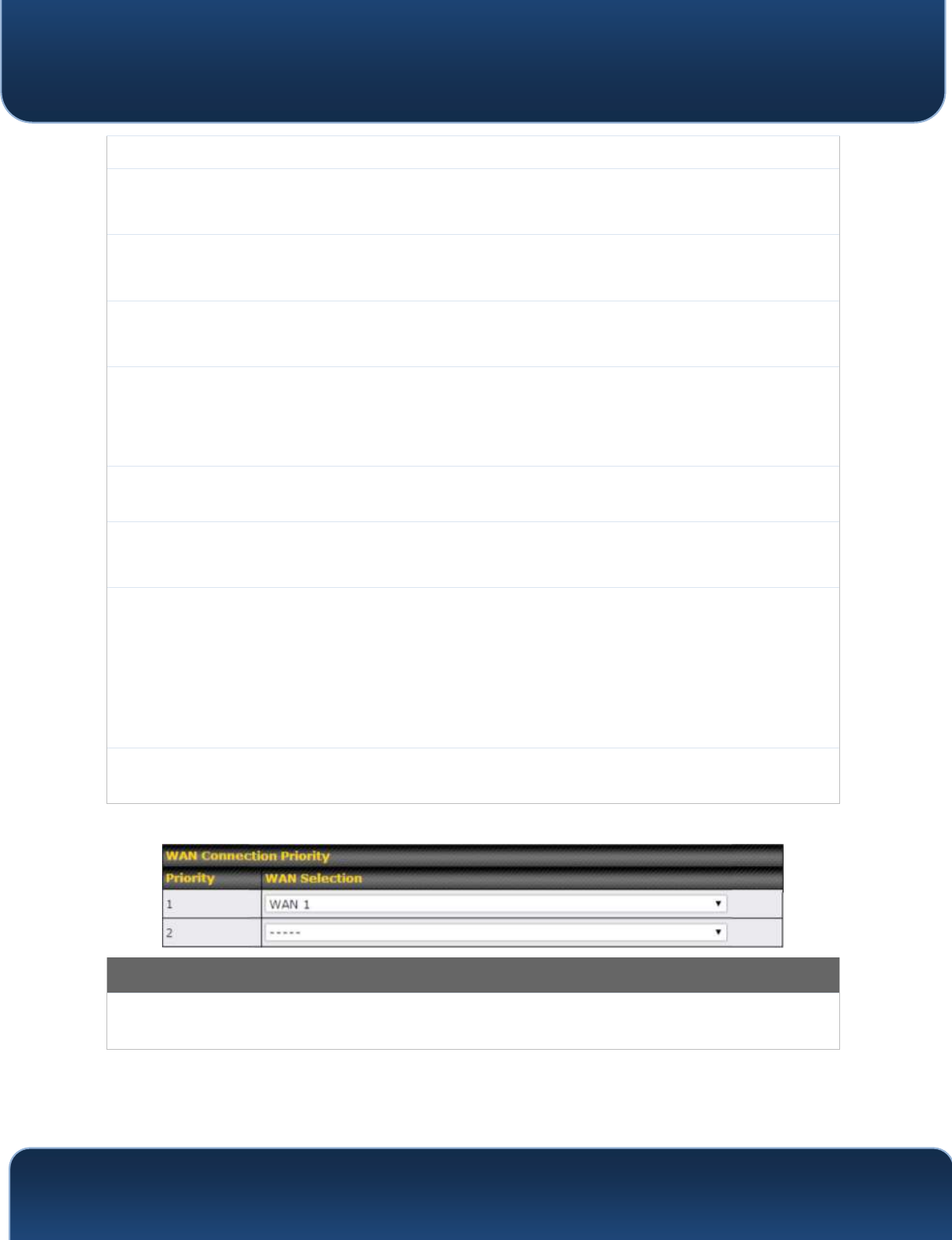
Pepwave MAX and Surf User Manual
http://www.pepwave.com
105
Copyright @ 2018 Pepwave
encoded)
Local ID
In Main Mode, this field can be left blank. In Aggressive Mode, if Remote Gateway
IP Address is filled on this end and the peer end, this field can be left blank.
Otherwise, this field is typically a U-FQDN.
Remote ID
In Main Mode, this field can be left blank. In Aggressive Mode, if Remote Gateway
IP Address is filled on this end and the peer end, this field can be left blank.
Otherwise, this field is typically a U-FQDN.
Phase 1 (IKE)
Proposal
In Main Mode, this allows setting up to six encryption standards, in descending
order of priority, to be used in initial connection key negotiations. In Aggressive
Mode, only one selection is permitted.
Phase 1 DH
Group
This is the Diffie-Hellman group used within IKE. This allows two parties to establish a
shared secret over an insecure communications channel. The larger the group
number, the higher the security.
Group 2: 1024-bit is the default value.
Group 5: 1536-bit is the alternative option.
Phase 1 SA
Lifetime
This setting specifies the lifetime limit of this Phase 1 Security Association. By
default, it is set at 3600 seconds.
Phase 2 (ESP)
Proposal
In Main Mode, this allows setting up to six encryption standards, in descending
order of priority, to be used for the IP data that is being transferred. In Aggressive
Mode, only one selection is permitted.
Phase 2 PFS
Group
Perfect forward secrecy (PFS) ensures that if a key was compromised, the
attacker will be able to access only the data protected by that key.
None - Do not request for PFS when initiating connection. However, since there is
no valid reason to refuse PFS, the system will allow the connection to use PFS if
requested by the remote peer. This is the default value.
Group 2: 1024-bit Diffie-Hellman group. The larger the group number, the higher
the security.
Group 5: 1536-bit is the third option.
Phase 2 SA
Lifetime
This setting specifies the lifetime limit of this Phase 2 Security Association. By
default, it is set at 28800 seconds.
WAN Connection Priority
WAN Connection
Select the appropriate WAN connection from the drop-down menu.
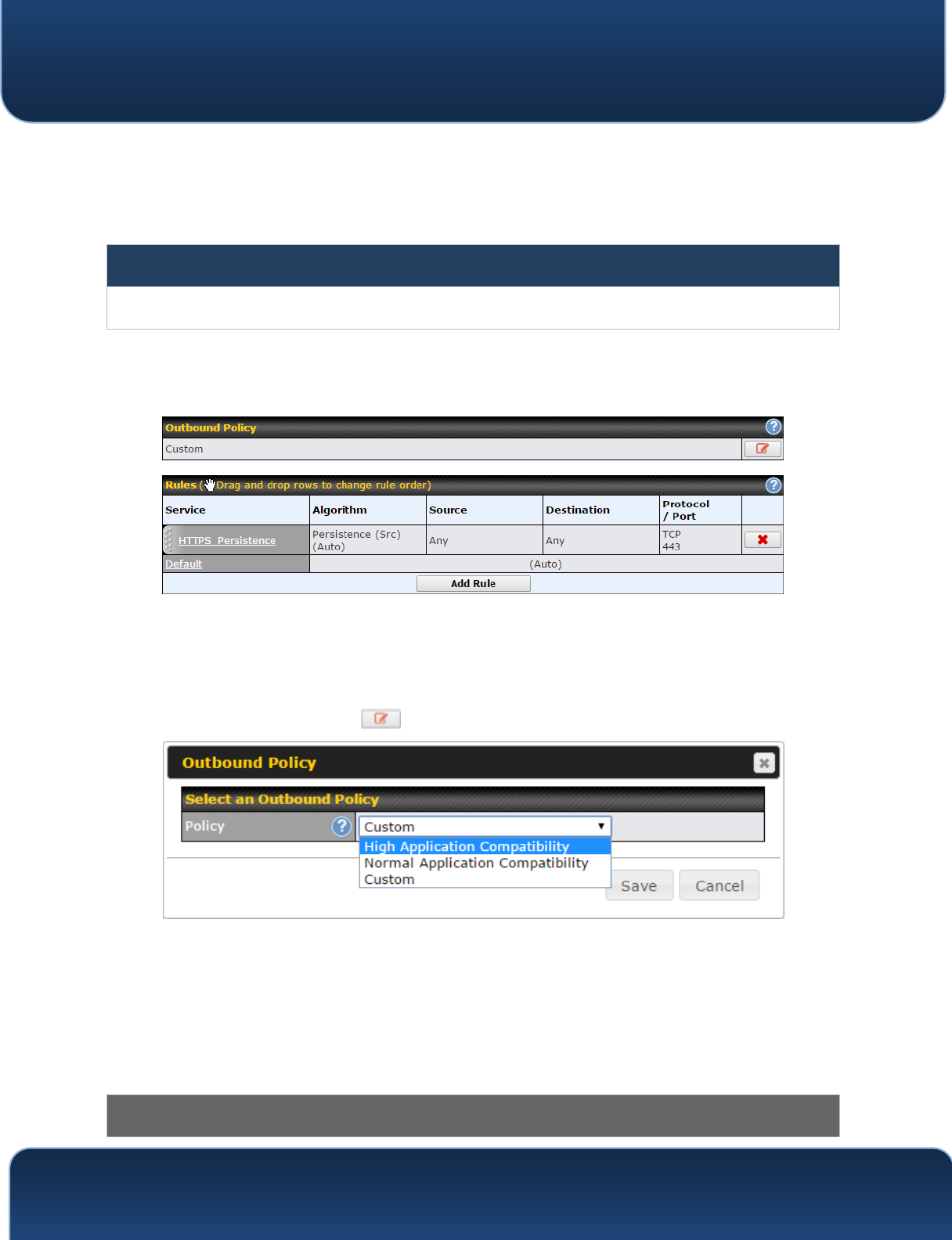
Pepwave MAX and Surf User Manual
http://www.pepwave.com
106
Copyright @ 2018 Pepwave
15 Outbound Policy Management
Pepwave routers can flexibly manage and load balance outbound traffic
among WAN connections.
Important Note
Outbound policy is applied only when more than one WAN connection is active.
The settings for managing and load balancing outbound traffic are located at
Advanced>Outbound Policy or Advanced>PepVPN, depending on the model.
15.1 Outbound Policy
Outbound policies for managing and load balancing outbound traffic are
located at
Network>Outbound Policy> or Advanced>PepVPN>Outbound Policy.
There are three main selections for the outbound traffic policy:
High Application Compatibility
Normal Application Compatibility
Custom
Note that some Pepwave routers provide only the Send All Traffic To setting
here. See Section 12.1 for details.
Outbound Policy Settings
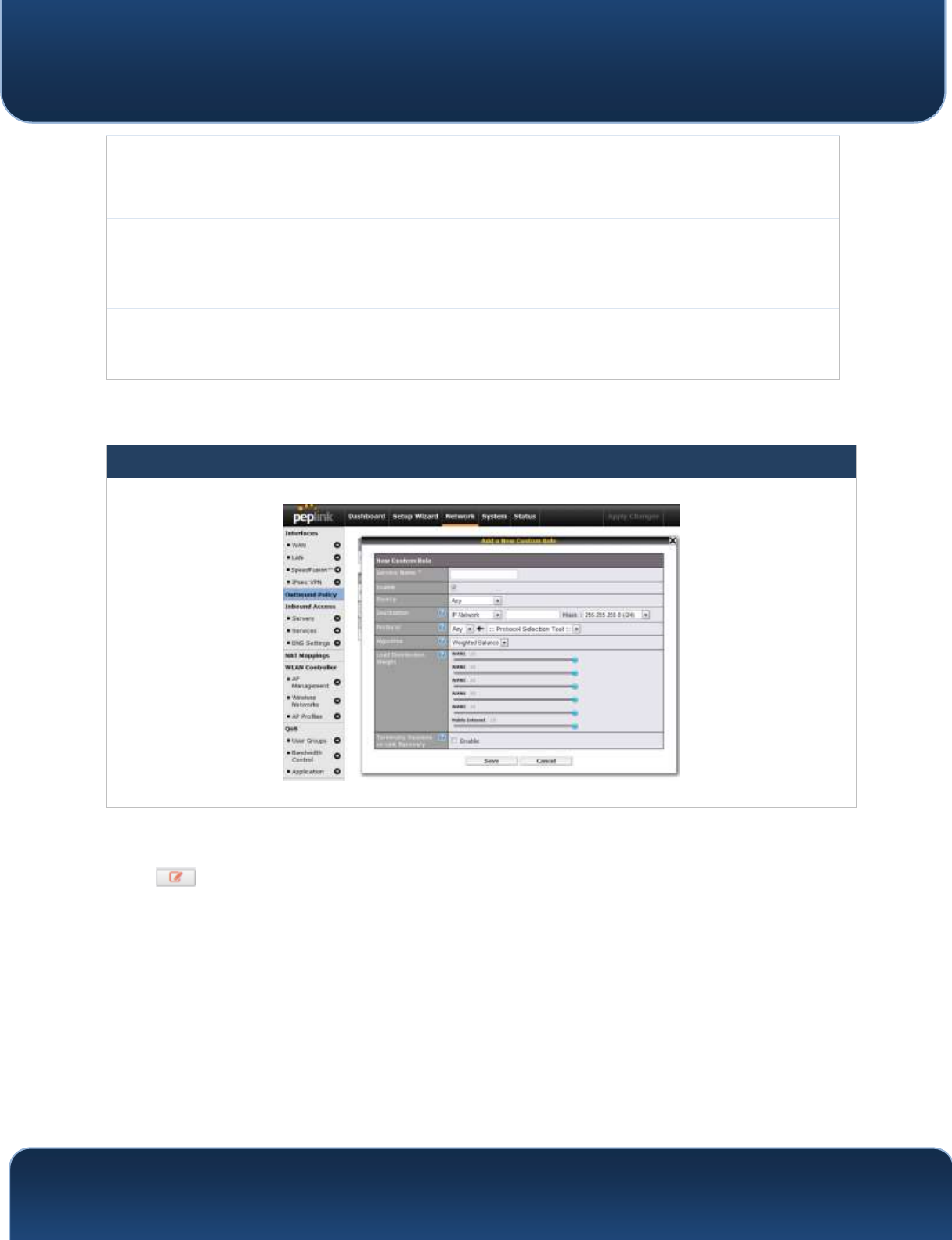
Pepwave MAX and Surf User Manual
http://www.pepwave.com
107
Copyright @ 2018 Pepwave
High
Application
Compatibility
Outbound traffic from a source LAN device is routed through the same WAN
connection regardless of the destination Internet IP address and protocol. This
option provides the highest application compatibility.
Normal
Application
Compatibility
Outbound traffic from a source LAN device to the same destination Internet IP
address will be routed through the same WAN connection persistently, regardless of
protocol. This option provides high compatibility to most applications, and users still
benefit from WAN link load balancing when multiple Internet servers are accessed.
Custom
Outbound traffic behavior can be managed by defining rules in a custom rule
table. A default rule can be defined for connections that cannot be matched with
any of the rules.
The default policy is Normal Application Compatibility.
Tip
Want to know more about creating outbound rules? Visit our YouTube Channel for a video tutorial!
http://youtu.be/rKH4AS_bQnE
15.2 Custom Rules for Outbound Policy
Click in the Outbound Policy form. Choose Custom and press the Save
button.
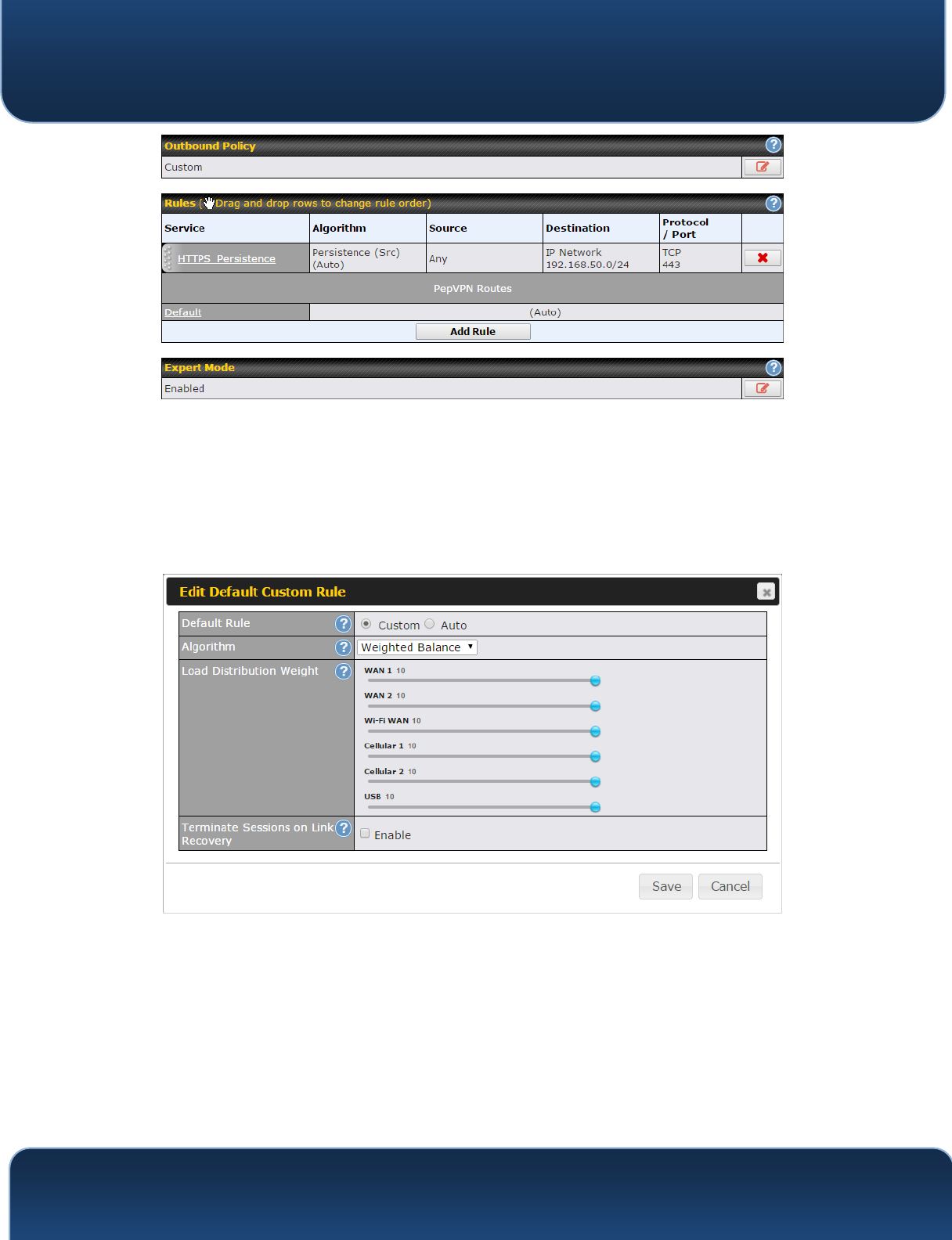
Pepwave MAX and Surf User Manual
http://www.pepwave.com
108
Copyright @ 2018 Pepwave
The bottom-most rule is Default. Edit this rule to change the device’s default
manner of controlling outbound traffic for all connections that do not match
any of the rules above it. Under the Service heading, click Default to change
these settings.
To rearrange the priority of outbound rules, drag and drop them into the desired
sequence.
By default, Auto is selected as the Default Rule. You can select Custom to
change the algorithm to be used. Please refer to the upcoming sections for the
details on the available algorithms.
To create a custom rule, click Add Rule at the bottom of the table. Note that
some Pepwave routers display this button at Advanced>PepVPN>PepVPN
Outbound Custom Rules.
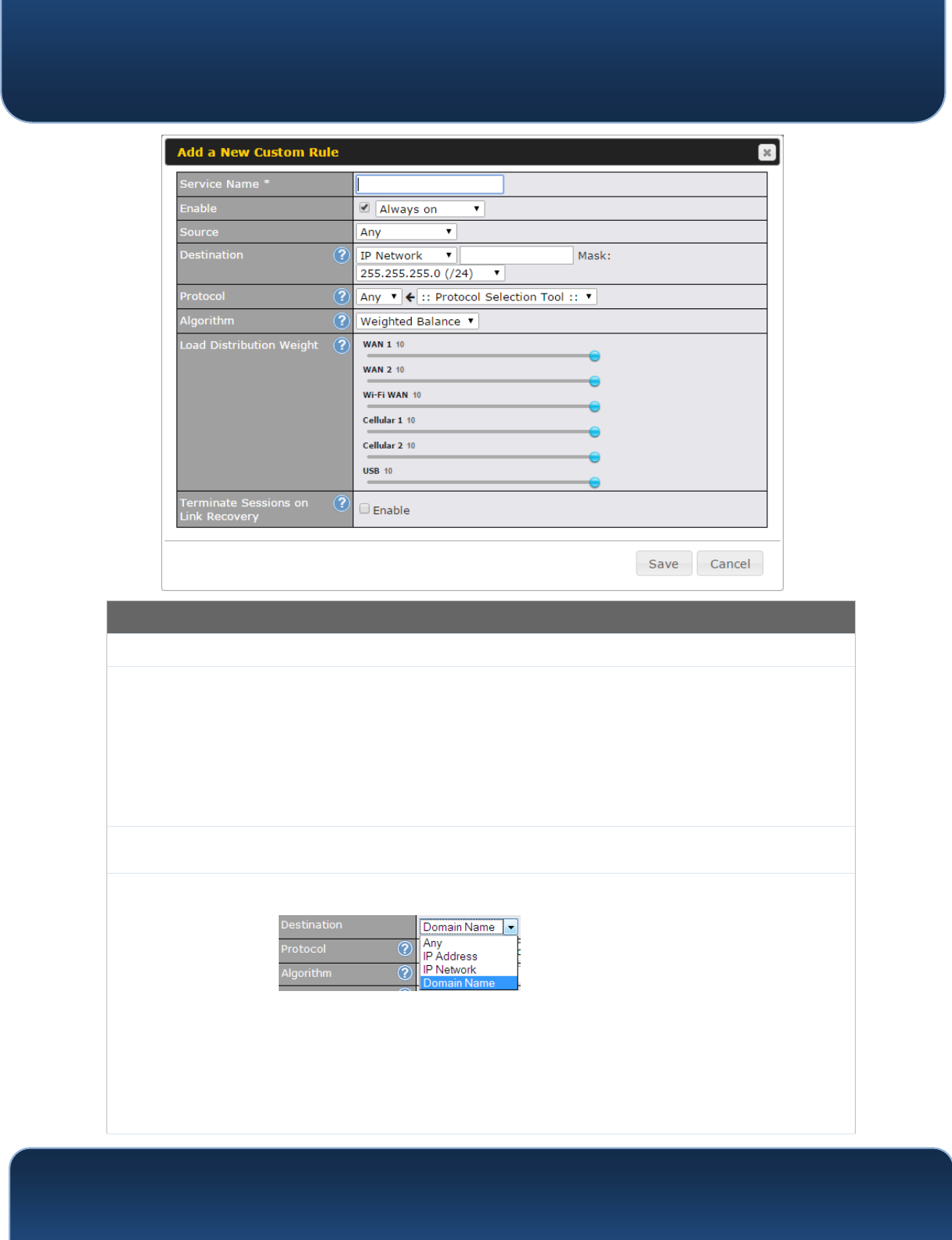
Pepwave MAX and Surf User Manual
http://www.pepwave.com
109
Copyright @ 2018 Pepwave
New Custom Rule Settings
Service Name
This setting specifies the name of the outbound traffic rule.
Enable
This setting specifies whether the outbound traffic rule takes effect. When Enable is
checked, the rule takes effect: traffic is matched and actions are taken by the
Pepwave router based on the other parameters of the rule. When Enable is
unchecked, the rule does not take effect: the Pepwave router disregards the other
parameters of the rule.
Click the drop-down menu next to the checkbox to apply a time schedule to this
custom rule.
Source
This setting specifies the source IP address, IP network, or MAC address for traffic
that matches the rule.
Destination
This setting specifies the destination IP address, IP network, or domain name for
traffic that matches the rule.
If Domain Name is chosen and a domain name, such as foobar.com, is entered,
any outgoing accesses to foobar.com and *.foobar.com will match this criterion.
You may enter a wildcard (.*) at the end of a domain name to match any host with
a name having the domain name in the middle. If you enter foobar.*, for example,
www.foobar.com, www.foobar.co.jp, or foobar.co.uk will also match. Placing
wildcards in any other position is not supported.
NOTE: if a server has one Internet IP address and multiple server names, and if one
of the names is defined here, accesses to any one of the server names will also
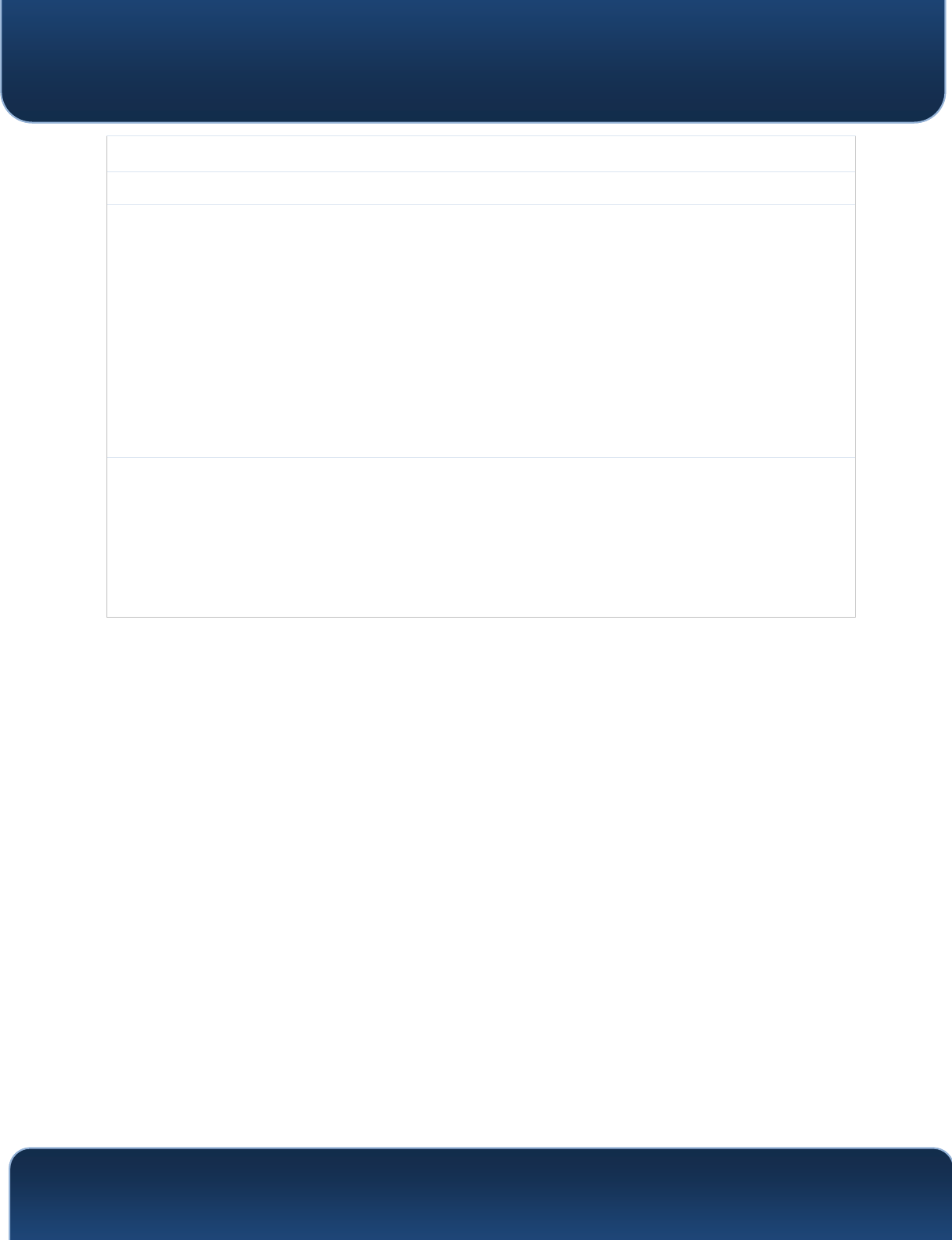
Pepwave MAX and Surf User Manual
http://www.pepwave.com
110
Copyright @ 2018 Pepwave
match this rule.
Protocol and Port
This setting specifies the IP protocol and port of traffic that matches this rule.
Algorithm
This setting specifies the behavior of the Pepwave router for the custom rule.
One of the following values can be selected (note that some Pepwave routers
provide only some of these options):
Weighted Balance
Persistence
Enforced
Priority
Overflow
Least Used
Lowest Latency
The upcoming sections detail the listed algorithms.
Terminate
Sessions on Link
Recovery
This setting specifies whether to terminate existing IP sessions on a less preferred
WAN connection in the event that a more preferred WAN connection is recovered.
This setting is applicable to the Weighted, Persistence, and Priority algorithms. By
default, this setting is disabled. In this case, existing IP sessions will not be terminated
or affected when any other WAN connection is recovered. When this setting is
enabled, existing IP sessions may be terminated when another WAN connection is
recovered, such that only the preferred healthy WAN connection(s) is used at any
point in time.
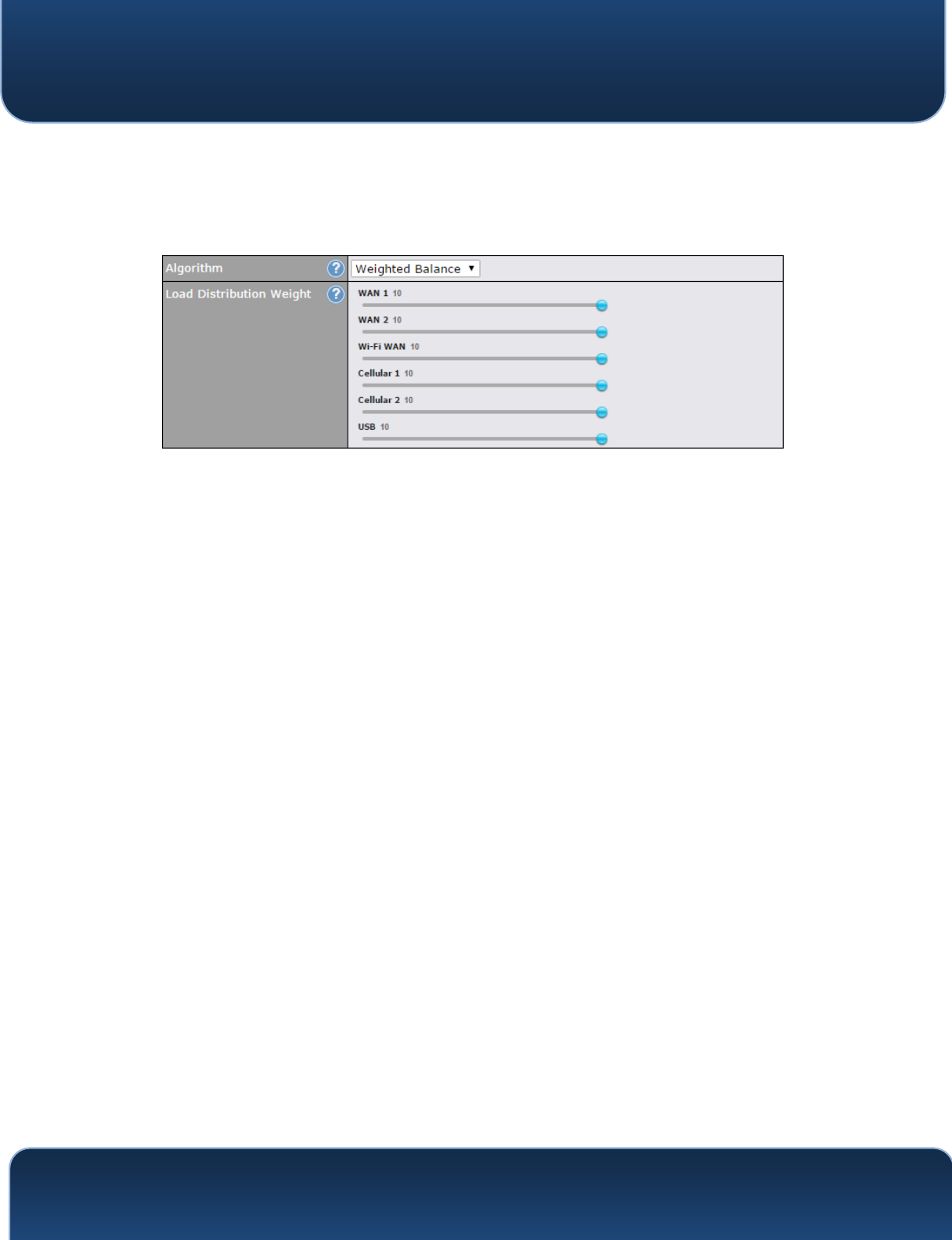
Pepwave MAX and Surf User Manual
http://www.pepwave.com
111
Copyright @ 2018 Pepwave
15.2.1 Algorithm: Weighted Balance
This setting specifies the ratio of WAN connection usage to be applied on the
specified IP protocol and port. This setting is applicable only when Algorithm is
set to Weighted Balance.
The amount of matching traffic that is distributed to a WAN connection is
proportional to the weight of the WAN connection relative to the total weight.
Use the sliders to change each WAN’s weight.
For example, with the following weight settings:
Ethernet WAN1: 10
Ethernet WAN2: 10
Wi-Fi WAN: 10
Cellular 1: 10
Cellular 2: 10
USB: 10
Total weight is 60 = (10 +10 + 10 + 10 + 10 + 10).
Matching traffic distributed to Ethernet WAN1 is 16.7% = (10 / 60 x 100%.
Matching traffic distributed to Ethernet WAN2 is 16.7% = (10 / 60) x 100%.
Matching traffic distributed to Wi-Fi WAN is 16.7% = (10 / 60) x 100%.
Matching traffic distributed to Cellular 1 is 16.7% = (10 / 60) x 100%.
Matching traffic distributed to Cellular 2 is 16.7% = (10 / 60) x 100%.
Matching traffic distributed to USB is 16.7% = (10 / 60) x 100%.
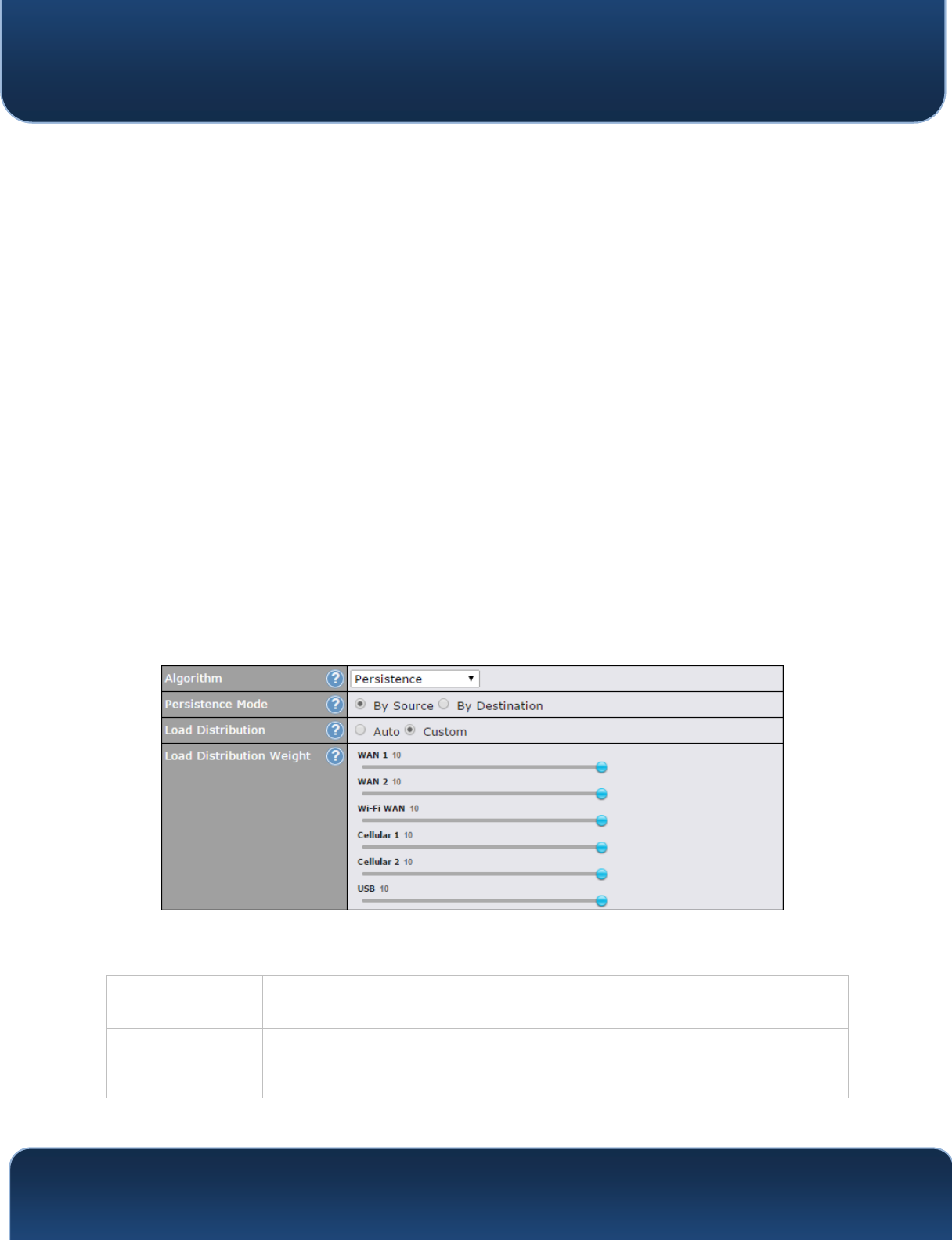
Pepwave MAX and Surf User Manual
http://www.pepwave.com
112
Copyright @ 2018 Pepwave
15.2.2 Algorithm: Persistence
The configuration of persistent services is the solution to the few situations where
link load distribution for Internet services is undesirable. For example, for security
reasons, many e-banking and other secure websites terminate the session when
the client computer’s Internet IP address changes mid-session.
In general, different Internet IP addresses represent different computers. The
security concern is that an IP address change during a session may be the result
of an unauthorized intrusion attempt. Therefore, to prevent damages from the
potential intrusion, the session is terminated upon the detection of an IP address
change.
Pepwave routers can be configured to distribute data traffic across multiple
WAN connections. Also, the Internet IP depends on the WAN connections over
which communication actually takes place. As a result, a LAN client computer
behind the Pepwave router may communicate using multiple Internet IP
addresses. For example, a LAN client computer behind a Pepwave router with
three WAN connections may communicate on the Internet using three different
IP addresses.
With the persistence feature, rules can be configured to enable client
computers to persistently utilize the same WAN connections for e-banking and
other secure websites. As a result, a client computer will communicate using one
IP address, eliminating the issues mentioned above.
There are two persistent modes: By Source and By Destination.
By Source:
The same WAN connection will be used for traffic matching the rule and
originating from the same machine, regardless of its destination. This option will
provide the highest level of application compatibility.
By Destination:
The same WAN connection will be used for traffic matching the rule, originating
from the same machine, and going to the same destination. This option can
better distribute loads to WAN connections when there are only a few client
machines.
The default mode is By Source. When there are multiple client requests, they can
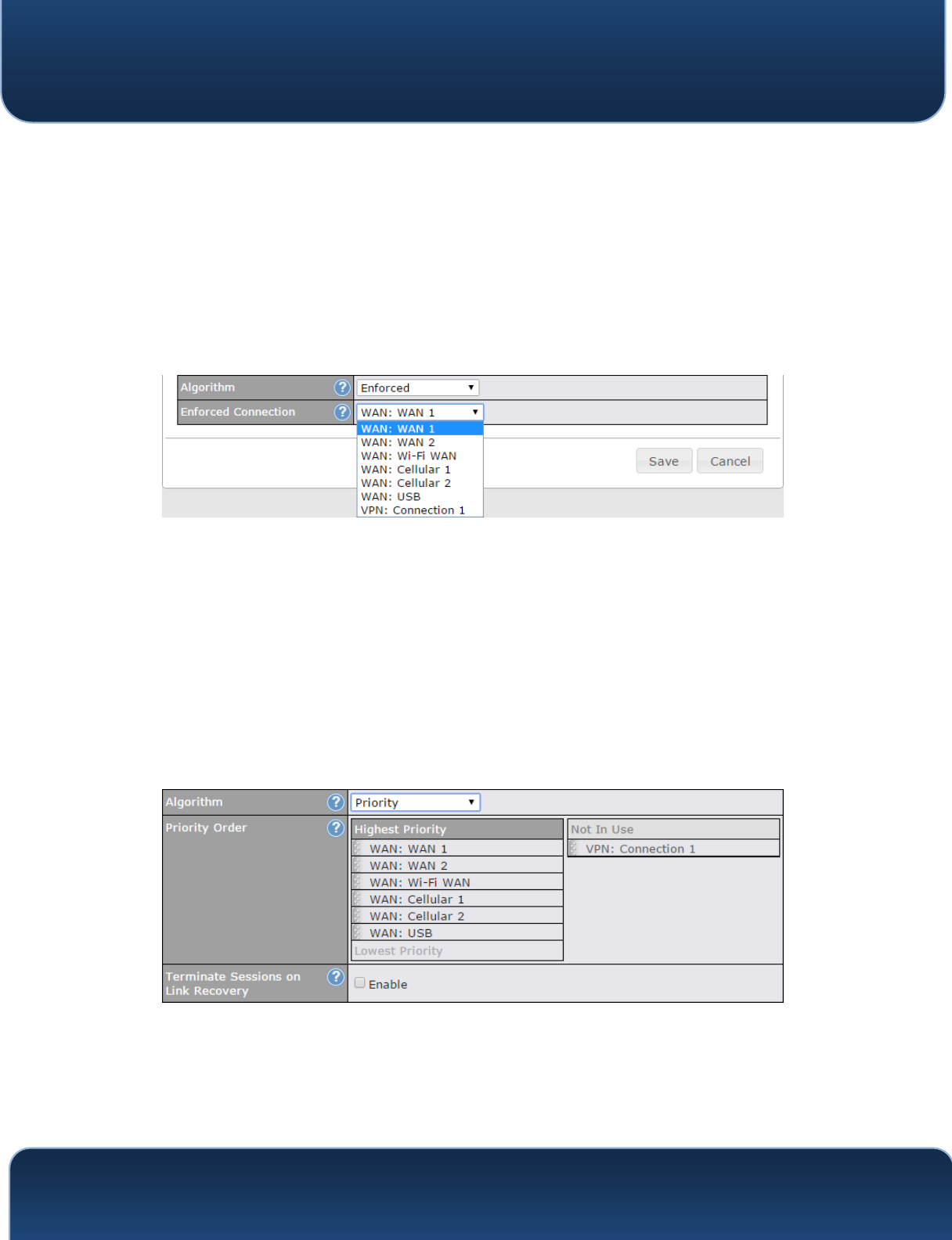
Pepwave MAX and Surf User Manual
http://www.pepwave.com
113
Copyright @ 2018 Pepwave
be distributed (persistently) to WAN connections with a weight. If you choose
Auto in Load Distribution, the weights will be automatically adjusted according
to each WAN’s Downstream Bandwidth which is specified in the WAN settings
page). If you choose Custom, you can customize the weight of each WAN
manually by using the sliders.
15.2.3 Algorithm: Enforced
This setting specifies the WAN connection usage to be applied on the specified
IP protocol and port. This setting is applicable only when Algorithm is set to
Enforced.
Matching traffic will be routed through the specified WAN connection,
regardless of the health check status of the WAN connection. Starting from
Firmware 5.2, outbound traffic can be enforced to go through a specified
SpeedFusionTM connection.
15.2.4 Algorithm: Priority
This setting specifies the priority of the WAN connections used to route the
specified network service. The highest priority WAN connection available will
always be used for routing the specified type of traffic. A lower priority WAN
connection will be used only when all higher priority connections have become
unavailable.
Starting from Firmware 5.2, outbound traffic can be prioritized to go through
SpeedFusionTM connection(s). By default, VPN connections are not included in
the priority list.
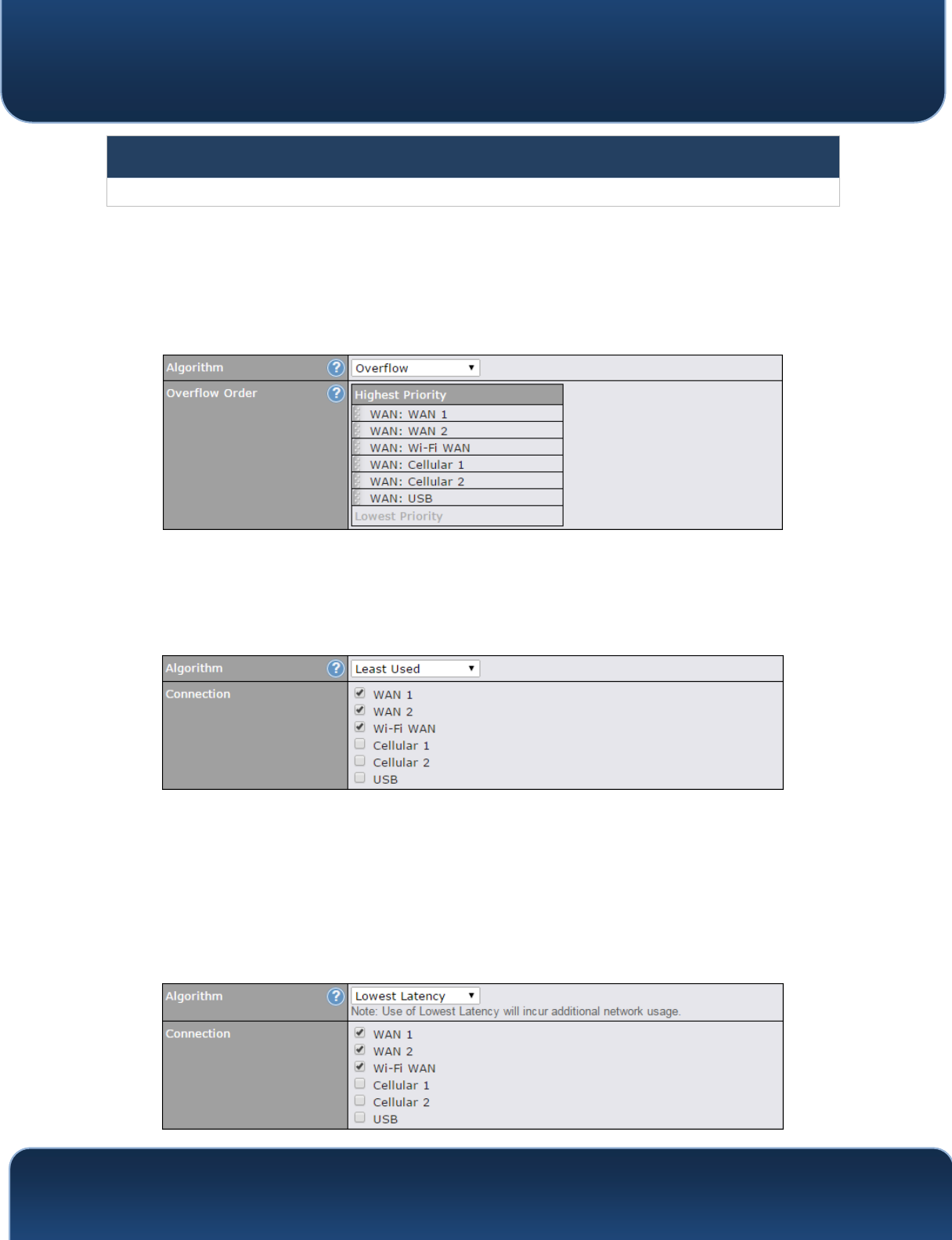
Pepwave MAX and Surf User Manual
http://www.pepwave.com
114
Copyright @ 2018 Pepwave
Tip
Configure multiple distribution rules to accommodate different kinds of services.
15.2.5 Algorithm: Overflow
The traffic matching this rule will be routed through the healthy WAN connection
that has the highest priority and is not in full load. When this connection gets
saturated, new sessions will be routed to the next healthy WAN connection that
is not in full load.
Drag and drop to specify the order of WAN connections to be used for routing
traffic. Only the highest priority healthy connection that is not in full load will be
used.
15.2.6 Algorithm: Least Used
The traffic matching this rule will be routed through the healthy WAN connection
that is selected in Connection and has the most available download
bandwidth. The available download bandwidth of a WAN connection is
calculated from the total download bandwidth specified on the WAN settings
page and the current download usage. The available bandwidth and WAN
selection is determined every time an IP session is made.
15.2.7 Algorithm: Lowest Latency
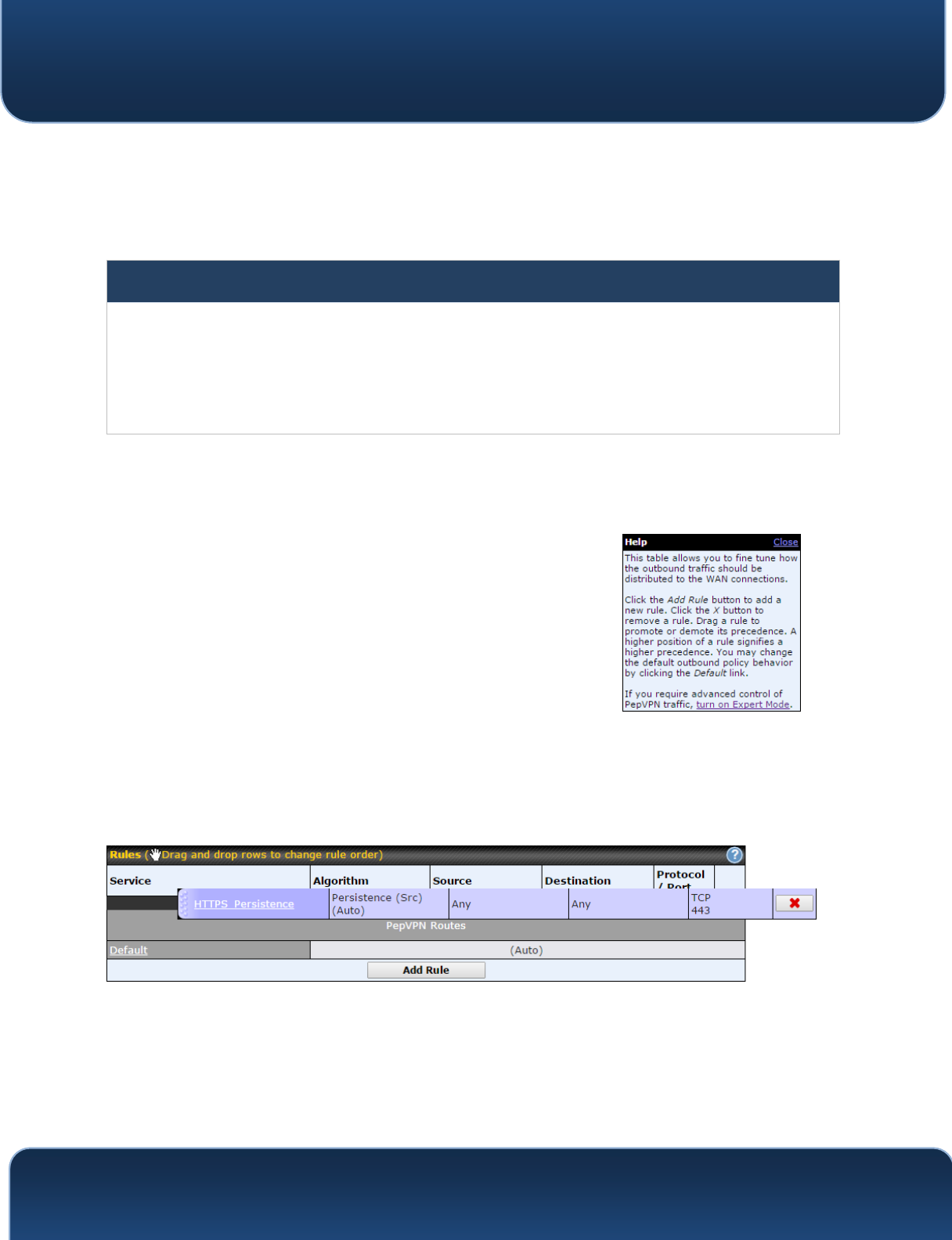
Pepwave MAX and Surf User Manual
http://www.pepwave.com
115
Copyright @ 2018 Pepwave
The traffic matching this rule will be routed through the healthy WAN connection
that is selected in Connection and has the lowest latency. Latency checking
packets are issued periodically to a nearby router of each WAN connection to
determine its latency value. The latency of a WAN is the packet round trip time
of the WAN connection. Additional network usage may be incurred as a result.
Tip
The roundtrip time of a 6M down/640k uplink can be higher than that of a 2M down/2M up link because
the overall round trip time is lengthened by its slower upload bandwidth, despite its higher downlink
speed. Therefore, this algorithm is good for two scenarios:
All WAN connections are symmetric; or
A latency sensitive application must be routed through the lowest latency WAN, regardless of the
WAN’s available bandwidth.
15.2.8 Expert Mode
Expert Mode is available on some Pepwave routers for
use by advanced users. To enable the feature, click on
the help icon and click turn on Expert Mode.
In Expert Mode, a new special rule, SpeedFusionTM
Routes, is displayed in the Custom Rules table. This rule
represents all SpeedFusionTM routes learned from
remote VPN peers. By default, this bar is on the top of
all custom rules. This position means that traffic for
remote VPN subnets will be routed to the
corresponding VPN peer. You can create custom Priority or Enforced rules and
move them
above the bar to override the SpeedFusionTM routes.
Upon disabling Expert Mode, all rules above the bar will be removed.
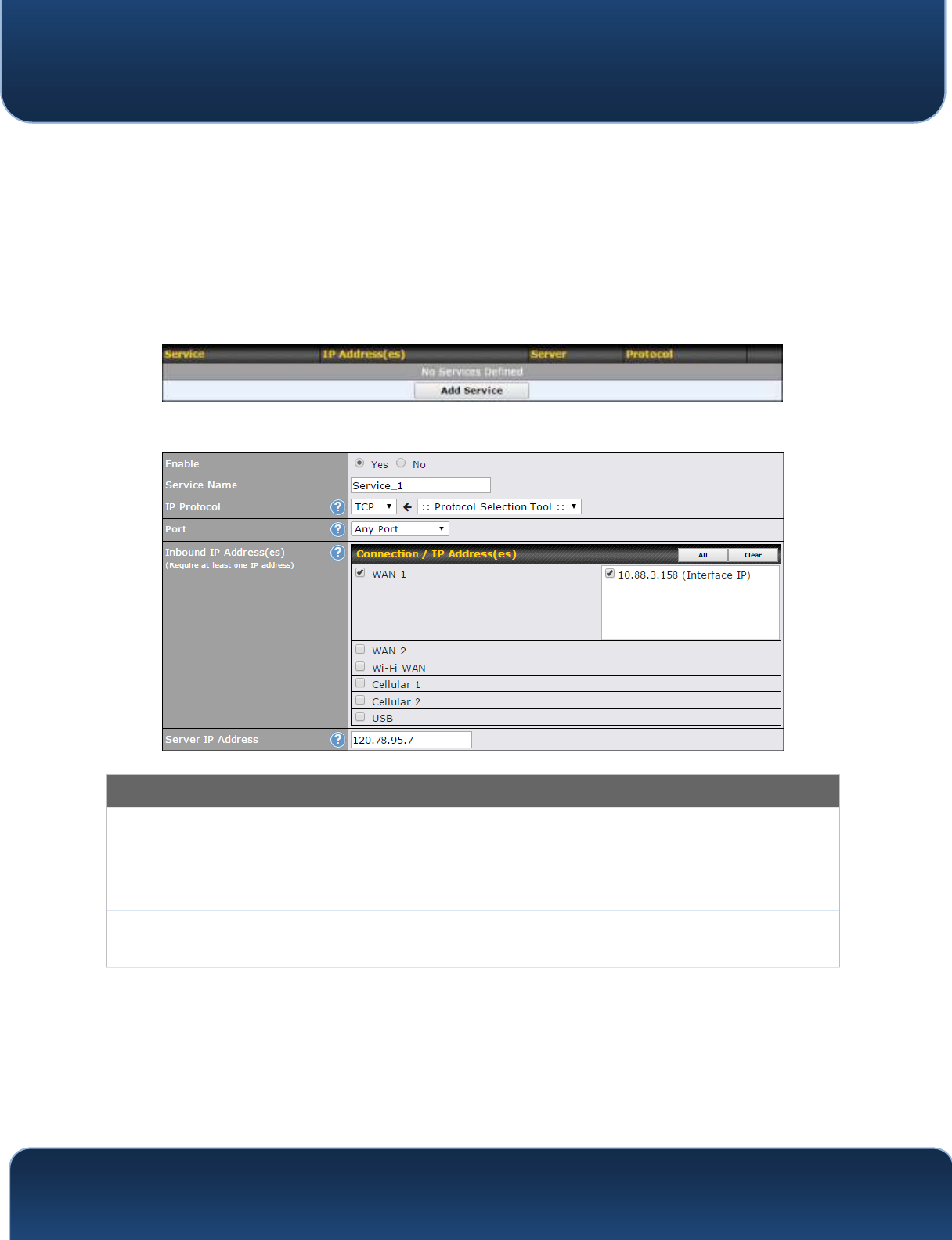
Pepwave MAX and Surf User Manual
http://www.pepwave.com
116
Copyright @ 2018 Pepwave
16 Inbound Access
16.1 Port Forwarding Service
Pepwave routers can act as a firewall that blocks, by default, all inbound
access from the Internet. By using port forwarding, Internet users can access
servers behind the Pepwave router. Inbound port forwarding rules can be
defined at Advanced>Port Forwarding.
To define a new service, click Add Service.
Port Forwarding Settings
Enable
This setting specifies whether the inbound service takes effect. When Enable is
checked, the inbound service takes effect: traffic is matched and actions are taken by
the Pepwave router based on the other parameters of the rule. When this setting is
disabled, the inbound service does not take effect: the Pepwave router disregards the
other parameters of the rule.
Service
Name
This setting identifies the service to the system administrator. Valid values for this setting
consist of only alphanumeric and underscore “_” characters.
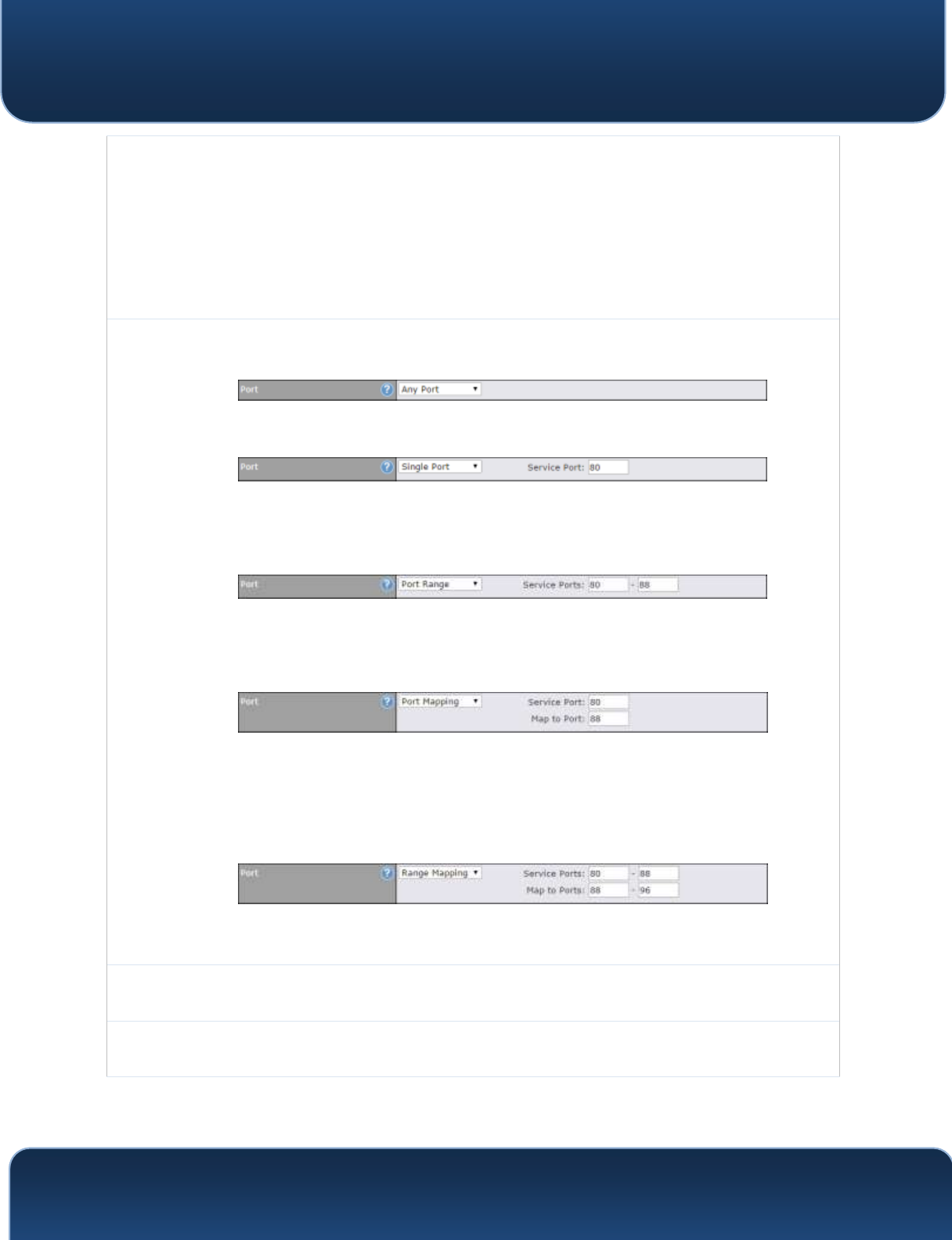
Pepwave MAX and Surf User Manual
http://www.pepwave.com
117
Copyright @ 2018 Pepwave
IP Protocol
The IP Protocol setting, along with the Port setting, specifies the protocol of the service
as TCP, UDP, ICMP, or IP. Traffic that is received by the Pepwave router via the specified
protocol at the specified port(s) is forwarded to the LAN hosts specified by the Servers
setting. Please see below for details on the Port and Servers settings. Alternatively, the
Protocol Selection Tool drop-down menu can be used to automatically fill in the
protocol and a single port number of common Internet services (e.g. HTTP, HTTPS, etc.).
After selecting an item from the Protocol Selection Tool drop-down menu, the protocol
and port number remain manually modifiable.
Port
The Port setting specifies the port(s) that correspond to the service, and can be
configured to behave in one of the following manners:
Any Port, Single Port, Port Range, Port Map, and Range Mapping
Any Port: all traffic that is received by the Pepwave router via the specified protocol is
forwarded to the servers specified by the Servers setting. For example, with IP Protocol
set to TCP, and Port set to Any Port, all TCP traffic is forwarded to the configured servers.
Single Port: traffic that is received by the Pepwave router via the specified protocol at
the specified port is forwarded via the same port to the servers specified by the Servers
setting. For example, with IP Protocol set to TCP, and Port set to Single Port and Service
Port 80, TCP traffic received on port 80 is forwarded to the configured servers via port
80.
Port Range: traffic that is received by the Pepwave router via the specified protocol at
the specified port range is forwarded via the same respective ports to the LAN hosts
specified by the Servers setting. For example, with IP Protocol set to TCP, and Port set to
Port Range and Service Ports 80-88, TCP traffic received on ports 80 through 88 is
forwarded to the configured servers via the respective ports.
Port Mapping: traffic that is received by Pepwave router via the specified protocol at
the specified port is forwarded via a different port to the servers specified by the
Servers setting.
For example, with IP Protocol set to TCP, and Port set to Port Mapping, Service Port 80,
and Map to Port 88, TCP traffic on port 80 is forwarded to the configured servers via port
88.
(Please see below for details on the Servers setting.)
Range Mapping: traffic that is received by the Pepwave router via the specified
protocol at the specified port range is forwarded via a different port to the servers
specified by the Servers setting.
Inbound IP
Address(es)
This setting specifies the WAN connections and Internet IP address(es) from which the
service can be accessed.
Server IP
Address
This setting specifies the LAN IP address of the server that handles the requests for the
service.
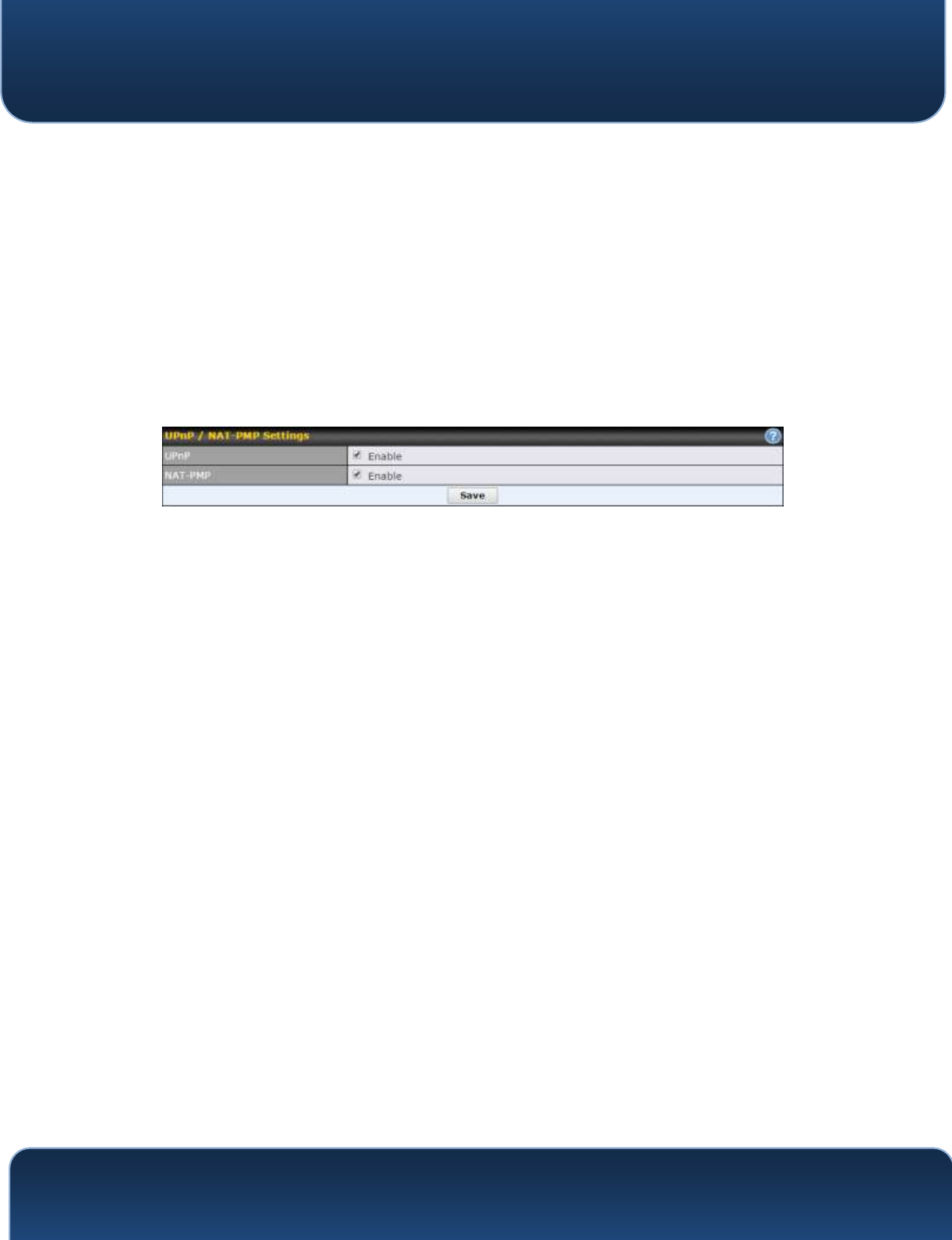
Pepwave MAX and Surf User Manual
http://www.pepwave.com
118
Copyright @ 2018 Pepwave
16.1.1 UPnP / NAT-PMP Settings
UPnP and NAT-PMP are network protocols which allow a computer connected
to the LAN port to automatically configure the router to allow parties on the
WAN port to connect to itself. That way, the process of inbound port forwarding
becomes automated.
When a computer creates a rule using these protocols, the specified TCP/UDP
port of all WAN connections' default IP address will be forwarded.
Check the corresponding box(es) to enable UPnP and/or NAT-PMP. Enable
these features only if you trust the computers connected to the LAN ports.
When the options are enabled, a table listing all the forwarded ports under
these two protocols can be found at Status>UPnP / NAT-PMP.
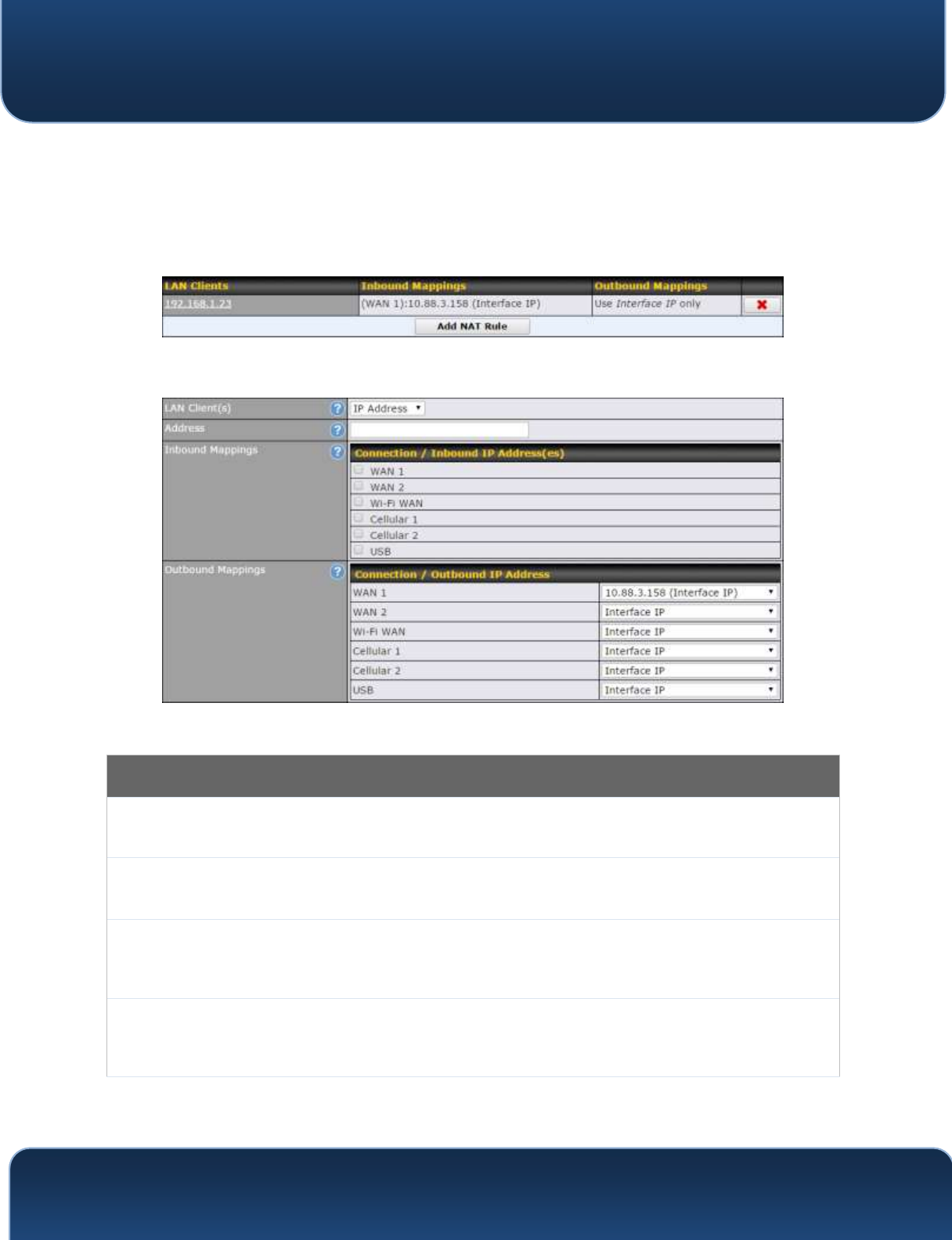
Pepwave MAX and Surf User Manual
http://www.pepwave.com
119
Copyright @ 2018 Pepwave
17 NAT Mappings
NAT mappings allow IP address mapping of all inbound and outbound NAT’dt
raffic to and from an internal client IP address. Settings to configure NAT
mappings are located at Advanced>NAT Mappings.
To add a rule for NAT mappings, click Add NAT Rule.
NAT Mapping Settings
LAN
Client(s)
NAT mapping rules can be defined for a single LAN IP Address, an IP Range, or an
IP Network.
Address
This refers to the LAN host’s private IP address. The system maps this address to a
number of public IP addresses (specified below) in order to facilitate inbound
and outbound traffic. This option is only available when IP Address is selected.
Range
The IP range is a contiguous group of private IP addresses used by the LAN host.
The system maps these addresses to a number of public IP addresses (specified
below) to facilitate outbound traffic. This option is only available when IP Range is
selected.
Network
The IP network refers to all private IP addresses and ranges managed by the LAN
host. The system maps these addresses to a number of public IP addresses
(specified below) to facilitate outbound traffic. This option is only available when
IP Network is selected.
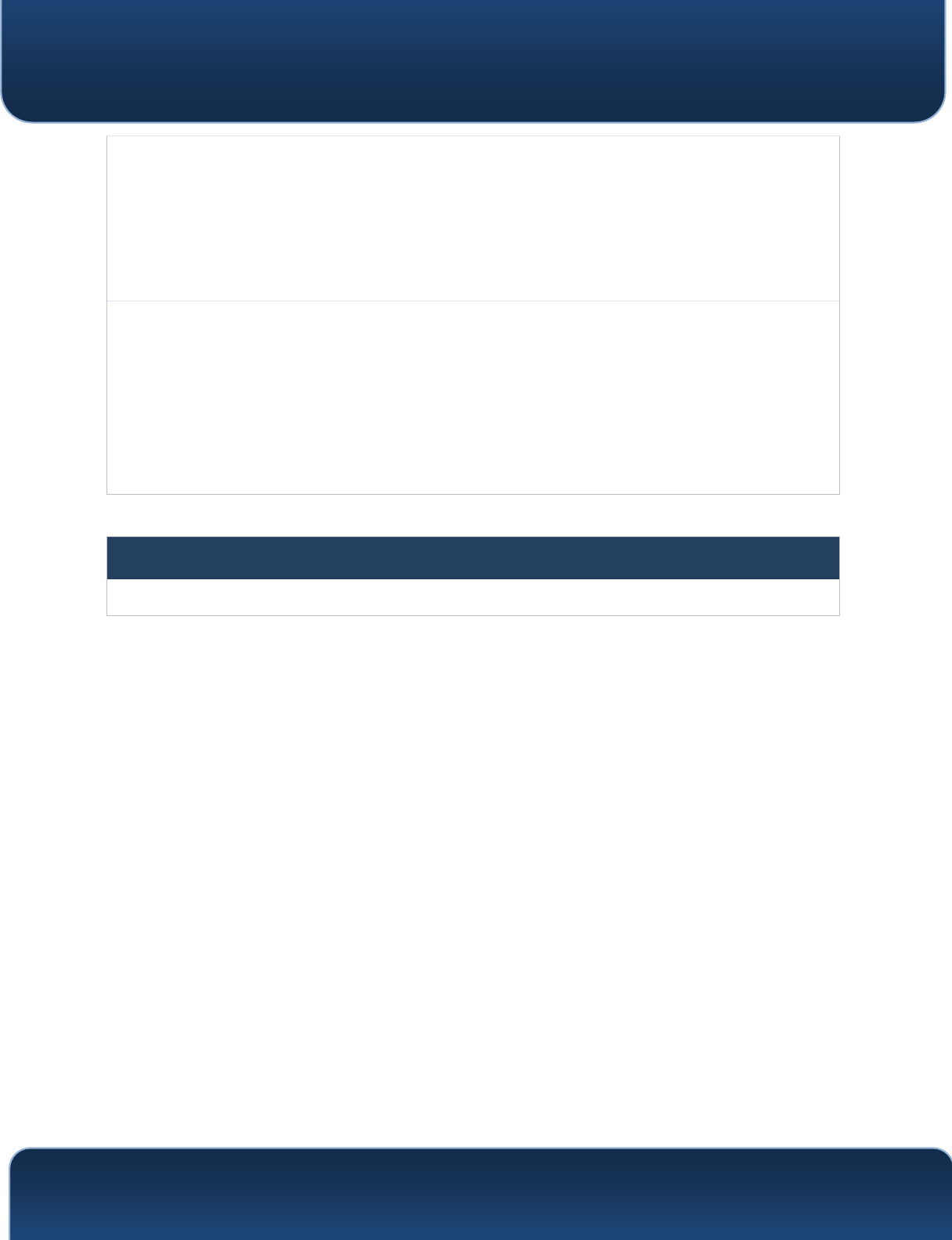
Pepwave MAX and Surf User Manual
http://www.pepwave.com
120
Copyright @ 2018 Pepwave
Inbound
Mappings
This setting specifies the WAN connections and corresponding WAN-specific
Internet IP addresses on which the system should bind. Any access to the
specified WAN connection(s) and IP address(es) will be forwarded to the LAN
host. This option is only available when IP Address is selected in the LAN Client(s)
field.
Note that inbound mapping is not needed for WAN connections in drop-in mode
or IP forwarding mode. Also note that each WAN IP address can be associated to
one NAT mapping only.
Outbound
Mappings
This setting specifies the WAN IP addresses that should be used when an IP
connection is made from a LAN host to the Internet. Each LAN host in an IP range
or IP network will be evenly mapped to one of each selected WAN's IP addresses
(for better IP address utilization) in a persistent manner (for better application
compatibility).
Note that if you do not want to use a specific WAN for outgoing accesses, you
should still choose default here, then customize the outbound access rule in the
Outbound Policy section. Also note that WAN connections in drop-in mode or IP
forwarding mode are not shown here.
Click Save to save the settings when configuration has been completed.
Important Note
Inbound firewall rules override the Inbound Mappings settings.
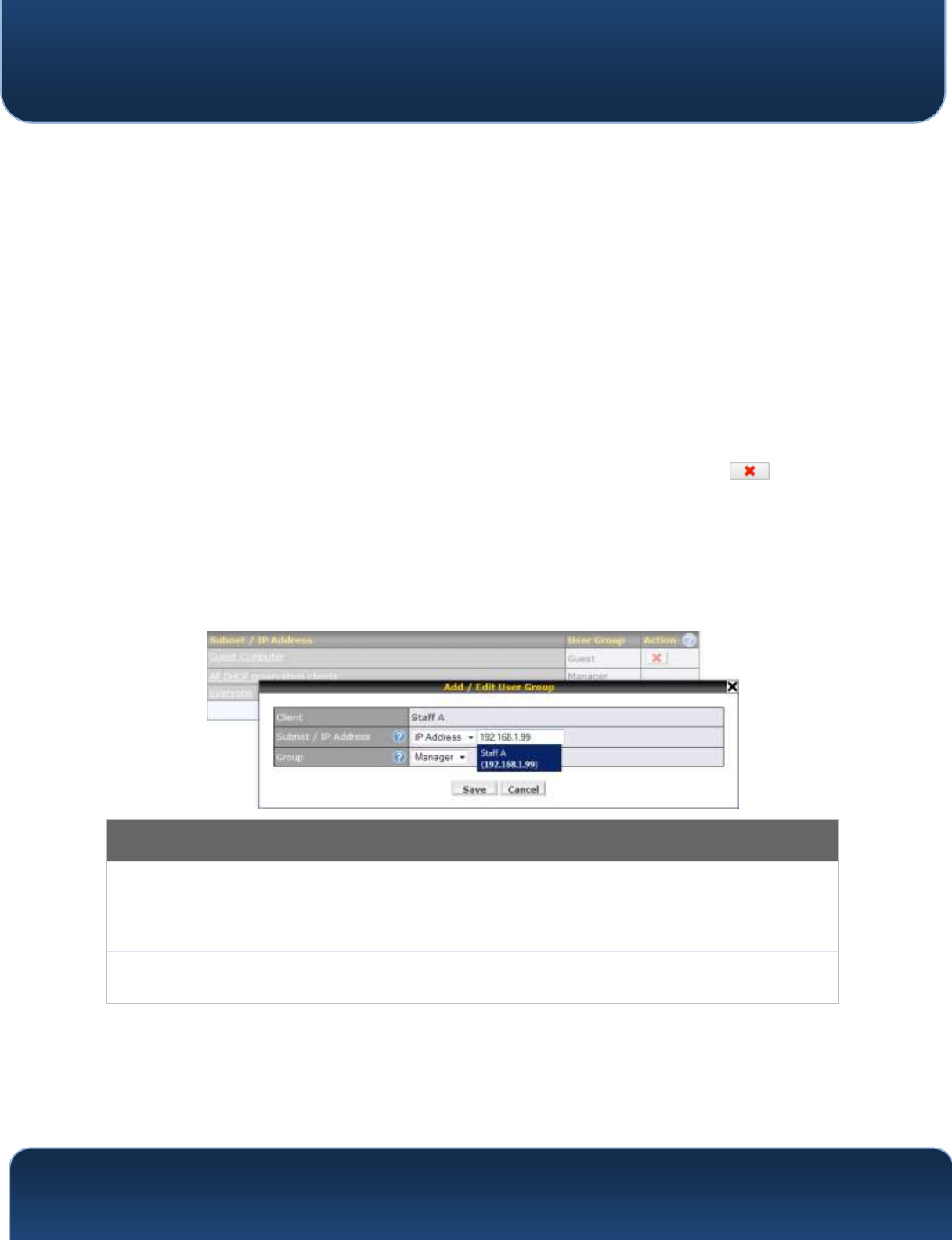
Pepwave MAX and Surf User Manual
http://www.pepwave.com
121
Copyright @ 2018 Pepwave
18 QoS
18.1 User Groups
LAN and PPTP clients can be categorized into three user groups: Manager, Staff,
and Guest. This menu allows you to define rules and assign client IP addresses or
subnets to a user group. You can apply different bandwidth and traffic
prioritization policies on each user group in the Bandwidth
Control and Application sections (note that the options available here vary by
model).
The table is automatically sorted by rule precedence. The smaller and more
specific subnets are put towards the top of the table and have higher
precedence; larger and less specific subnets are placed towards the bottom.
Click the Add button to define clients and their user group. Click the button
to remove the defined rule. Two default rules are pre-defined and put at the
bottom. They are All DHCP reservation clients and Everyone, and they cannot
be removed. The All DHCP reservation client represents the LAN clients defined
in the DHCP Reservation table on the LAN settings page. Everyone represents all
clients that are not defined in any rule above. Click on a rule to change its
group.
Add / Edit User Group
Subnet / IP
Address
From the drop-down menu, choose whether you are going to define the
client(s) by an IP Address or a Subnet. If IP Address is selected, enter a name
defined in DHCP reservation table or a LAN client's IP address. If Subnet is
selected, enter a subnet address and specify its subnet mask.
Group
This field is to define which User Group the specified subnet / IP address belongs
to.
Once users have been assigned to a user group, their internet traffic will be
restricted by rules defined for that particular group. Please refer to the following
two sections for details.
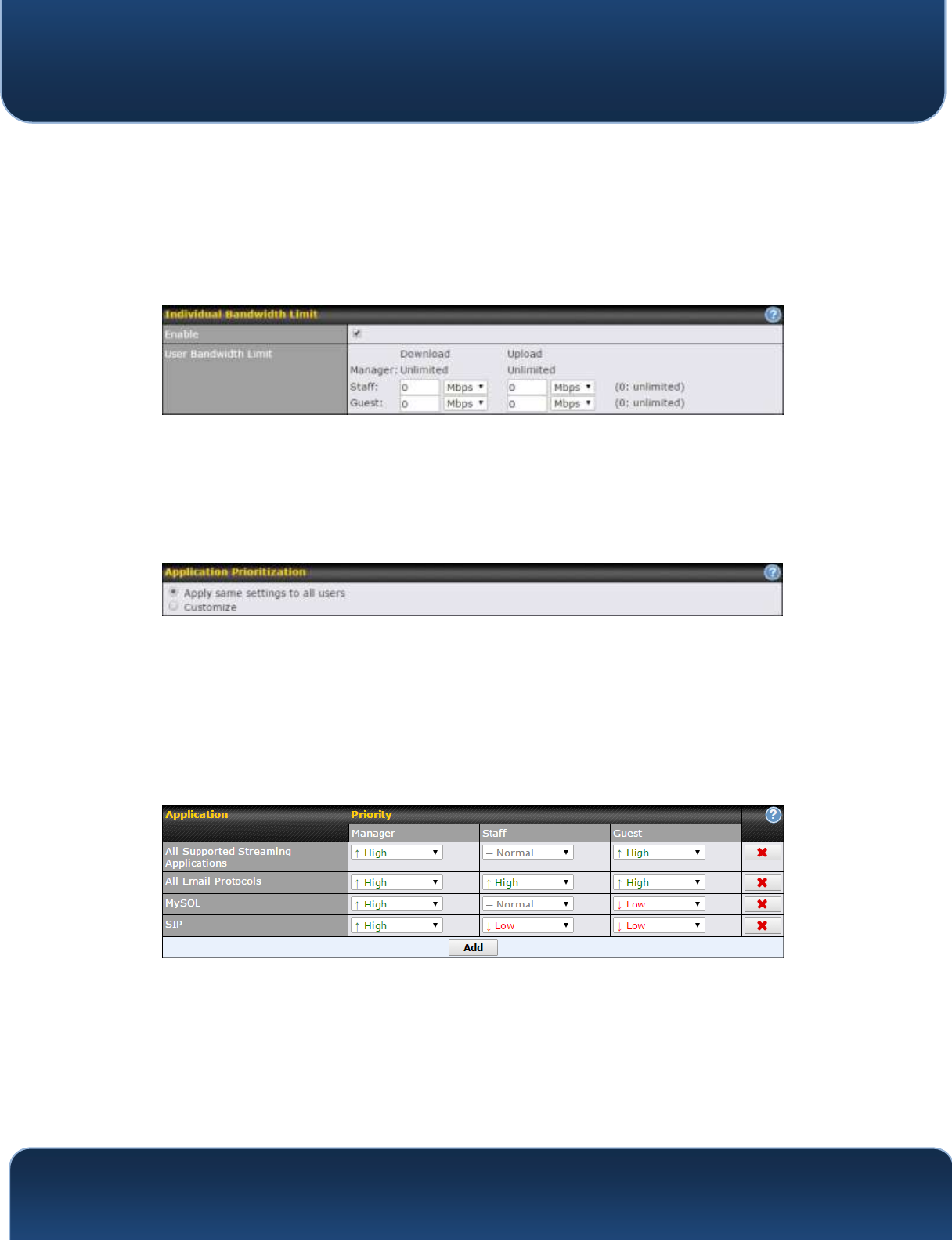
Pepwave MAX and Surf User Manual
http://www.pepwave.com
122
Copyright @ 2018 Pepwave
18.2 Bandwidth Control
You can define a maximum download speed (over all WAN connections) and
upload speed (for each WAN connection) that each individual Staff and Guest
member can consume. No limit can be imposed on individual Manager
members. By default, download and upload bandwidth limits are set to
unlimited (set as 0).
18.3 Application
18.3.1 Application Prioritization
On many Pepwave routers, you can choose whether to apply the same
prioritization settings to all user groups or customize the settings for each group.
Three application priority levels can be set: ↑High,━ Normal, and↓Low. Pepwave
routers can detect various application traffic types by inspecting the packet
content. Select an application by choosing a supported application, or by
defining a custom application manually. The priority preference of supported
applications is placed at the top of the table. Custom applications are at the
bottom.
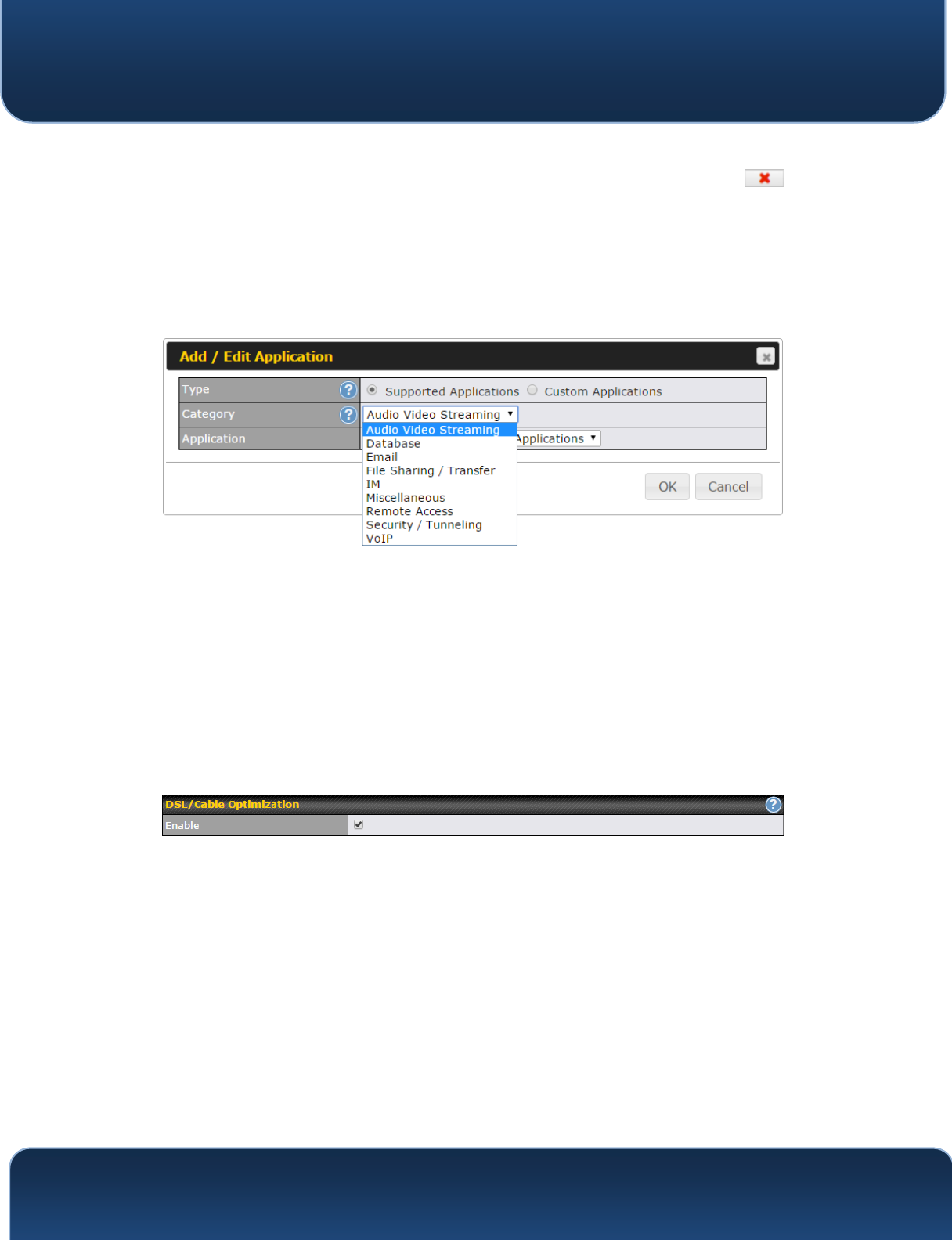
Pepwave MAX and Surf User Manual
http://www.pepwave.com
123
Copyright @ 2018 Pepwave
18.3.2 Prioritization for Custom Applications
Click the Add button to define a custom application. Click the button in
the Action column to delete the custom application in the corresponding row.
When Supported Applications is selected, the Pepwave router will inspect
network traffic and prioritize the selected applications. Alternatively, you can
select Custom Applications and define the application by providing the
protocol, scope, port number, and DSCP value.
18.3.3 DSL/Cable Optimization
DSL/cable-based WAN connections have lower upload bandwidth and higher
download bandwidth. When a DSL/cable circuit's uplink is congested,
the download bandwidth will be affected. Users will not be able to download
data at full speed until the uplink becomes less congested. DSL/Cable
Optimization can relieve such an issue. When it is enabled, the download speed
will become less affected by the upload traffic. By default, this feature is
enabled.
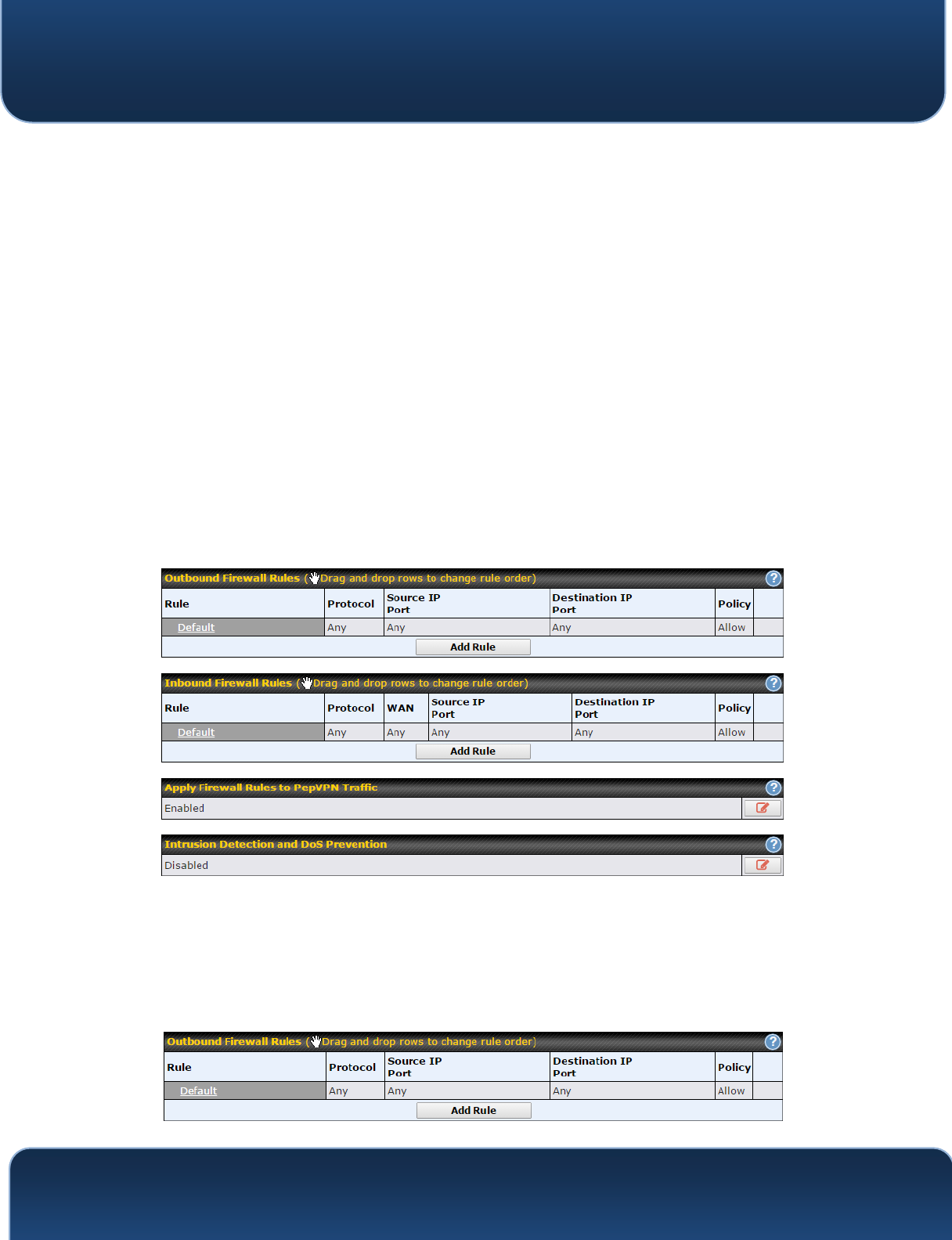
Pepwave MAX and Surf User Manual
http://www.pepwave.com
124
Copyright @ 2018 Pepwave
19 Firewall
A firewall is a mechanism that selectively filters data traffic between the WAN
side (the Internet) and the LAN side of the network. It can protect the local
network from potential hacker attacks, access to offensive websites, and/or
other inappropriate uses.
The firewall functionality of Pepwave routers supports the selective filtering of
data traffic in both directions:
Outbound (LAN to WAN)
Inbound (WAN to LAN)
The firewall also supports the following functionality:
Intrusion detection and DoS prevention
Web blocking
With SpeedFusionTM enabled, the firewall rules also apply to VPN tunneled traffic.
19.1 Outbound and Inbound Firewall Rules
19.1.1 Access Rules
The outbound firewall settings are located at Advanced>Firewall>Access
Rules>Outbound Firewall Rules.
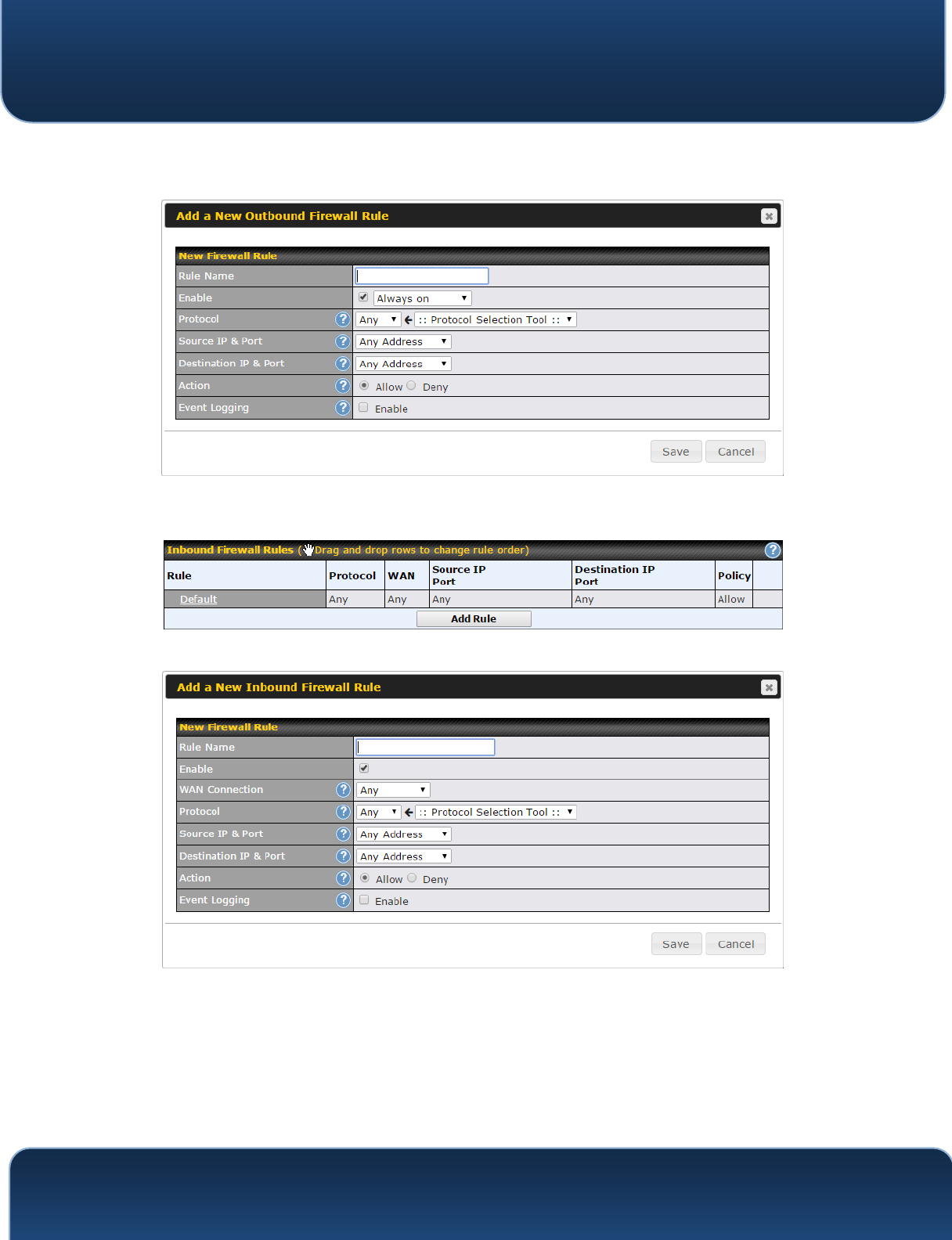
Pepwave MAX and Surf User Manual
http://www.pepwave.com
125
Copyright @ 2018 Pepwave
Click Add Rule to display the following screen:
Inbound firewall settings are located at Advanced>Firewall>Access
Rules>Inbound Firewall Rules.
Click Add Rule to display the following screen:
Rules are matched from top to bottom. If a connection matches any one of the
upper rules, the matching process will stop. If none of the rules match, the
Default rule will be applied. By default, the Default rule is set as Allow for both
outbound and inbound access.
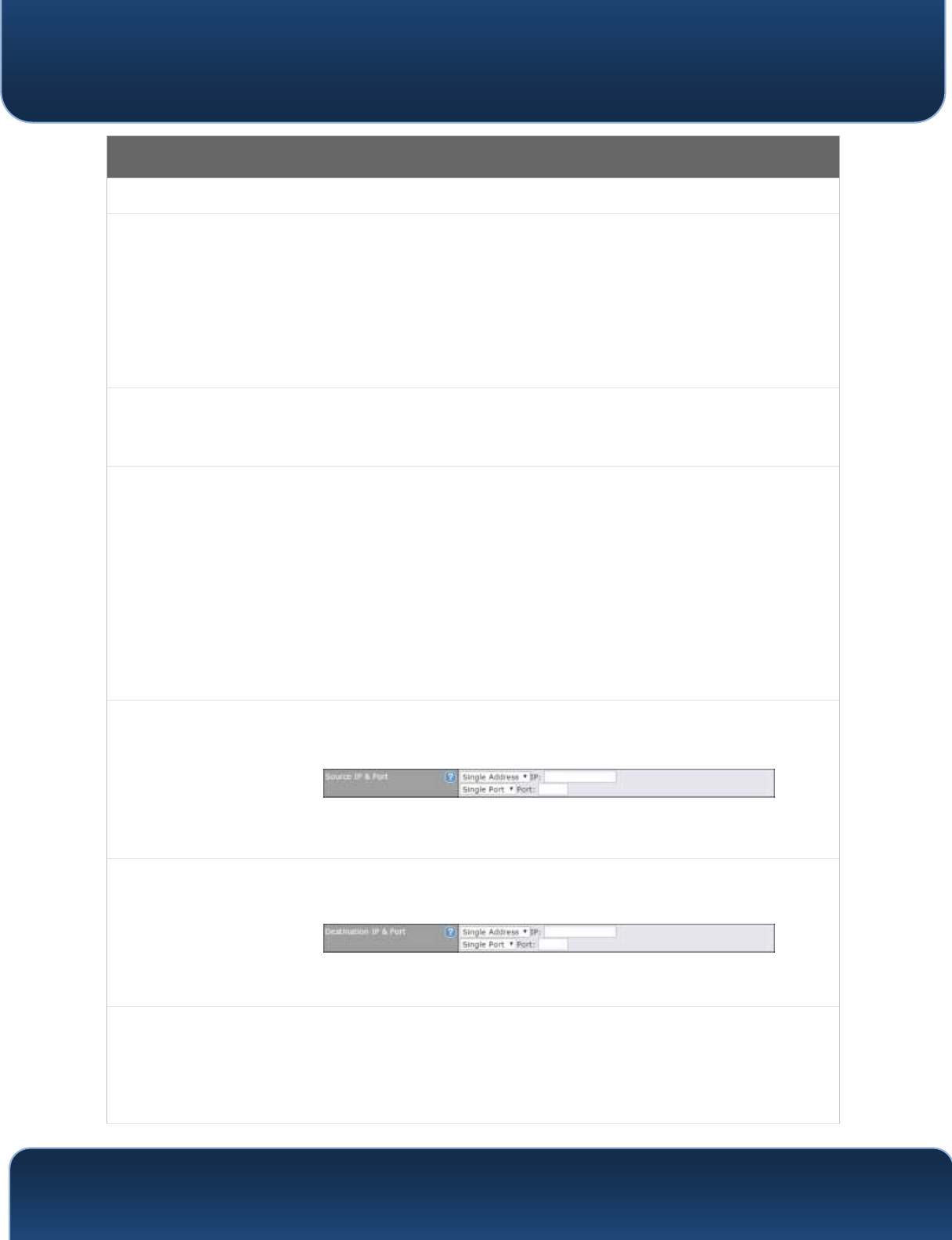
Pepwave MAX and Surf User Manual
http://www.pepwave.com
126
Copyright @ 2018 Pepwave
Inbound / Outbound Firewall Settings
Rule Name
This setting specifies a name for the firewall rule.
Enable
This setting specifies whether the firewall rule should take effect. If the box is
checked, the firewall rule takes effect. If the traffic matches the specified
protocol/IP/port, actions will be taken by the Pepwave router based on the other
parameters of the rule. If the box is not checked, the firewall rule does not take
effect. The Pepwave router will disregard the other parameters of the rule.
Click the dropdown menu next to the checkbox to place this firewall rule on a time
schedule.
WAN
Connection
(Inbound)
Select the WAN connection that this firewall rule should apply to.
Protocol
This setting specifies the protocol to be matched. Via a drop-down menu, the
following protocols can be specified:
TCP
UDP
ICMP
IP
Alternatively, the Protocol Selection Tool drop-down menu can be used to
automatically fill in the protocol and port number of common Internet services
(e.g., HTTP, HTTPS, etc.)
After selecting an item from the Protocol Selection Tool drop-down menu, the
protocol and port number remains manually modifiable.
Source IP & Port
This specifies the source IP address(es) and port number(s) to be matched for the
firewall rule. A single address, or a network, can be specified as the Source IP & Port
setting, as indicated by the following screenshot:
In addition, a single port, or a range of ports, can be specified for the Source IP &
Port settings.
Destination IP &
Port
This specifies the destination IP address(es) and port number(s) to be matched for
the firewall rule. A single address, or a network, can be specified as the Destination
IP & Port setting, as indicated by the following screenshot:
In addition, a single port, or a range of ports, can be specified for the Destination IP
& Port settings.
Action
This setting specifies the action to be taken by the router upon encountering traffic
that matches the both of the following:
Source IP & port
Destination IP & port
With the value of Allow for the Action setting, the matching traffic passes through
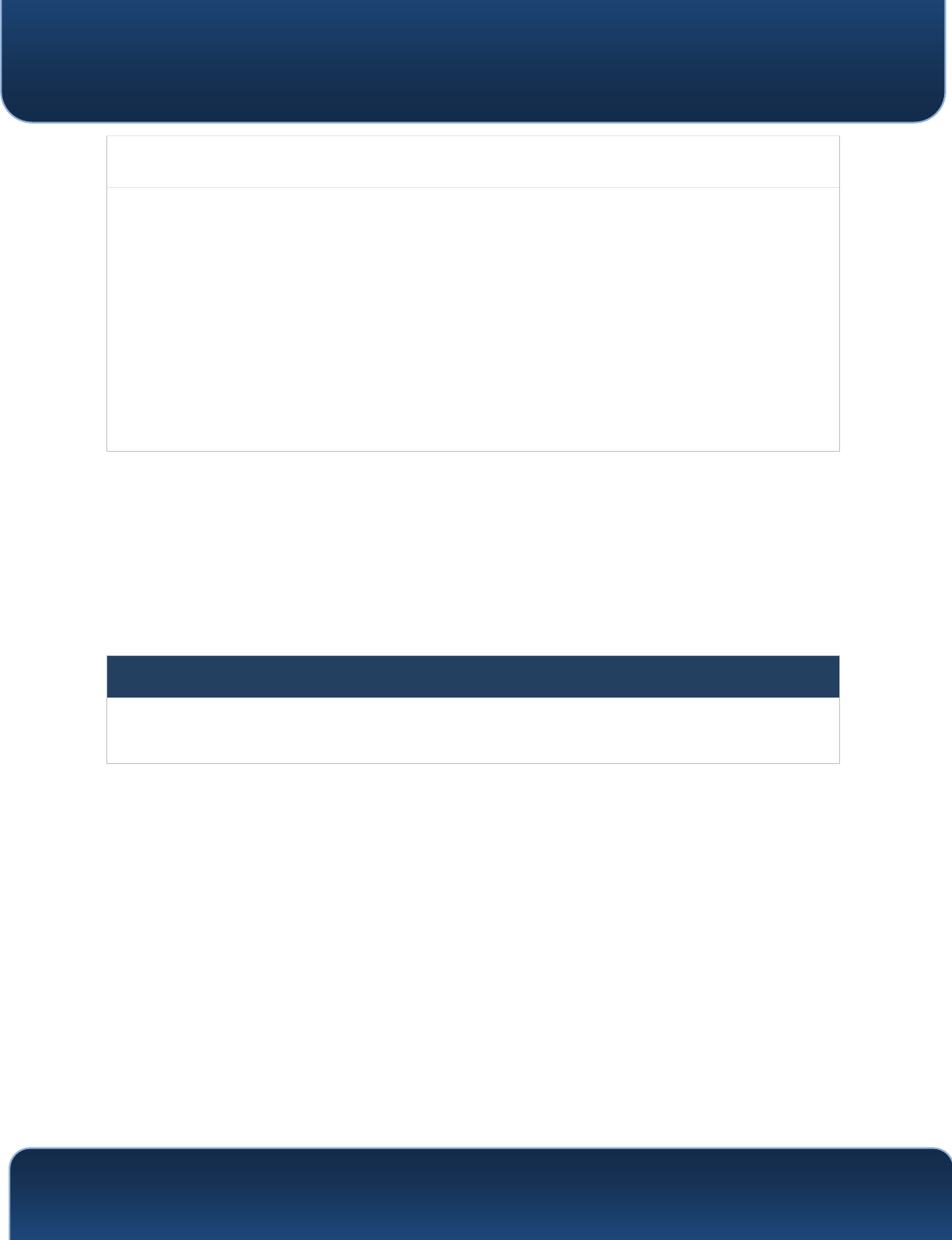
Pepwave MAX and Surf User Manual
http://www.pepwave.com
127
Copyright @ 2018 Pepwave
the router (to be routed to the destination). If the value of the Action setting is set to
Deny, the matching traffic does not pass through the router (and is discarded).
Event Logging
This setting specifies whether or not to log matched firewall events. The logged
messages are shown on the page Status>Event Log. A sample message is as follows:
Aug 13 23:47:44 Denied CONN=Ethernet WAN SRC=20.3.2.1
DST=192.168.1.20 LEN=48 PROTO=TCP SPT=2260 DPT=80
CONN: The connection where the log entry refers to
SRC: Source IP address
DST: Destination IP address
LEN: Packet length
PROTO: Protocol
SPT: Source port
DPT: Destination port
Click Save to store your changes. To create an additional firewall rule, click Add
Rule and repeat the above steps.
To change a rule’s priority, simply drag and drop the rule:
Hold the left mouse button on the rule.
Move it to the desired position.
Drop it by releasing the mouse button.
Tip
If the default inbound rule is set to Allow for NAT-enabled WANs, no inbound Allow firewall rules will be
required for inbound port forwarding and inbound NAT mapping rules. However, if the default inbound
rule is set as Deny, a corresponding Allow firewall rule will be required.
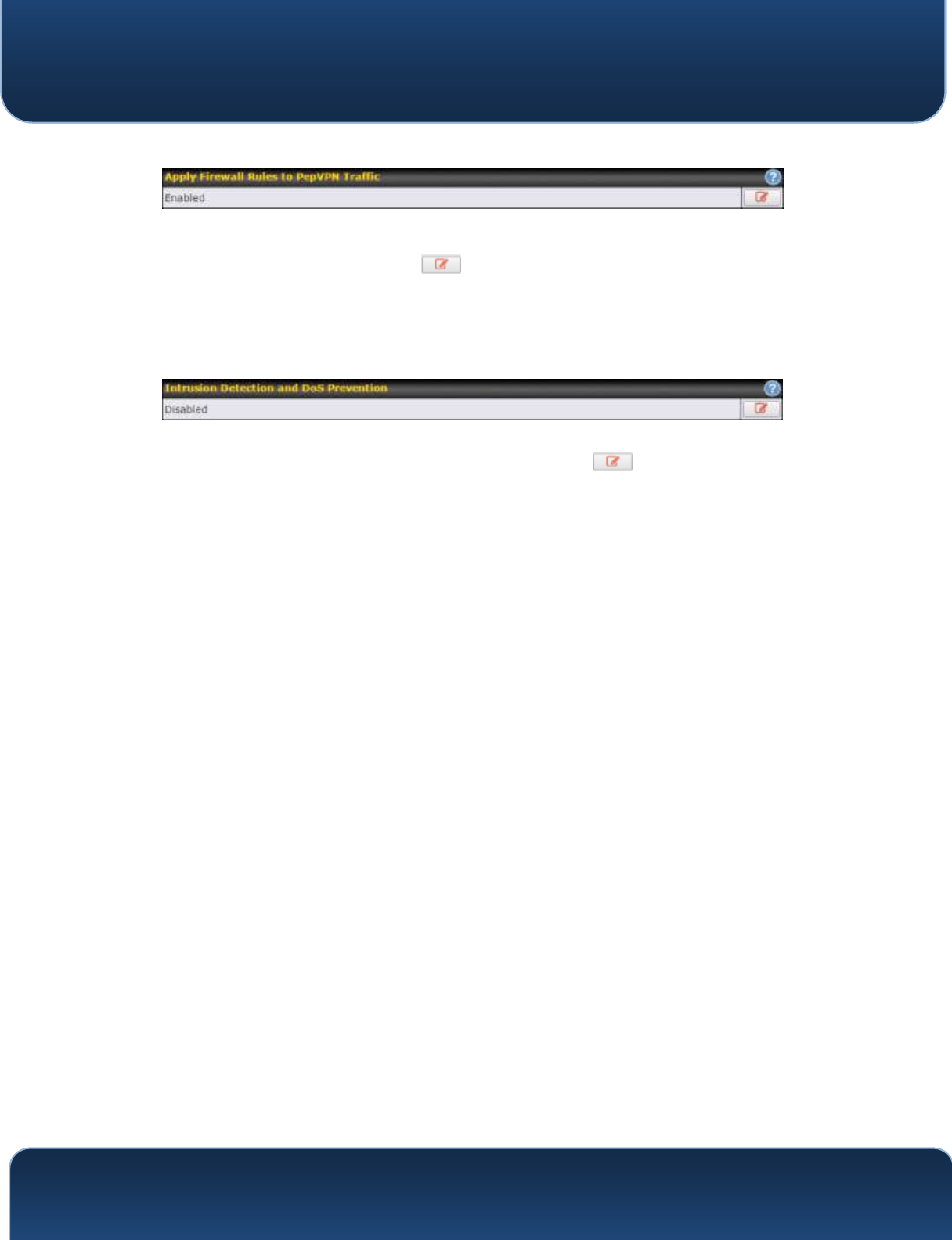
Pepwave MAX and Surf User Manual
http://www.pepwave.com
128
Copyright @ 2018 Pepwave
19.1.2 Apply Firewall Rules to PepVpn Traffic
When this option is enabled, Outbound Firewall Rules will be applied to PepVPN
traffic. To turn on this feature, click , check the Enable check box, and press
the Save button.
19.1.3 Intrusion Detection and DoS Prevention
Pepwave routers can detect and prevent intrusions and denial-of-service (DoS)
attacks from the Internet. To turn on this feature, click , check the Enable
check box, and press the Save button.
When this feature is enabled, the Pepwave router will detect and prevent the
following kinds of intrusions and denial-of-service attacks.
Port scan
o NMAP FIN/URG/PSH
o Xmas tree
o Another Xmas tree
o Null scan
o SYN/RST
o SYN/FIN
SYN flood prevention
Ping flood attack prevention
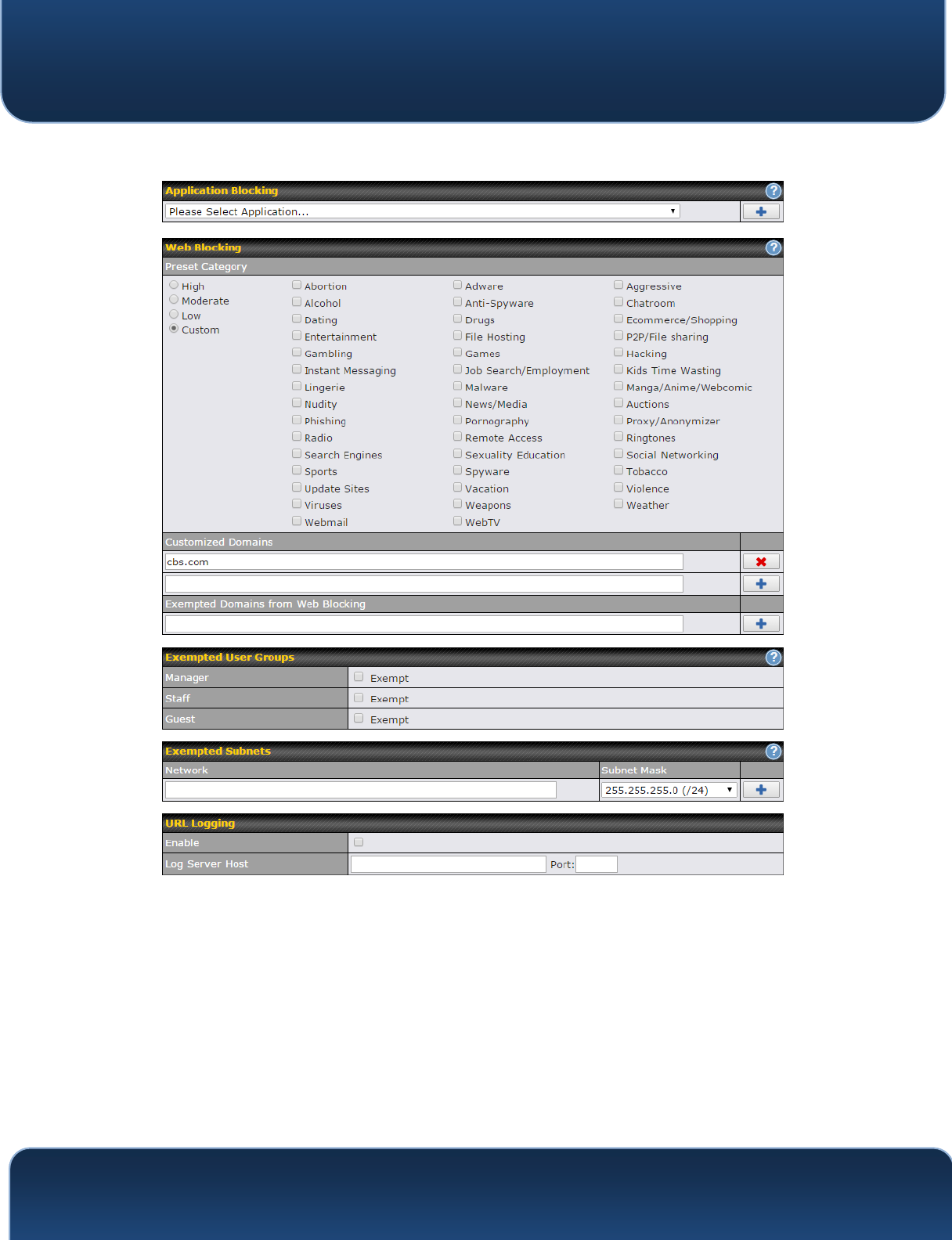
Pepwave MAX and Surf User Manual
http://www.pepwave.com
129
Copyright @ 2018 Pepwave
19.2 Content Blocking
19.2.1 Application Blocking
Choose applications to be blocked from LAN/PPTP/PepVPN peer clients' access,
except for those on the Exempted User Groups or Exempted Subnets defined
below.
19.2.2 Web Blocking
Defines web site domain names to be blocked from LAN/PPTP/PepVPN peer
clients' access except for those on the Exempted User Groups or Exempted
Subnets defined below.

Pepwave MAX and Surf User Manual
http://www.pepwave.com
130
Copyright @ 2018 Pepwave
If "foobar.com" is entered, any web site with a host name ending in foobar.com
will be blocked, e.g. www.foobar.com, foobar.com, etc. However,
"myfoobar.com" will not be blocked.
You may enter the wild card ".*" at the end of a domain name to block any web
site with a host name having the domain name in the middle. If you enter
"foobar.*", then "www.foobar.com", "www.foobar.co.jp", or "foobar.co.uk" will be
blocked. Placing the wild card in any other position is not supported.
The device will inspect and look for blocked domain names on all HTTP traffic.
Secure web (HTTPS) traffic is not supported.
19.2.3 Customized Domains
Enter an appropriate website address, and the Peplink Balance will block and
disallow LAN/PPTP/SpeedFusionTM peer clients to access these websites.
Exceptions can be added using the instructions in Sections 20.1.3.2 and 20.1.3.3.
You may enter the wild card ".*" at the end of a domain name to block any web
site with a host name having the domain name in the middle. For example, If
you enter "foobar.*," then "www.foobar.com," "www.foobar.co.jp," or
"foobar.co.uk" will be blocked. Placing the wild card in any other position is not
supported.
The Peplink Balance will inspect and look for blocked domain names on all HTTP
traffic. Secure web (HTTPS) traffic is not supported.
19.2.4 Exempted User Groups
Check and select pre-defined user group(s) who can be exempted from the
access blocking rules. User groups can be defined at QoS>User Groups section.
Please refer to Section 17.1 for details.
19.2.5 Exempted Subnets
With the subnet defined in the field, clients on the particular subnet(s) can be
exempted from the access blocking rules.
19.2.6 URL Logging
Click enable, and the enter the ip address and port (if applicable) where your
remote syslog server is located.
19.3 OSPF & RIPv2
The Peplink Balance supports OSPF and RIPv2 dynamic routing protocols. Click the
Network tab from the top bar, and then click the OSPF & RIPv2 item on the sidebar
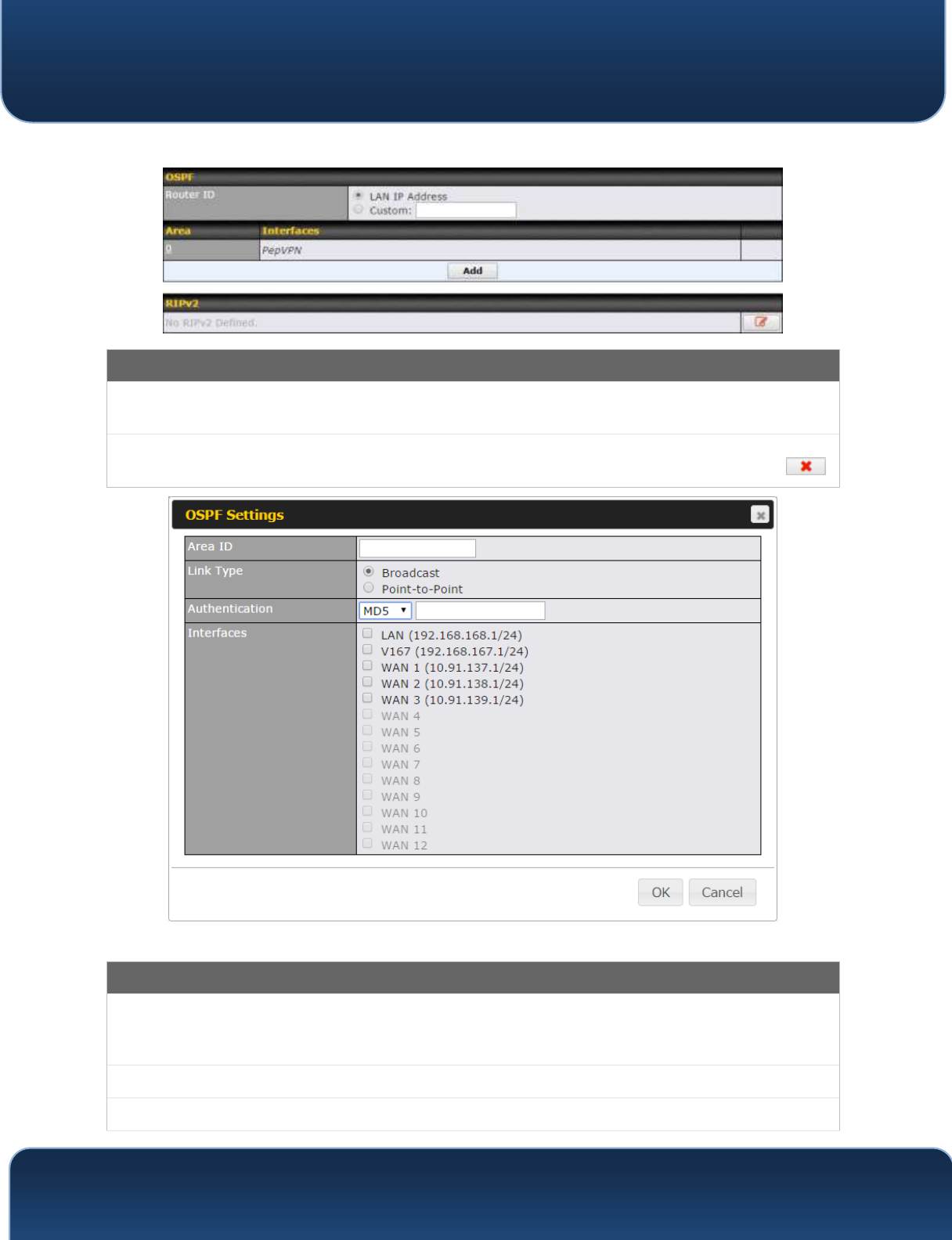
Pepwave MAX and Surf User Manual
http://www.pepwave.com
131
Copyright @ 2018 Pepwave
to reach the following menu:
OSPF
Router ID
This field determines the ID of the router. By default, this is specified as the LAN IP
address. If you want to specify your own ID, enter it in the Custom field.
Area
This is an overview of the OSPFv2 areas you have defined. Click on the area name
to configure it. To set a new area, click Add. To delete an existing area, click .
OSPF Settings
Area ID
Determine the name of your Area ID to apply to this group. Machines linked to this
group will send and receive related OSPF packets, while unlinked machines will
ignore it.
Link Type
Choose the network type that this area will use.
Authentication
Choose an authentication method, if one is used, from this drop-down menu.
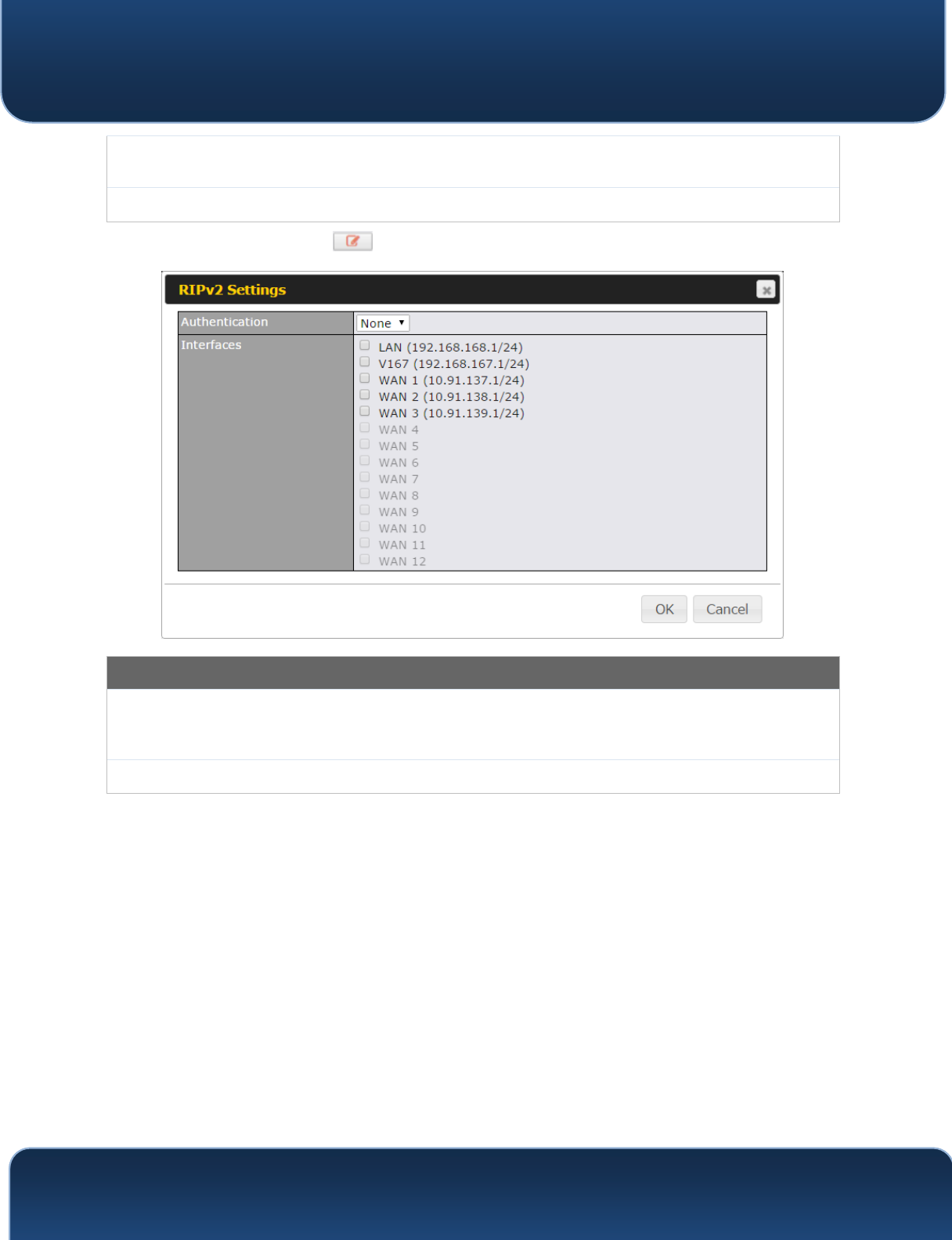
Pepwave MAX and Surf User Manual
http://www.pepwave.com
132
Copyright @ 2018 Pepwave
Available options are MD5 and Text. Enter the authentication key next to the drop-
down menu.
Interfaces
Determine which interfaces this area will use to listen to and deliver OSPF packets
To access RIPv2 settings, click .
RIPv2 Settings
Authentication
Choose an authentication method, if one is used, from this drop-down menu.
Available options are MD5 and Text. Enter the authentication key next to the drop-
down menu.
Interfaces
Determine which interfaces this group will use to listen to and deliver RIPv2 packets.
19.4 Remote User Access
a Networks routed by a Peplink Balance can be remotely accessed via L2TP with
IPsec or PPTP. To configure this feature, navigate to Network > Remote User
Access
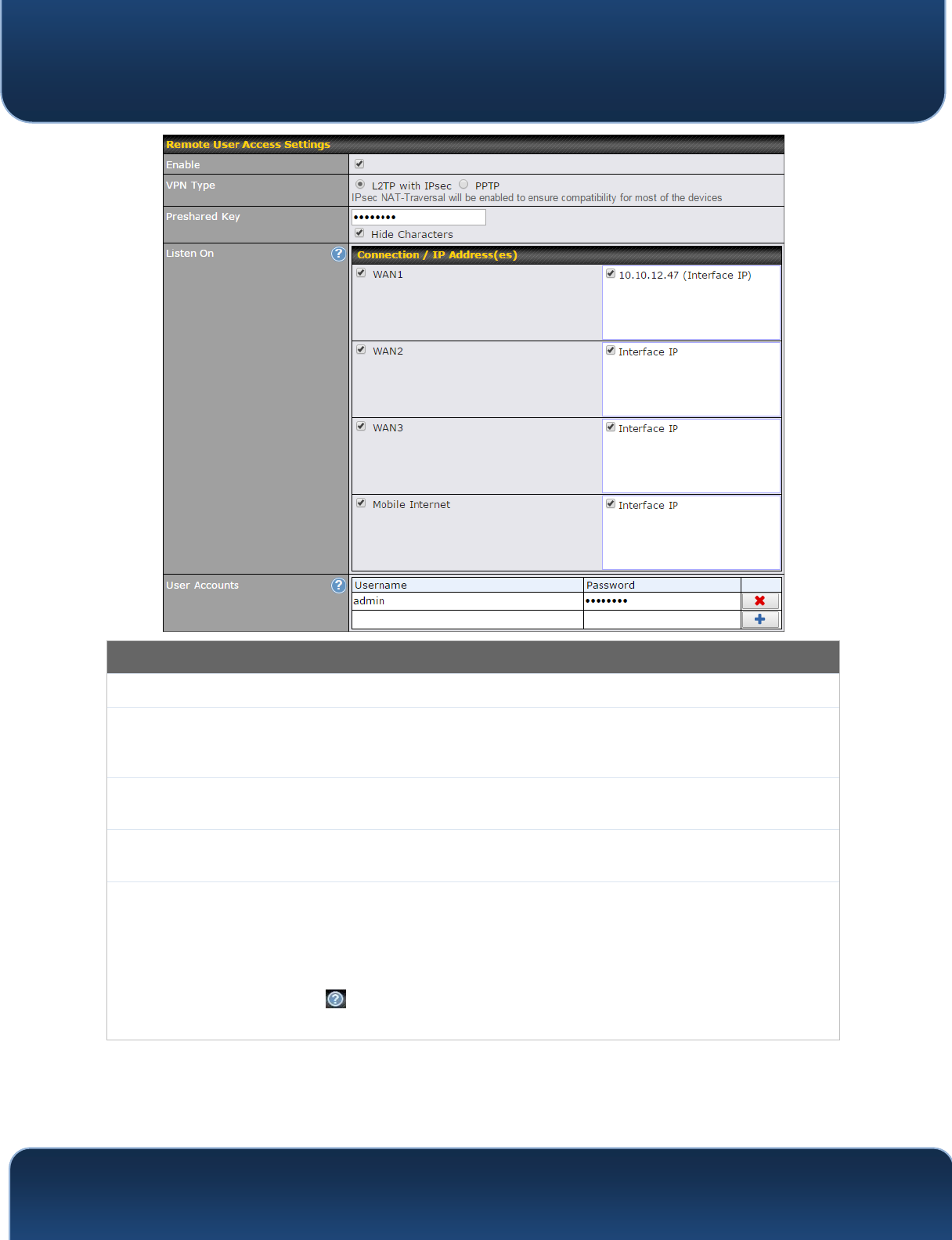
Pepwave MAX and Surf User Manual
http://www.pepwave.com
133
Copyright @ 2018 Pepwave
Remote User Access Settings
Enable
Click the checkbox to enable Remote User Access.
VPN Type
Determine whether remote devices can connect to the Balance using L2TP with
IPsec or PPTP. For greater security, we recommend you connect using L2TP with
IPsec.
Preshared Key
Enter your preshared key in the text field. Please note that remote devices will need
this preshared key to access the Balance.
Listen On
This setting is for specifying the WAN IP addresses where the PPTP server of the router
should listen on.
User Accounts
This setting allows you to define the PPTP User Accounts. Click Add to input
username and password to create an account. After adding the user accounts,
you can click on a username to edit the account password. Click the button X to
delete the account in its corresponding row.
Click the button to switch to enters user accounts by pasting the information
in.CSV format.
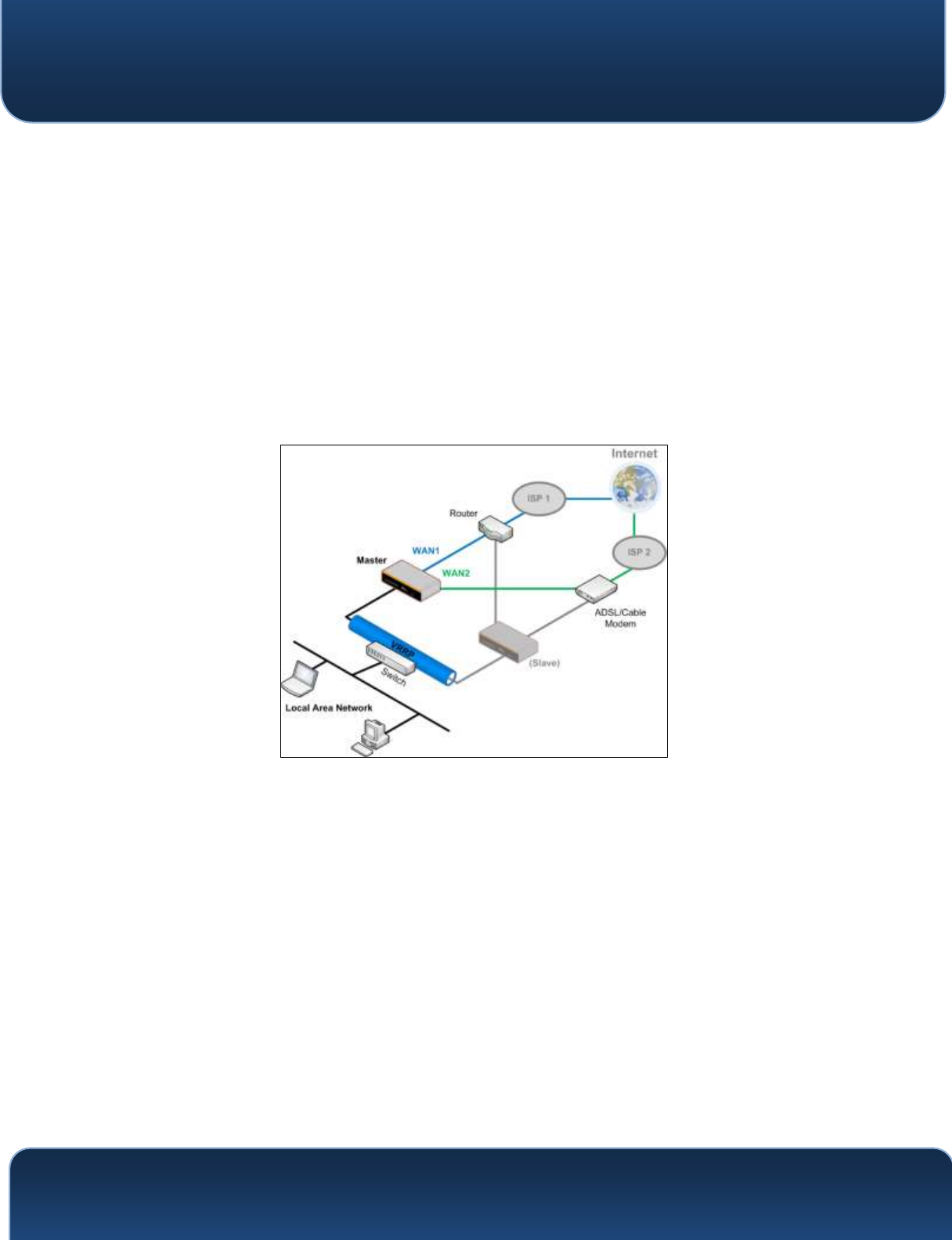
Pepwave MAX and Surf User Manual
http://www.pepwave.com
134
Copyright @ 2018 Pepwave
Miscellaneous Settings
The miscellaneous settings include configuration for high availability, PPTP server,
service forwarding, and service passthrough.
19.5 High Availability
Many Pepwave routers support high availability (HA) configurations via an open
standard virtual router redundancy protocol (VRRP, RFC 3768). In an HA
configuration, two Pepwave routers provide redundancy and failover in a
master-slave arrangement. In the event that the master unit is down, the slave
unit becomes active. High availability will be disabled automatically where
there is a drop-in connection configured on a LAN bypass port.
In the diagram, the WAN ports of each Pepwave router connect to the router
and to the modem. Both Pepwave routers connect to the same LAN switch via
a LAN port.
An elaboration on the technical details of the implementation of the virtual
router redundancy protocol (VRRP, RFC 3768) by Pepwave routers follows:
In an HA configuration, the two Pepwave routers communicate with each
other using VRRP over the LAN.
The two Pepwave routers broadcast heartbeat signals to the LAN at a
frequency of one heartbeat signal per second.
In the event that no heartbeat signal from the master Pepwave router is
received in 3 seconds (or longer) since the last heartbeat signal, the slave
Pepwave router becomes active.
The slave Pepwave router initiates the WAN connections and binds to a
previously configured LAN IP address.
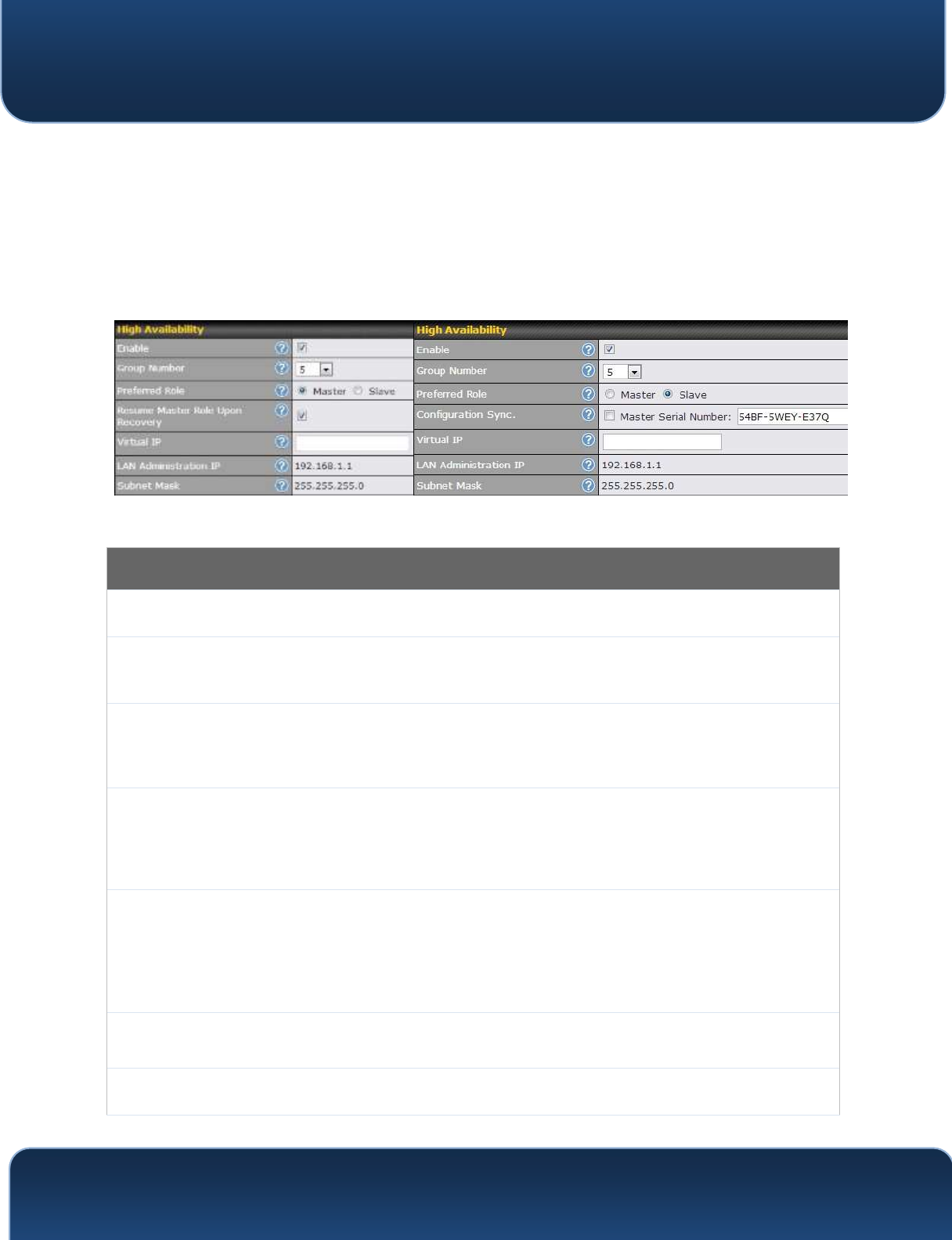
Pepwave MAX and Surf User Manual
http://www.pepwave.com
135
Copyright @ 2018 Pepwave
At a subsequent point when the master Pepwave router recovers, it will
once again become active.
You can configure high availability at Advanced>Misc. Settings>High
Availability.
Interface for Master Router
Interface for Slave Router
High Availability
Enable
Checking this box specifies that the Pepwave router is part of a high availability
configuration.
Group
Number
This number identifies a pair of Pepwave routers operating in a high availability
configuration. The two Pepwave routers in the pair must have the same Group
Number value.
Preferred Role
This setting specifies whether the Pepwave router operates in master or slave mode.
Click the corresponding radio button to set the role of the unit. One of the units in the
pair must be configured as the master, and the other unit must be configured as the
slave.
Resume
Master Role
Upon
Recovery
This option is displayed when Master mode is selected in Preferred Role. If this option is
enabled, once the device has recovered from an outage, it will take over and
resume its Master role from the slave unit.
Configuration
Sync.
This option is displayed when Slave mode is selected in Preferred Role. If this option is
enabled and the Master Serial Number entered matches with the actual master
unit's, the master unit will automatically transfer the configuration to this unit. Please
make sure the LAN IP Address and the Subnet Mask fields are set correctly in the LAN
settings page. You can refer to the Event Log for the configuration synchronization
status.
Master Serial
Number
If Configuration Sync. is checked, the serial number of the master unit is required here
for the feature to work properly.
Virtual IP
The HA pair must share the same Virtual IP. The Virtual IP and the LAN Administration
IP must be under the same network.
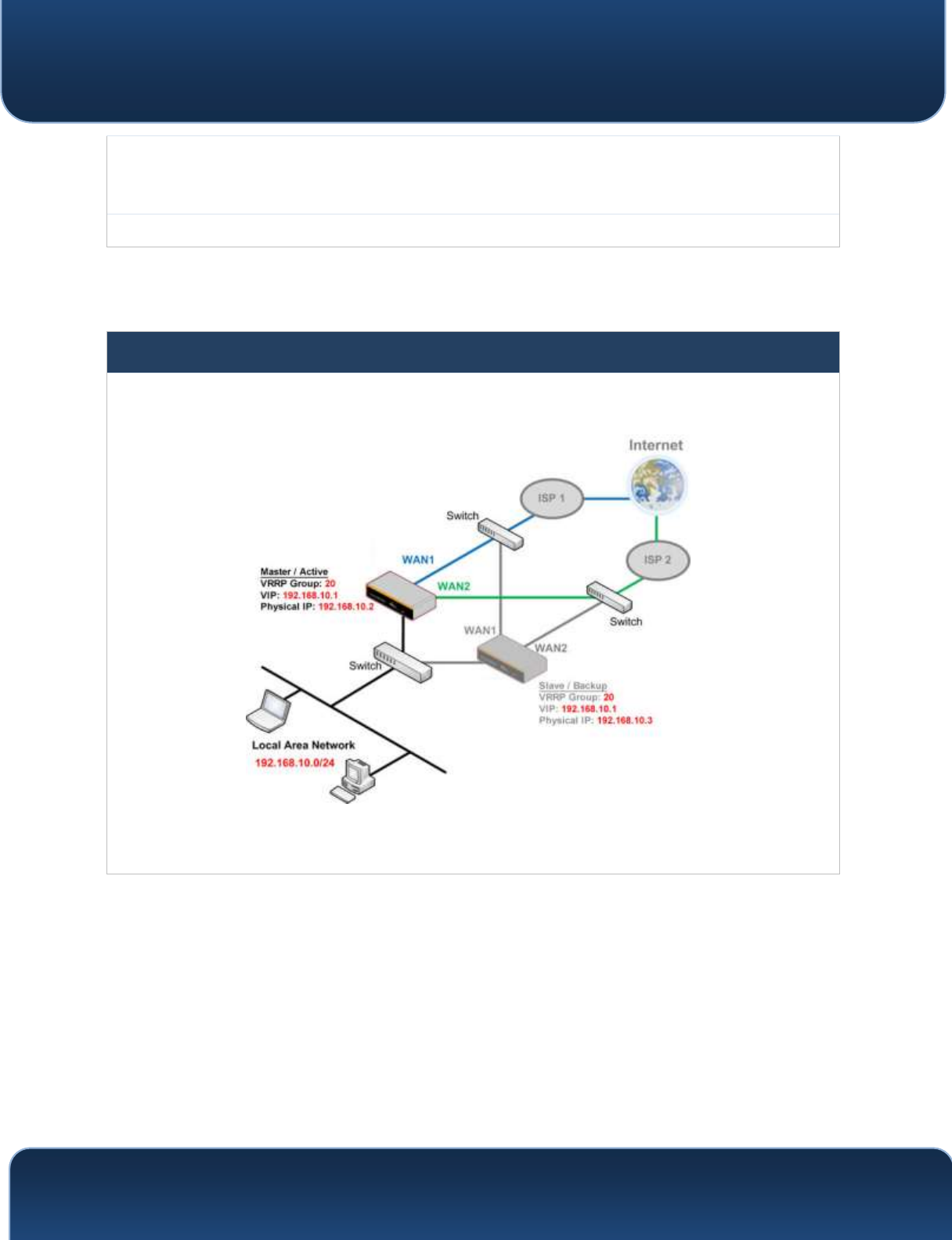
Pepwave MAX and Surf User Manual
http://www.pepwave.com
136
Copyright @ 2018 Pepwave
LAN
Administration
IP
This setting specifies a LAN IP address to be used for accessing administration
functionality. This address should be unique within the LAN.
Subnet Mask
This setting specifies the subnet mask of the LAN.
Important Note
For Pepwave routers in NAT mode, the virtual IP (VIP) should be set as the default gateway for all hosts
on the LAN segment. For example, a firewall sitting behind the Pepwave router should set its default
gateway as the virtual IP instead of the IP of the master router.
In drop-in mode, no other configuration needs to be set.
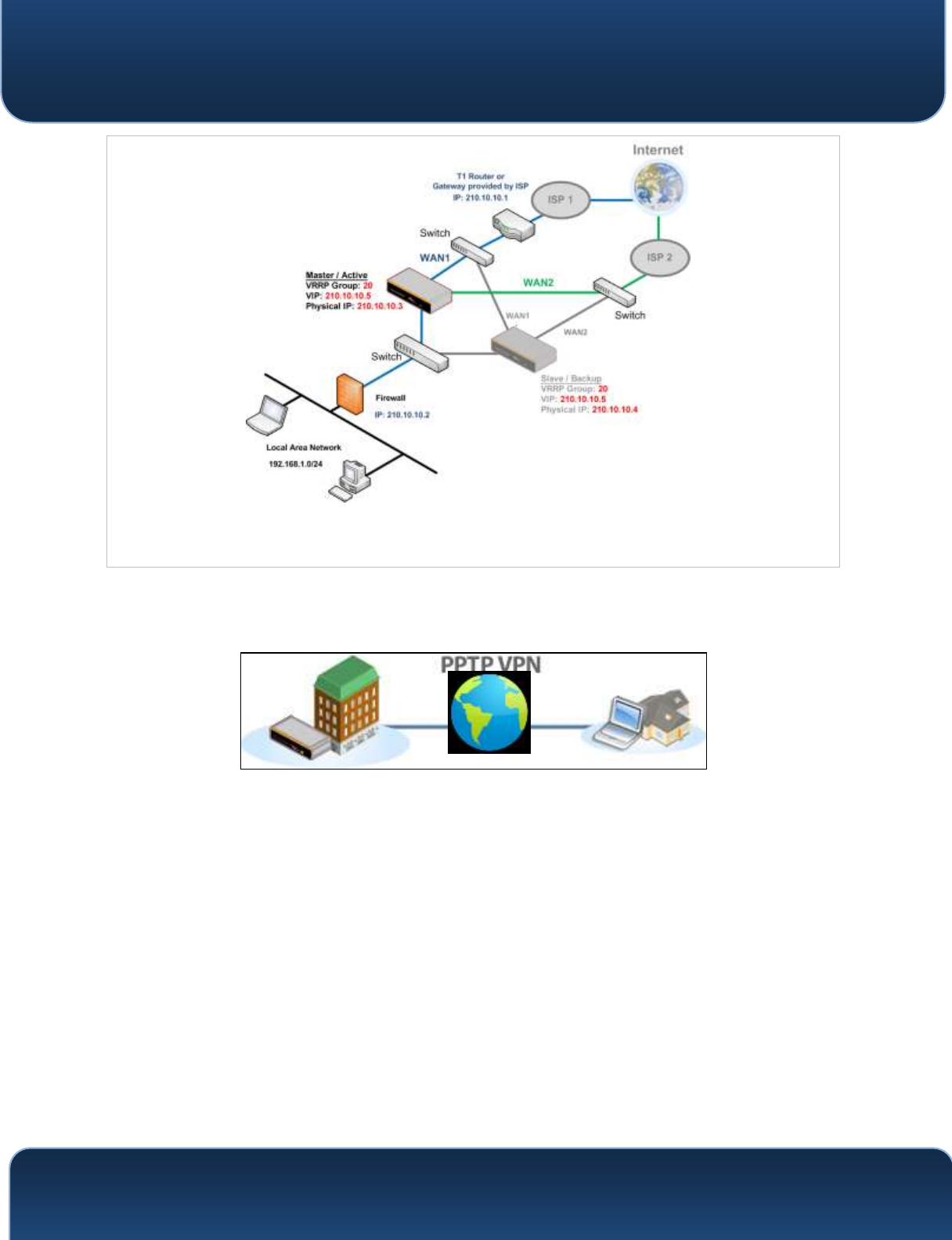
Pepwave MAX and Surf User Manual
http://www.pepwave.com
137
Copyright @ 2018 Pepwave
Please note that the drop-in WAN cannot be configured as a LAN bypass port while it is configured for
high availability.
19.6 PPTP Server
Pepwave routers feature a built-in PPTP server, which enables remote computers
to conveniently and securely access the local network. PPTP server settings are
located at Advanced>Misc. Settings>PPTP Server.
Check the box to enable PPTP server functionality. All connected PPTP sessions
are displayed at Status>Client List. Please refer to Section 22.3 for details. Note
that available options vary by model.
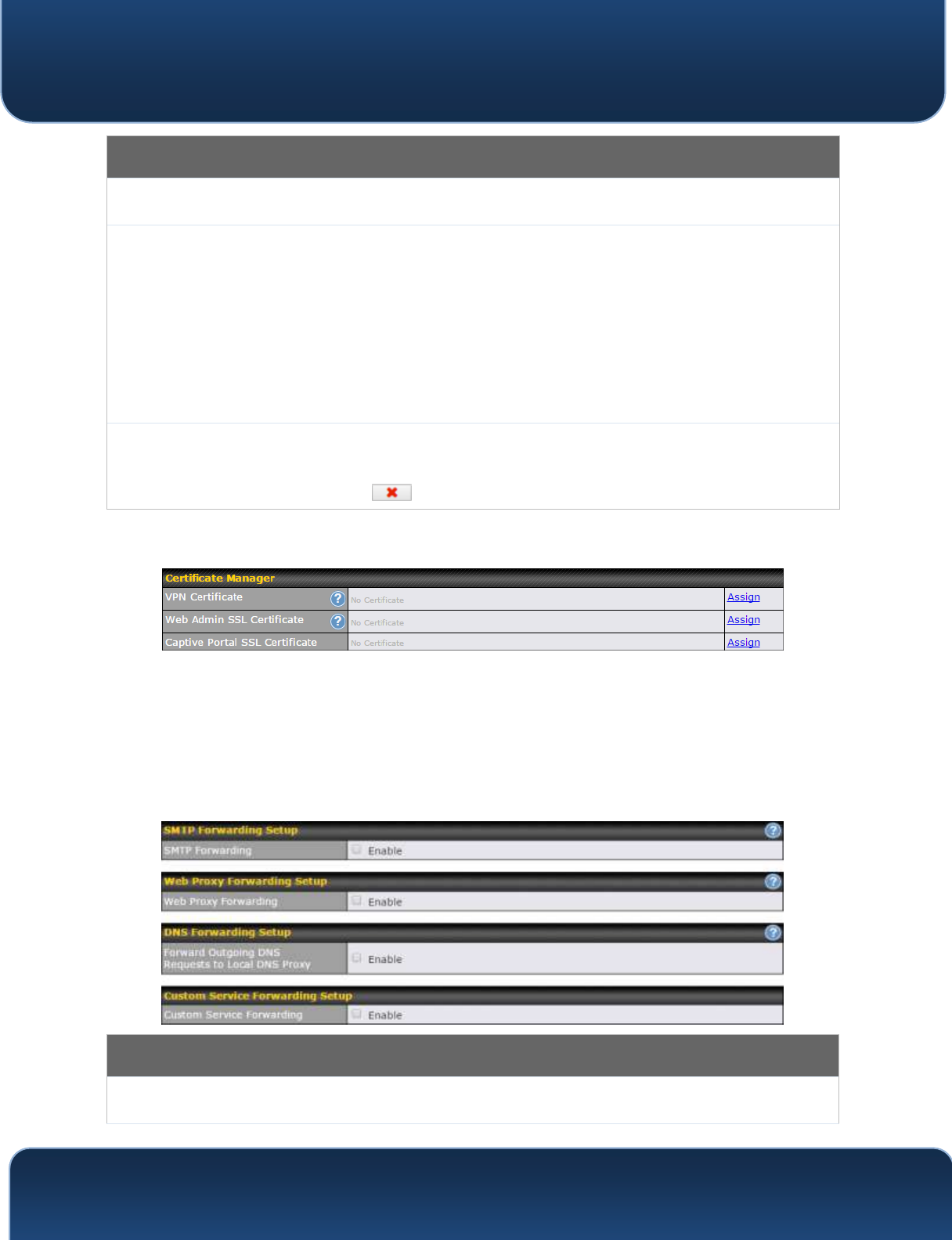
Pepwave MAX and Surf User Manual
http://www.pepwave.com
139
Copyright @ 2018 Pepwave
PPTP Server Settings
Listen On
This setting is for specifying the WAN connection(s) and IP address(es) that the PPTP
server should listen on.
Authentication
This setting is for specifying the user database source for PPTP authentication. Three
sources can be selected: Local User Accounts, LDAP Server, or RADIUS Server.
Local User Accounts - User accounts are stored in the Pepwave router locally. You
can add/modify/delete accounts in the User Accounts table.
LDAP Server - Authenticate with an external LDAP server. This has been tested with
Open LDAP servers where passwords are NTLM hashed. Active Directory is not
supported. (You can choose to use RADIUS to authenticate with a Windows server.)
RADIUS Server - Authenticate with an external RADIUS server. This has been tested
with Microsoft Windows Internet Authentication Service and FreeRADIUS servers
where passwords are NTLM hashed or in plain text.
User Accounts
This setting allows you to define PPTP user accounts for authentication via local user
accounts. Click Add to input username and password to create an account. After
adding the user accounts, you can click on a username to edit the account
password. Click to delete the account in its corresponding row.
19.7 Certificate Manager
This section allows you to assign certificates for local VPN and web admin SSL.
The local keys will not be transferred to another device by any means.
19.8 Service Forwarding
Service forwarding settings are located at Advanced>Misc. Settings>Service
Forwarding.
Service Forwarding
SMTP Forwarding
When this option is enabled, all outgoing SMTP connections destined for any
host at TCP port 25 will be intercepted. These connections will be redirected
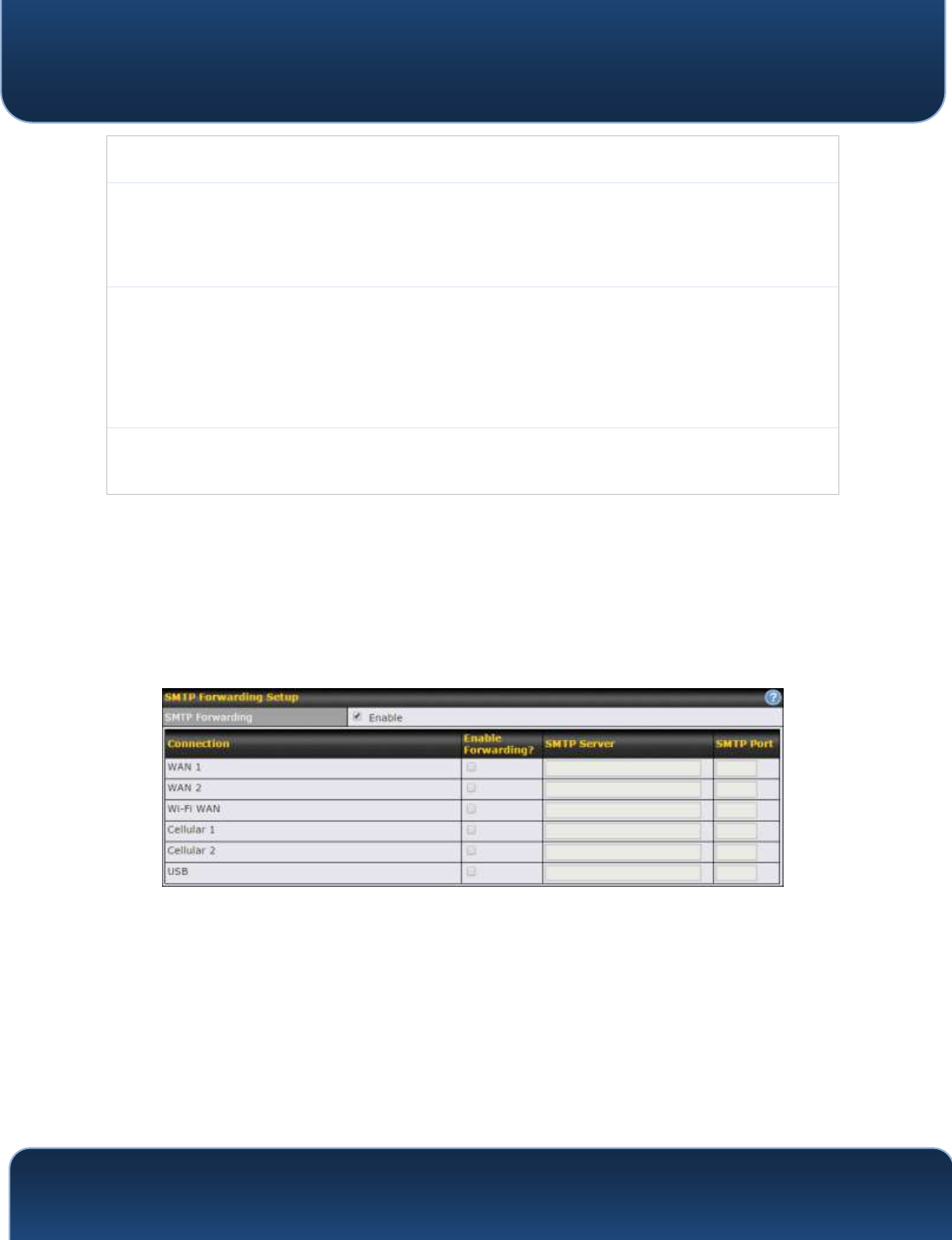
Pepwave MAX and Surf User Manual
http://www.pepwave.com
140
Copyright @ 2018 Pepwave
to a specified SMTP server and port number. SMTP server settings for each
WAN can be specified after selecting Enable.
Web Proxy
Forwarding
When this option is enabled, all outgoing connections destined for the proxy
server specified in Web Proxy Interception Settings will be intercepted. These
connections will be redirected to a specified web proxy server and port
number. Web proxy interception settings and proxy server settings for each
WAN can be specified after selecting Enable.
DNS Forwarding
When this option is enabled, all outgoing DNS lookups will be intercepted and
redirected to the built-in DNS name server. If any LAN device is using the DNS
name servers of a WAN connection, you may want to enable this option to
enhance the DNS availability without modifying the DNS server setting of the
clients. The built-in DNS name server will distribute DNS lookups to
corresponding DNS servers of all available WAN connections. In this case, DNS
service will not be interrupted, even if any WAN connection is down.
Custom Service
Forwarding
When custom service forwarding is enabled, outgoing traffic with the
specified TCP port will be forwarded to a local or remote server by defining its
IP address and port number.
19.8.1 SMTP Forwarding
Some ISPs require their users to send e-mails via the ISP’s SMTP server. All
outgoing SMTP connections are blocked except those connecting to the ISP’s.
Pepwave routers support intercepting and redirecting all outgoing SMTP
connections (destined for TCP port 25) via a WAN connection to the WAN’s
corresponding SMTP server.
To enable the feature, select Enable under SMTP Forwarding Setup. Check
Enable Forwarding for the WAN connection(s) that needs forwarding. Under
SMTP Server, enter the ISP’s e-mail server host name or IP address. Under SMTP
Port, enter the TCP port number for each WAN.
The Pepwave router will intercept SMTP connections. Choose a WAN port
according to the outbound policy, and then forward the connection to the
SMTP server if the chosen WAN has enabled forwarding. If the forwarding is
disabled for a WAN connection, SMTP connections for the WAN will be simply be
forwarded to the connection’s original destination.
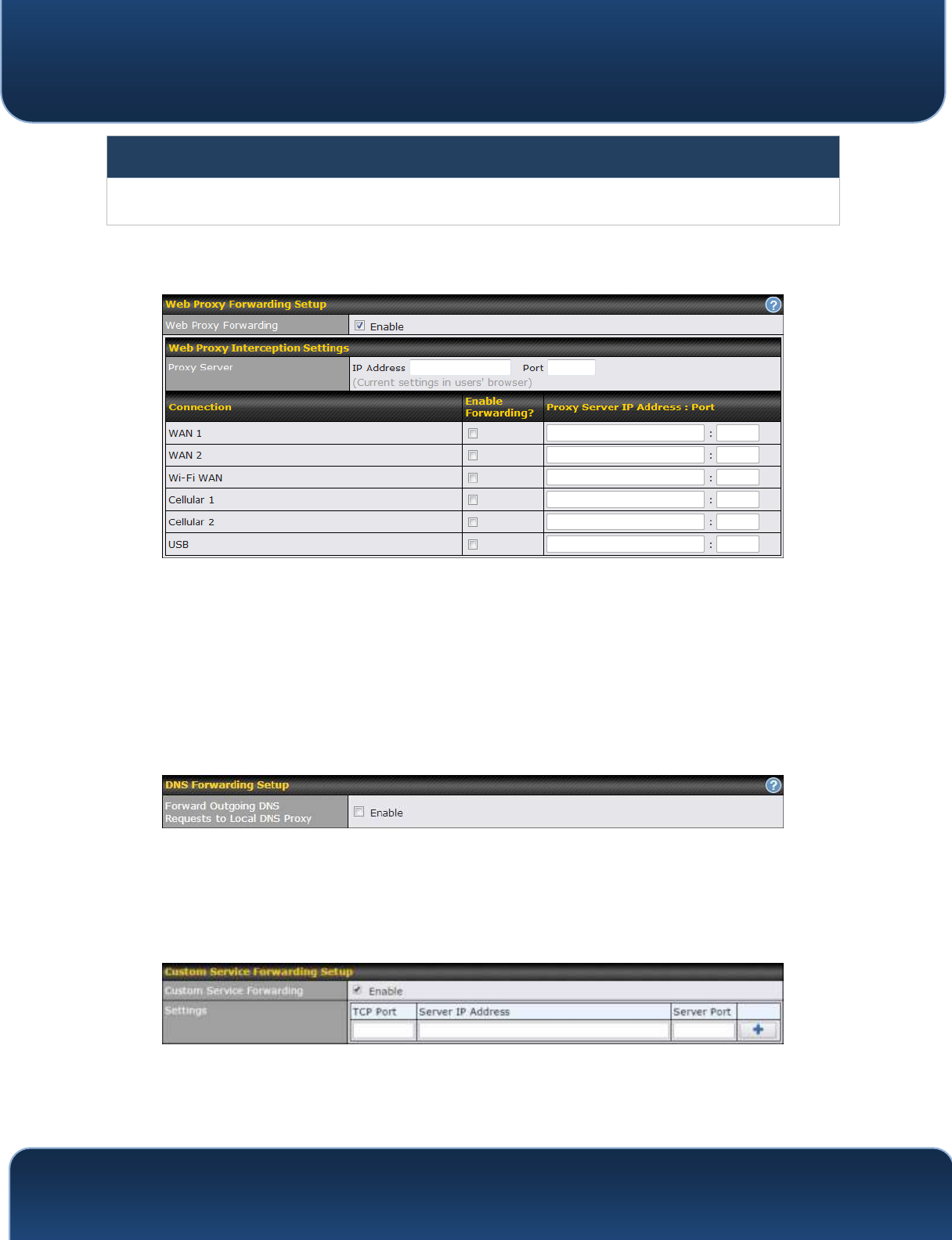
Pepwave MAX and Surf User Manual
http://www.pepwave.com
141
Copyright @ 2018 Pepwave
Note
If you want to route all SMTP connections only to particular WAN connection(s), you should create a
custom rule in outbound policy (see Section 14.2).
19.8.2 Web Proxy Forwarding
When this feature is enabled, the Pepwave router will intercept all outgoing
connections destined for the proxy server specified in Web Proxy Interception
Settings, choose a WAN connection with reference to the outbound policy, and
then forward them to the specified web proxy server and port number.
Redirected server settings for each WAN can be set here. If forwarding is
disabled for a WAN, web proxy connections for the WAN will be simply
forwarded to the connection’s original destination.
19.8.3 DNS Forwarding
When DNS forwarding is enabled, all clients’ outgoing DNS requests will also be
intercepted and forwarded to the built-in DNS proxy server.
19.8.4 Custom Service Forwarding
After clicking the enable checkbox, enter your TCP port for traffic heading to the
router, and then specify the IP Address and Port of the server you wish to forward
to the service to.
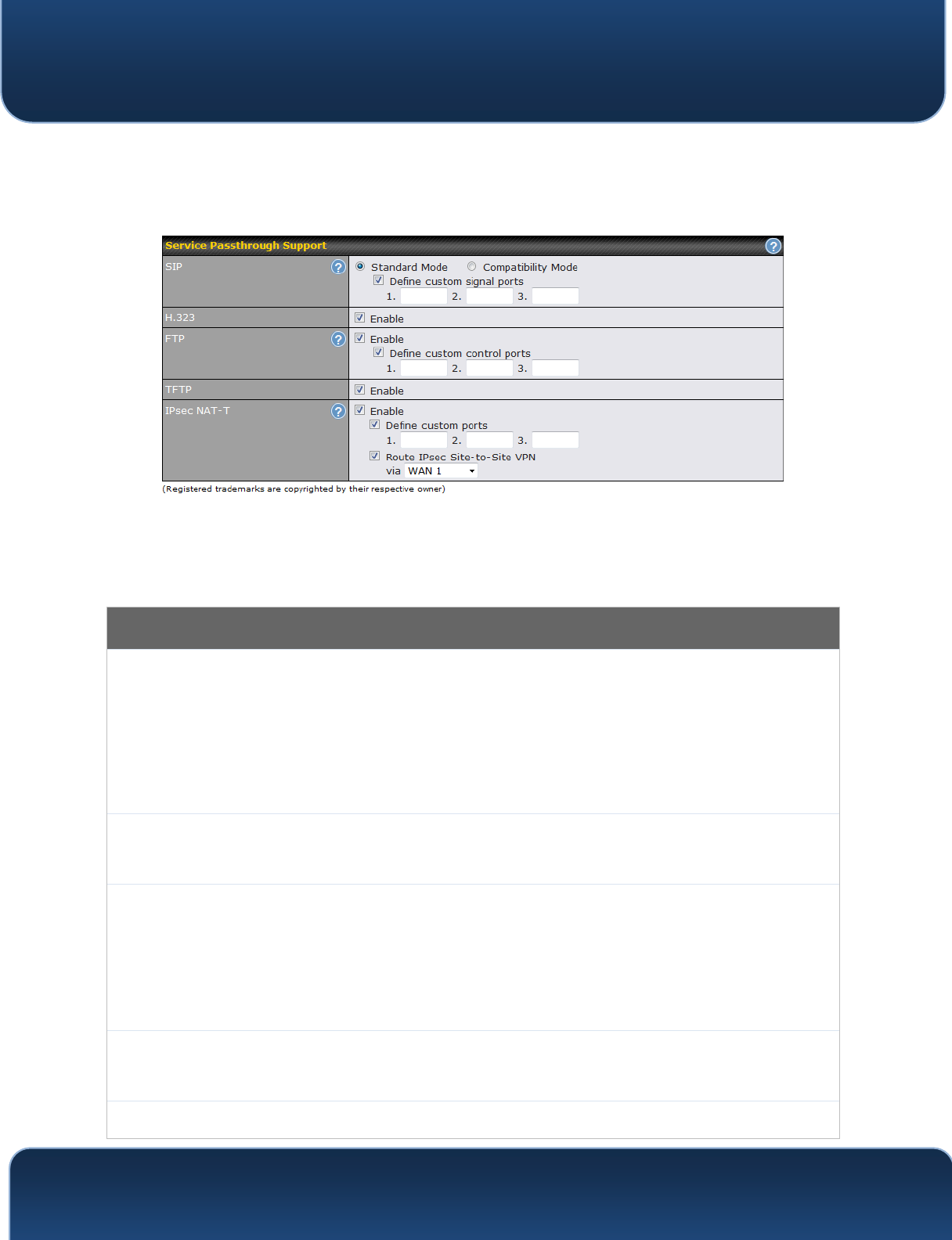
Pepwave MAX and Surf User Manual
http://www.pepwave.com
142
Copyright @ 2018 Pepwave
19.9 Service Passthrough
Service passthrough settings can be found at Advanced>Misc. Settings>Service
Passthrough.
Some Internet services need to be specially handled in a multi-WAN
environment. Pepwave routers can handle these services such that Internet
applications do not notice being behind a multi-WAN router. Settings for service
passthrough support are available here.
Service Passthrough Support
SIP
Session initiation protocol, aka SIP, is a voice-over-IP protocol. The Pepwave
router can act as a SIP application layer gateway (ALG) which binds
connections for the same SIP session to the same WAN connection and translate
IP address in the SIP packets correctly in NAT mode. Such passthrough support is
always enabled, and there are two modes for selection: Standard Mode and
Compatibility Mode. If your SIP server’s signal port number is non-standard, you
can check the box Define custom signal ports and input the port numbers to the
text boxes.
H.323
With this option enabled, protocols that provide audio-visual communication
sessions will be defined on any packet network and pass through the Pepwave
router.
FTP
FTP sessions consist of two TCP connections; one for control and one for data. In
a multi-WAN situation, they must be routed to the same WAN connection.
Otherwise, problems will arise in transferring files. By default, the Pepwave router
monitors TCP control connections on port 21 for any FTP connections and binds
TCP connections of the same FTP session to the same WAN. If you have an FTP
server listening on a port number other than 21, you can check Define custom
control ports and enter the port numbers in the text boxes.
TFTP
The Pepwave router monitors outgoing TFTP connections and routes any
incoming TFTP data packets back to the client. Select Enable if you want to
enable TFTP passthrough support.
IPsec NAT-T
This field is for enabling the support of IPsec NAT-T passthrough. UDP ports 500,
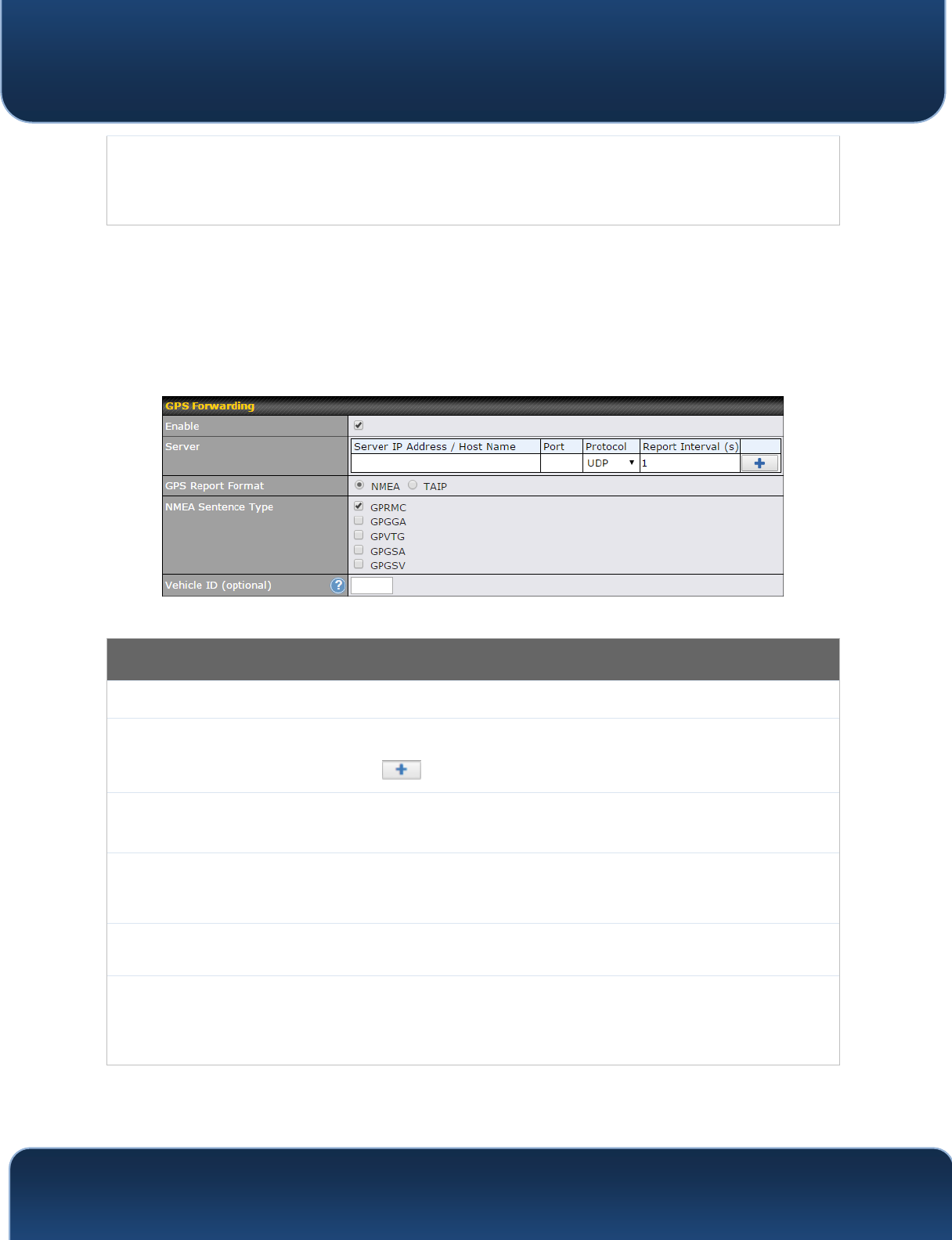
Pepwave MAX and Surf User Manual
http://www.pepwave.com
143
Copyright @ 2018 Pepwave
4500, and 10000 are monitored by default. You may add more custom data
ports that your IPsec system uses by checking Define custom ports. If the VPN
contains IPsec site-to-site VPN traffic, check Route IPsec Site-to-Site
VPN and choose the WAN connection to route the traffic to.
19.10 GPS Forwarding
Using the GPS forwarding feature, some Pepwave routers can automatically
send GPS reports to a specified server. To set up GPS forwarding, navigate to
Advanced>GPS Forwarding.
GPS Forwarding
Enable
Check this box to turn on GPS forwarding.
Server
Enter the name/IP address of the server that will receive GPS data. Also specify a
port number, protocol (UDP or TCP), and a report interval of between 1 and 10
seconds. Click to save these settings.
GPS Report
Format
Choose from NMEA or TAIP format for sending GPS reports.
NMEA Sentence
Type
If you’ve chosen to send GPS reports in NMEA format, select one or more
sentence types for sending the data (GPRMC, GPGGA, GPVTG, GPGSA, and
GPGSV).
Vehicle ID
The vehicle ID will be appended in the last field of the NMEA sentence. Note that
the NMEA sentence will become customized and non-standard.
TAIP Sentence
Type/TAIP ID
(optional)
If you’ve chosen to send GPS reports in TAIP format, select one or more sentence
types for sending the data (PV—Position / Velocity Solution and CP—Compact
Velocity Solution). You can also optionally include an ID number in the TAIP ID
field.
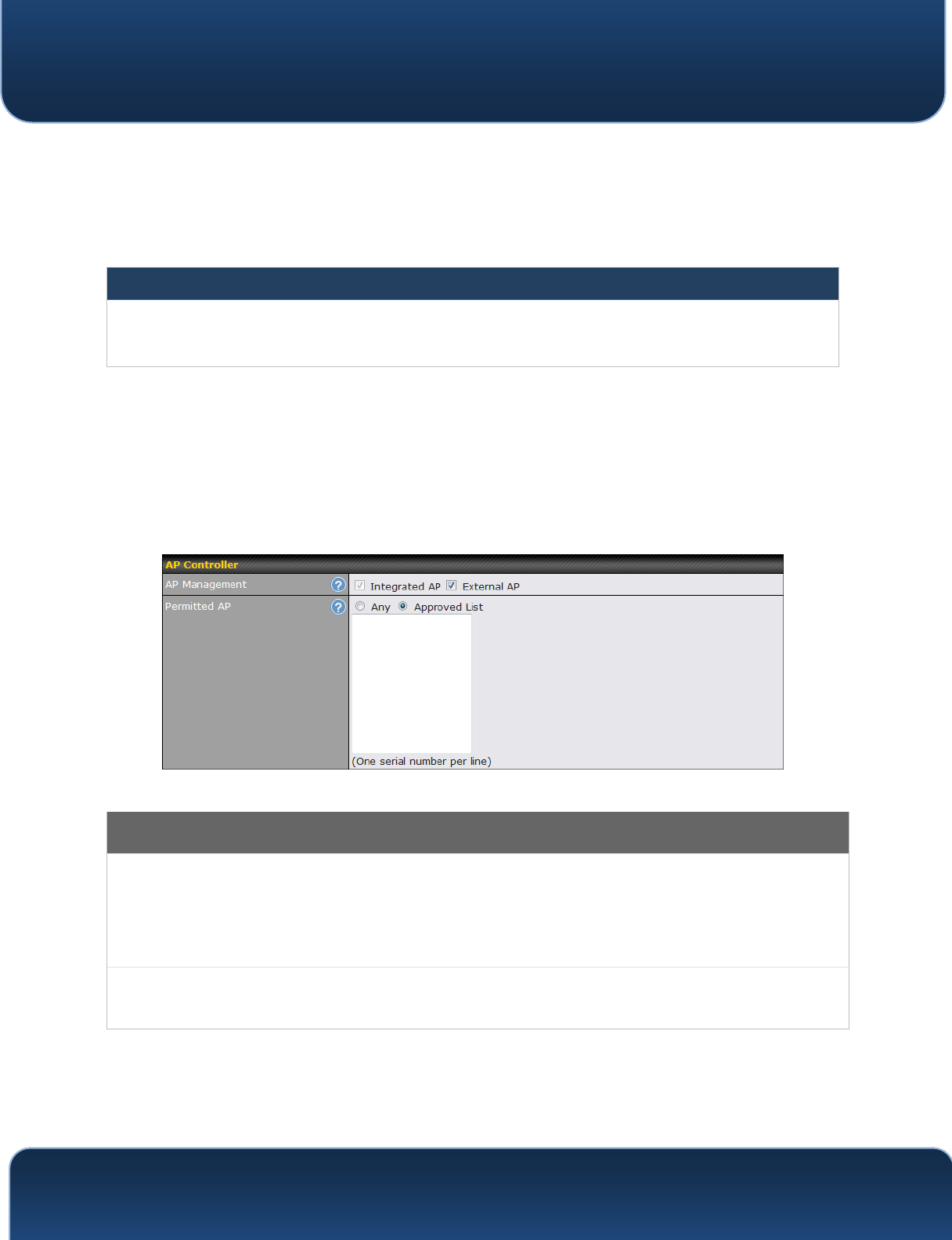
Pepwave MAX and Surf User Manual
http://www.pepwave.com
144
Copyright @ 2018 Pepwave
20 AP Controller
The AP controller acts as a centralized controller of Pepwave AP devices. With
this feature, users can customize and manage multiple APs from a single
Pepwave router interface.
Special Note
Each Pepwave router can control a limited number of routers without additional cost. To manage more,
a Full Edition license is required. Please contact your Authorized Reseller or the Peplink Sales Team for
more information and pricing details.
To configure, navigate to the AP tab.
20.1 Wireless SSID
This menu is the first one that appears after clicking the AP tab. This screen can
also be reached by clicking AP>Wireless SSID. Note the appearance of this
screen varies by model.
AP Controller
AP
Management
The AP controller for managing Pepwave APs can be enabled by checking this box.
When this option is enabled, the AP controller will wait for management connections
originating from APs over the LAN on TCP and UDP port 11753. It will also wait for
captive portal connections on TCP port 443. An extended DHCP option, CAPWAP
Access Controller addresses (field 138), will be added to the DHCP server. A local DNS
record, AP Controller, will be added to the local DNS proxy.
Permitted AP
Access points to manage can be specified here. If Any is selected, the AP controller
will manage any AP that reports to it. If Approved List is selected, only APs with serial
numbers listed in the provided text box will be managed.
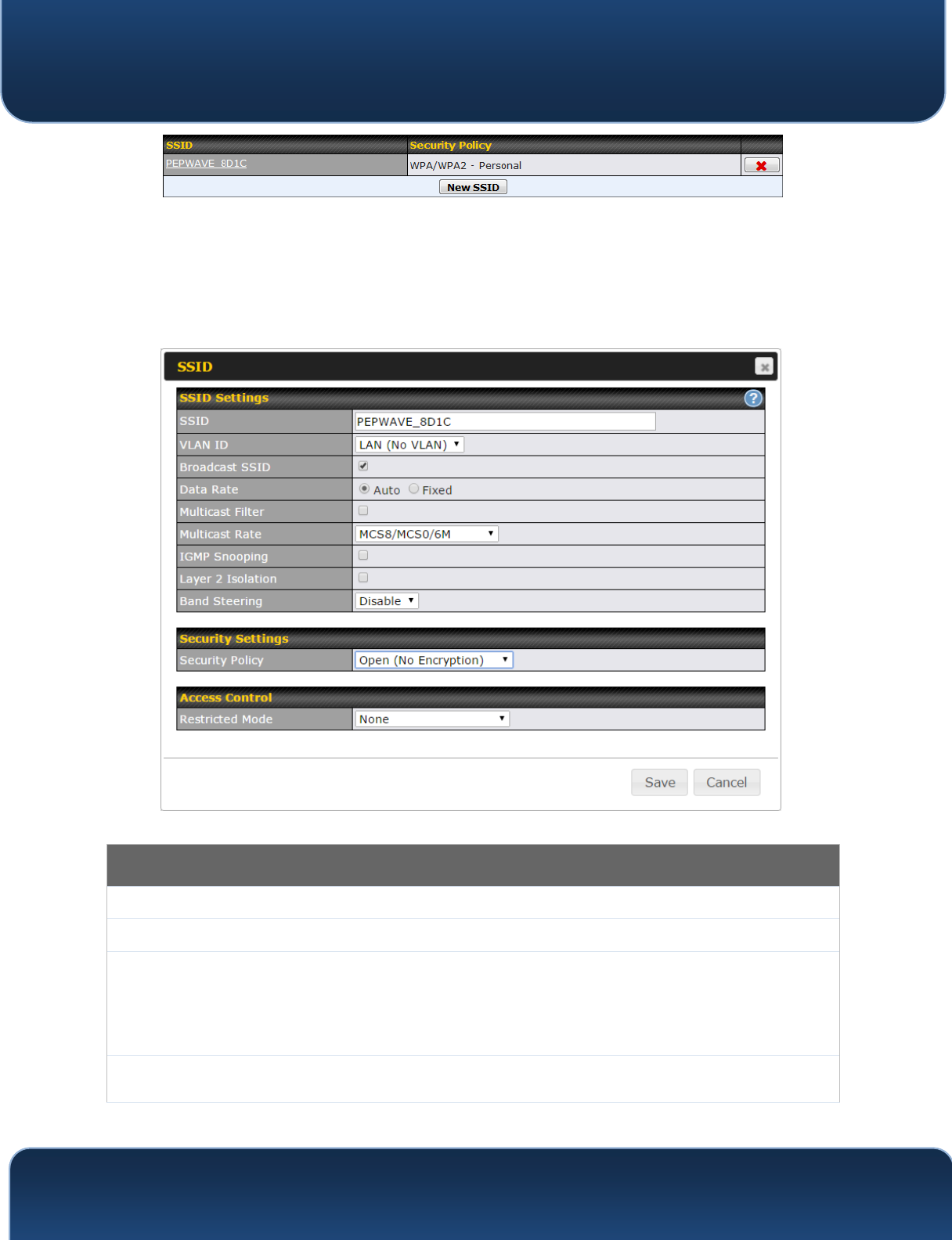
Pepwave MAX and Surf User Manual
http://www.pepwave.com
145
Copyright @ 2018 Pepwave
Current SSID information appears in the SSID section. To edit an existing SSID,
click its name in the list. To add a new SSID, click Add. Note that the following
settings vary by model.
SSID Settings
SSID
This setting specifies the SSID of the virtual AP to be scanned by Wi-Fi clients.
Enable
Select Yes to enable the virtual AP.
VLAN ID
This setting specifies the VLAN ID to be tagged on all outgoing packets
generated from this wireless network (i.e., packets that travel from the Wi-Fi
segment through the Pepwave AP One unit to the Ethernet segment via the
LAN port). The default value of this setting is 0, which means VLAN tagging is
disabled (instead of tagged with zero).
Broadcast SSID
This setting specifies whether or not Wi-Fi clients can scan the SSID of this
wireless network. Broadcast SSID is enabled by default.
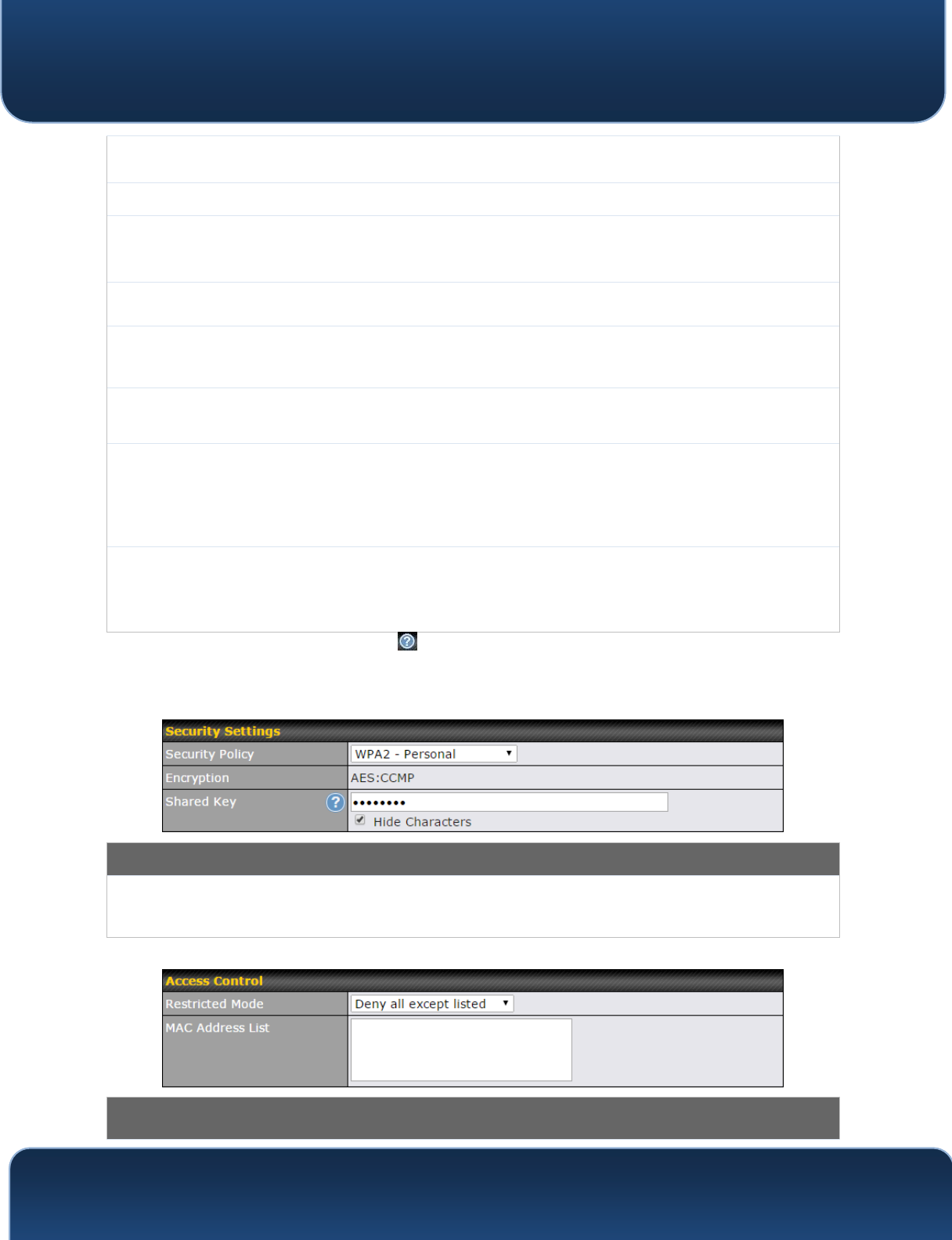
Pepwave MAX and Surf User Manual
http://www.pepwave.com
146
Copyright @ 2018 Pepwave
Data Rate A
Select Auto to allow the Pepwave router to set the data rate automatically,
or select Fixed and choose a rate from the displayed drop-down menu.
Multicast FilterA
This setting enables the filtering of multicast network traffic to the wireless SSID.
Multicast RateA
This setting specifies the transmit rate to be used for sending multicast network
traffic. The selected Protocol and Channel Bonding settings will affect the rate
options and values available here.
IGMP Snooping A
To allow the Pepwave router to listen to internet group management protocol
(IGMP) network traffic, select this option.
DHCP Option 82 A
If you use a distributed DHCP server/relay environment, you can enable this
option to provide additional information on the manner in which clients are
physically connected to the network.
Network Priority
(QoS) A
Select from Gold, Silver, and Bronze to control the QoS priority of this wireless
network’s traffic.
Layer 2 Isolation A
Layer 2 refers to the second layer in the ISO Open System Interconnect
model.
When this option is enabled, clients on the same VLAN, SSID, or subnet are
isolated to that VLAN, SSID, or subnet, which can enhance security. Traffic is
passed to upper communication layer(s). By default, the setting is disabled.
Band Steering A
Band steering allows the Pepwave router to steer AP clients from the 2.4GHz
band to the 5GHz band for better usage of bandwidth. To make steering
mandatory, select Enforce. To cause the Pepwave router to preferentially
choose steering, select Prefer. The default for this setting is Disable.
A - Advanced feature. Click the button on the top right-hand corner to
activate.
Security Settings
Security
Policy
This setting configures the wireless authentication and encryption methods.
Available options are Open (No Encryption), WPA/WPA2 - Personal, WPA/WPA2 –
Enterprise and Static WEP.
Access Control
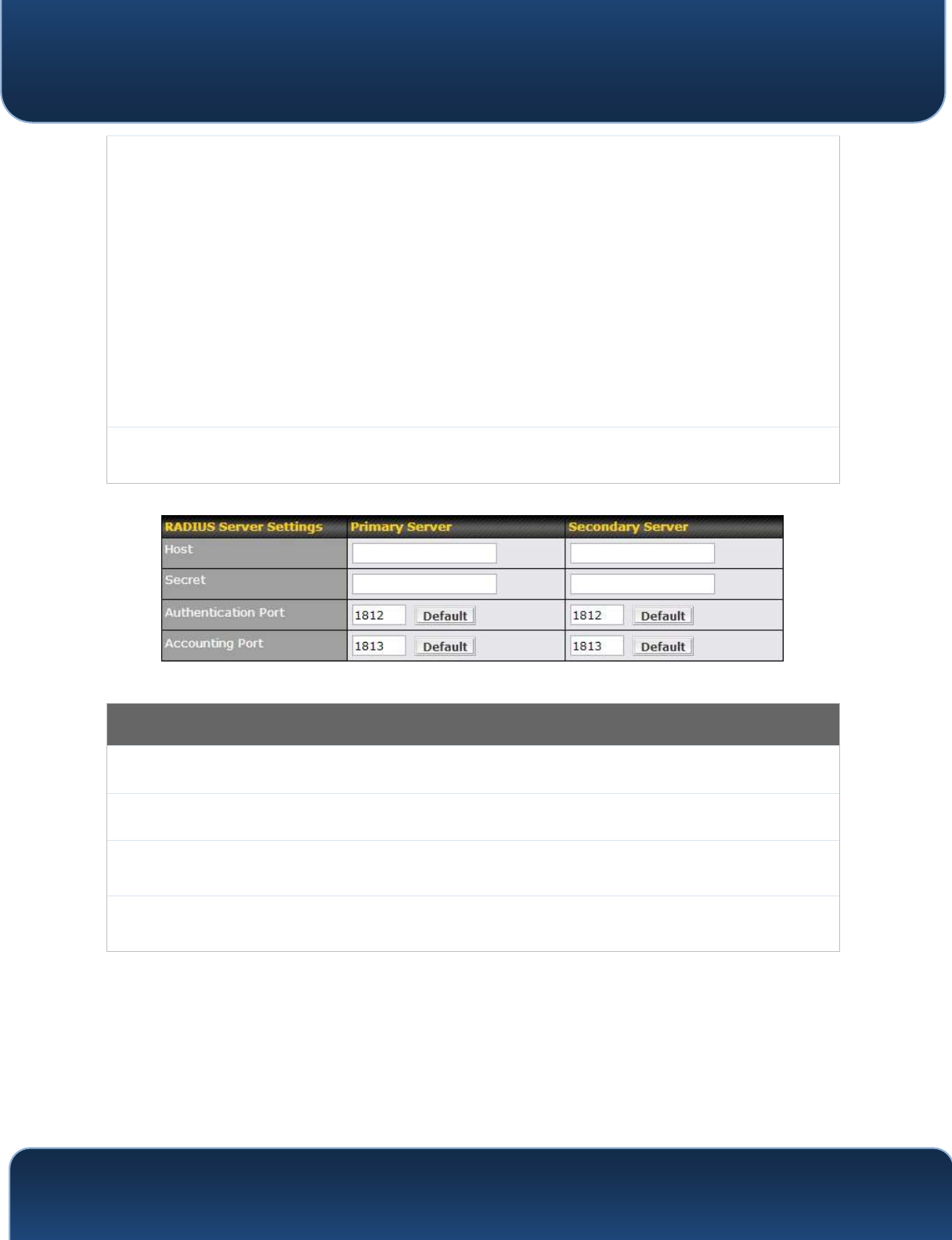
Pepwave MAX and Surf User Manual
http://www.pepwave.com
147
Copyright @ 2018 Pepwave
Restricted
Mode
The settings allow administrator to control access using MAC address filtering.
Available options are None, Deny all except listed, Accept all except listed, and
RADIUS MAC Authentication.
When WPA/WPA2 - Enterprise is configured, RADIUS-based 802.1 x authentication is
enabled. Under this configuration, the Shared Key option should be disabled. When
using this method, select the appropriate version using the V1/V2 controls. The
security level of this method is known to be very high.
When WPA/WPA2- Personal is configured, a shared key is used for data encryption
and authentication. When using this configuration, the Shared Key option should be
enabled. Key length must be between eight and 63 characters (inclusive). The
security level of this method is known to be high.
The configuration of Static WEP parameters enables pre-shared WEP key encryption.
Authentication is not supported by this method. The security level of this method is
known to be weak.
MAC Address
List
Connection coming from the MAC addresses in this list will be either denied or
accepted based the option selected in the previous field.
RADIUS Server Settings
Host
Enter the IP address of the primary RADIUS server and, if applicable, the secondary
RADIUS server.
Secret
Enter the RADIUS shared secret for the primary server and, if applicable, the
secondary RADIUS server.
Authentication
Port
In field, enter the UDP authentication port(s) used by your RADIUS server(s) or click
the Default button to enter 1812.
Accounting
Port
In field, enter the UDP accounting port(s) used by your RADIUS server(s) or click the
Default button to enter 1813.
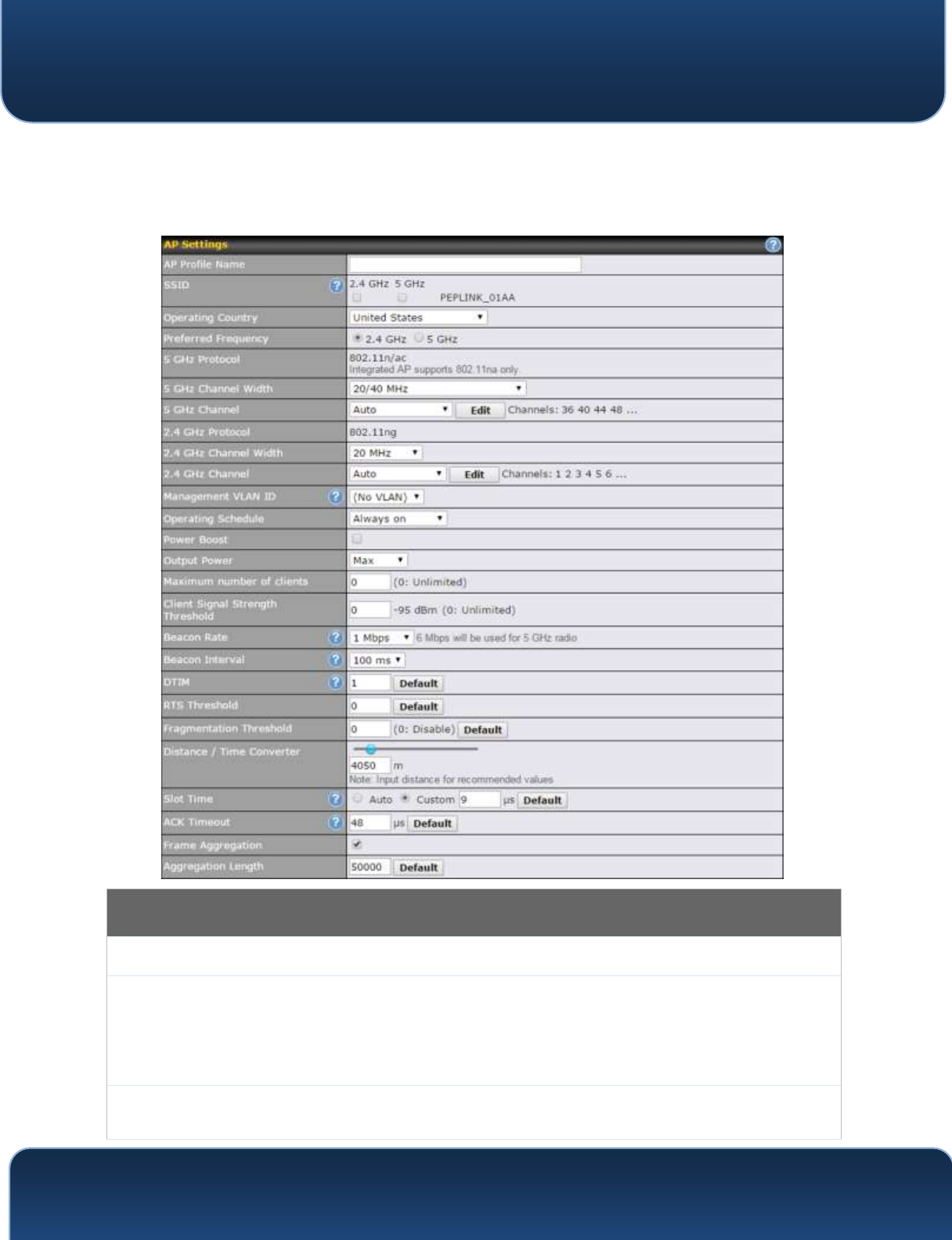
Pepwave MAX and Surf User Manual
http://www.pepwave.com
148
Copyright @ 2018 Pepwave
20.2 Settings
On many Pepwave models, the AP settings screen (AP>Settings) looks similar to
the example below:
AP Settings
AP Profile Name
This field specifies the name of this AP profile.
SSID
These buttons specify which wireless networks will use this AP profile. You can also
select the frequencies at which each network will transmit. Please note that the
Peplink Balance does not detect whether the AP is capable of transmitting at
both frequencies. Instructions to transmit at unsupported frequencies will be
ignored by the AP.
Operating
This drop-down menu specifies the national / regional regulations which the AP
should follow.

Pepwave MAX and Surf User Manual
http://www.pepwave.com
149
Copyright @ 2018 Pepwave
Country If a North American region is selected, RF channels 1 to 11 will be available
and the maximum transmission power will be 23.5 dBm (224 mW).
If European region is selected, RF channels 1 to 13 will be available. The
maximum transmission power will be 20 dBm (100 mW).
NOTE: Users are required to choose an option suitable to local laws and
regulations.
Per FCC regulation, the country selection is not available on all models marketed
in US. All US models are fixed to US channels only.
Preferred
Frequency
These buttons determine the frequency at which access points will attempt to
broadcast. This feature will only work for APs that can transmit at both 5.4GHz
and 5GHz frequencies.
5 GHz Protocol
This section displays the 5 GHz protocols your APs are using.
5GHz Channel
Bonding
There are three options: 20 MHz, 20/40 MHz, and 40 MHz. With this feature
enabled, the Wi-Fi system can use two channels at once. Using two channels
improves the performance of the Wi-Fi connection.
5 GHz Channel
This drop-down menu selects the 5 GHz 802.11 channel to be utilized. If Auto is set,
the system will perform channel scanning based on the scheduled time set and
choose the most suitable channel automatically.
2.4 GHz Protocol
This section displays the 2.4 GHz protocols your APs are using.
2.4 GHz Channel
Bonding
There are three options: 20 MHz, 20/40 MHz, and 40 MHz. With this feature
enabled, the Wi-Fi system can use two channels at once. Using two channels
improves the performance of the Wi-Fi connection.
2.4 GHz Channel
This drop-down menu selects the 802.11 channel to be utilized. Available options
are from 1 to 11 and from 1 to 13 for the North America region and Europe
region, respectively. (Channel 14 is only available when the country is selected as
Japan with protocol 802.11b.) If Auto is set, the system will perform channel
scanning based on the scheduled time set and choose the most suitable
channel automatically.
Management
VLAN ID
This field specifies the VLAN ID to tag to management traffic, such as AP to AP
controller communication traffic. The value is 0 by default, meaning that no VLAN
tagging will be applied. NOTE: change this value with caution as alterations may
result in loss of connection to the AP controller.
Operating
Schedule
Choose from the schedules that you have defined in System>Schedule. Select
the schedule for the integrated AP to follow from the drop-down menu.
Power BoostA
With this option enabled, the AP under this profile will transmit using additional
power. Please note that using this option with several APs in close proximity will
lead to increased interference.
Output PowerA
This drop-down menu determines the power at which the AP under this profile will
broadcast. When fixed settings are selected, the AP will broadcast at the
specified power level, regardless of context. When Dynamic settings are
selected, the AP will adjust its power level based on its surrounding APs in order to
maximize performance.

Pepwave MAX and Surf User Manual
http://www.pepwave.com
150
Copyright @ 2018 Pepwave
The Dynamic: Auto setting will set the AP to do this automatically. Otherwise, the
Dynamic: Manual setting will set the AP to dynamically adjust only of instructed to
do so. If you have set Dynamic:Manual, you can go to AP>Toolbox>Auto Power
Adj. to give your AP further instructions.
Max number of
ClientsA
This field determines the maximum clients that can be connected to APs under
this profile.
Client Signal
Strength
ThresholdA
This field determines that maximum signal strength each individual client will
receive. The measurment unit is megawatts.
Beacon RateA
This drop-down menu provides the option to send beacons in different transmit
bit rates. The bit rates are 1Mbps, 2Mbps, 5.5Mbps, 6Mbps, and 11Mbps.
Beacon IntervalA
This drop-down menu provides the option to set the time between each beacon
send. Available options are 100ms, 250ms, and 500ms.
DTIMA
This field provides the option to set the frequency for beacon to include delivery
traffic indication messages (DTIM). The interval unit is measured in milliseconds.
RTS ThresholdA
This field provides the option to set the minimum packet size for the unit to send
an RTS using the RTS/CTS handshake. Setting 0 disables this feature.
Fragmentation
ThresholdA
Determines the maximum size (in bytes) that each packet fragment will be
broken down into. Set 0 to disable fragmentation.
Distance/Time
ConverterA
Select the distance you want your Wi-Fi to cover in order to adjust the below
parameters. Default values are recommended.
Slot TimeA
This field provides the option to modify the unit wait time before it transmits. The
default value is 9μs.
ACK TimeoutA
This field provides the option to set the wait time to receive acknowledgement
packet before doing retransmission. The default value is 48μs.
Frame
AggregationA
With this feature enabled, throughput will be increased by sending two or more
data frames in a single transmission.
Frame Length
This field is only available when Frame Aggregation is enabled. It specifies the
frame length for frame aggregation. By default, it is set to 50000.
A - Advanced feature. Click the button on the top right-hand corner to
activate.
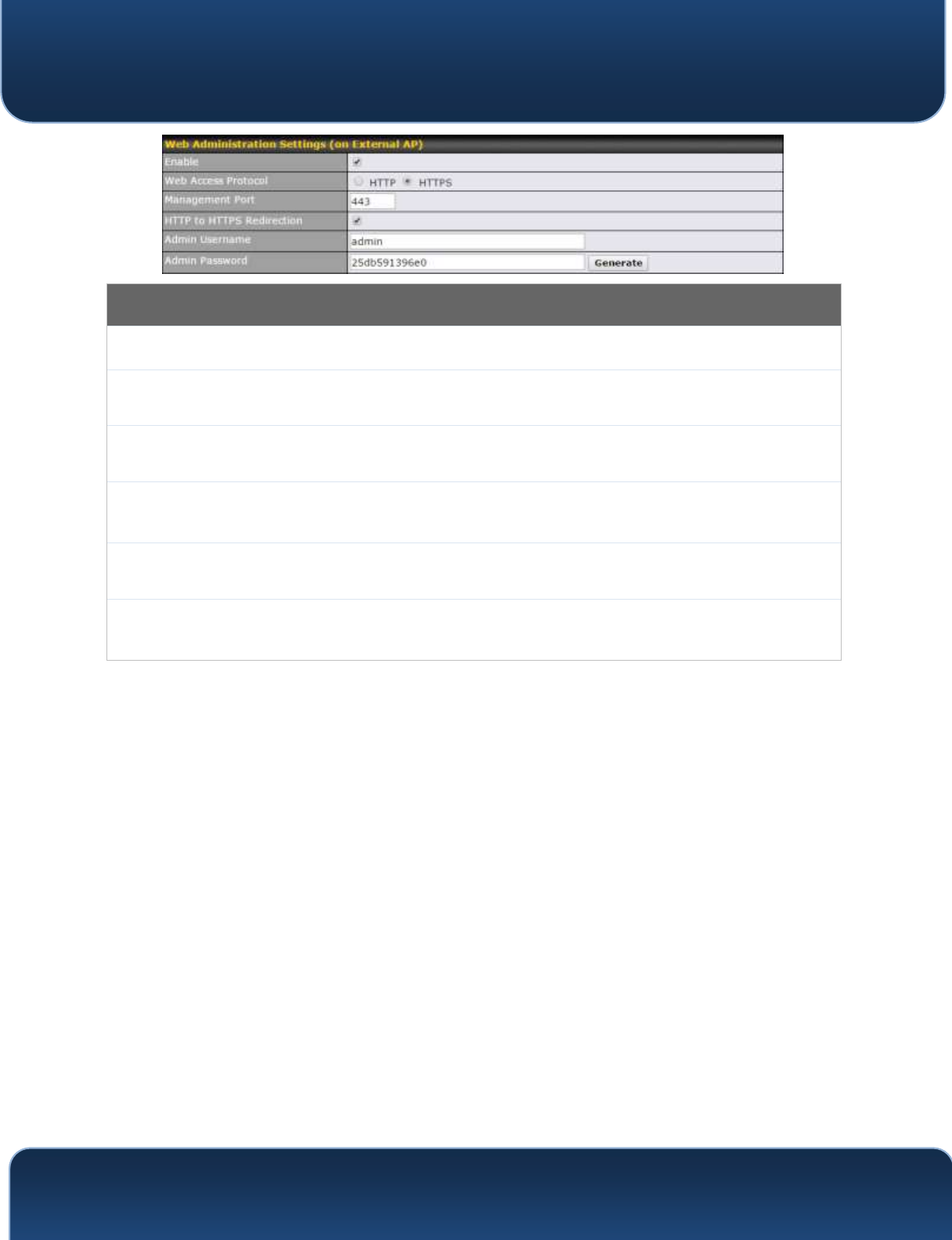
Pepwave MAX and Surf User Manual
http://www.pepwave.com
151
Copyright @ 2018 Pepwave
Web Administration Settings
Enable
Check the box to allow the Pepwave router to manage the web admin access
information of the AP.
Web Access
Protocol
These buttons specify the web access protocol used for accessing the web
admin of the AP. The two available options are HTTP and HTTPS.
Management
Port
This field specifies the management port used for accessing the device.
HTTP to HTTPS
Redirection
This option will be available if you have chosen HTTPS as the Web Access
Protocol. With this enabled, any HTTP access to the web admin will redirect to
HTTPS automatically.
Admin User
Name
This field specifies the administrator username of the web admin. It is set as admin
by default.
Admin Password
This field allows you to specify a new administrator password. You may also click
the Generate button and let the system generate a random password
automatically.
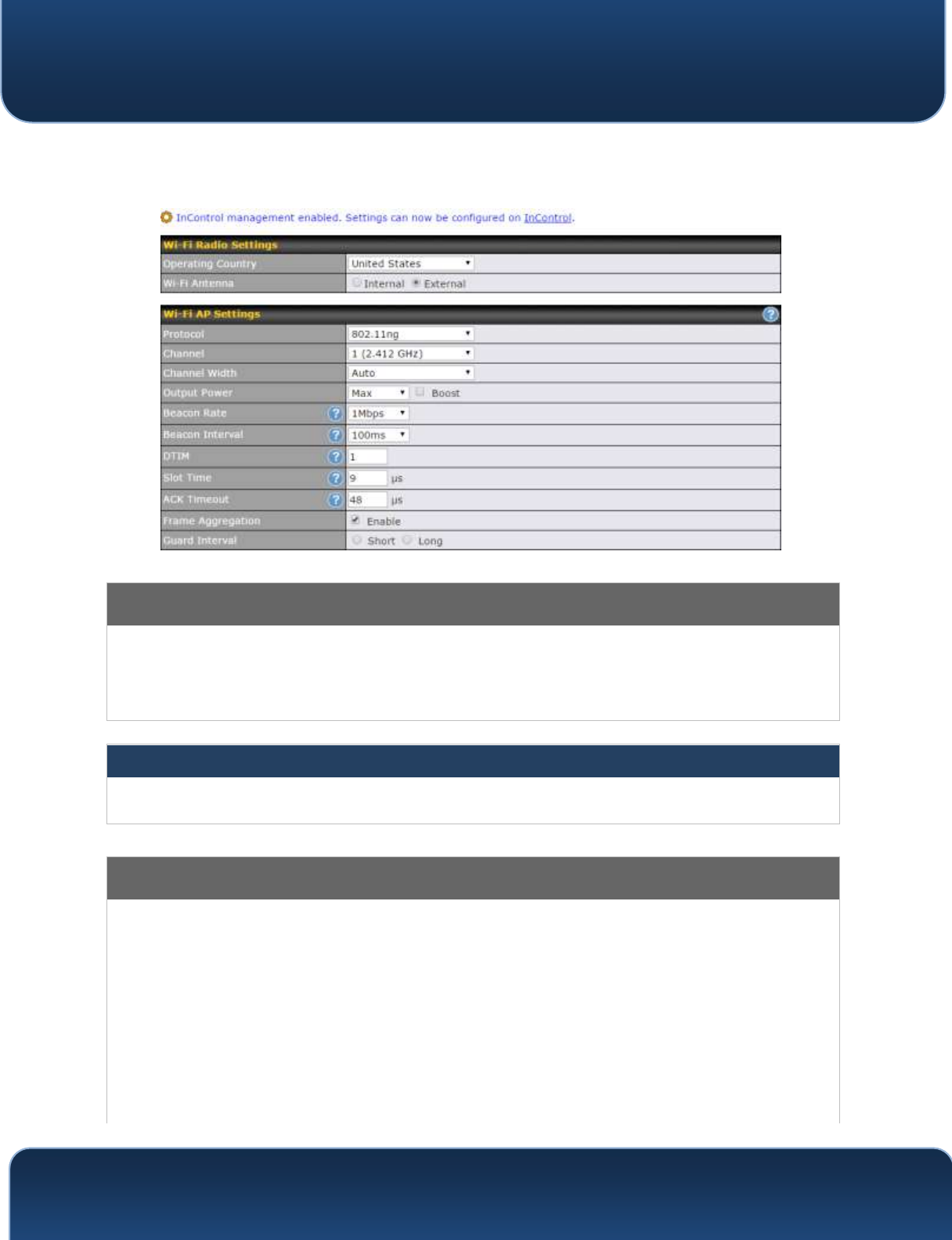
Pepwave MAX and Surf User Manual
http://www.pepwave.com
152
Copyright @ 2018 Pepwave
Navigating to AP>Settings on some Pepwave models displays a screen similar to
the one shown below:
Wi-Fi Radio Settings
Operating
Country
This option sets the country whose regulations the Pepwave router follows.
Wi-Fi Antenna
Choose from the router's internal or optional external antennas, if so equipped.
Important Note
Per FCC regulations, the country selection is not available on all models
marketed in the US. All US models are fixed to US channels only.
Wi-Fi AP Settings
Protocol
This option allows you to specify whether 802.11b and/or 802.11g client
association requests will be accepted. Available options are 802.11ng and
802.11na. By default, 802.11ng is selected.
Channel
This option allows you to select which 802.11 RF channel will be used. Channel 1
(2.412 GHz) is selected by default.
Channel Width
Auto (20/40 MHz) and 20 MHz are available. The default setting is Auto (20/40
MHz), which allows both widths to be used simultaneously.
Output Power
This option is for specifying the transmission output power for the Wi-Fi AP. There
are 4 relative power levels available – Max, High, Mid, and Low. The actual
output power will be bound by the regulatory limits of the selected country.
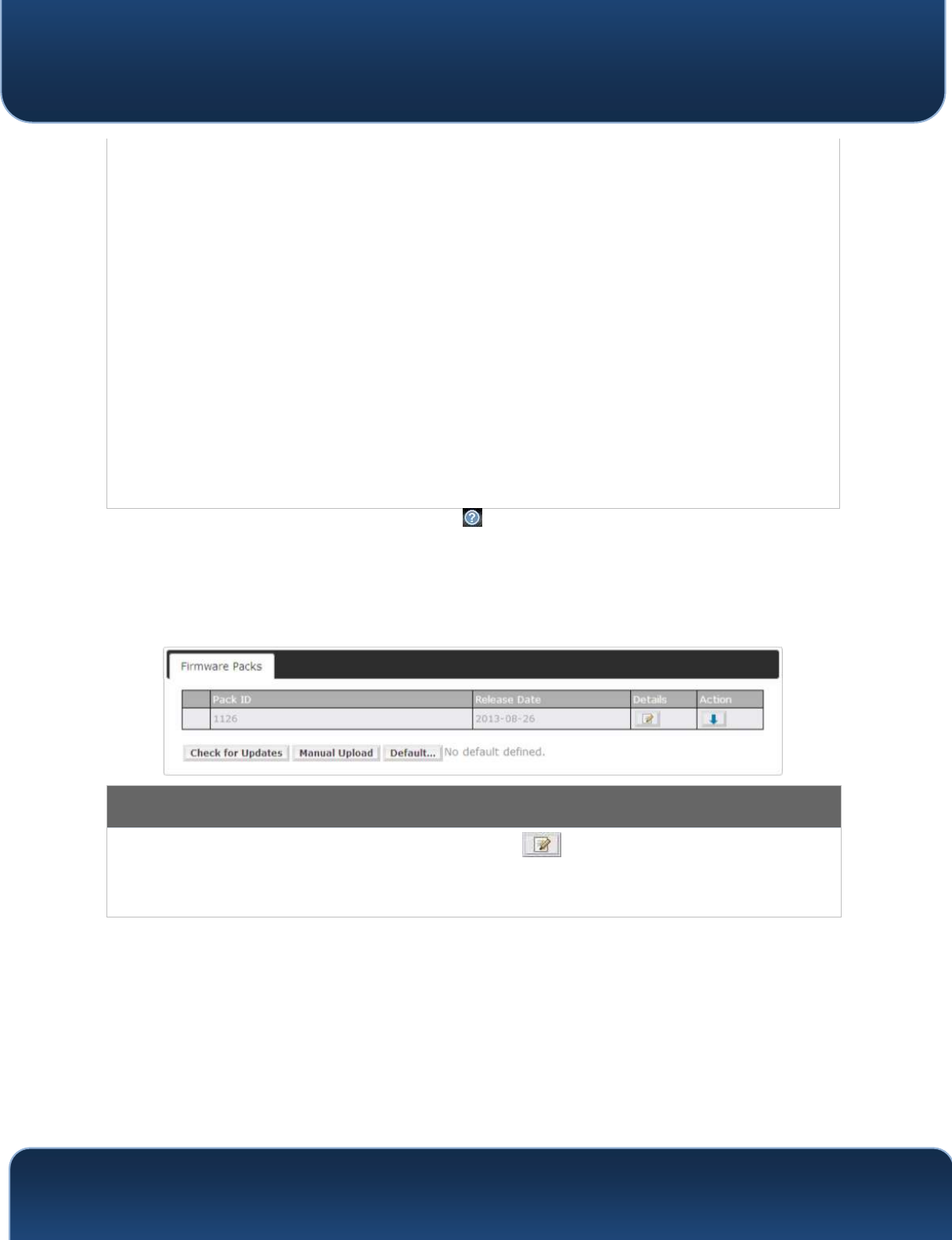
Pepwave MAX and Surf User Manual
http://www.pepwave.com
153
Copyright @ 2018 Pepwave
Beacon RateA
This option is for setting the transmit bit rate for sending a beacon. By default,
1Mbps is selected.
Beacon
IntervalA
This option is for setting the time interval between each beacon. By default,
100ms is selected.
DTIMA
This field allows you to set the frequency for the beacon to include a delivery
traffic indication message. The interval is measured in milliseconds. The default
value is set to 1 ms.
Slot TimeA
This field is for specifying the wait time before the Surf SOHO transmits a packet.
By default, this field is set to 9 µs.
ACK TimeoutA
This field is for setting the wait time to receive an acknowledgement packet
before performing a retransmission. By default, this field is set to 48 µs.
Frame
AggregationA
This option allows you to enable frame aggregation to increase transmission
throughput.
Guard IntervalA
This setting allows choosing a short or long guard period interval for your
transmissions.
A - Advanced feature, please click the button on the top right-hand corner to
activate.
20.3 Toolbox
Tools for managing firmware packs can be found at AP>Toolbox.
Firmware Packs
Here, you can manage the firmware of your AP. Clicking on will result in information regarding each
firmware pack. To receive new firmware packs, you can click Check for Updates to download new packs,
or you can click Manual Upload to manually upload a firmware pack. Click Default to define which
firmware pack is default.
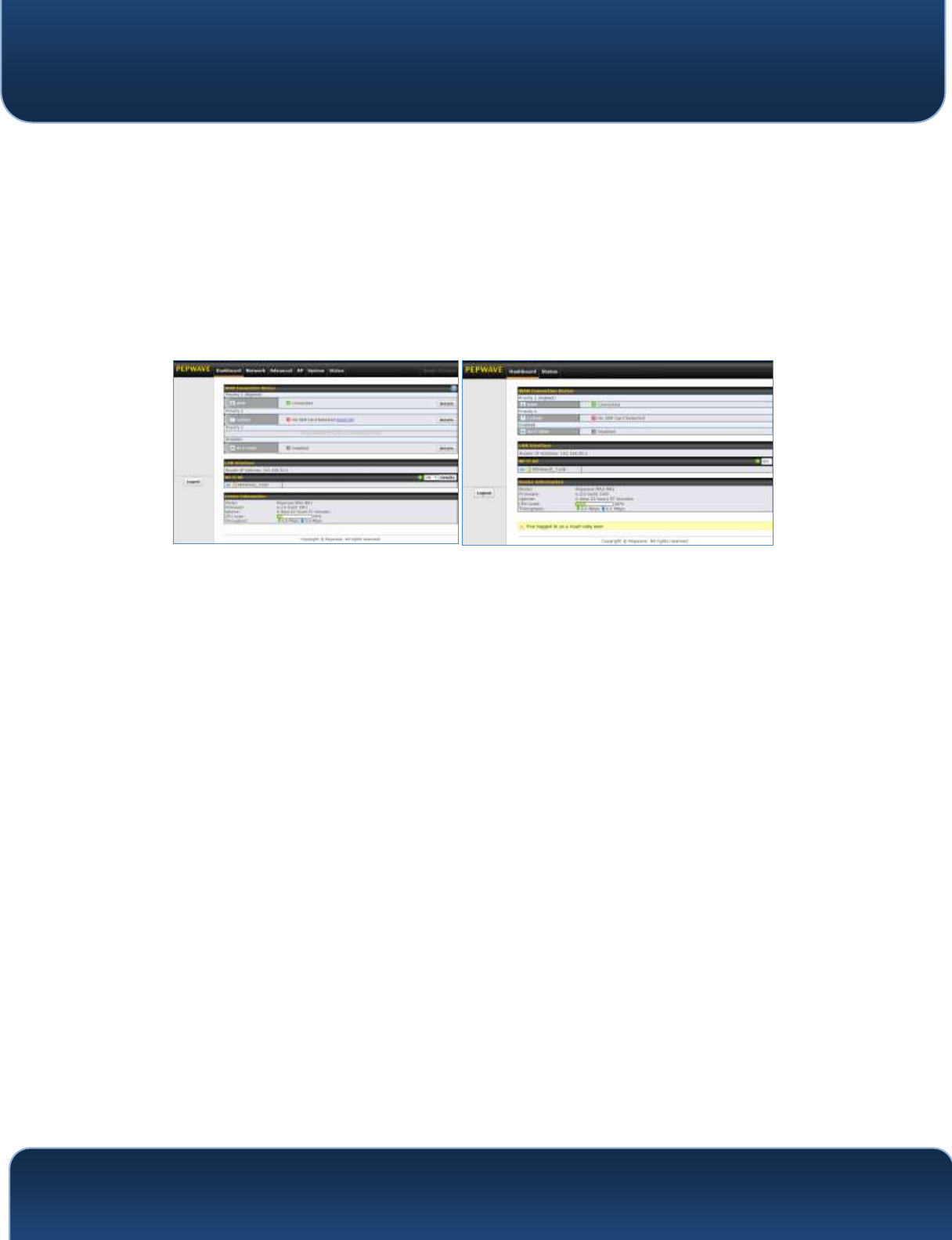
Pepwave MAX and Surf User Manual
http://www.pepwave.com
154
Copyright @ 2018 Pepwave
21 System Settings
21.1 Admin Security
There are two types of user accounts available for accessing the web admin:
admin and user. They represent two user levels: the admin level has full
administration access, while the user level is read-only. The user level can access
only the device's status information; users cannot make any changes on the
device.
A web login session will be logged out automatically when it has been idle
longer than the Web Session Timeout. Before the session expires, you may click
the Logout button in the web admin to exit the session.
0 hours 0 minutes signifies an unlimited session time. This setting should be used
only in special situations, as it will lower the system security level if users do not
log out before closing the browser. The default is 4 hours, 0 minutes.
For security reasons, after logging in to the web admin Interface for the first time,
it is recommended to change the administrator password. Configuring the
administration interface to be accessible only from the LAN can further improve
system security. Administrative settings configuration is located at System>Admin
Security.
Admin account UI
User account UI
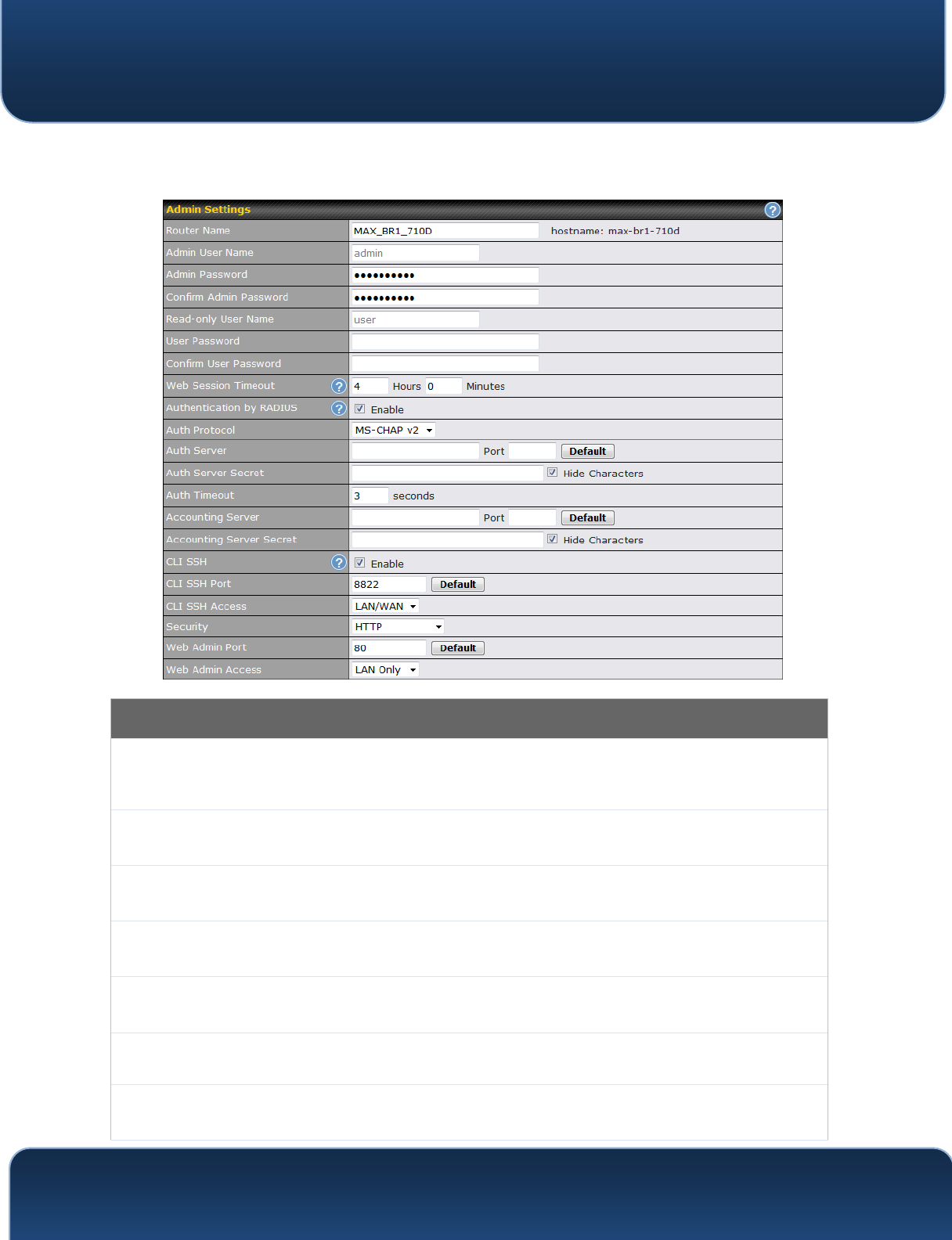
Pepwave MAX and Surf User Manual
http://www.pepwave.com
155
Copyright @ 2018 Pepwave
Admin Settings
Router Name
This field allows you to define a name for this Pepwave router. By default, Router
Name is set as MAX_XXXX or Surf_SOHO_XXXX, where XXXX refers to the last 4
digits of the unit’s serial number.
Admin User
Name
Admin User Name is set as admin by default, but can be changed, if desired.
Admin
Password
This field allows you to specify a new administrator password.
Confirm Admin
Password
This field allows you to verify and confirm the new administrator password.
Read-only User
Name
Read-only User Name is set as user by default, but can be changed, if desired.
User Password
This field allows you to specify a new user password. Once the user password is
set, the read-only user feature will be enabled.
Confirm User
Password
This field allows you to verify and confirm the new user password.

Pepwave MAX and Surf User Manual
http://www.pepwave.com
156
Copyright @ 2018 Pepwave
Web Session
Timeout
This field specifies the number of hours and minutes that a web session can
remain idle before the Pepwave router terminates its access to the web admin
interface. By default, it is set to 4 hours.
Authentication
by RADIUS
With this box is checked, the web admin will authenticate using an external
RADIUS server. Authenticated users are treated as either "admin" with full read-
write permission or “user” with read-only access. Local admin and user accounts
will be disabled. When the device is not able to communicate with the external
RADIUS server, local accounts will be enabled again for emergency access.
Additional authentication options will be available once this box is checked.
Auth Protocol
This specifies the authentication protocol used. Available options are MS-CHAP v2
and PAP.
Auth Server
This specifies the access address and port of the external RADIUS server.
Auth Server
Secret
This field is for entering the secret key for accessing the RADIUS server.
Auth Timeout
This option specifies the time value for authentication timeout.
Accounting
Server
This specifies the access address and port of the external accounting server.
Accounting
Server Secret
This field is for entering the secret key for accessing the accounting server.
Network
Connection
This option is for specifying the network connection to be used for authentication.
Users can choose from LAN, WAN, and VPN connections.
CLI SSH
The CLI (command line interface) can be accessed via SSH. This field enables CLI
support. For additional information regarding CLI, please refer to Section 21.16.
CLI SSH Port
This field determines the port on which clients can access CLI SSH.
CLI SSH Access
This menu allows you to choose between granting access to LAN and WAN
clients, or to LAN clients only.
Security
This option is for specifying the protocol(s) through which the web admin
interface can be accessed:
HTTP
HTTPS
HTTP/HTTPS
Web Admin
Port
This field is for specifying the port number on which the web admin interface can
be accessed.
Web Admin
Access
This option is for specifying the network interfaces through which the web admin
interface can be accessed:
LAN only
LAN/WAN
If LAN/WAN is chosen, the WAN Connection Access Settings form will be
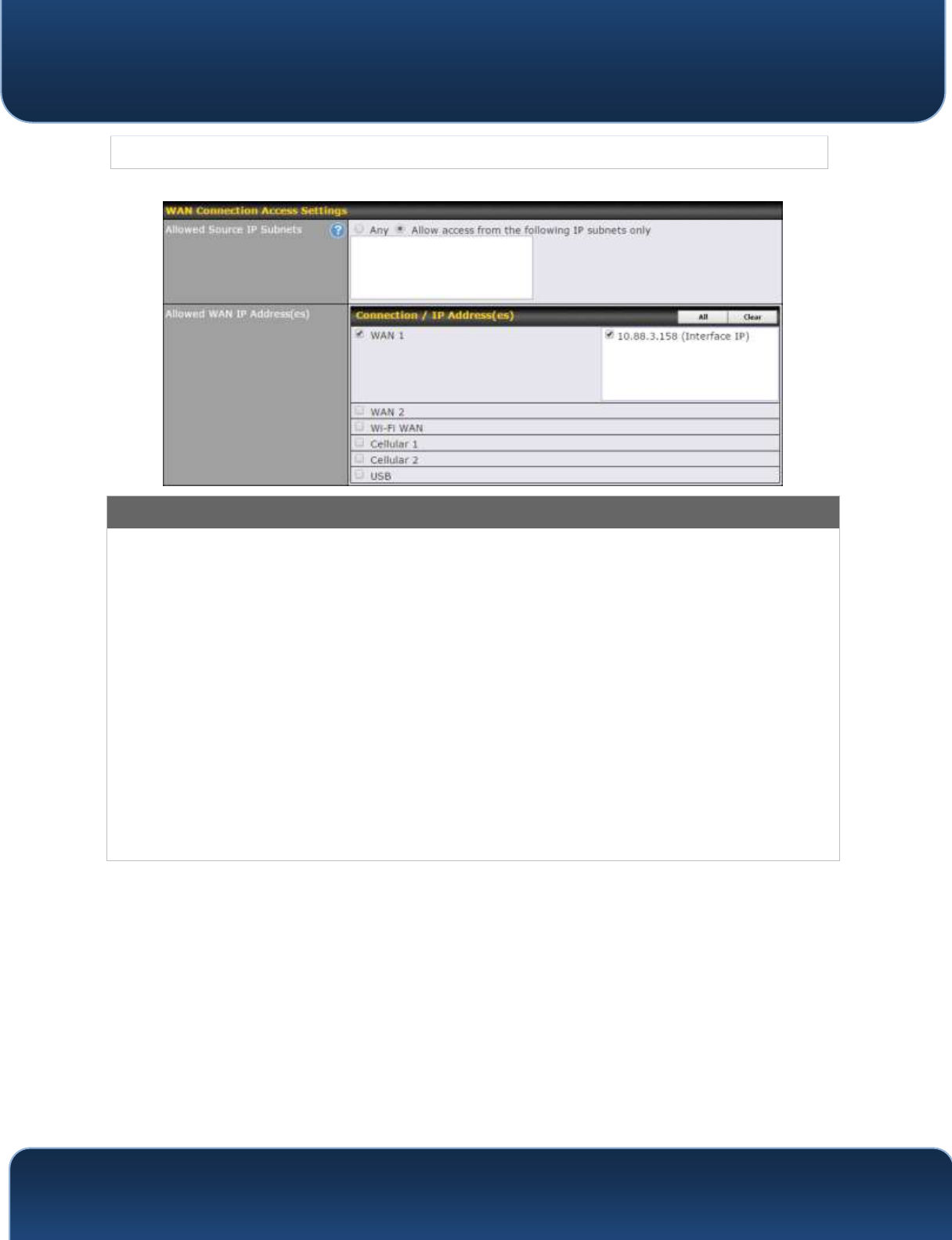
Pepwave MAX and Surf User Manual
http://www.pepwave.com
157
Copyright @ 2018 Pepwave
displayed.
WAN Connection Access Settings
Allowed
Source IP
Subnets
This field allows you to restrict web admin access only from defined IP subnets.
Any - Allow web admin accesses to be from anywhere, without IP address
restriction.
Allow access from the following IP subnets only - Restrict web admin access
only from the defined IP subnets. When this is chosen, a text input area will be
displayed beneath:
The allowed IP subnet addresses should be entered into this text area. Each IP
subnet must be in form of w.x.y.z/m, where w.x.y.z is an IP address (e.g.,
192.168.0.0), and m is the subnet mask in CIDR format, which is between 0 and 32
inclusively (For example, 192.168.0.0/24).
To define multiple subnets, separate each IP subnet one in a line. For example:
192.168.0.0/24
10.8.0.0/16
Allowed WAN
IP Address(es)
This is to choose which WAN IP address(es) the web server should listen on.
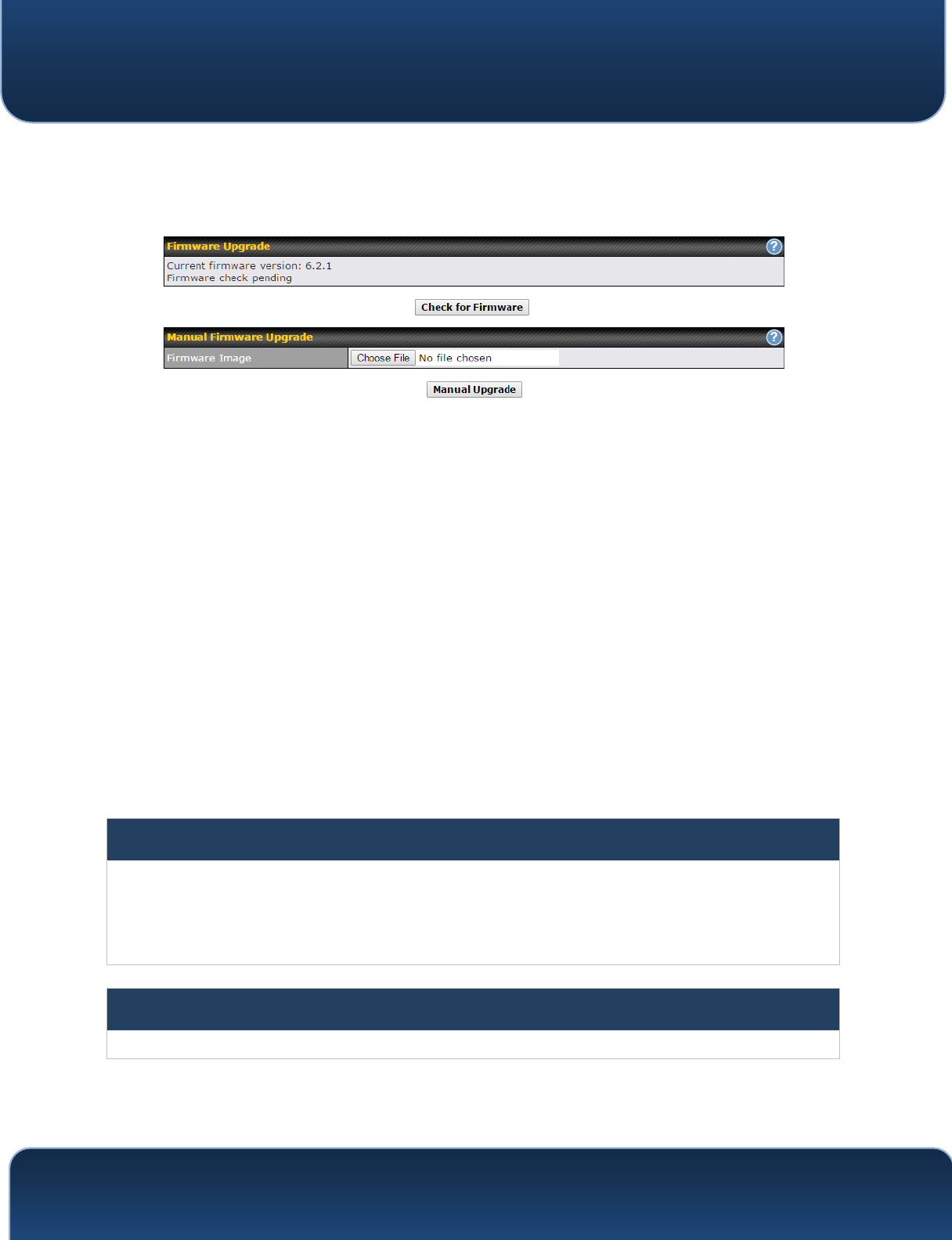
Pepwave MAX and Surf User Manual
http://www.pepwave.com
158
Copyright @ 2018 Pepwave
21.2 Firmware
Pepwave router firmware is upgradeable through the web admin interface.
Firmware upgrade functionality is located at System>Firmware.
There are two ways to upgrade the unit. The first method is through an online
download. The second method is to upload a firmware file manually.
To perform an online download, click on the Check for Firmware button. The
Pepwave router will check online for new firmware. If new firmware is available,
the Pepwave router will automatically download the firmware. The rest of the
upgrade process will be automatically initiated.
You may also download a firmware image from the Peplink website and update
the unit manually. To update using a firmware image, click Choose File to select
the firmware file from the local computer, and then click Manual Upgrade to
send the firmware to the Pepwave router. It will then automatically initiate the
firmware upgrade process.
Please note that all Peplink devices can store two different firmware versions in
two different partitions. A firmware upgrade will always replace the inactive
partition. If you want to keep the inactive firmware, you can simply reboot your
device with the inactive firmware and then perform the firmware upgrade.
Important Note
The firmware upgrade process may not necessarily preserve the previous configuration, and the behavior
varies on a case-by-case basis. Consult the release notes for the particular firmware version before
installing. Do not disconnect the power during firmware upgrade process. Do not attempt to upload a
non-firmware file or a firmware file that is not supported by Peplink. Upgrading the Pepwave router with an
invalid firmware file will damage the unit and may void the warranty.
Important Note
If the firmware is rolled back from 5.x to 4.x, the configurations will be lost.
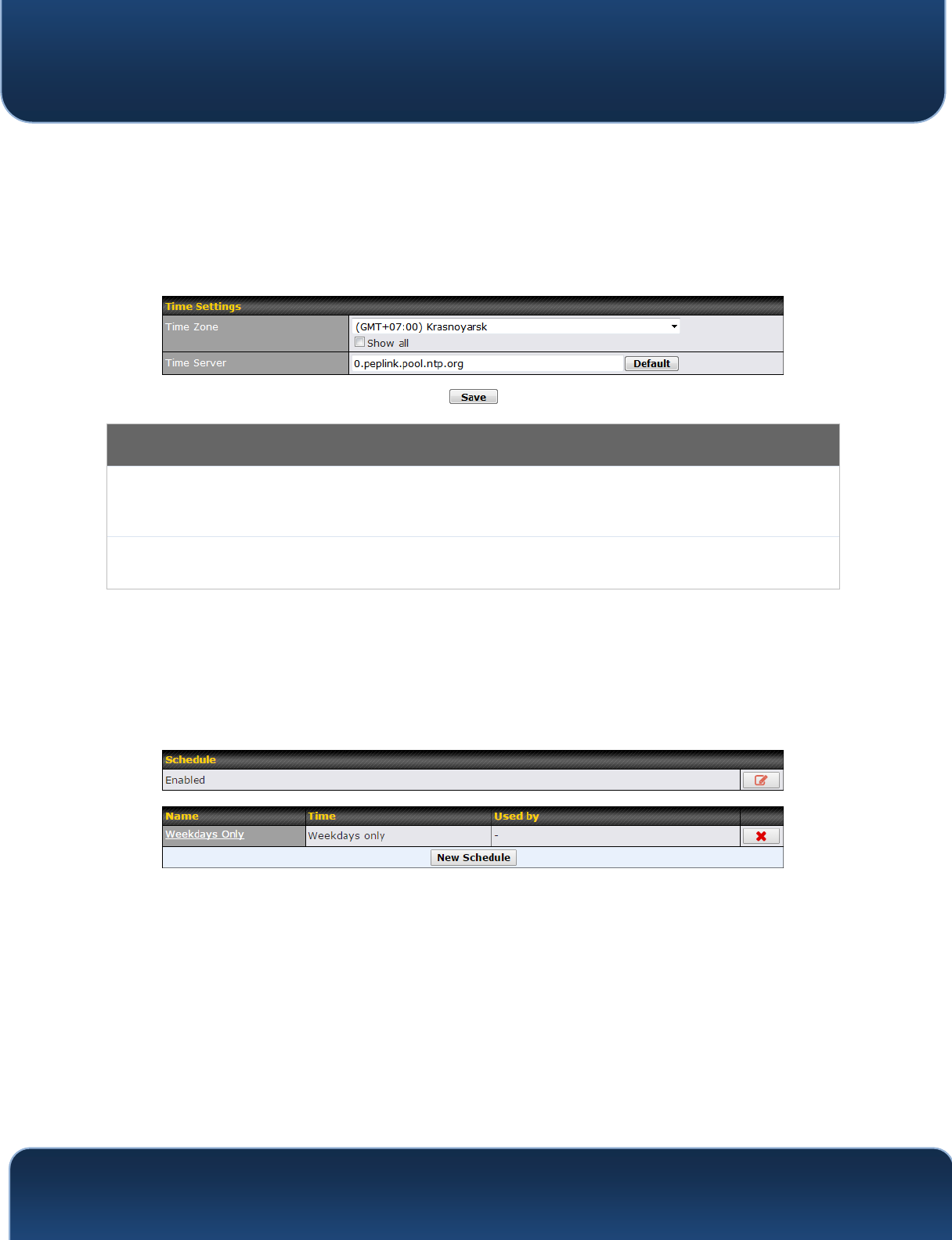
Pepwave MAX and Surf User Manual
http://www.pepwave.com
159
Copyright @ 2018 Pepwave
21.3 Time
Time Settings enables the system clock of the Pepwave router to be
synchronized with a specified time server. Time settings are located at
System>Time.
Time Settings
Time Zone
This specifies the time zone (along with the corresponding Daylight Savings Time
scheme). The Time Zone value affects the time stamps in the Pepwave router’s
event log and e-mail notifications. Check Show all to show all time zone options.
Time Server
This setting specifies the NTP network time server to be utilized by the Pepwave
router.
21.4 Schedule
Enable and disable different functions (such as WAN connections, outbound
policy, and firewalls at different times, based on a user-scheduled configuration
profile. The settings for this are located at System > Schedule
Enable scheduling, and then click on your schedule name or on the New
Schedule button to begin.
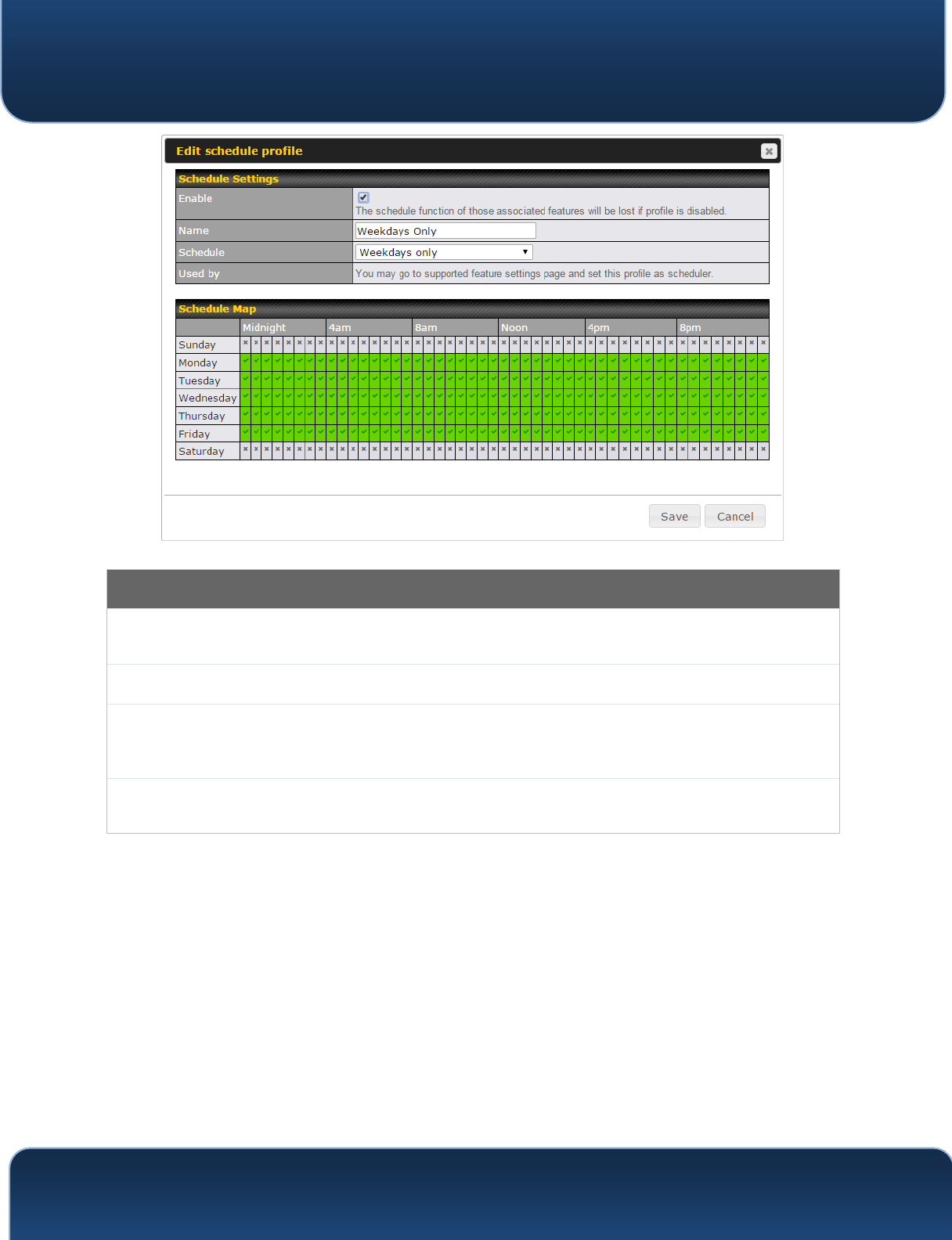
Pepwave MAX and Surf User Manual
http://www.pepwave.com
160
Copyright @ 2018 Pepwave
Edit Schedule Profile
Enabling
Click this checkbox to enable this schedule profile. Note that if this is disabled, then
any associated features will also have their scheduling disabled.
Name
Enter your desired name for this particular schedule profile.
Schedule
Click the drop-down menu to choose pre-defined schedules as your starting point.
Please note that upon selection, previous changes on the schedule map will be
deleted.
Schedule Map
Click on the desired times to enable features at that time period. You can hold your
mouse for faster entry.
21.5 Email Notification
Email notification functionality provides a system administrator with up-to-date
information on network status. The settings for configuring email notifications are
found at System>Email Notification.
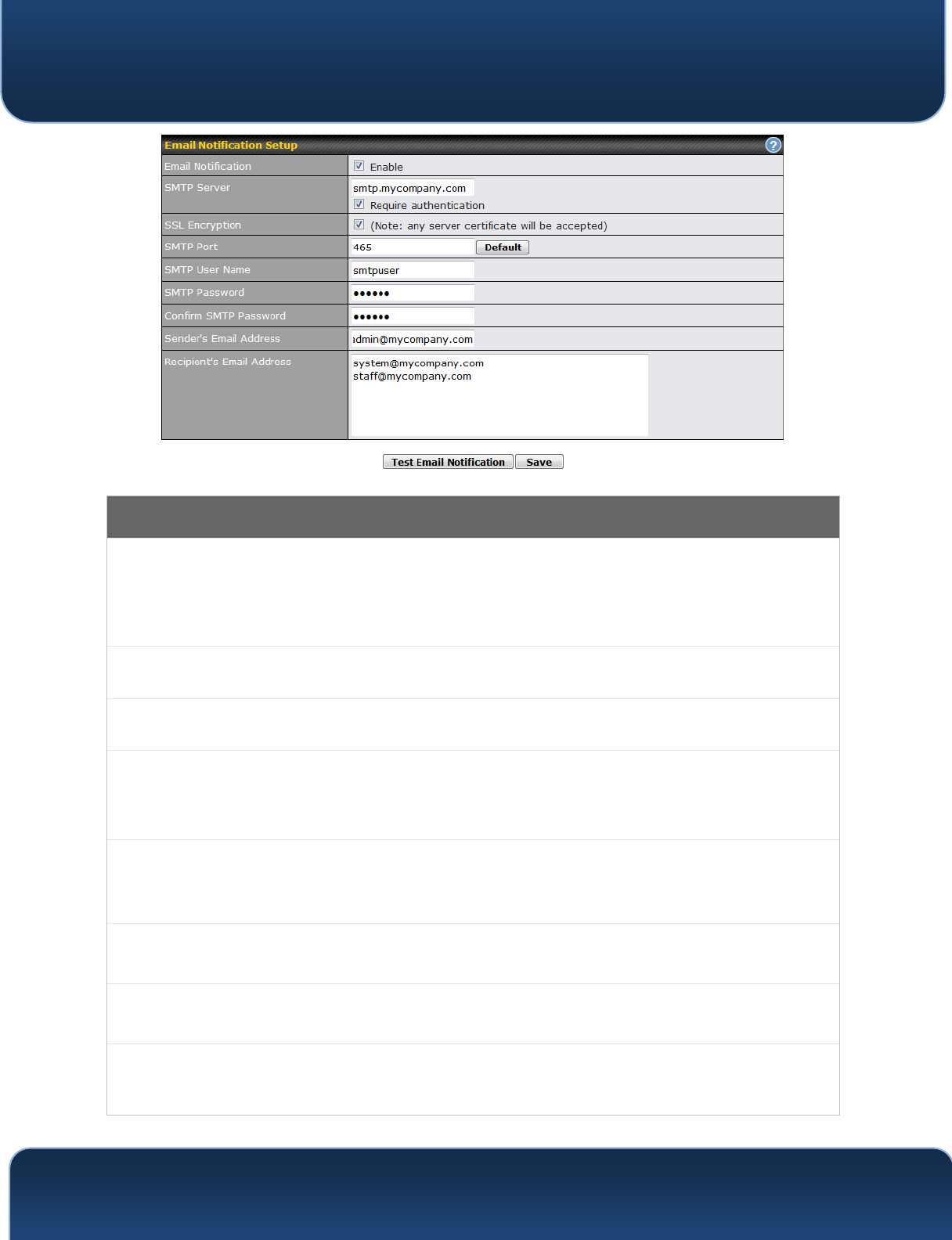
Pepwave MAX and Surf User Manual
http://www.pepwave.com
161
Copyright @ 2018 Pepwave
Email Notification Settings
Email
Notification
This setting specifies whether or not to enable email notification. If Enable is
checked, the Pepwave router will send email messages to system administrators
when the WAN status changes or when new firmware is available. If Enable is not
checked, email notification is disabled and the Pepwave router will not send email
messages.
SMTP Server
This setting specifies the SMTP server to be used for sending email. If the server
requires authentication, check Require authentication.
SSL Encryption
Check the box to enable SMTPS. When the box is checked, SMTP Port will be
changed to 465 automatically.
SMTP Port
This field is for specifying the SMTP port number. By default, this is set to 25; when SSL
Encryption is checked, the default port number will be set to 465. You may
customize the port number by editing this field. Click Default to restore the number
to its default setting.
SMTP User
Name /
Password
This setting specifies the SMTP username and password while sending email. These
options are shown only if Require authentication is checked in the SMTP Server
setting.
Confirm SMTP
Password
This field allows you to verify and confirm the new administrator password.
Sender’s Email
Address
This setting specifies the email address the Pepwave router will use to send reports.
Recipient’s
Email Address
This setting specifies the email address(es) to which the Pepwave router will send
email notifications. For multiple recipients, separate each email addresses using the
enter key.
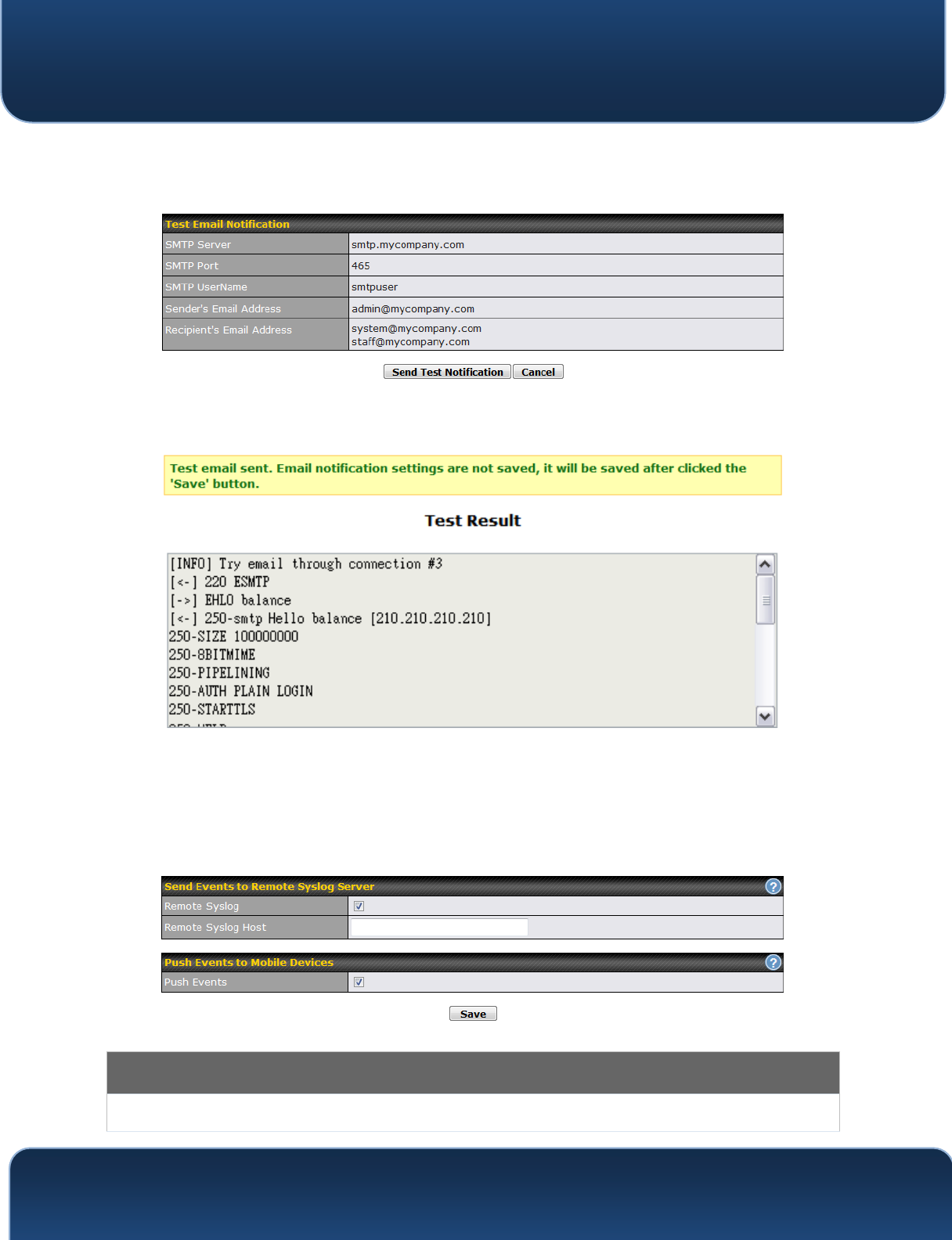
Pepwave MAX and Surf User Manual
http://www.pepwave.com
162
Copyright @ 2018 Pepwave
After you have finished setting up email notifications, you can click the Test
Email Notification button to test the settings before saving. After Test Email
Notification is clicked, you will see this screen to confirm the settings:
Click Send Test Notification to confirm. In a few seconds, you will see a message
with detailed test results.
21.6 Event Log
Event log functionality enables event logging at a specified remote syslog
server. The settings for configuring the remote system log can be found at
System>Event Log.
Event Log Settings
Remote Syslog
This setting specifies whether or not to log events at the specified remote syslog
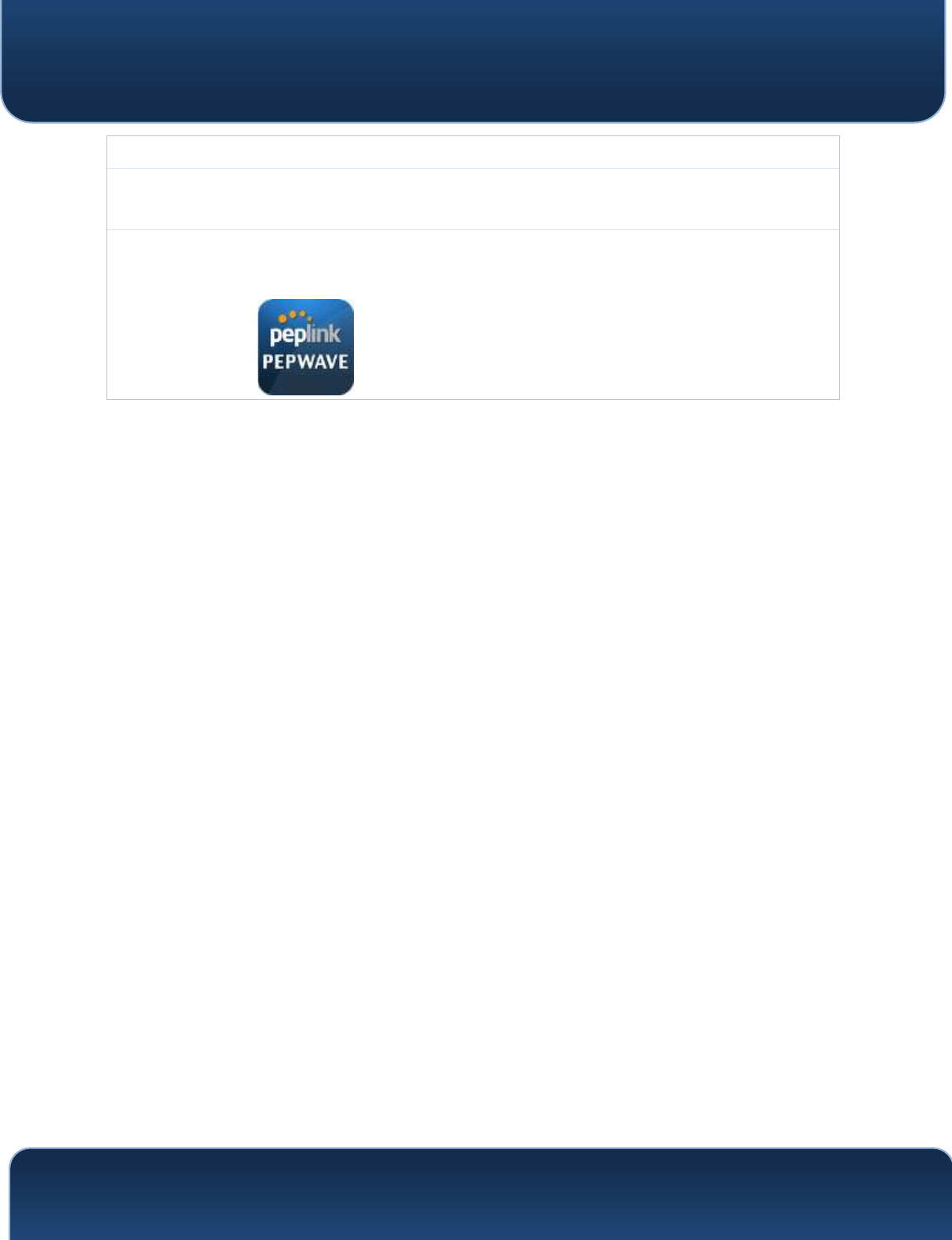
Pepwave MAX and Surf User Manual
http://www.pepwave.com
163
Copyright @ 2018 Pepwave
server.
Remote Syslog
Host
This setting specifies the IP address or hostname of the remote syslog server.
Push Events
The Pepwave router can also send push notifications to mobile devices that have
our Mobile Router Utility installed. Check the box to activate this feature.
For more information on the Router Utility, go to:
www.peplink.com/products/router-utility
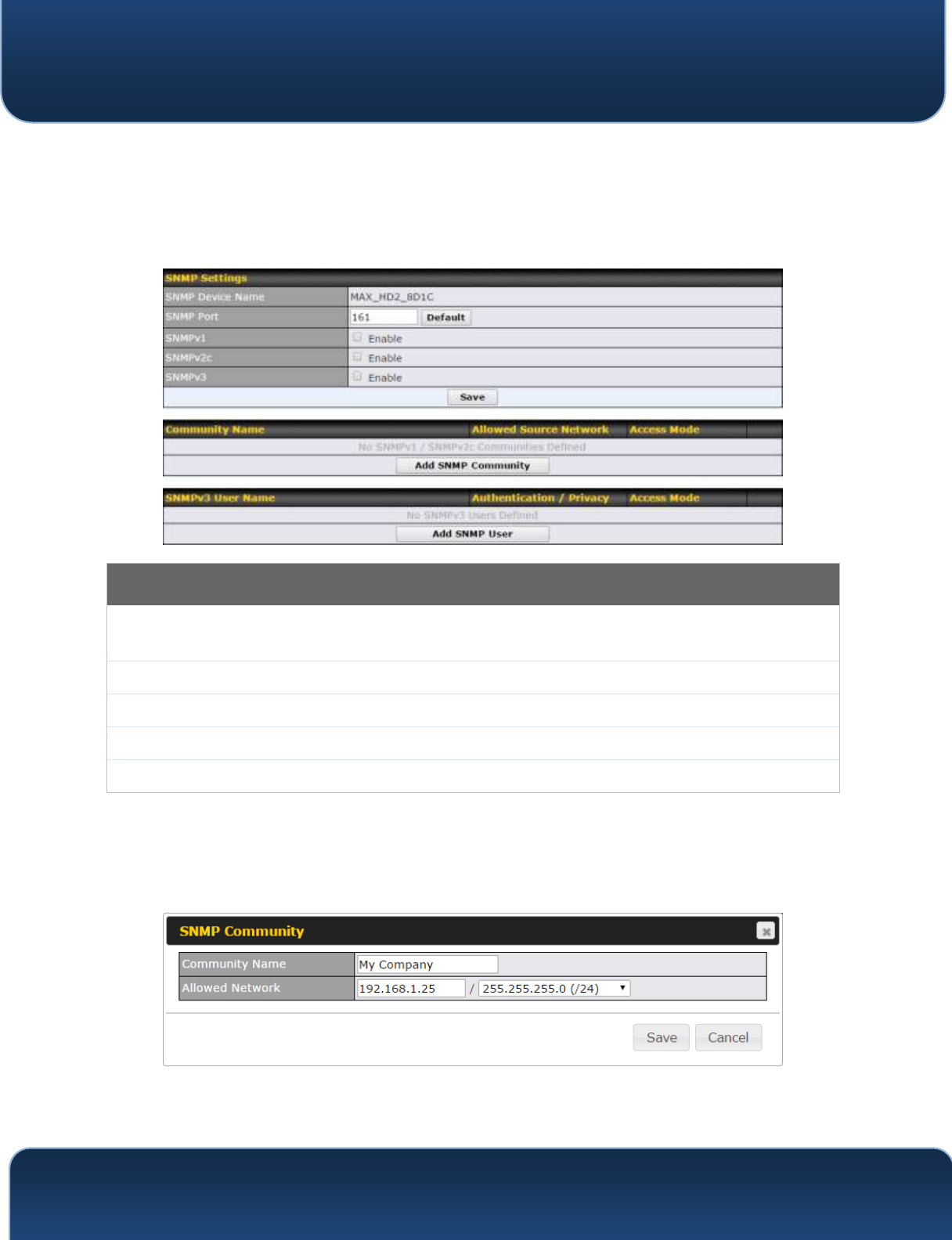
Pepwave MAX and Surf User Manual
http://www.pepwave.com
164
Copyright @ 2018 Pepwave
21.7 SNMP
SNMP or simple network management protocol is an open standard that can be
used to collect information about the Pepwave router. SNMP configuration is
located at System>SNMP.
SNMP Settings
SNMP Device
Name
This field shows the router name defined at System>Admin Security.
SNMP Port
This option specifies the port which SNMP will use. The default port is 161.
SNMPv1
This option allows you to enable SNMP version 1.
SNMPv2
This option allows you to enable SNMP version 2.
SNMPv3
This option allows you to enable SNMP version 3.
To add a community for either SNMPv1 or SNMPv2, click the Add SNMP
Community button in the Community Name table, upon which the following
screen is displayed:
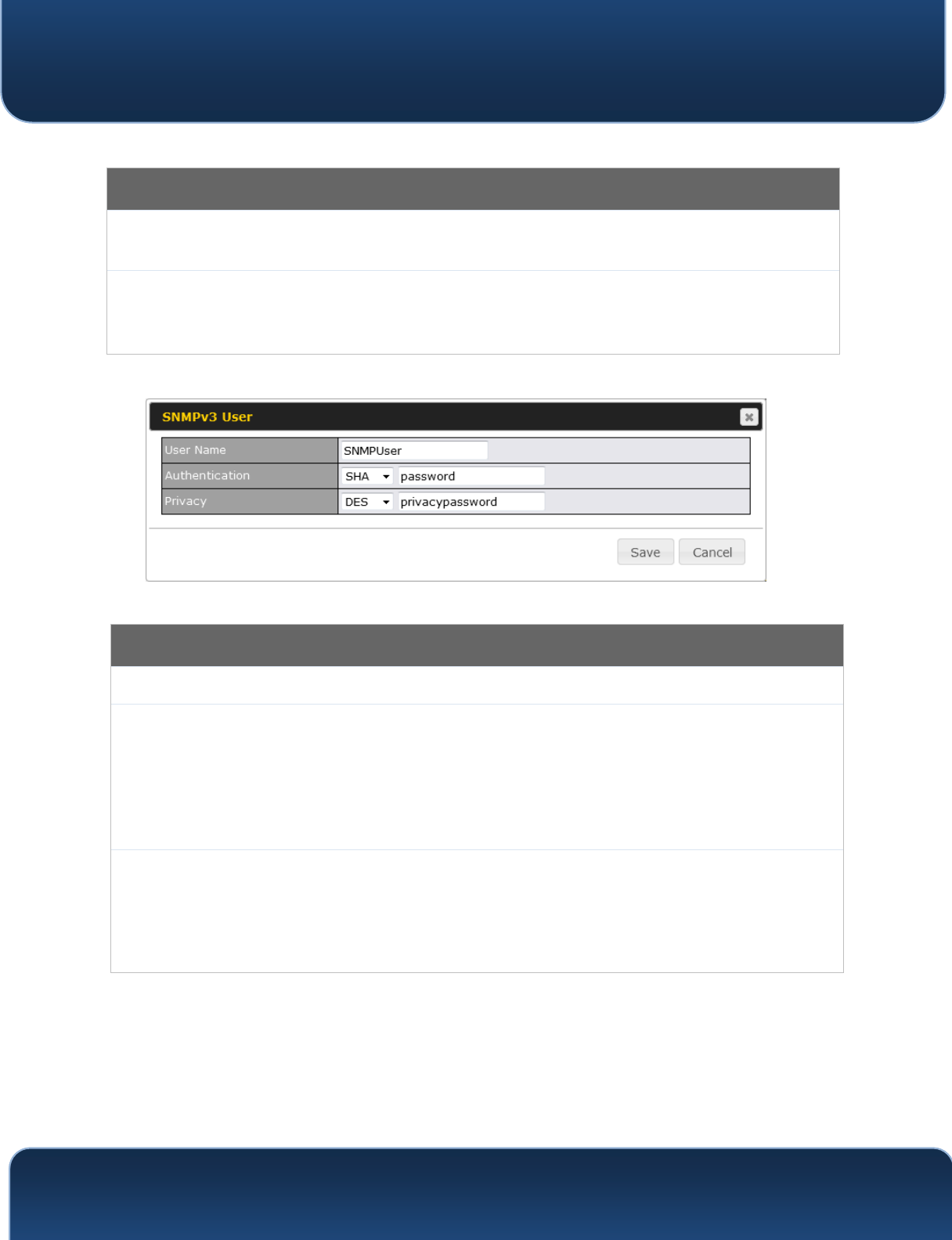
Pepwave MAX and Surf User Manual
http://www.pepwave.com
165
Copyright @ 2018 Pepwave
SNMP Community Settings
Community
Name
This setting specifies the SNMP community name.
Allowed
Source Subnet
Address
This setting specifies a subnet from which access to the SNMP server is allowed. Enter
subnet address here (e.g., 192.168.1.0) and select the appropriate subnet mask.
To define a user name for SNMPv3, click Add SNMP User in the SNMPv3 User
Name table, upon which the following screen is displayed:
SNMPv3 User Settings
User Name
This setting specifies a user name to be used in SNMPv3.
Authentication
Protocol
This setting specifies via a drop-down menu one of the following valid
authentication protocols:
NONE
MD5
SHA
When MD5 or SHA is selected, an entry field will appear for the password.
Privacy Protocol
This setting specifies via a drop-down menu one of the following valid privacy
protocols:
NONE
DES
When DES is selected, an entry field will appear for the password.
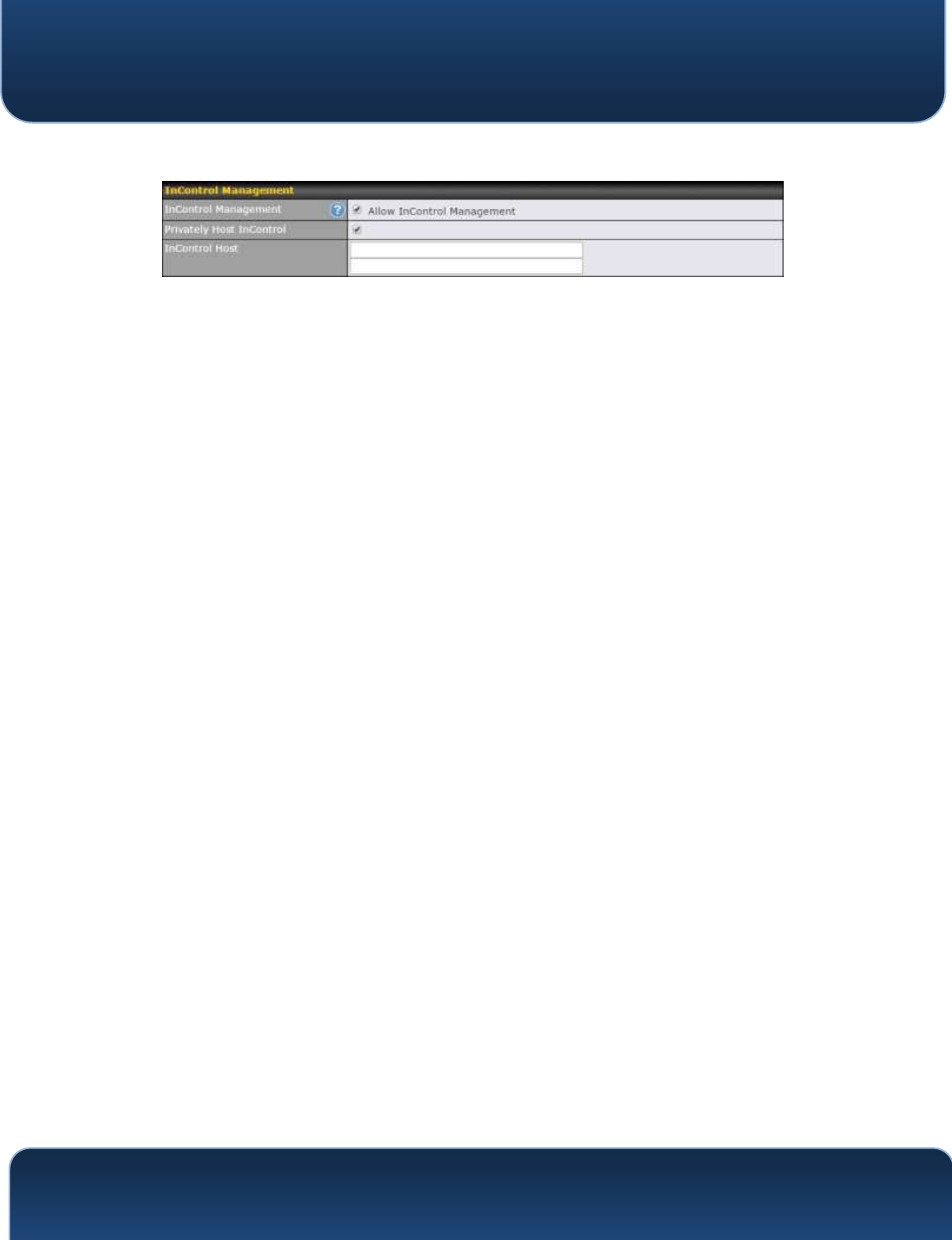
Pepwave MAX and Surf User Manual
http://www.pepwave.com
166
Copyright @ 2018 Pepwave
21.8 InControl
InControl is a cloud-based service which allows you to manage all of your
Peplink and Pepwave devices with one unified system. With it, you can
generate reports, gather statistics, and configure your devices automatically. All
of this is now possible with InControl.
When this check box is checked, the device's status information will be sent to the
Peplink InControl system. This device's usage data and configuration will be sent
to the system if you enable the features in the system.
Alternately, you could also privately host InControl. Simply check the box beside
the “Privately Host InControl” open, and enter the IP Address of your InControl
Host.
You can sign up for an InControl account at https://incontrol2.peplink.com/.
You can register your devices under the account, monitor their status, see their
usage reports, and receive offline notifications.
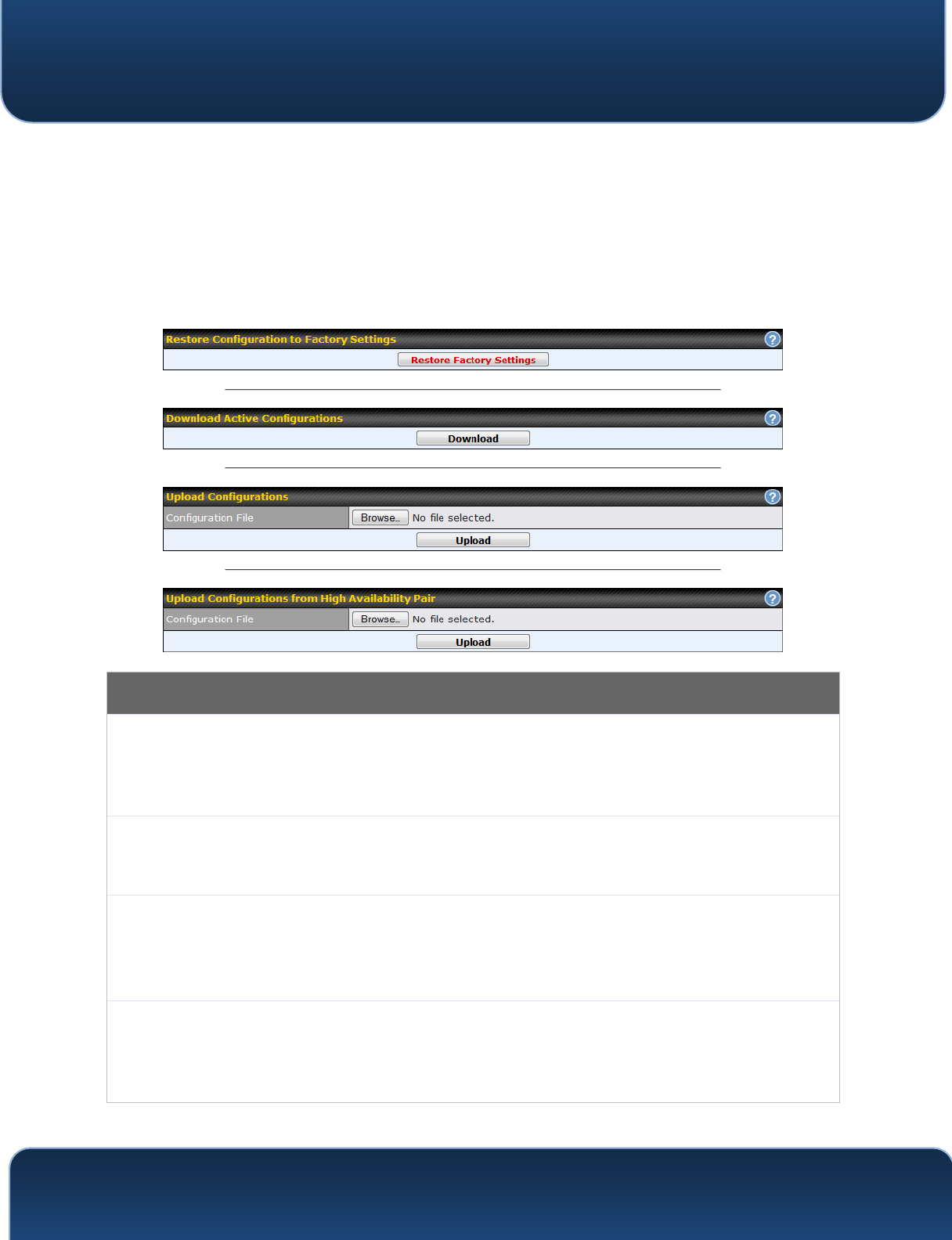
Pepwave MAX and Surf User Manual
http://www.pepwave.com
167
Copyright @ 2018 Pepwave
21.9 Configuration
Backing up Pepwave router settings immediately after successful completion of
initial setup is strongly recommended. The functionality to download and upload
Pepwave router settings is found at System>Configuration. Note that available
options vary by model.
Configuration
Restore
Configuration
to Factory
Settings
The Restore Factory Settings button is to reset the configuration to factory default
settings. After clicking the button, you will need to click the Apply Changes button
on the top right corner to make the settings effective.
Download
Active
Configurations
Click Download to backup the current active settings.
Upload
Configurations
To restore or change settings based on a configuration file, click Choose File to
locate the configuration file on the local computer, and then click Upload. The new
settings can then be applied by clicking the Apply Changes button on the page
header, or you can cancel the procedure by pressing discard on the main page of
the web admin interface.
Upload
Configurations
from High
Availability Pair
In a high availability (HA) configuration, a Pepwave router can quickly load the
configuration of its HA counterpart. To do so, click the Upload button. After loading
the settings, configure the LAN IP address of the Pepwve router so that it is different
from the HA counterpart.
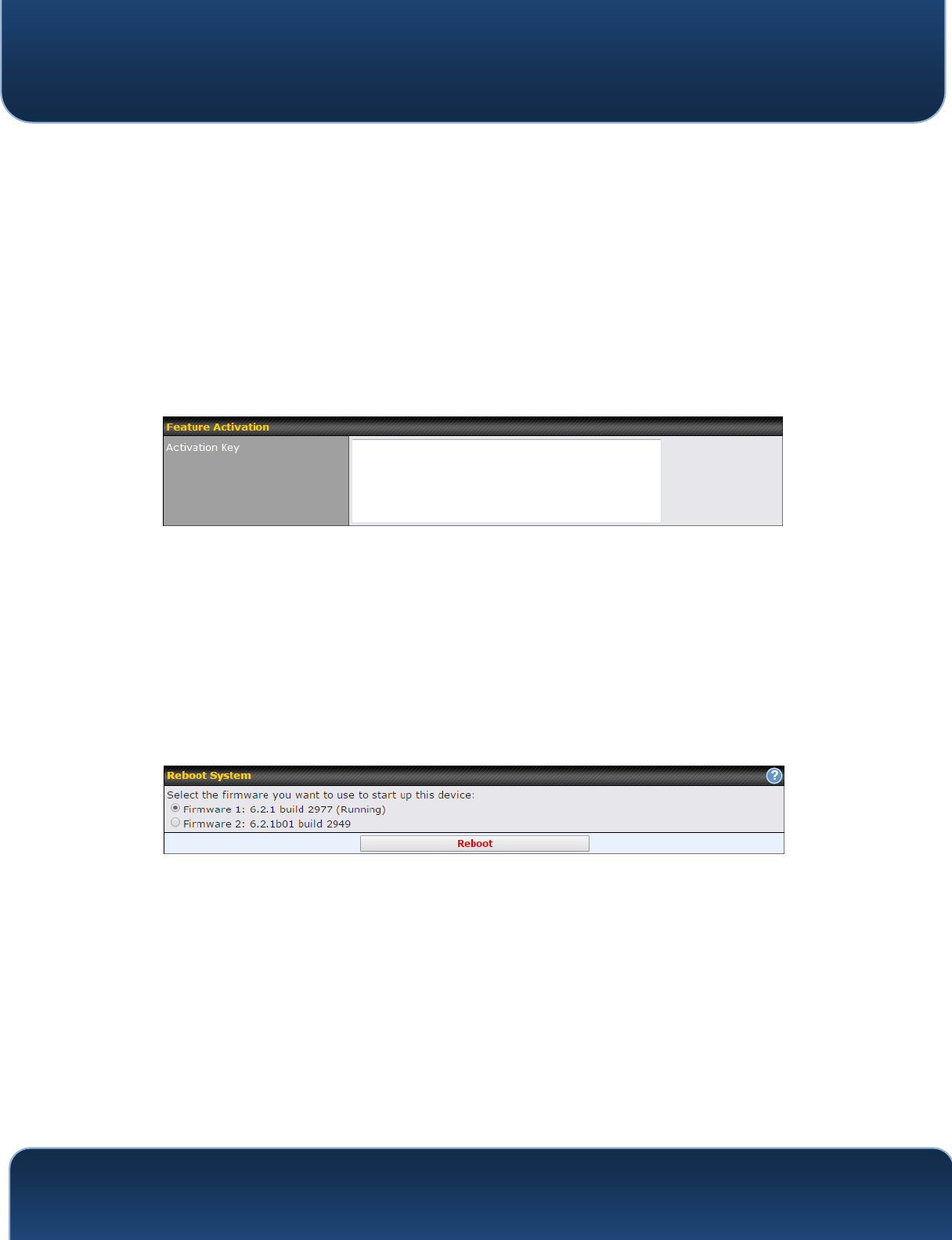
Pepwave MAX and Surf User Manual
http://www.pepwave.com
168
Copyright @ 2018 Pepwave
21.10 Feature Add-ons
Some Pepwave routers have features that can be activated upon purchase.
Once the purchase is complete, you will receive an activation key. Enter the key
in the Activation Key field, click Activate, and then click Apply Changes.
21.11 Reboot
This page provides a reboot button for restarting the system. For maximum
reliability, the Pepwave router can equip with two copies of firmware. Each
copy can be a different version. You can select the firmware version you would
like to reboot the device with. The firmware marked with (Running) is the current
system boot up firmware.
Please note that a firmware upgrade will always replace the inactive firmware
partition.
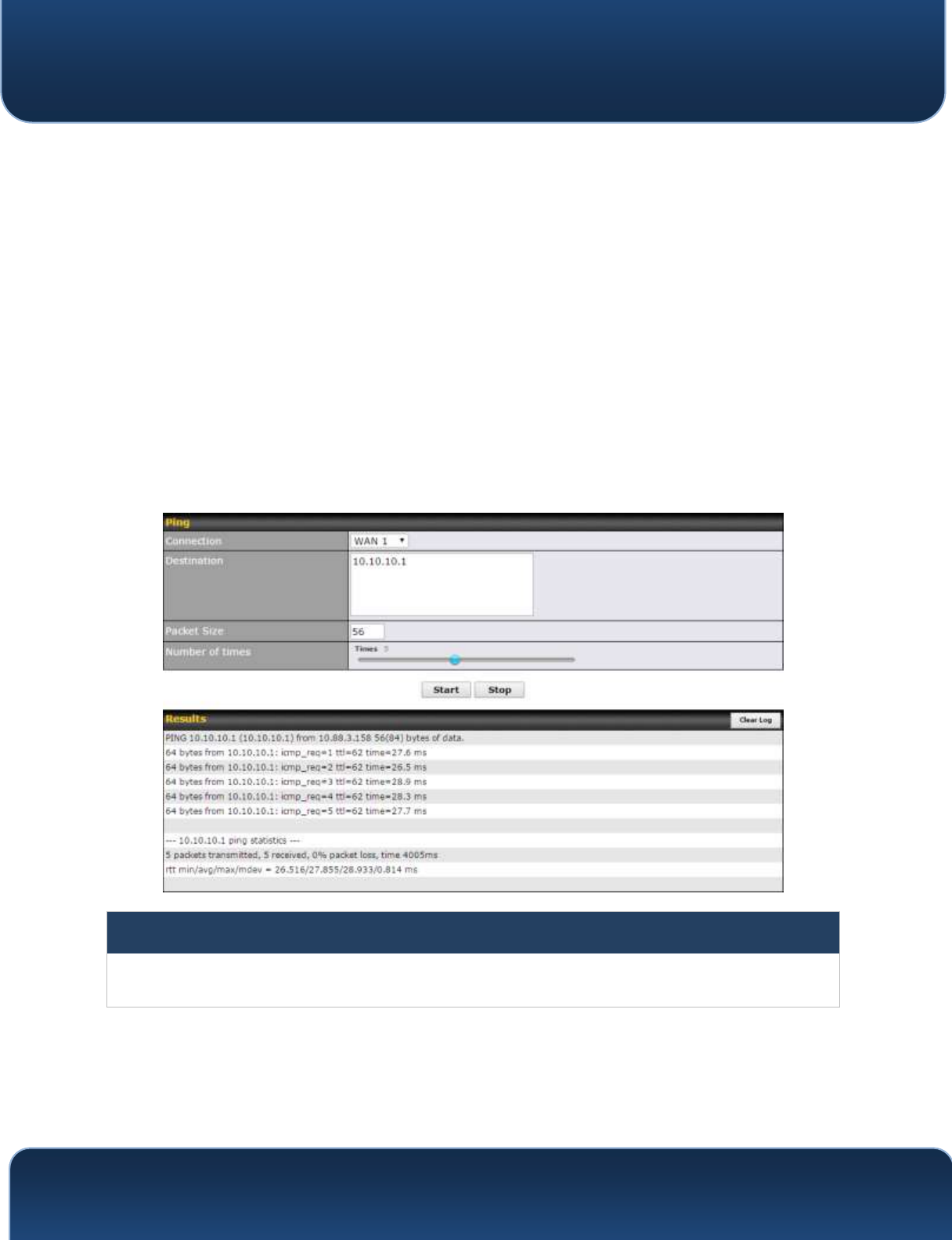
Pepwave MAX and Surf User Manual
http://www.pepwave.com
169
Copyright @ 2018 Pepwave
21.12 Ping
The ping test tool sends pings through a specified Ethernet interface or a
SpeedFusionTM VPN connection. You can specify the number of pings in the field
Number of times, to a maximum number of 10 times. Packet Size can be set to a
maximum of 1472 bytes. The ping utility is located at System>Tools>Ping,
illustrated below:
Tip
A system administrator can use the ping utility to manually check the connectivity of a particular
LAN/WAN connection.
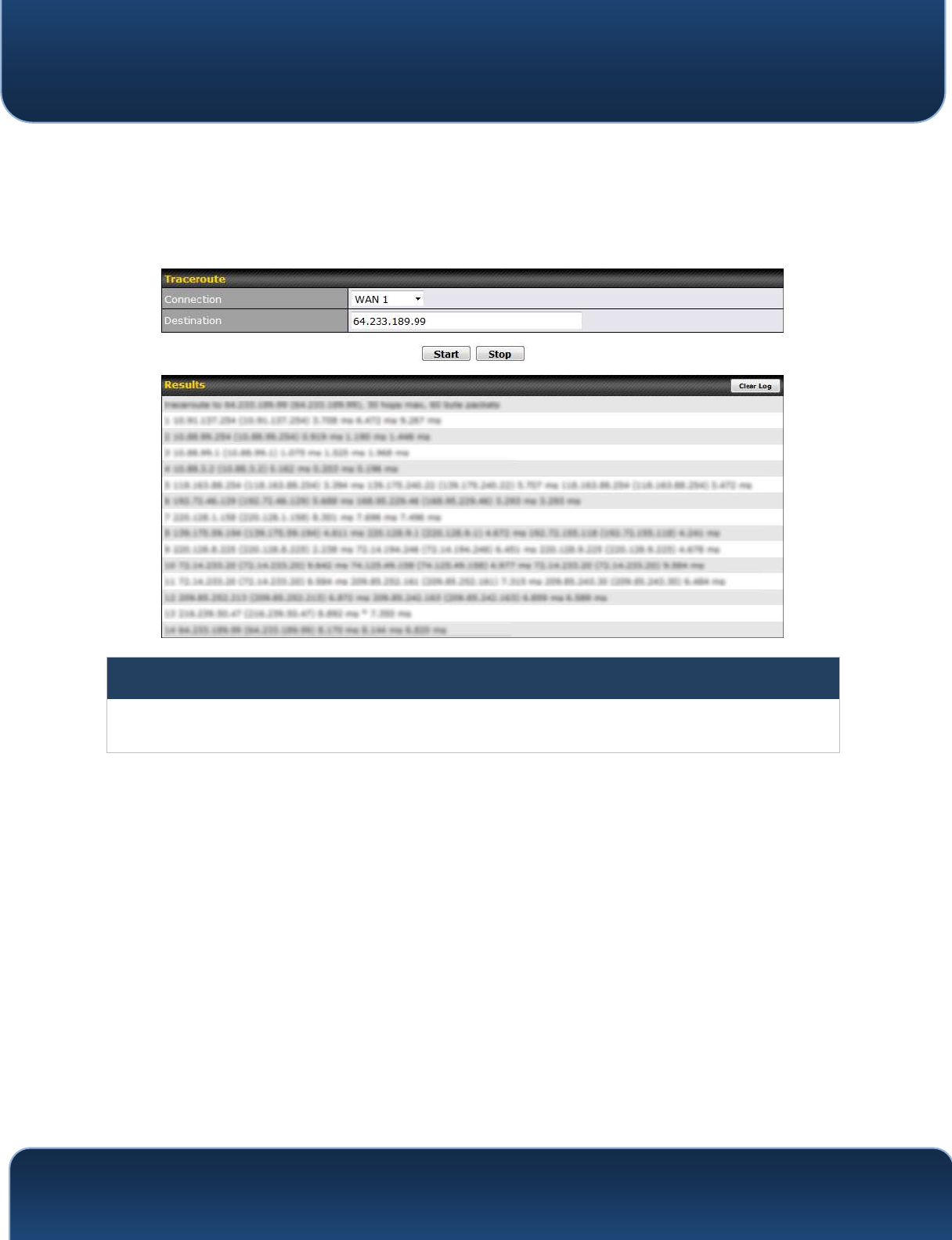
Pepwave MAX and Surf User Manual
http://www.pepwave.com
170
Copyright @ 2018 Pepwave
21.13 Traceroute Test
The traceroute test tool traces the routing path to the destination through a
particular Ethernet interface or a SpeedFusionTM connection. The traceroute test
utility is located at System>Tools>Traceroute.
Tip
A system administrator can use the traceroute utility to analyze the connection path of a LAN/WAN
connection.
21.14 PepVPN Test
The PepVPN Test tool can help to test the throughput between different VPN
peers.
You can define the Test Type, Direction, and Duration of the test, and press Go!
to perform the throughput test. The VPN test utility is located at
System>Tools>PepVPN Test, illustrated as follows:
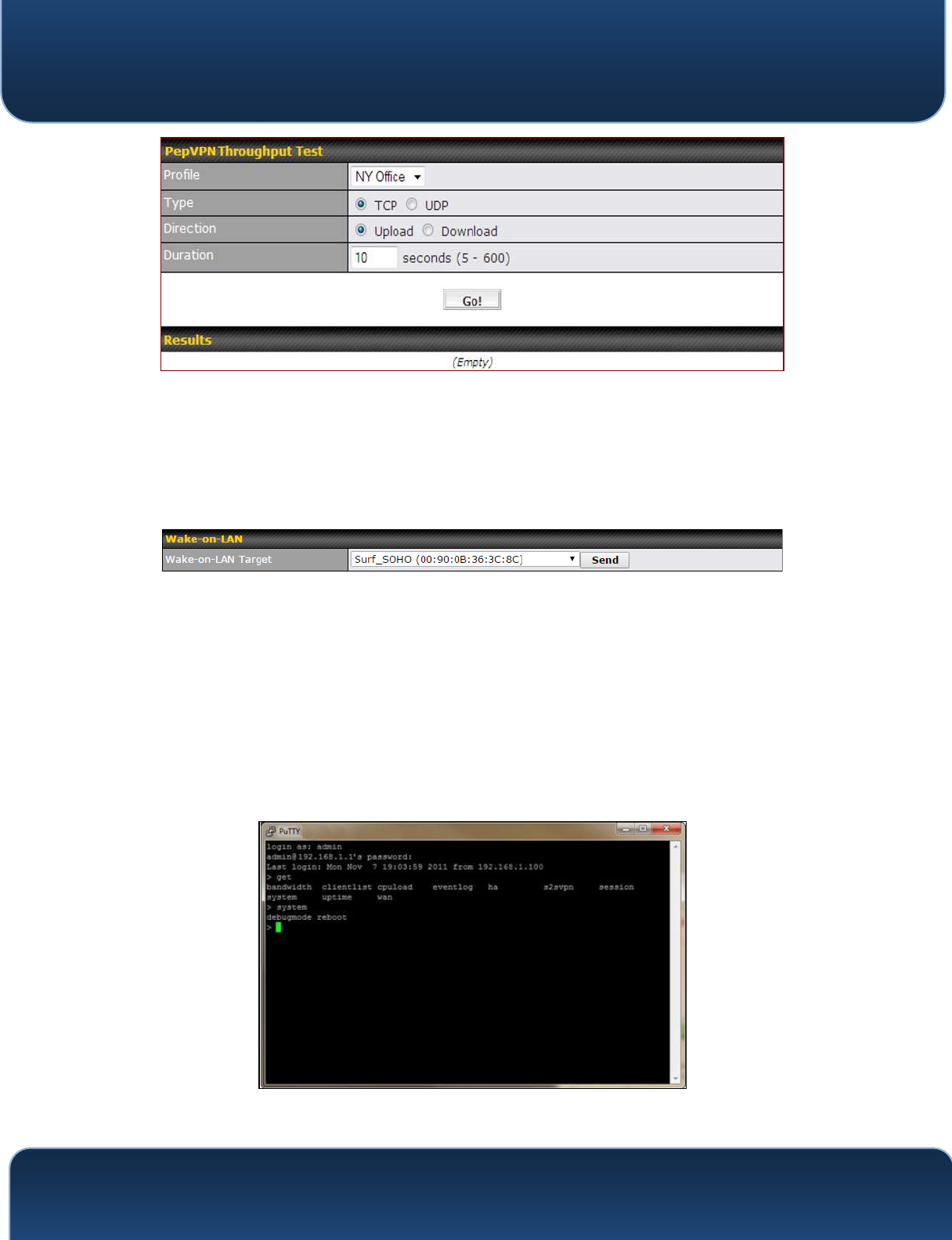
Pepwave MAX and Surf User Manual
http://www.pepwave.com
171
Copyright @ 2018 Pepwave
21.15 Wake-on-LAN
Peplink routers can send special “magic packets” to any client specified from the Web
UI. To access this feature, navigate to System > Tools > Wake-on-LAN
Select a client from the drop-down list and click Send to send a “magic packet”
21.16 CLI (Command Line Interface Support)
The CLI (command line interface) can be accessed via SSH. This field enables
CLI support. The below settings specify which TCP port and which interface(s)
should accept remote SSH CLI access. The user name and password used for
remote SSH CLI access are the same as those used for web admin access.
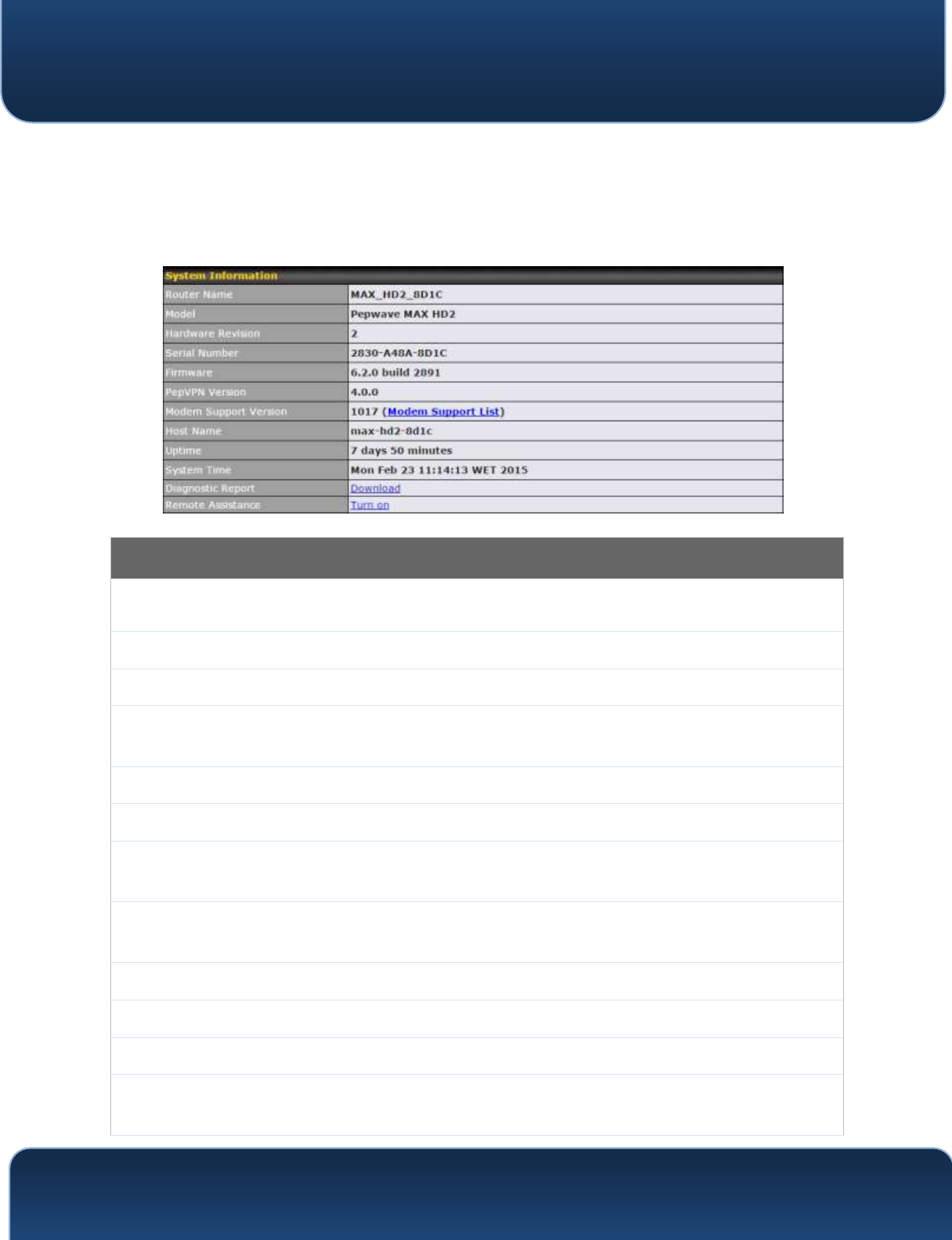
Pepwave MAX and Surf User Manual
http://www.pepwave.com
172
Copyright @ 2018 Pepwave
22 Status
22.1 Device
System information is located at Status>Device.
System Information
Router Name
This is the name specified in the Router Name field located at System>Admin
Security.
Model
This shows the model name and number of this device.
Product Code
If your model uses a product code, it will appear here.
Hardware
Revision
This shows the hardware version of this device.
Serial Number
This shows the serial number of this device.
Firmware
This shows the firmware version this device is currently running.
PepVPN
Version
This shows the current PepVPN version.
Modem
Support Version
This shows the modem support version. For a list of supported modems, click Modem
Support List.
Host Name
The host name assigned to the Pepwave router appears here.
Uptime
This shows the length of time since the device has been rebooted.
System Time
This shows the current system time.
Diagnostic
Report
The Download link is for exporting a diagnostic report file required for system
investigation.
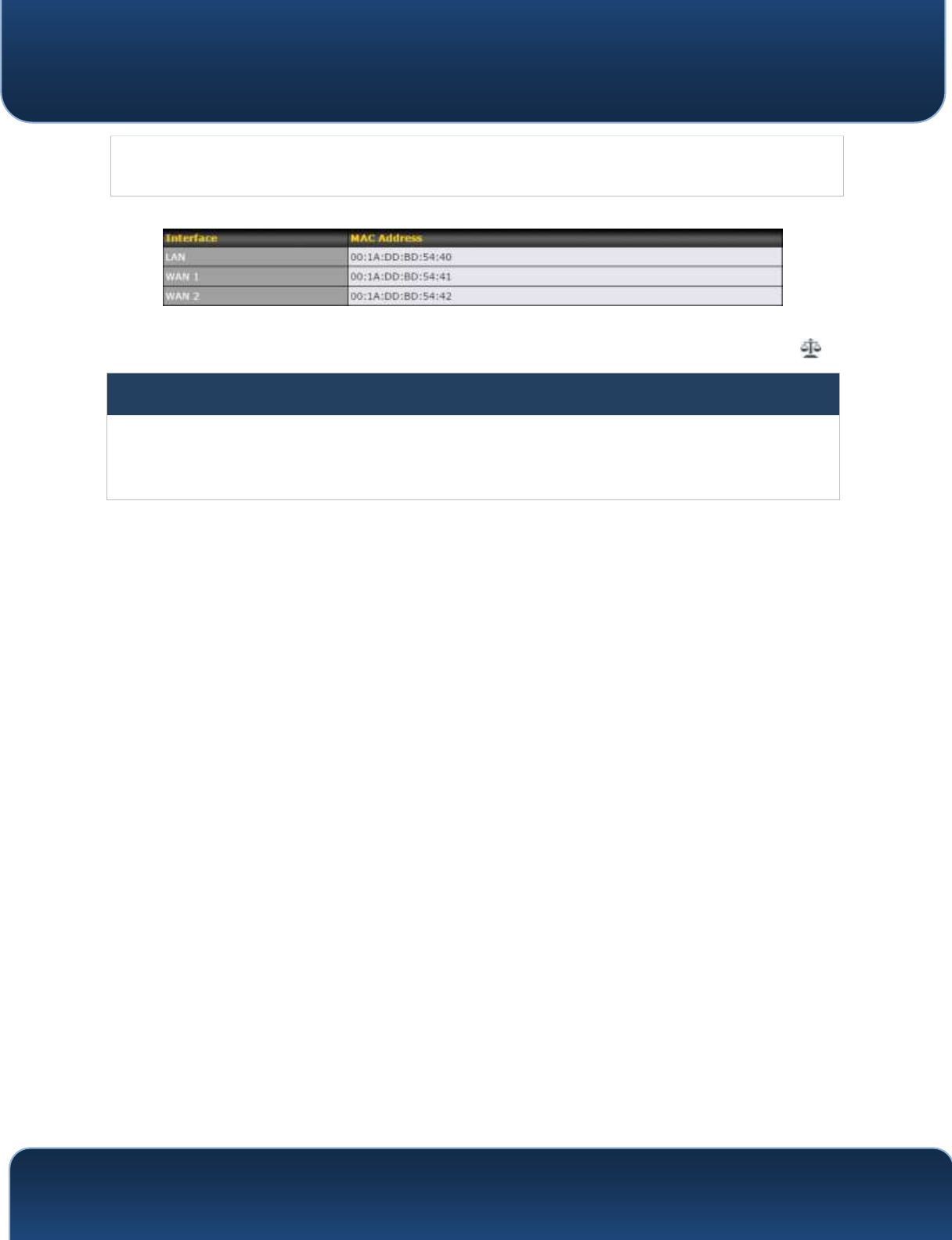
Pepwave MAX and Surf User Manual
http://www.pepwave.com
173
Copyright @ 2018 Pepwave
Remote
Assistance
Click Turn on to enable remote assistance.
The second table shows the MAC address of each LAN/WAN interface
connected. To view your device’s End User License Agreement (EULA), click .
Important Note
If you encounter issues and would like to contact the Pepwave Support Team
(http://www.pepwave.com/contact/), please download the diagnostic report file and attach it along
with a description of your issue.
In Firmware 5.1 or before, the diagnostic report file can be obtained at System>Reboot.
22.1.1 GPS Data
The MAX HD2 and HD2 IP67 automatically store up to seven days of GPS
location data in GPS eXchange format (GPX). To review this data using third-
party applications, click Status>Device and then download your GPX file.
The Pepwave MAX BR1, HD2, and HD2 IP67 export real-time location data in
NMEA format through the LAN IP address at TCP port 60660. It is accessible from
the LAN or over a SpeedFusion connection. To access the data via a virtual
serial port, install a virtual serial port driver. Visit
http://www.peplink.com/index.php?view=faq&id=294 to download the driver.
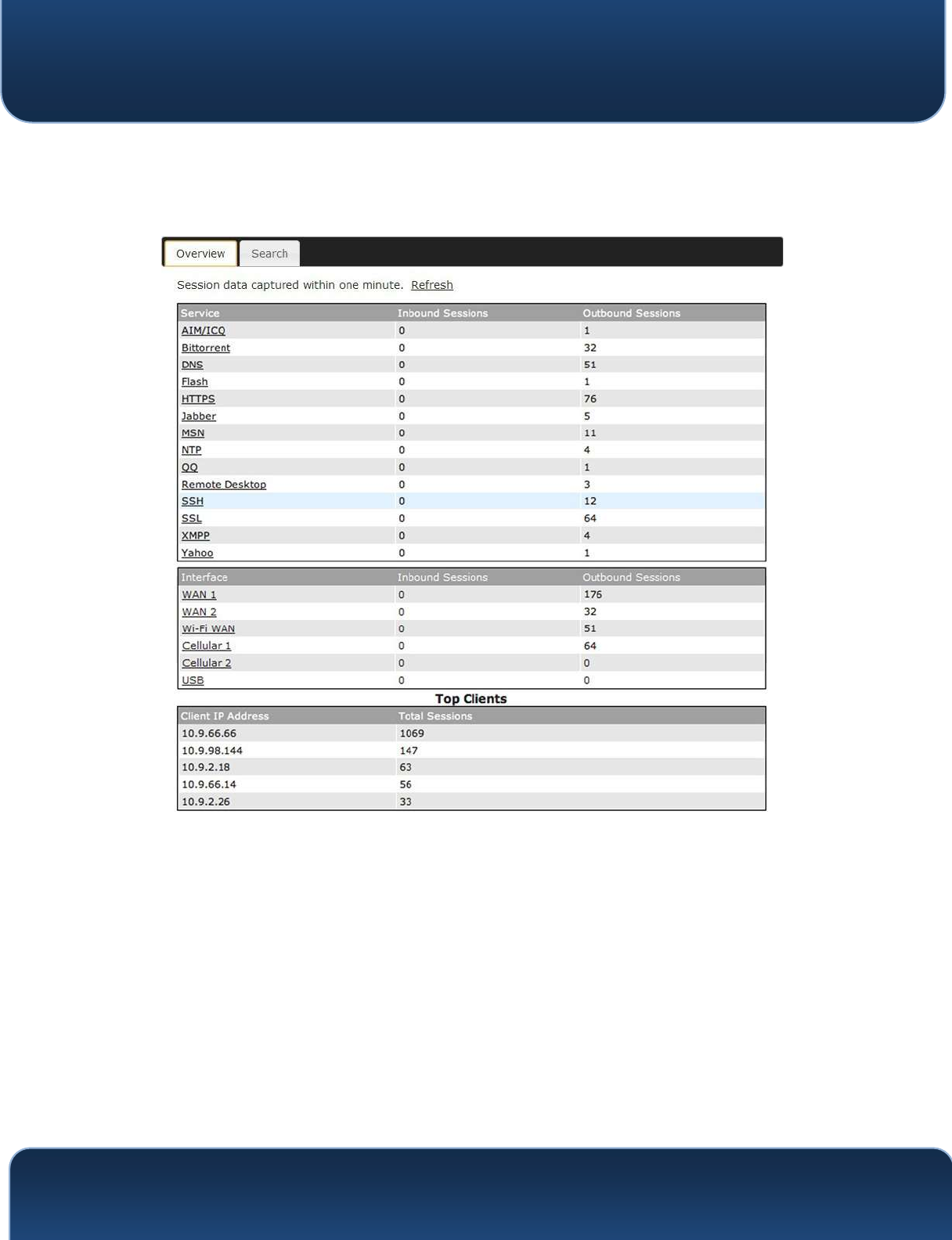
Pepwave MAX and Surf User Manual
http://www.pepwave.com
174
Copyright @ 2018 Pepwave
22.2 Active Sessions
Information on active sessions can be found at Status>Active
Sessions>Overview.
This screen displays the number of sessions initiated by each application. Click
on each service listing for additional information. This screen also indicates the
number of sessions initiated by each WAN port. In addition, you can see which
clients are initiating the most sessions.
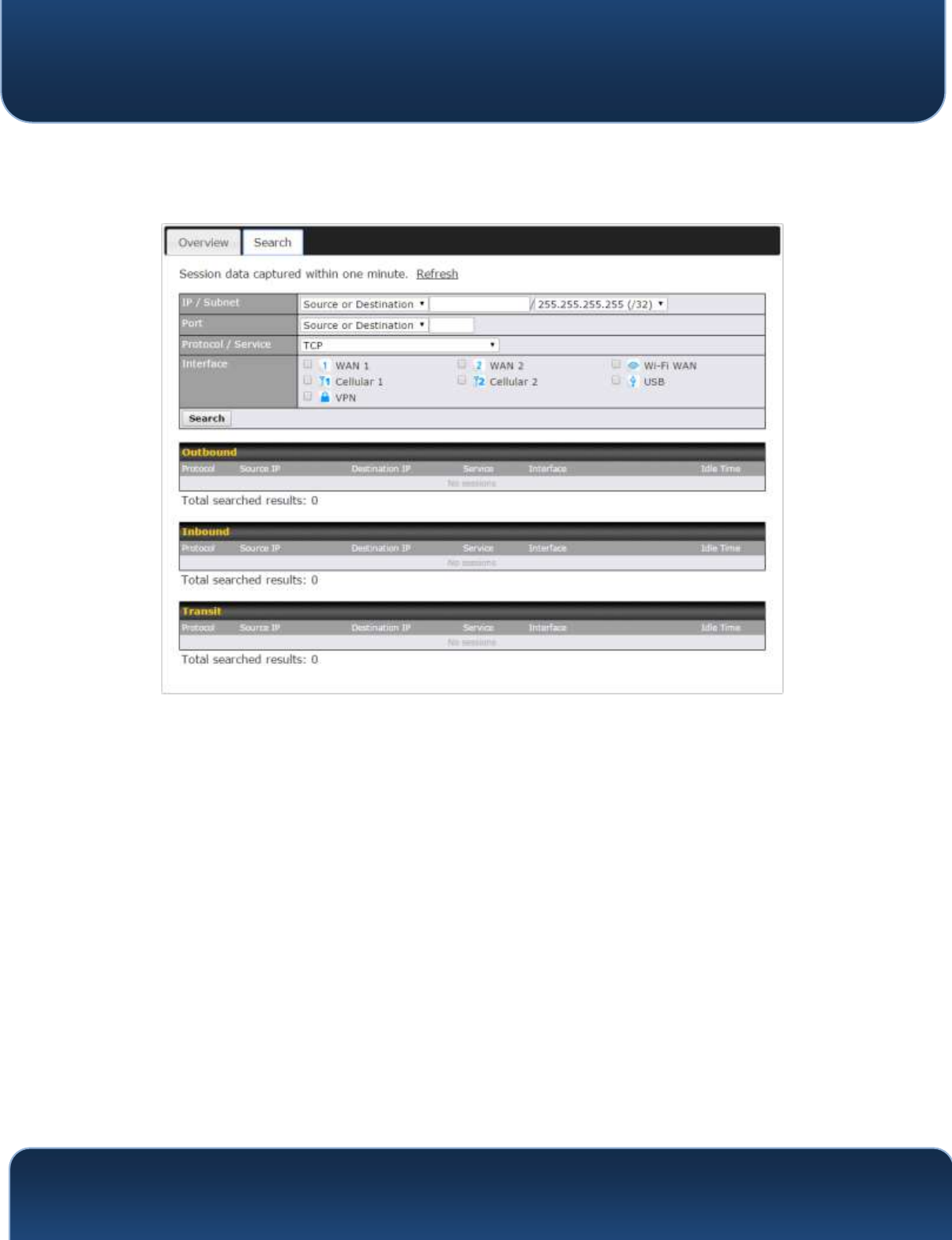
Pepwave MAX and Surf User Manual
http://www.pepwave.com
175
Copyright @ 2018 Pepwave
You can also perform a filtered search for specific sessions. You can filter by
subnet, port, protocol, and interface. To perform a search, navigate to
Status>Active Sessions>Search.
This Active Sessions section displays the active inbound/outbound sessions of
each WAN connection on the Pepwave router. A filter is available to sort active
session information. Enter a keyword in the field or check one of the WAN
connection boxes for filtering.
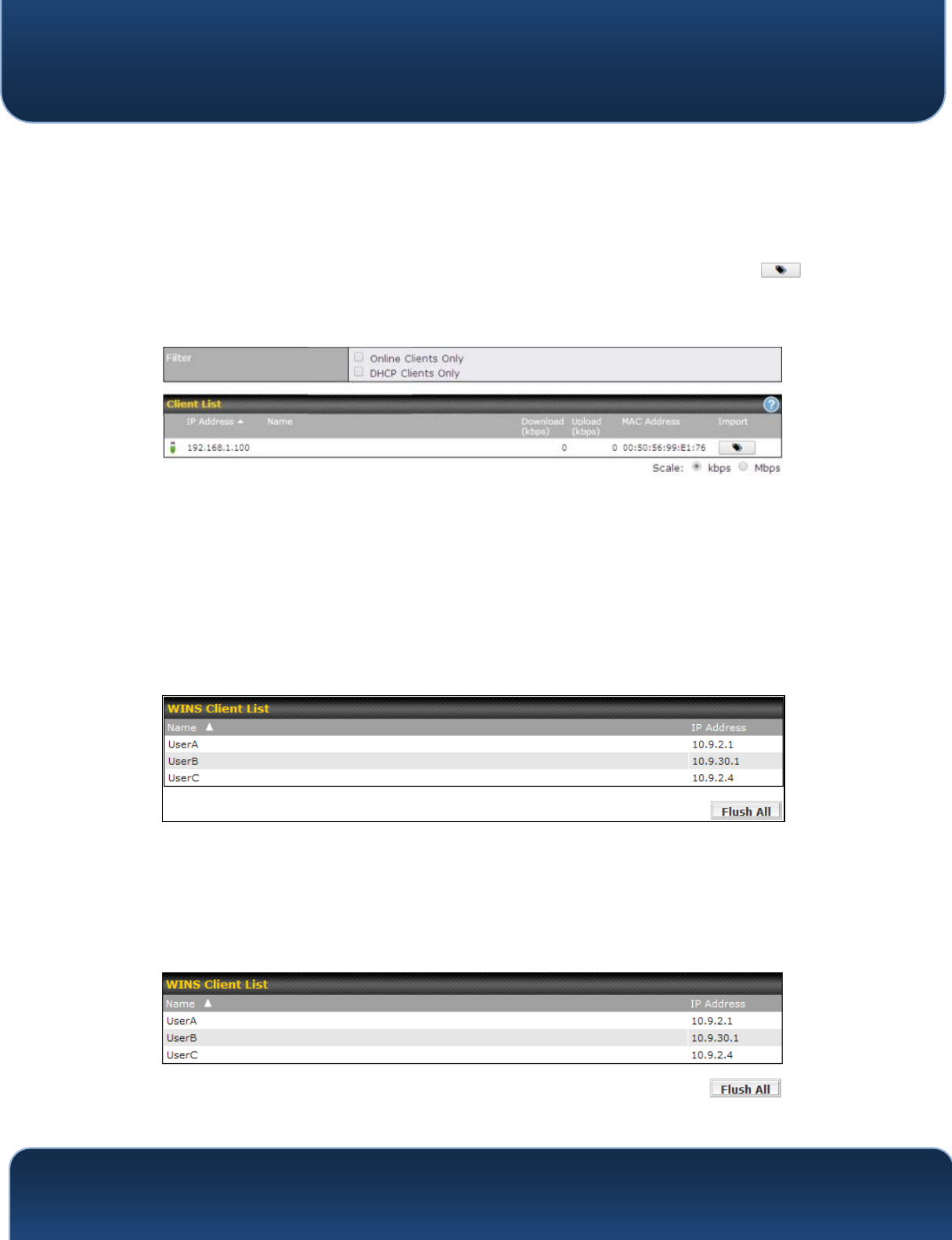
Pepwave MAX and Surf User Manual
http://www.pepwave.com
176
Copyright @ 2018 Pepwave
22.3 Client List
The client list table is located at Status>Client List. It lists DHCP and online client IP
addresses, names (retrieved from the DHCP reservation table or defined by
users), current download and upload rate, and MAC address.
Clients can be imported into the DHCP reservation table by clicking the
button on the right. You can update the record after import by going to
Network>LAN.
If the PPTP server (see Section 19.2), SpeedFusionTM (see Section 12.1), or AP
controller (see Section 20) is enabled, you may see the corresponding
connection name listed in the Name field.
22.4 WINS Client
The WINS client list table is located at Status>WINS Client.
The WINS client table lists the IP addresses and names of WINS clients. This option
will only be available when you have enabled the WINS server (navigation:
Network>Interfaces>LAN). The names of clients retrieved will be automatically
matched into the Client List (see previous section). Click Flush All to flush all WINS
client records.
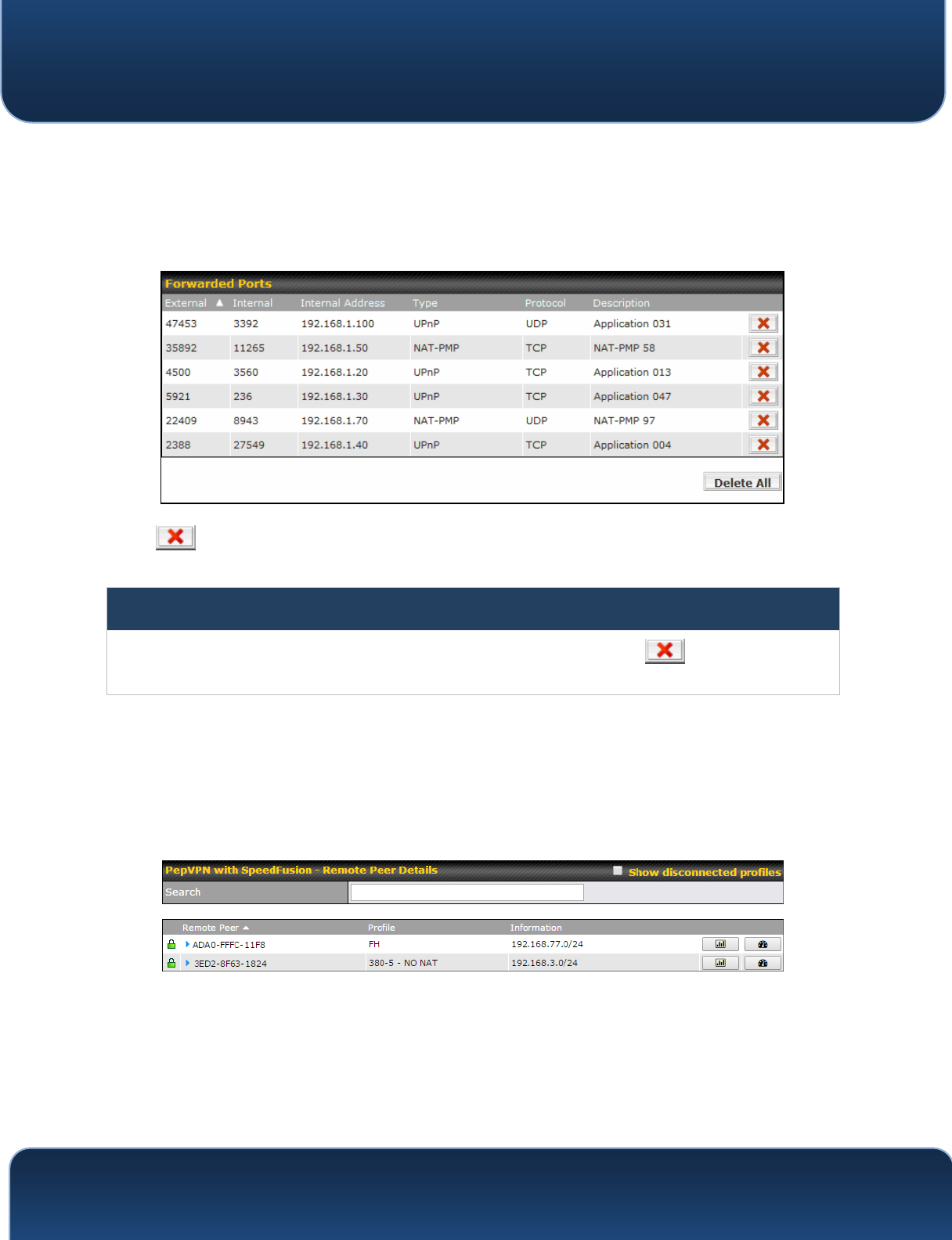
Pepwave MAX and Surf User Manual
http://www.pepwave.com
177
Copyright @ 2018 Pepwave
22.5 UPnP / NAT-PMP
The table that shows the forwarded ports under UPnP and NAT-PMP protocols is
located at Status>UPnP/NAT-PMP. This section appears only if you have enabled
UPnP / NAT-PMP as mentioned in Section 16.1.1.
Click to delete a single UPnP / NAT-PMP record in its corresponding row. To
delete all records, click Delete All on the right-hand side below the table.
Important Note
UPnP / NAT-PMP records will be deleted immediately after clicking the button or Delete All, without
the need to click Save or Confirm.
22.6 SpeedFusion Status
Current SpeedFusionTM status information is located at Status>SpeedFusionTM.
Details about SpeedFusionTM connection peers appears as below:
Click on the corresponding peer name to explore the WAN connection(s) status
and subnet information of each VPN peer.
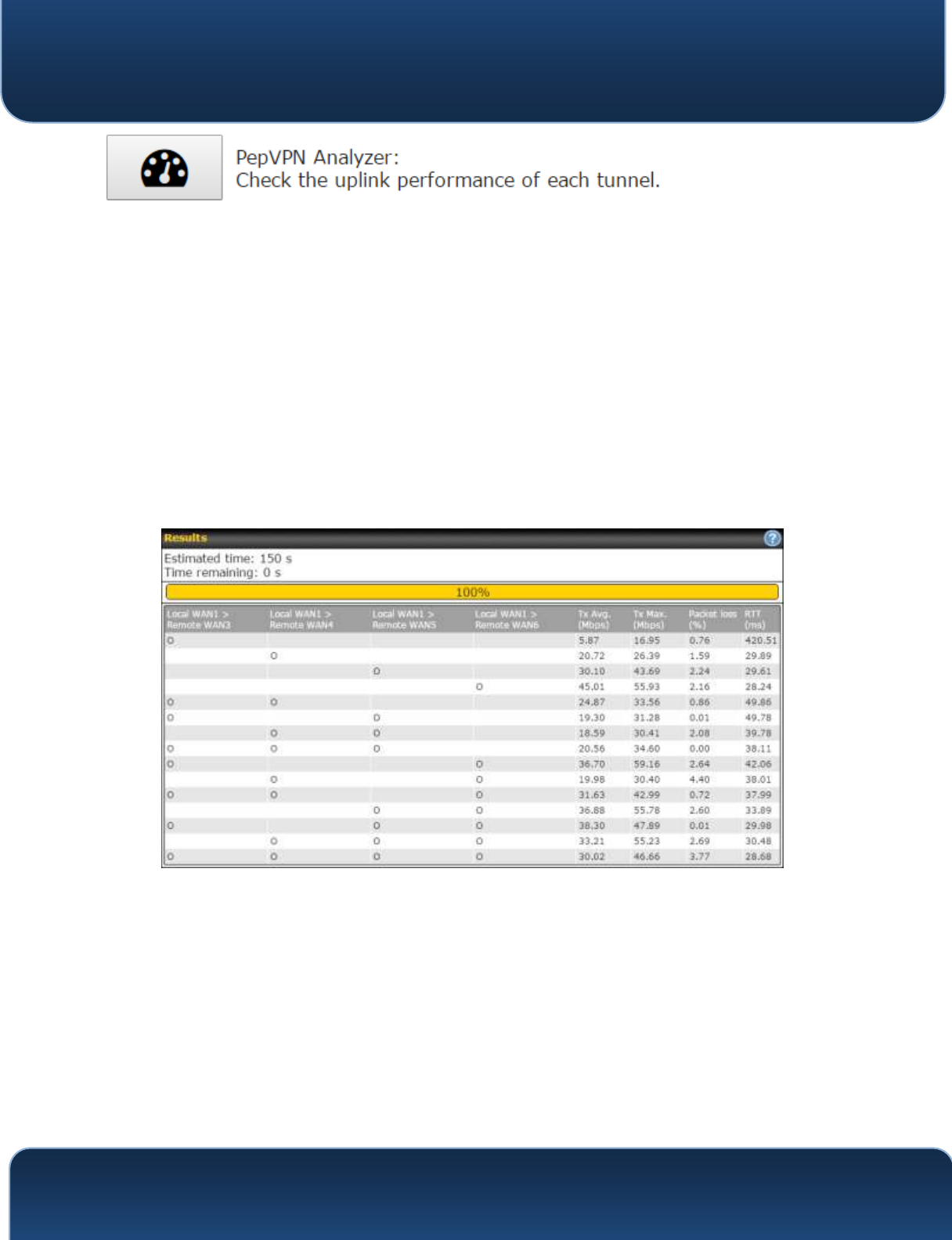
Pepwave MAX and Surf User Manual
http://www.pepwave.com
180
Copyright @ 2018 Pepwave
The bandwidth bonding feature of PepVPN occurs when multiple WAN lines
from one end merge with multiple WAN lines from the other end. For this to
happen, each WAN line needs to form a connection with all the WAN lines on
the opposite end. The function of the PepVPN analyzer is to report the
throughput, packet loss, and latency of all possible combinations of
connections. Please note that the PepVPN Analyzer will temporarily interrupt VPN
connectivity and will restore after test.
After clicking the icon, the analyzer will require several minutes to perform its
analysis depending the number of WAN links in the SpeedFusionTM Tunnel. Once
the test the complete, the report will appear:
"O" indicates that specific WAN / Tunnel is active for that particular test.
"Tx Avg." is the averaged throughput across the full 10 seconds time, while "Tx
Max." is the averaged throughput of the fastest 30% of time.
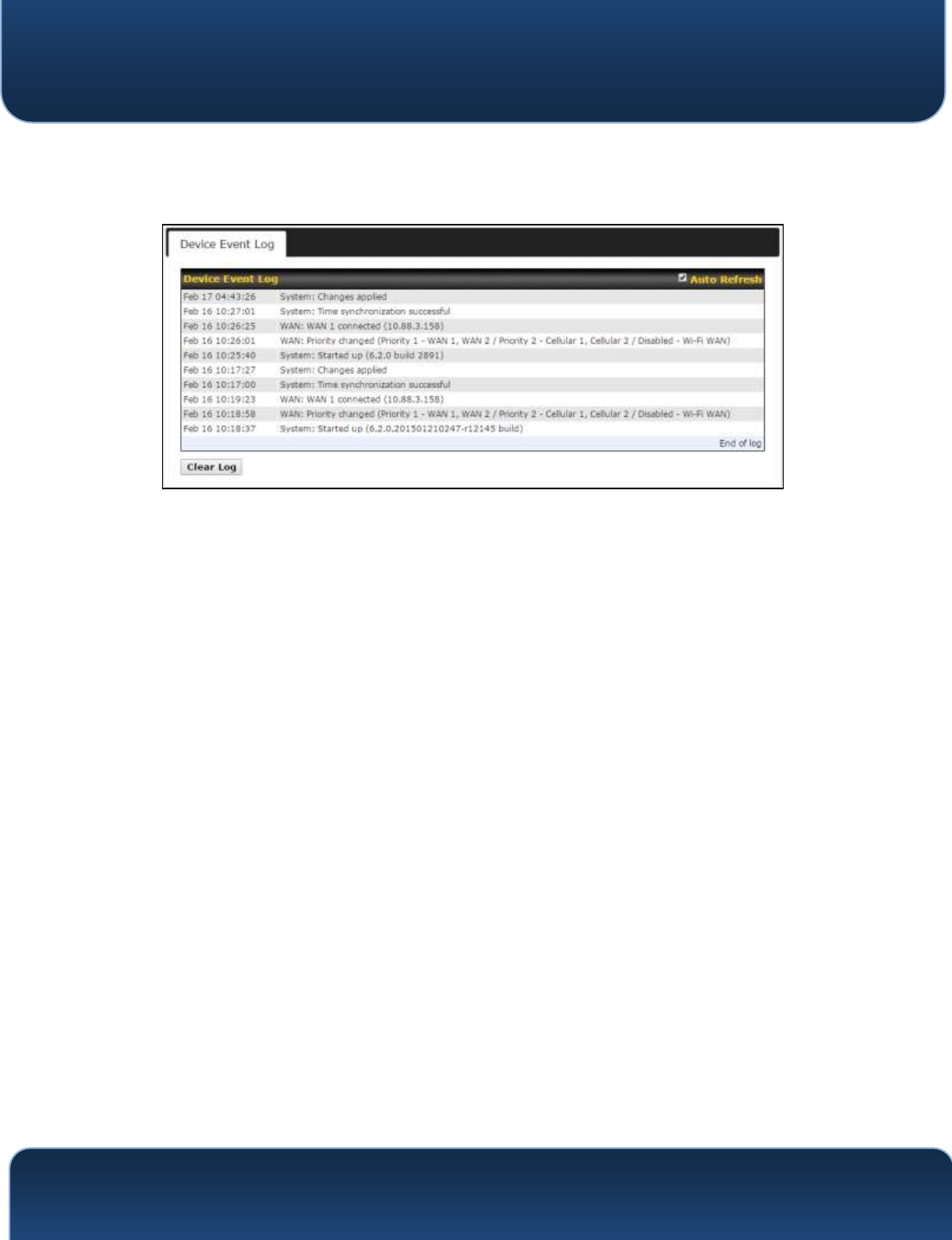
Pepwave MAX and Surf User Manual
http://www.pepwave.com
181
Copyright @ 2018 Pepwave
22.7 Event Log
Event log information is located at Status>Event Log.
The log section displays a list of events that has taken place on the Pepwave
router. Check Auto Refresh to refresh log entries automatically. Click the Clear
Log button to clear the log.
22.8 Bandwidth
This section shows bandwidth usage statistics and is located at
Status>Bandwidth. Bandwidth usage at the LAN while the device is switched off
(e.g., LAN bypass) is neither recorded nor shown.
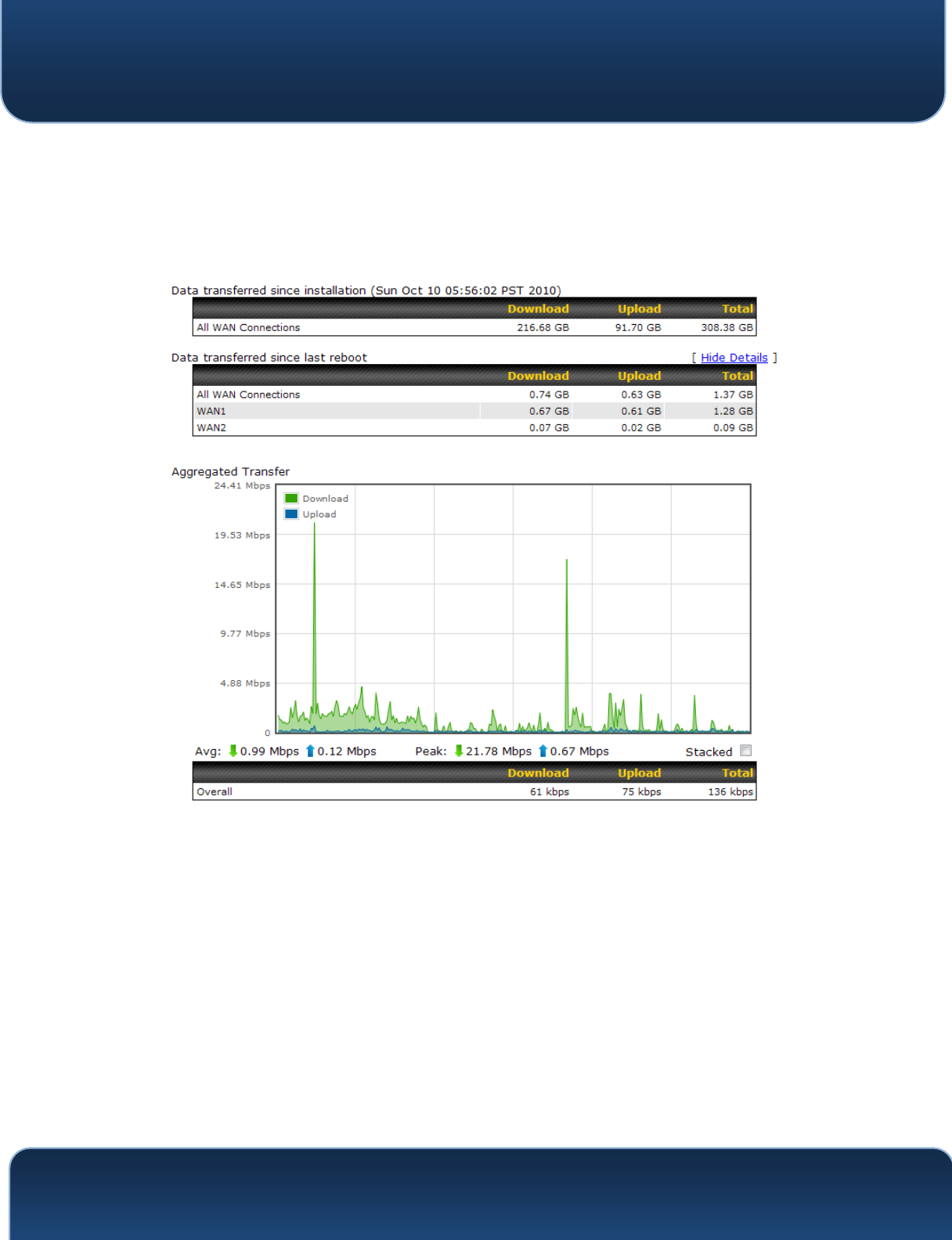
Pepwave MAX and Surf User Manual
http://www.pepwave.com
182
Copyright @ 2018 Pepwave
22.8.1 Real-Time
The Data transferred since installation table indicates how much network traffic
has been processed by the device since the first bootup. The Data transferred
since last reboot table indicates how much network traffic has been processed
by the device since the last bootup.
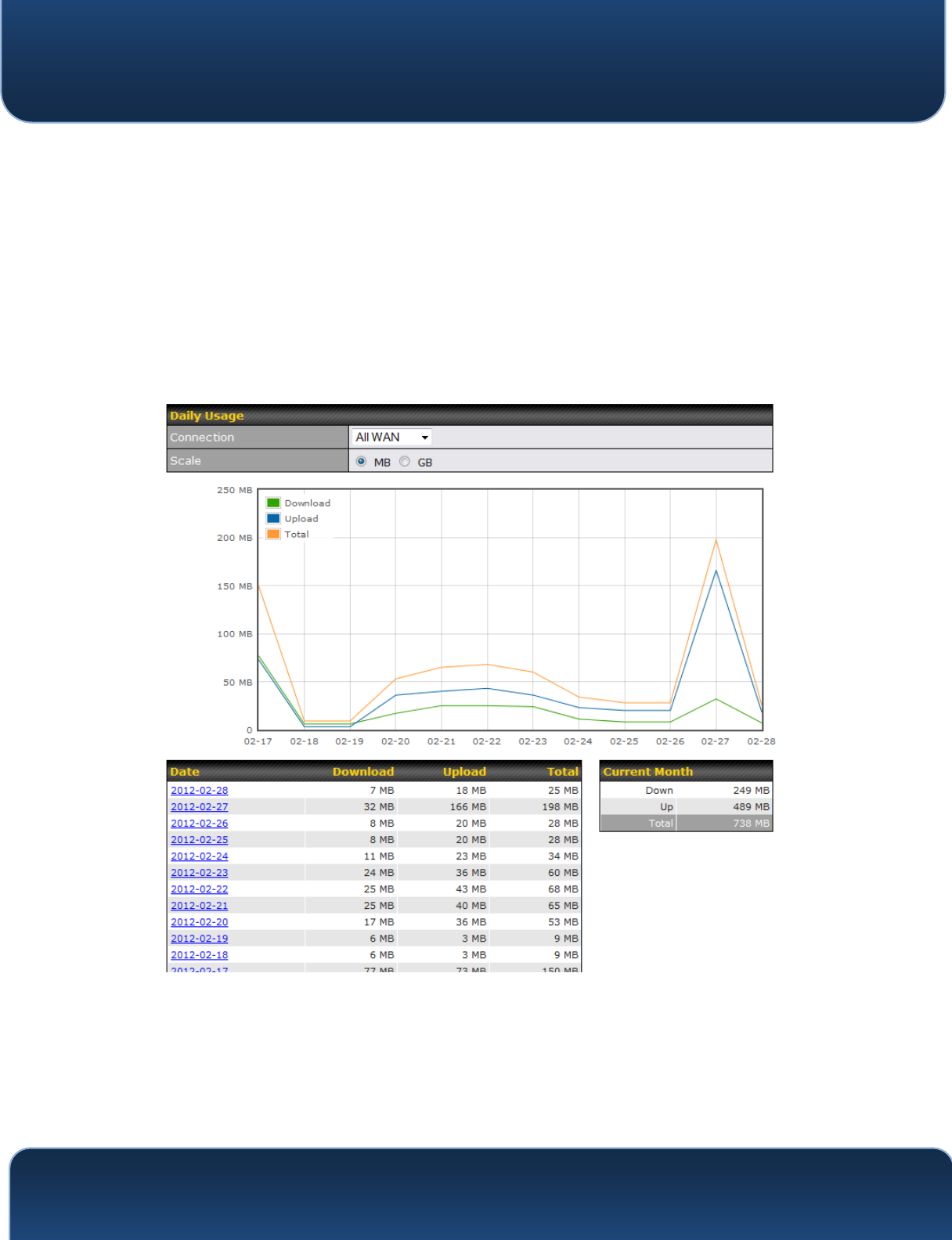
Pepwave MAX and Surf User Manual
http://www.pepwave.com
184
Copyright @ 2018 Pepwave
22.8.3 Daily
This page shows the daily bandwidth usage for all WAN connections, with the
option of viewing each individual connection.
Select the connection to check from the drop-down menu. If you have enabled
the Bandwidth Monitoring feature, the Current Billing Cycle table for that WAN
connection will be displayed.
Click on a date to view the client bandwidth usage of that specific date. This
feature is not available if you have selected to view the bandwidth usage of
only a particular WAN connection. The scale of the graph can be set to display
megabytes (MB) or gigabytes (GB).
All WAN Daily Bandwidth Usage
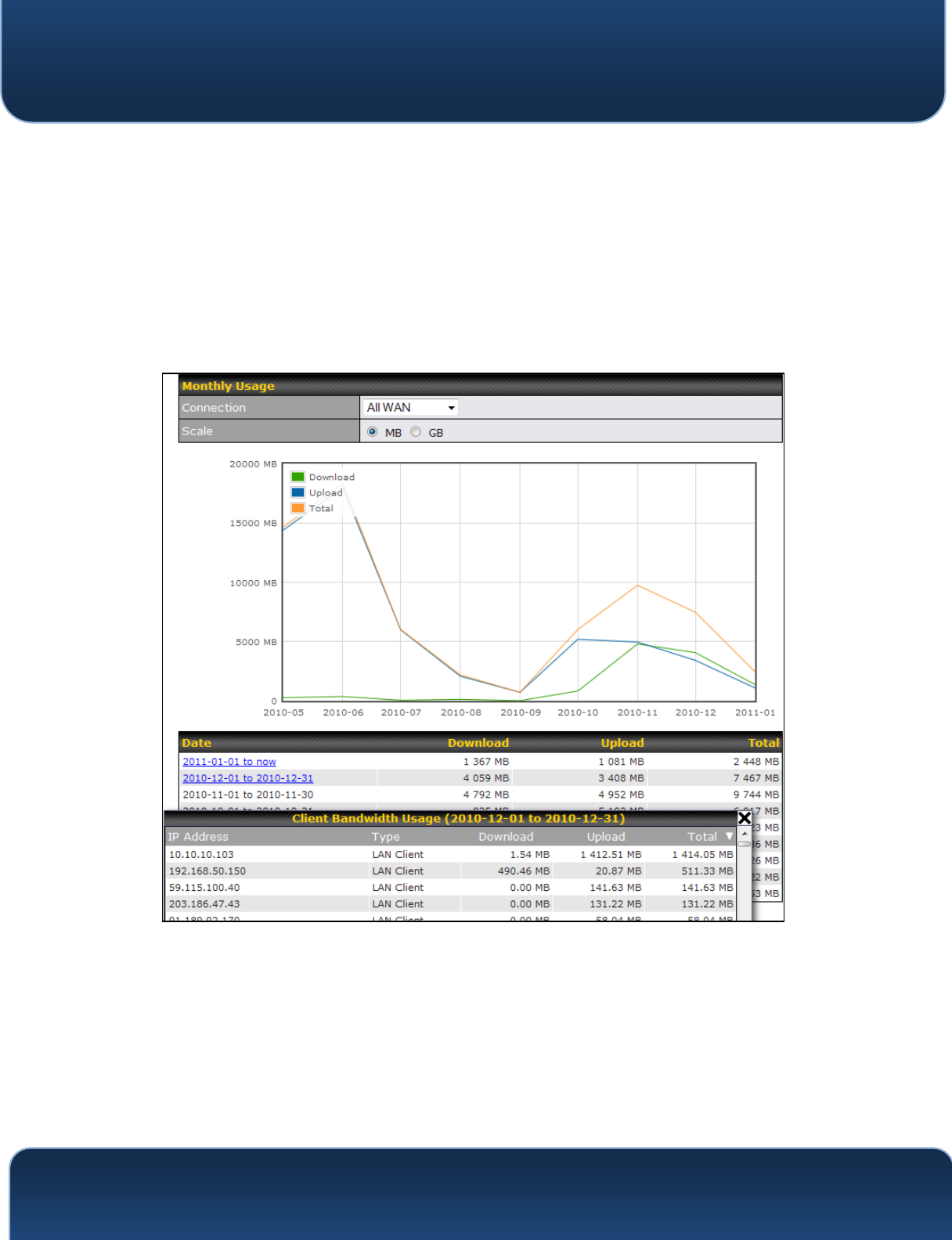
Pepwave MAX and Surf User Manual
http://www.pepwave.com
185
Copyright @ 2018 Pepwave
22.8.4 Monthly
This page shows the monthly bandwidth usage for each WAN connection. If you
have enabled the Bandwidth Monitoring feature, you can check the usage of
each particular connection and view the information by Billing Cycle or by
Calendar Month.
Click the first two rows to view the client bandwidth usage in the last two
months. This feature is not available if you have chosen to view the bandwidth
of an individual WAN connection. The scale of the graph can be set to display
megabytes (MB) or gigabytes (GB).
All WAN Monthly Bandwidth Usage

Pepwave MAX and Surf User Manual
http://www.pepwave.com
187
Copyright @ 2018 Pepwave
Appendix A. Restoration of Factory Defaults
To restore the factory default settings on a Pepwave router, follow the steps
below:
1. Locate the reset button on the front or back panel of the Pepwave router.
2. With a paper clip, press the reset button and hold it for at least 10
seconds, until the unit reboots itself.
After the Pepwave router finishes rebooting, the factory default settings will be
restored.
Important Note
All previous configurations and bandwidth usage data will be lost after restoring factory default settings.
Regular backup of configuration settings is strongly recommended.

Pepwave MAX and Surf User Manual
http://www.pepwave.com
188
Copyright @ 2018 Pepwave
Appendix B: Declaration
1. The device supports time division technology
2. Federal Communication Commission and Industry Canada Interference
Statement
This equipment has been tested and found to comply with the limits for a Class A
digital device, pursuant to part 15 of the FCC Rules. These limits are designed to
provide reasonable protection against harmful interference when the
equipment is operated in a commercial environment. This equipment
generates, uses, and can radiate radio frequency energy and, if not installed
and used in accordance with the instruction manual, may cause harmful
interference to radio communications. Operation of this equipment in a
residential area is likely to cause harmful interference in which case the user will
be required to correct the interference at his own expense.
Caution: Any changes or modifications not expressly approved by the party
responsible for compliance could void the user's authority to operate this
equipment.
This transmitter must not be co-located or operating in conjunction with any
other antenna or transmitter.
Operations in the 5.15-5.25GHz band are restricted to indoor usage only.
IMPORTANT NOTE
FCC Radiation Exposure Statement (for MAX BR1 MK2 (FCC ID: U8G-P1AC4) /
MAX Transit Duo with ContentHub with M12 connector (FCC ID: U8G-P1813)
This equipment complies with FCC radiation exposure limits set forth for an
uncontrolled environment. This equipment should be installed and operated with
minimum distance 24cm between the radiator & your body.
This transmitter must not be co-located or operating in conjunction with any other
antenna or transmitter.
The availability of some specific channels and/or operational frequency bands
are country dependent and are firmware programmed at the factory to match
the intended destination.

Pepwave MAX and Surf User Manual
http://www.pepwave.com
189
Copyright @ 2018 Pepwave
FCC Radiation Exposure Statement (for MAX BR1 mini)
This equipment complies with FCC radiation exposure limits set forth for an
uncontrolled environment. This equipment should be installed and operated with
minimum distance 25cm between the radiator & your body.
This transmitter must not be co-located or operating in conjunction with any other
antenna or transmitter.
The availability of some specific channels and/or operational frequency bands
are country dependent and are firmware programmed at the factory to match
the intended destination.
FCC Radiation Exposure Statement (for MAX700/ HD2/ HD2 IP67/ BR1/ Surf
SOHO)
This equipment complies with FCC radiation exposure limits set forth for an
uncontrolled environment. This equipment should be installed and operated
with minimum distance 20cm between the radiator & your body.
FCC Radiation Exposure Statement (for MAX On-The-Go)
This equipment complies with FCC radiation exposure limits set forth for an
uncontrolled environment.
1. 20cm minimum when the product is operated alone without co-transmitting
with a plug-in 3G USB dongle device.
2. 65cm minimum when the product is operated with a plug-in 3G USB device
which has maximum of 7W ERP output power.
3. For co-transmission scenario which is not covered above, please consult the
RF technician or device supplier.
This transmitter must not be co-located or operating in conjunction with any
other antenna or transmitter.
The availability of some specific channels and/or operational frequency bands
are country dependent and are firmware programmed at the factory to match
the intended destination.

Pepwave MAX and Surf User Manual
http://www.pepwave.com
190
Copyright @ 2018 Pepwave
Industry Canada Statement (for MAX BR1 MK2) (20682-P1AC4) / MAX Transit /
/ MAX Transit Duo with ContentHub with M12 connector (20682-P1813)
This device complies with Industry Canada license-exempt RSS standard(s).
Operation is subject to the following two conditions: (1) this device may not cause
interference, and (2) this device must accept any interference, including
interference that may cause undesired operation of the device.
Le présent appareil est conforme aux CNR d'Industrie Canada applicables aux
appareils radio exempts de licence. L'exploitation est autorisée aux deux
conditions suivantes : (1) l'appareil ne doit pas produire de brouillage, et (2)
l'utilisateur de l'appareil doit accepter tout brouillage radioélectrique subi, même
si le brouillage est susceptible d'en compromettre le fonctionnement.
To maintain compliance with the RF exposure guidelines, place the unit at least
30cm from nearby persons.
Mise en garde_: Pour assurer la conformité aux directives relatives à l'exposition
aux fréquences radio, le jouet doit êtreplacé à au moins 30_cm des personnes à
proximité.
Caution:
(i).The device for operation in the band 5150-5250 MHz is only for indoor use to
reduce the potential for harmful interference to co-channel Mobile Satellite
systems;
(ii).the maximum antenna gain permitted for devices in the band 5725-5850 MHz
shall be such that the equipment still complies with the e.i.r.p limits specified for
point-to-point and non-point-to-point operation as appropriate; and
(iii).Users should also be advised that high-power radars are allocated as primary
users (i.e. priority users) of the bands 5650-5850 MHz and that these radars could
cause interference and/or damage to LE-LAN devices.
Avertissement:
(i). Les dispositifs fonctionnant dans la bande 5150-5250 MHz sont réservés
uniquement pour une utilisation à l’intérieur afin de réduire les risques de
brouillage préjudiciable aux systèmes de satellites mobiles utilisant les mêmes
canaux.
(ii)vLe gain maximal d’antenne permis (pour les dispositifs utilisant les bandes 5250
à 5850) doit se conformer à la limite de p.i.r.e. Le gain maximal d’antenne permis
(pour les dispositifs utilisant la bande 5725-5825 MHz) doit être conforme à la limite
de p.i.r.e. spécifiée pour l’exploitation point à point et l’exploitation non point à
point, selon le cas;

Pepwave MAX and Surf User Manual
http://www.pepwave.com
191
Copyright @ 2018 Pepwave
(iii).De plus, les utilisateurs devraient aussi être avisés que les utilisateurs de radars
de haute puissance sont désignés utilisateurs principaux (c.-à-d., qu’ils ont la
priorité) pour les bandes 5650-5850 MHz et que ces radars pourraient causer du
brouillage et/ou des dommages aux dispositifs LAN-EL.
Industry Canada Statement (for MAX Hotspot/ Surf SOHO/ MAX HD2 / MAX BR1
mini)
This device complies with Industry Canada license-exempt RSS standard(s).
Operation is subject to the following two conditions: (1) this device may not cause
interference, and (2) this device must accept any interference, including
interference that may cause undesired operation of the device.
Le présent appareil est conforme aux CNR d'Industrie Canada applicables aux
appareils radio exempts de licence. L'exploitation est autorisée aux deux
conditions suivantes : (1) l'appareil ne doit pas produire de brouillage, et (2)
l'utilisateur de l'appareil doit accepter tout brouillage radioélectrique subi, même
si le brouillage est susceptible d'en compromettre le fonctionnement.
To maintain compliance with the RF exposure guidelines, place the unit at least
20cm from nearby persons.
Mise en garde_: Pour assurer la conformité aux directives relatives à l'exposition
aux fréquences radio, le jouet doit êtreplacé à au moins 20_cm des personnes à
proximité.
Caution :
(i) the device for operation in the band 5150-5250 MHz is only for indoor use to
reduce the potential for harmful interference to co-channel mobile satellite
systems;
(ii) the maximum antenna gain permitted for devices in the band 5725-5850 MHz
shall be such that the equipment still complies with the e.i.r.p. limits specified for
point-to-point and non-point-to-point operation as appropriate; and
(iii) Users should also be advised that high-power radars are allocated as primary
users (i.e. priority users) of the bands 5650-5850 MHz and that these radars could
cause interference and/or damage to LE-LAN devices.

Pepwave MAX and Surf User Manual
http://www.pepwave.com
192
Copyright @ 2018 Pepwave
Avertissement:
(i) les dispositifs fonctionnant dans la bande 5150-5250 MHz sont réservés
uniquement pour une utilisation à l’intérieur afin de réduire les risques de
brouillage préjudiciable aux systèmes de satellites mobiles utilisant les mêmes
canaux;
(ii) le gain maximal d'antenne permis (pour les dispositifs utilisant la bande de 5725
à 5 850 MHz) doit être conforme à la limite de la p.i.r.e. spécifiée pour l'exploitation
point à point et l’exploitation non point à point, selon le cas;
(iii) De plus, les utilisateurs devraient aussi être avisés que les utilisateurs de radars
de haute puissance sont désignés utilisateurs principaux (c.-à-d., qu’ils ont la
priorité) pour les bandes 5650-5850 MHz et que ces radars pourraient causer du
brouillage et/ou des dommages aux dispositifs LAN-EL.
Radiation Exposure Statement: (For MAX BR1 Mini)
This equipment complies with ISED radiation exposure limits set forth for an
uncontrolled environment. This equipment should be installed and operated with
minimum distance 25cm between the radiator & your body.
Déclaration d'exposition aux radiations:
Cet équipement est conforme aux limites d'exposition aux rayonnements ISED
établies pour un environnement non contrôlé. Cet équipement doit être installé
et utilisé avec un minimum de 25 cm de distance entre la source de
rayonnement et votre corps.
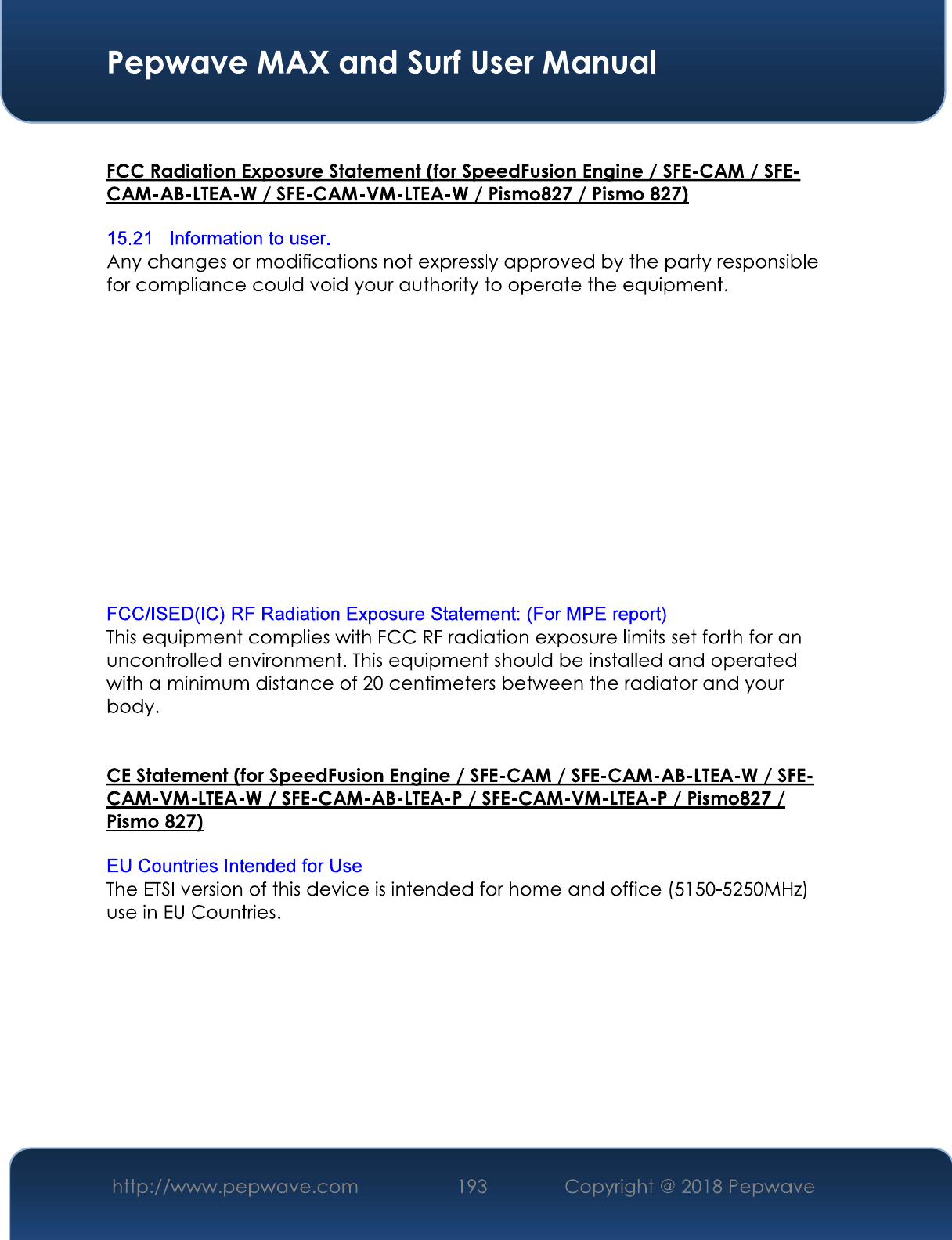
Note: This equipment has been tested and found to comply with the limits for a Class A
digital device, pursuant to part 15 of the FCC Rules. These limits are designed to provide
reasonable protection against harmful interference when the equipment is operated in
a commercial environment. This equipment generates, uses, and can radiate radio
frequency energy and, if not installed and used in accordance with the instruction manual,
may cause harmful interference to radio communications. Operation of this equipment in
a residential area is likely to cause harmful interference in which case the user will be
required to correct the interference at his own expense.
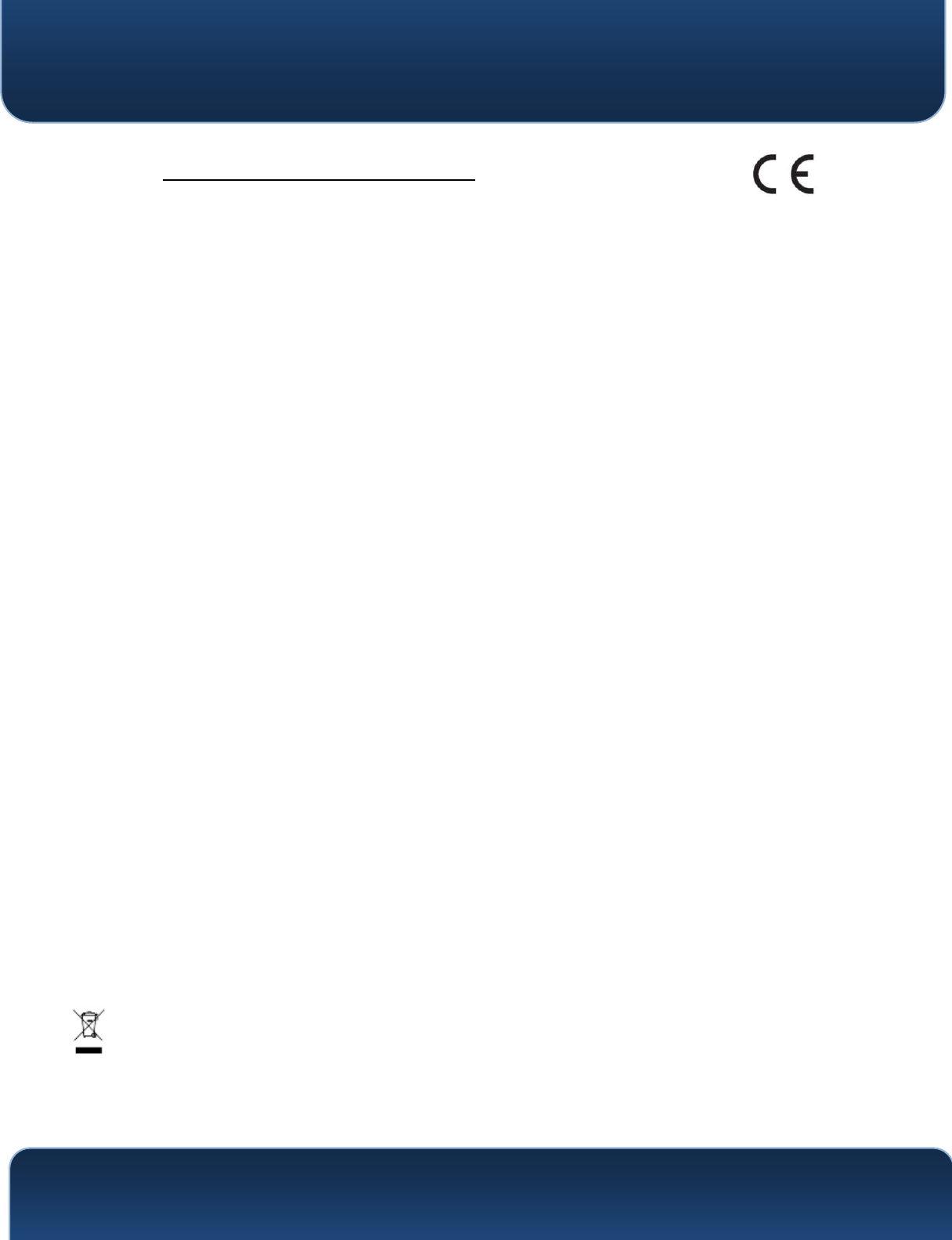
Pepwave MAX and Surf User Manual
http://www.pepwave.com
194
Copyright @ 2018 Pepwave
3. CE Statement for Pepwave Routers
Europe – EU Declaration of Conformity
This device complies with the essential requirements of the Radio Equipment Directive
2014/53/EC. The following test methods have been applied in order to prove presumption of
conformity with the essential requirements of the RE Directive 2014/53/EU:
- EN 60950-1: 2006 +A11:2009 +A1:2010 +A12:2011 +A2:2013
Safety of Information Technology Equipment
- EN 50385 : 2002
Product standard to demonstrate the compliance of radio base stations and fixed terminal stations for wireless
telecommunication systems with the basic restrictions or the reference levels related to human exposure to radio
frequency electromagnetic fields (110 MHz — 40 GHz) — General public
- EN 62311 : 2008
Assessment of electronic and electrical equipment related to human exposure restrictions for electromagnetic fields
(0 Hz — 300 GHz)
- EN 300 328 V2.1.1
Wideband transmission systems; Data transmission equipment operating in the 2,4 GHz ISM band and using wide band
modulation techniques; Harmonised Standard covering the essential requirements of article 3.2 of Directive
2014/53/EU
- EN 301 893 V1.8.1 / Article 3(2) (– Adaptivity until 12.06.2018)
Broadband Radio Access Networks (BRAN); 5 GHz high performance RLAN; Harmonized EN covering the essential
requirements of article 3.2 of the R&TTE Directive
- EN 301 893 V2.1.1 / Article 3(2)
5 GHz RLAN; Harmonised Standard covering the essential requirements of article 3.2 of Directive 2014/53/EU
- EN 301 908-1 V11.1.1: 2011
IMT cellular networks; Harmonised Standard covering the essential requirements of article 3.2 of the Directive
2014/53/EU; Part 1: Introduction and common requirements
- EN 300 440 V2.1.1
Short Range Devices (SRD); Radio equipment to be used in the 1 GHz to 40 GHz frequency range; Harmonised
Standard covering the essential requirements of article 3.2 of Directive 2014/53/EU
- EN 301 489-1 V2.1.1
Electromagnetic compatibility and Radio Spectrum Matters (ERM); ElectroMagnetic Compatibility (EMC) standard for
radio equipment and services; Part 1: Common technical requirements
- EN 301 489-17 V3.2.0
ElectroMagnetic Compatibility (EMC) standard for radio equipment and services; Part 17: Specific conditions for
Broadband Data Transmission Systems; Harmonised Standard covering the essential requirements of article 3.1(b) of
Directive 2014/53/EU
- EN 301 489-19 V2.1.0
ElectroMagnetic Compatibility (EMC) standard for radio equipment and services; Part 19: Specific conditions for
Receive Only Mobile Earth Stations (ROMES) operating in the 1,5 GHz band providing data communications and GNSS
receivers operating in the RNSS band (ROGNSS) providing positioning, navigation, and timing data; Harmonised
Standard covering the essential requirements of article 3.1(b) of Directive 2014/53/EU
- EN 301 489-52 V1.1.0 (2016-11)
Electromagnetic Compatibility (EMC) standard for radio equipment and services; Part 52: Specific conditions for
Cellular Communication Mobile and portable (UE) radio and ancillary equipment; Harmonised Standard covering
the essential requirements of article 3.1(b) of Directive 2014/53/EU
- Recycling - Our product bears this selective sorting symbol for Waste Electrical and Electronic
Equipment (WEEE) Directive 2012/19/EU. This means this product must be handled according
to this Directive. Old electrical appliance must not be disposed of together with the residual
waste, but have to be disposed of separately. The disposal at the communal collecting point
via private persons is for free. The owner of old appliances is responsible to bring the
appliances to these collecting points.
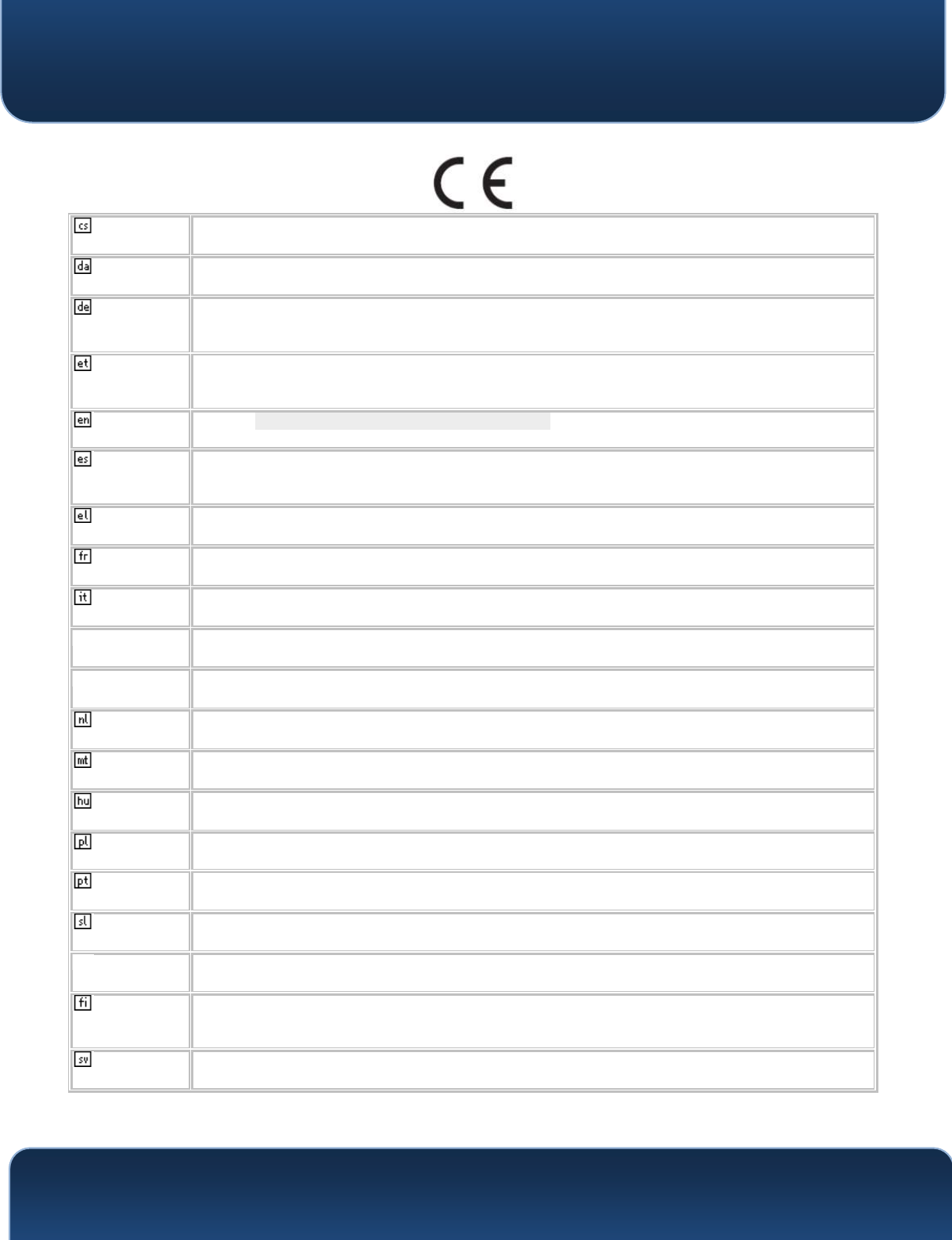
Pepwave MAX and Surf User Manual
http://www.pepwave.com
195
Copyright @ 2018 Pepwave
Česky
[Czech]
[Jméno výrobce] tímto prohlašuje, že tento [typ zařízení] je ve shodě se základními požadavky a
dalšími příslušnými ustanoveními směrnice 2014/53/ES.
Dansk
[Danish]
Undertegnede [fabrikantens navn] erklærer herved, at følgende udstyr [udstyrets typebetegnelse]
overholder de væsentlige krav og øvrige relevante krav i direktiv 2014/53/EF.
Deutsch
[German]
Hiermit erklärt [Name des Herstellers], dass sich das Gerät [Gerätetyp] in Übereinstimmung mit den
grundlegenden Anforderungen und den übrigen einschlägigen Bestimmungen der Richtlinie
2014/53/EG befindet.
Eesti
[Estonian]
Käesolevaga kinnitab [tootja nimi = name of manufacturer] seadme [seadme tüüp = type of
equipment] vastavust direktiivi 2014/53/EÜ põhinõuetele ja nimetatud direktiivist tulenevatele
teistele asjakohastele sätetele.
English
Hereby, [Pismo Labs Technology Limited, Hong Kong], declares that this [type of equipment] is in
compliance with the essential requirements and other relevant provisions of Directive 2014/53/EU.
Español
[Spanish]
Por medio de la presente [nombre del fabricante] declara que el [clase de equipo] cumple con
los requisitos esenciales y cualesquiera otras disposiciones aplicables o exigibles de la Directiva
2014/53/CE.
Ελληνική
[Greek]
ΜΕ ΤΗΝ ΠΑΡΟΥΣΑ [name of manufacturer] ΔΗΛΩΝΕΙ ΟΤΙ [type of equipment] ΣΥΜΜΟΡΦΩΝΕΤΑΙ
ΠΡΟΣ ΤΙΣ ΟΥΣΙΩΔΕΙΣ ΑΠΑΙΤΗΣΕΙΣ ΚΑΙ ΤΙΣ ΛΟΙΠΕΣ ΣΧΕΤΙΚΕΣ ΔΙΑΤΑΞΕΙΣ ΤΗΣ ΟΔΗΓΙΑΣ 2014/53/ΕΚ.
Français
[French]
Par la présente [nom du fabricant] déclare que l'appareil [type d'appareil] est conforme aux
exigences essentielles et aux autres dispositions pertinentes de la directive 2014/53/CE.
Italiano
[Italian]
Con la presente [nome del costruttore] dichiara che questo [tipo di apparecchio] è conforme ai
requisiti essenziali ed alle altre disposizioni pertinenti stabilite dalla direttiva 2014/53/CE.
Latviski
[Latvian]
Ar šo [name of manufacturer / izgatavotāja nosaukums] deklarē, ka [type of equipment / iekārtas
tips] atbilst Direktīvas 2014/53/EK būtiskajām prasībām un citiem ar to saistītajiem noteikumiem.
Lietuvių
[Lithuanian]
Šiuo [manufacturer name] deklaruoja, kad šis [equipment type] atitinka esminius reikalavimus ir kitas
2014/53/EB Direktyvos nuostatas.
Nederlands
[Dutch]
Hierbij verklaart [naam van de fabrikant] dat het toestel [type van toestel] in overeenstemming is
met de essentiële eisen en de andere relevante bepalingen van richtlijn 2014/53/EG.
Malti
[Maltese]
Hawnhekk, [isem tal-manifattur], jiddikjara li dan [il-mudel tal-prodott] jikkonforma mal-ħtiġijiet
essenzjali u ma provvedimenti oħrajn relevanti li hemm fid-Dirrettiva 2014/5/EC.
Magyar
[Hungarian]
Alulírott, [gyártó neve] nyilatkozom, hogy a [... típus]megfelel a vonatkozó alapvetõ
követelményeknek és az 2014/53/EC irányelv egyéb elõírásainak.
Polski [Polish]
Niniejszym [nazwa producenta] oświadcza, że [nazwa wyrobu] jest zgodny z zasadniczymi
wymogami oraz pozostałymi stosownymi postanowieniami Dyrektywy 2014/53/EC.
Português
[Portuguese]
[Nome do fabricante] declara que este [tipo de equipamento] está conforme com os requisitos
essenciais e outras disposições da Directiva 2014/53/CE.
Slovensko
[Slovenian]
[Ime proizvajalca] izjavlja, da je ta [tip opreme] v skladu z bistvenimi zahtevami in ostalimi
relevantnimi določili direktive 2014/53/ES.
Slovensky
[Slovak]
[Meno výrobcu] týmto vyhlasuje, že [typ zariadenia]spĺňa základné požiadavky a všetky príslušné
ustanovenia Smernice 2014/53/ES.
Suomi
[Finnish]
[Valmistaja = manufacturer] vakuuttaa täten että [type of equipment = laitteen tyyppimerkintä]
tyyppinen laite on direktiivin 2014/53/EY oleellisten vaatimusten ja sitä koskevien direktiivin muiden
ehtojen mukainen.
Svenska
[Swedish]
Härmed intygar [företag] att denna [utrustningstyp] står I överensstämmelse med de väsentliga
egenskapskrav och övriga relevanta bestämmelser som framgår av direktiv 2014/53/EG.
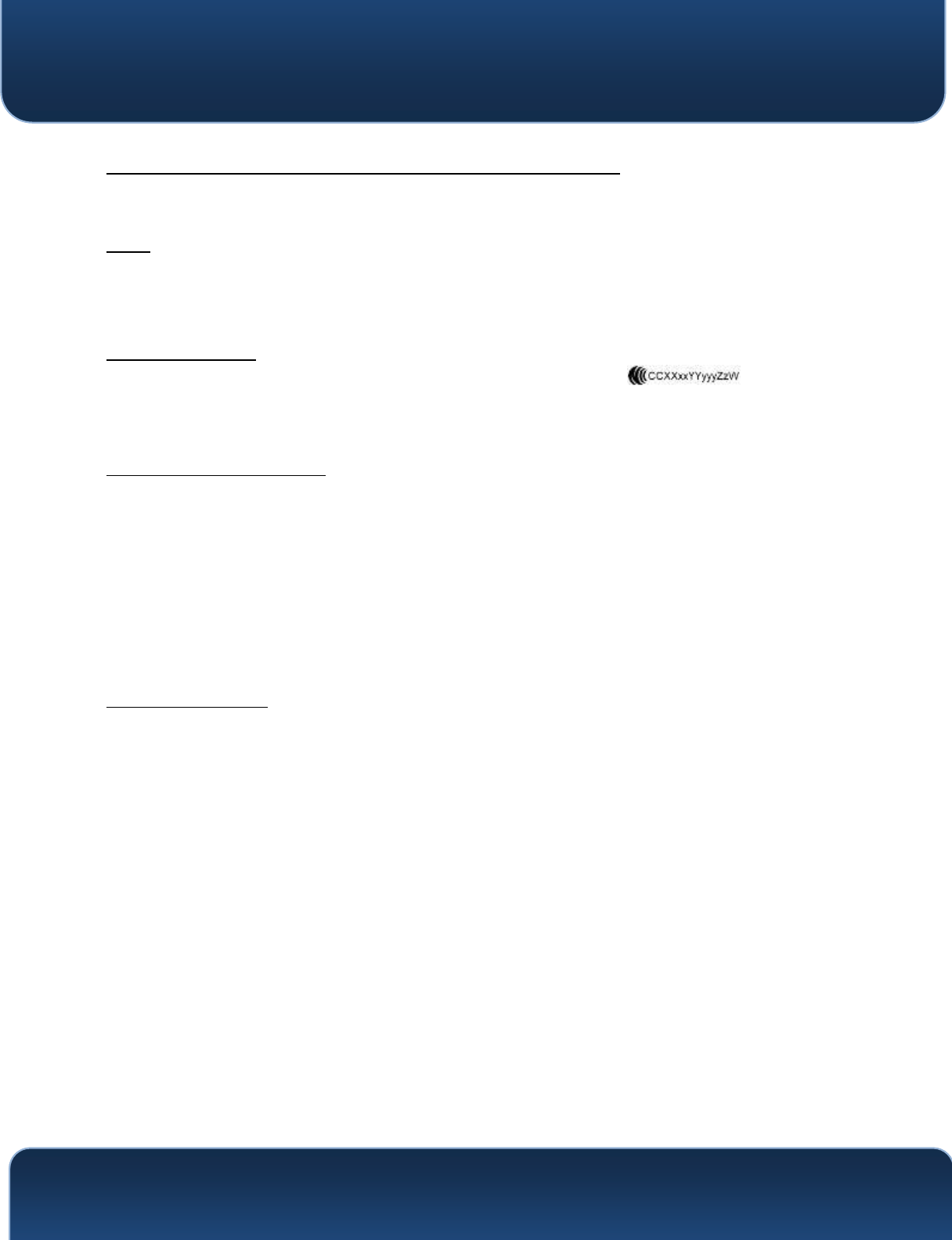
Pepwave MAX and Surf User Manual
http://www.pepwave.com
197
Copyright @ 2018 Pepwave
4. NCC / BSMI - Pepwave MAX cellular Routers 使用說明
使用本產品適用於「MAX BR1 MK2」 請注意以下警語
WLAN
電磁波曝露量 MPE 標準值 1 mW/cm2,送測產品實測 值為:0.081 mW/cm2。
WWAN 為限制型模組
本產品與內裝模組已取得認證,產品依規定於標示「本產品內含射頻模組號 CCXXxxYYyyyZzW。」
使用本產品時, 應避免影響附近雷達系統之操作。 高增益指向性天線只得應用於固定式點對點系統。
低功率電波輻射性電機管理辦法
第十二條 經型式認證合格之低功率射頻電機,非經許可,公司、商號或使用者均不得擅自變更頻率、加大
功率或變更原設計之特性及功能。
第十四條 低功率射頻電機之使用不得影響飛航安全及干擾合法通信;經發現有干擾現象時,應立即停用,
並改善至無干擾時方得繼續使用。前項合法通信,指依電信法規定作業之無線電通信。低功率射頻電機須
忍受合法通信或工業、科學及醫療用電波輻射性電機設備之干擾。
本行動寬頻設備的行動寬頻頻段 WCDMA /FDD LTE700/900/1800/2600, TDD LTE2570-2620/2500-
2690MHz.
電磁波 / 電磁兼容 須知
為減少電磁波影響,請妥適使用。
此為甲類資訊技術設備,於居住環境中使用時,可能會造成射頻擾動,在此種情況下,使用者會被要求採
取某些適當的對策。
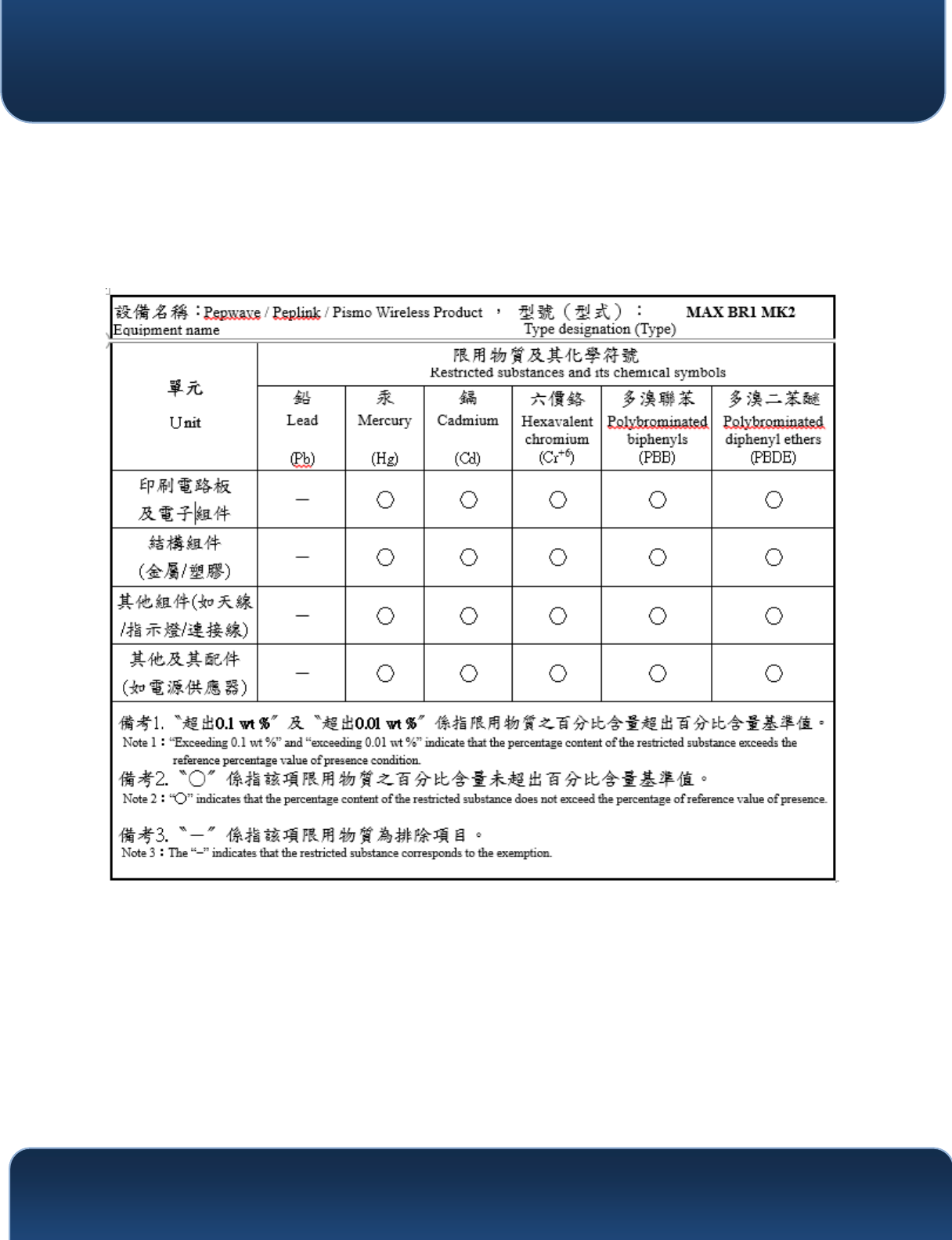
Pepwave MAX and Surf User Manual
http://www.pepwave.com
198
Copyright @ 2018 Pepwave
設備名稱:Pepwave/Peplink/Pismo Wireless Product,型號(型式):MAX BR1 MK2
單元
Unit
限用物質及其化學符號
鉛 (Pb)
Lead
汞(Hg)
Mercury
鎘(Cd)
Cadmium
六價鉻(Cr+6)
Hexavalent
chromium
多溴聯苯
(PBB)
Polybrominated
biphenyls
多溴二苯醚
(PBDE)
Polybrominated
diphenyl ethers
印刷電路板
及電子組件
-
○
○
○
○
○
結構組件
(金屬/塑膠)
-
○
○
○
○
○
其他組件(如天線/
指示燈/連接線)
-
○
○
○
○
○
其他及其配件
(如電源供應器)
-
○
○
○
○
○
備考1.〝超出0. 1 wt %〞及〝超出0.01 wt %〞係指限用物質之百分比含量超出百分比含量基準值。
備考2.〝○〞係指該項限用物質之百分比含量未超出百分比含量基準值。
備考3.〝-〞係指該項限用物質為排除項目。
(Equipment name)
Type designation (Type):
Restricted substances and its chemical symbols
Note 1:“Exceeding 0.1 wt %” and “exceeding 0.01 wt %” indicate that the percentage content of the restricted substance
exceeds the reference percentage value of presence condition.
Note 2:“○” indicates that the percentage content of the restricted substance does not exceed the percentage of reference
value of presence.
Note 3:The “−” indicates that the restricted substance corresponds to the exemption.
限用物質含有情況標示聲明書
Declaration of the Presence Condition of
the Restricted Substances Marking

Pepwave MAX and Surf User Manual
http://www.pepwave.com
199
Copyright @ 2018 Pepwave
5. Compliance (For MAX BR1 mini & MAX BR1 & MAX BR1 MK2)
Please observe the following instructions:
5.1 Ex marking:
CLASS I, DIVISION 2, GROUP C AND D
5.2 Warning:
5.2.2 The Antenna shall not be disconnected while the power is connected.
5.2.3 The front panel presents an electrostatic hazard. Clean only by using a
damp cloth.
5.3.3 Provision shall be made to prevent the rated voltage being exceeded
by the transient disturbances of more than 140% of the peak rated
voltage.
5.3.4 Explosion Hazard. Do not connect or disconnect when energized.
5.2 Mise en garde:
5.2.2 L’antenne ne doit pas être déconnectée quand le matériel est
toujours sous tension
5.2.3 Le panneau avant présente un risque électrostatique. Utiliser un chiffon
humide.
5.3.3 Des dispositions doivent être mises en place contre les perturbations
passagères entrainant un dépassement de la tension assignée de plus
de 140% du pic pouvant être atteint.
5.3.4 Risque d’explosion. Ne connectez ou ne déconnectez pas le produit
quand celle-ci est sous tension.
5.3 Temperature class
Temperature class is T4.
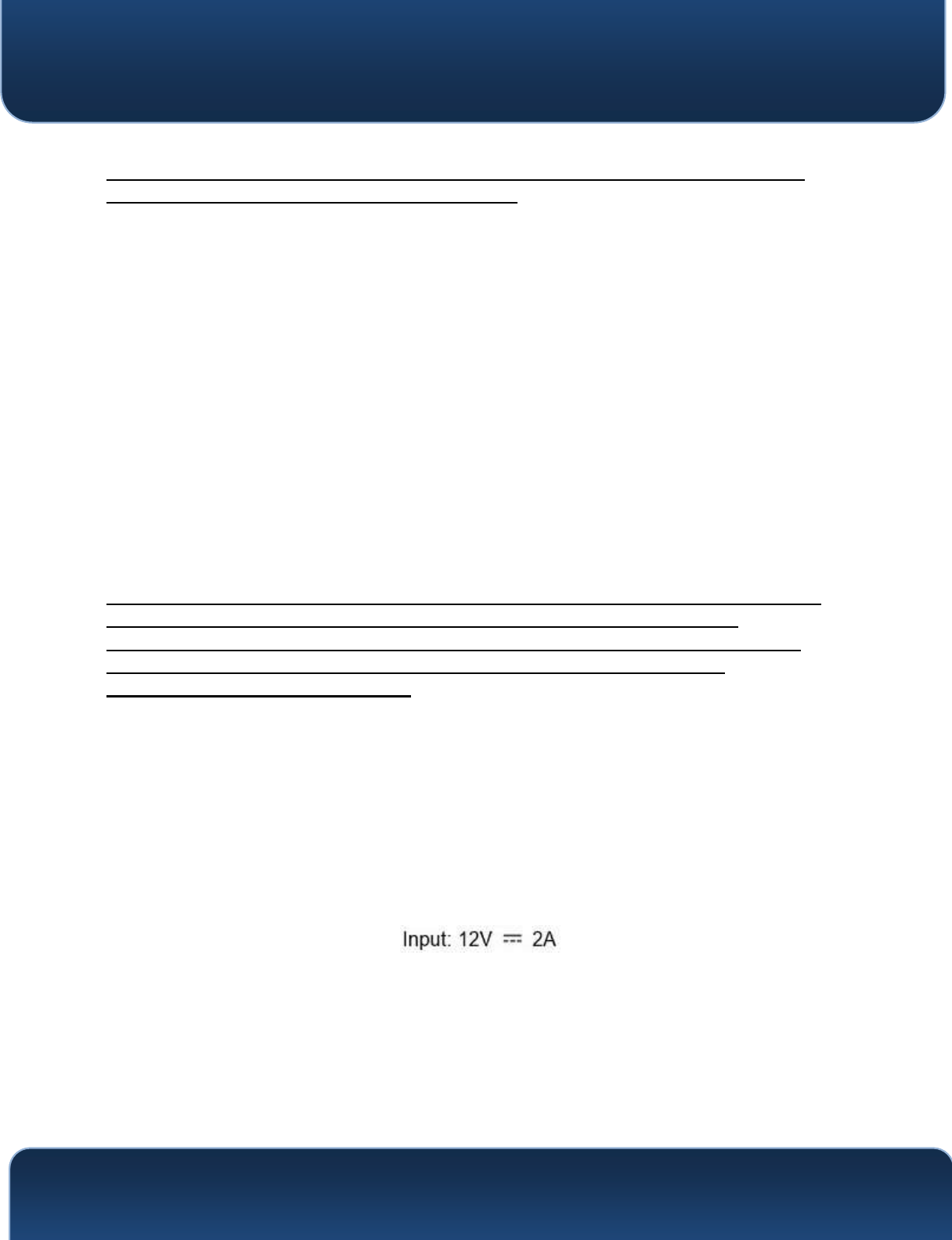
Pepwave MAX and Surf User Manual
http://www.pepwave.com
200
Copyright @ 2018 Pepwave
5. Compliance (Important Information and Safety Compliance for MAX HD4 /
MAX HD4 LTE / MAX HD4 LTEA / Pismo 803AC)
Please observe the following instructions:
5.1 User should pay attention to use manufacturer supplied power adapter:
ADAPTER TECH.
AC ADAPTER
INPUT: 100-240V~ 50-60Hz, 1.2A MAX,
OUTPUT: 12V 4.2A LPS
FOR INDOOR USE ONLY
5.2 USB port output rating:5VDC, 2A
5.3 Temperature suitable for use: ambient temp. maximum 40 oC.
5. Compliance (Important Information and Safety Compliance for SpeedFusion
Engine / SpeedFusion Engine CAM / SFE-CAM / SFE-CAM2 (FCC & CE)
SFE-CAM-AB-LTEA-W / SFE-CAM-VM-LTEA-W / Worldwide- US&EU (FCC & CE)
SFE-CAM-AB-LTEA-P / SFE-CAM-VM-LTEA-P / Asia Pacific (CE only) /
Pismo827 / Pismo 827 (FCC & CE)
Please observe the following instructions:
5.1 User should pay attention to use manufacturer supplied power adapter:
DVE / TEN PAO.
AC ADAPTER
INPUT: 100-240V~ 50-60Hz, 0.6A / 0.8A
OUTPUT: 12V 2A LPS
FOR INDOOR USE ONLY
5.2 INPUT RATING: 12V DC 2A / (SD WAN Router / Host)
5.3 Temperature suitable for use: ambient temp.: -40 to 65 oC.
